

How to Visit Pamukkale: Travertine Terraces + Hierapolis [Guide for 2024]
Co-Founder of The Turkey Traveler. Globetrotter, Adventurer, and Frequent Traveler to Turkey!
This website uses affiliate links. For more information, click here .
Pamukkale is well known for its Travertine Terraces that sparkle like white cotton. In fact, many people don’t realize that Pamukkale is actually a city and not the Travertines.
But chances are, you’re also here to visit this amazing natural wonder and its accompanying ancient UNESCO World Heritage site of Hierapolis, right?
Well, you and thousands of others. It’s said that Pamukkale receives 1.5 MILLION people a year ( according to statistics ). If you divide that number by 365 days in a year, then you have over 4,100 people a day.
But why is it so popular? and how do you visit Pamukkale to avoid the crowds ? I’m about to reveal everything you need to know in this guide on how to visit Pamukkale…
Where Is Pamukkale?
Pamukkale is located in the Denizli Province of southwestern Turkey. The area is known for its natural hot springs and travertine terraces, which have been formed over thousands of years by the deposition of calcium carbonate from the hot springs.
The nearest city to Pamukkale is Denizli, which is just 16km away.
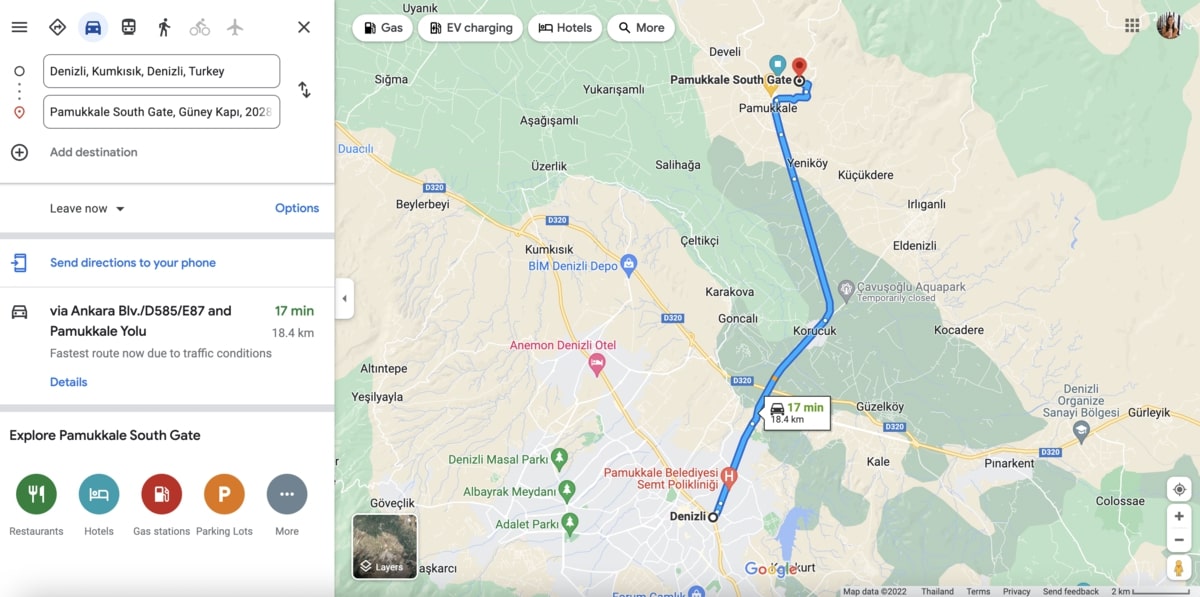
Getting to Pamukkale
To get to Pamukkale by bus, you must first get to Denizli bus station. If you are taking a long distance bus from Istanbul, Antalya or Cappadocia, they will most likely stop here.
From Denizli bus station, you must then take a minibus (dolmus). The minibuses leave from one floor below the main bus terminal on level B1.
You’ll then need to find Gate 76 , this is where the buses go from Denizli to Pamukkale. They depart every 15 to 20 minutes, but they also depart whenever they are full, so you might find you have to wait a while.
The cost of the minibus from Denizli to Pamukkale is 14 TL. You pay directly to the minibus driver, and unfortunately you cannot book tickets in advance.
The journey takes about 45 minutes.
You can also take a taxi, but this is much more expensive. There are no trains to Pamukkale.
You can read more about how to get to Pamukkale from our below guides:
- How to get from Cappadocia to Pamukkale
- How to get from Izmir to Pamukkale
- How to get from Istanbul to Pamukkale
The History of Pamukkale
Pamukkale, meaning “Cotton Castle” in Turkish, is a natural wonder known for its Travertine Terraces. The site is made up of 17 hot springs of differing temperatures, which flow down the mountainside and deposit the mineral calcium carbonate as it cools.
Over time, the depositing of minerals forms these unique white terraces filled with pools of warm water.
The area has been used as a spa since the Roman era, but the tourism really started to flock to Pamukkale in the 1960s to see the iconic terraces.
However, it wasn’t until after 1988 when it was declared a World Heritage Site that it really took off. Today, it is one of Turkey’s most popular tourist destinations , attracting millions of visitors each year.
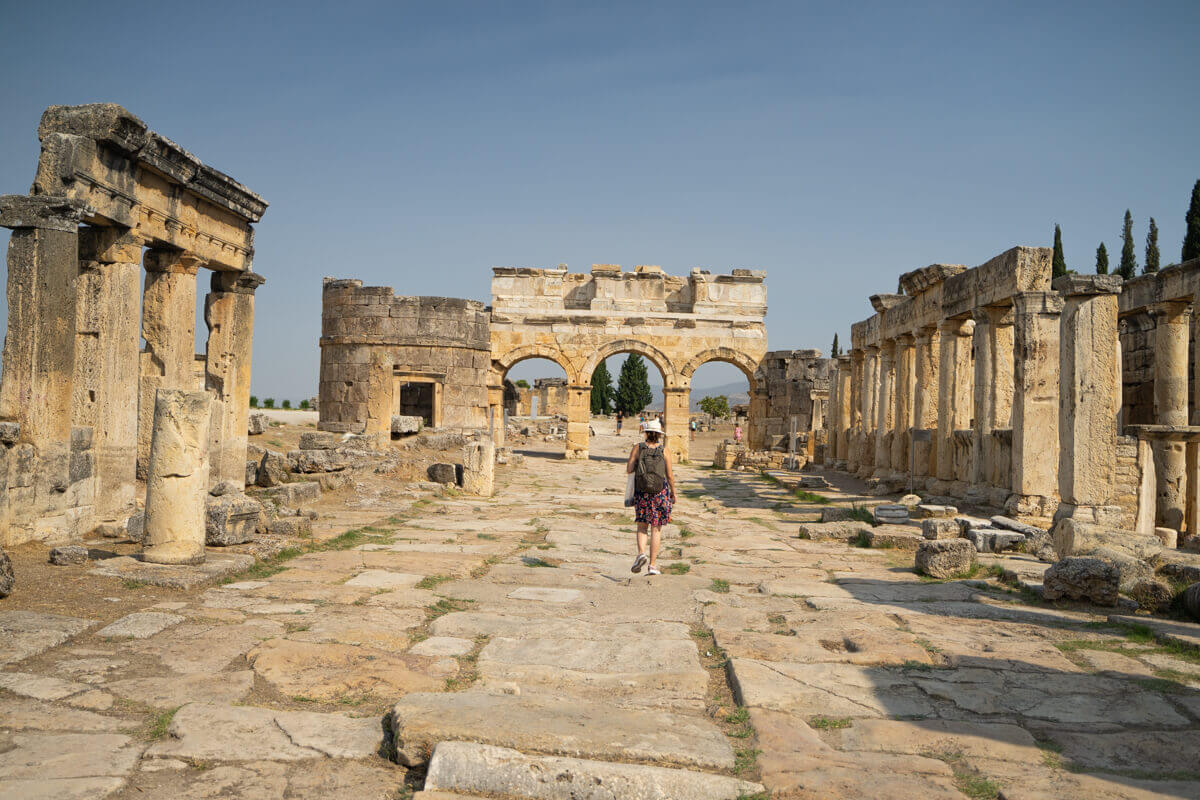
Above the terraces are the ruins of Hierapolis , an ancient city founded in the 1st and 2nd centuries A.D. by the Attalid King of Pergamon. The city grew rapidly due to its strategic location on the road connecting Lydia with Syria. There was a city standing before the Pergamon kings came to Hierapolis, but it was largely destroyed by an earthquake in 60 A.D.
All that remained from this Greco-Roman period before the Pergamons is the baths, an the ruins of a temple, an archway used as a city gate, a nymphaeum, necropolis and theater.
Hierapolis became a prosperous city in the 2nd and 3rd century, and a center of culture and learning, boasting a library second only to that of Alexandria. The city also played an important role in early Christianity; it was where Philip the Apostle was crucified in 80 A.D., and it’s suspected his tomb resides in the ruins there.
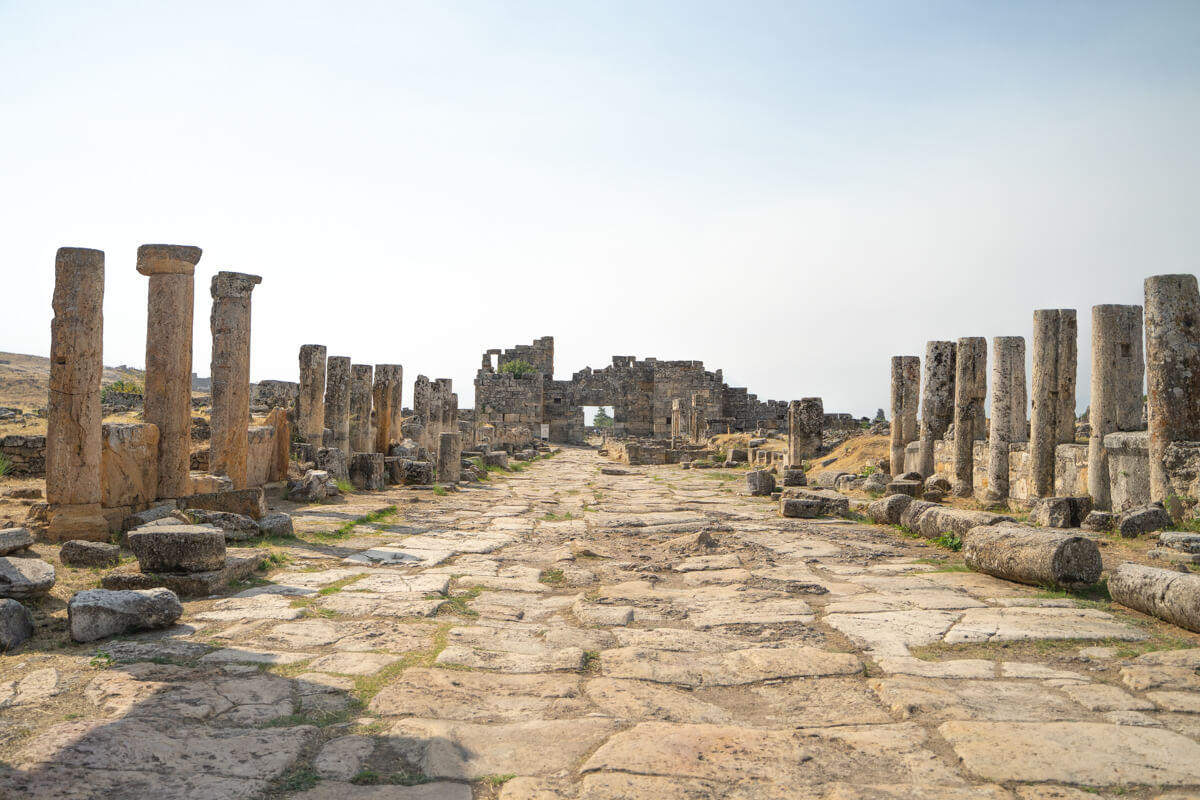
The hot springs at Hierapolis have been attracting visitors to the area since the Classical antiquity. The therapeutic properties were thought to have had healing properties. Hierapolis was taken over by Roman rule in 133 BC when Attalus III died, and was damaged by several major earthquakes.
When Turkey was taken over by the Byzantines in the 12th century, the city was abandoned. In 1354, another great earthquake toppled what was left of the city, and created the ruins you see today.
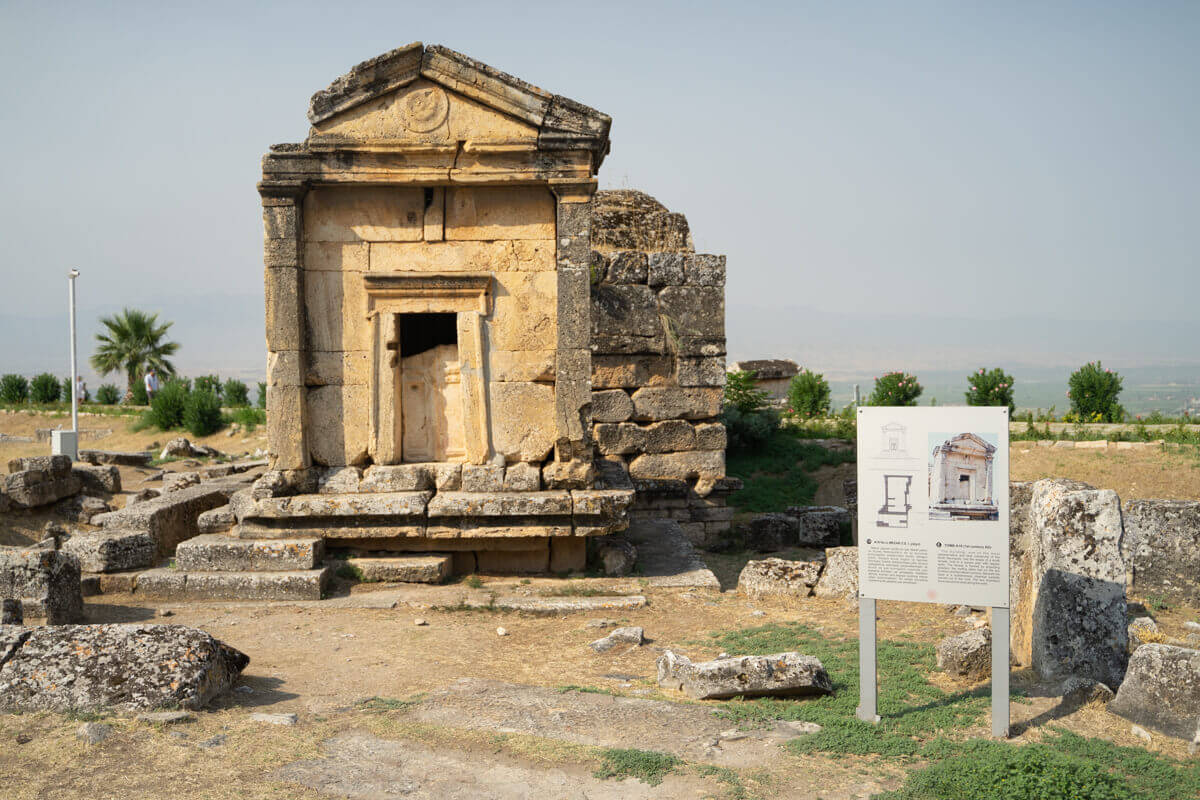
When Is The Best Time to Visit Pamukkale?
Pamukkale is open all year round, and any time of year you’ll be met with this beautiful natural wonder. But the best time to go to Pamukkale is definitely in the springtime.
The weather is just perfect in April and May, with average temperatures in the mid-20s Celsius. There are also not as many tourists as there are in the summer months, so you’ll be able to enjoy the attractions without having to battle crowds of people.
The summer is incredibly hot. We visited in August and were so lucky we decided to visit at sunrise because by 10.00am we were already starting to burn.
When the sun comes up, the ruins and the terraces are a startling white. There’s very little shade from the sun, so you’ll need sun protection.
Winter is another good time to visit as you might be lucky enough to see snow. Not many people choose to visit in the winter, so you’ll also be blessed with fewer tourists.
Sunrise is the best time of day to visit, or at least visit as early as you can.
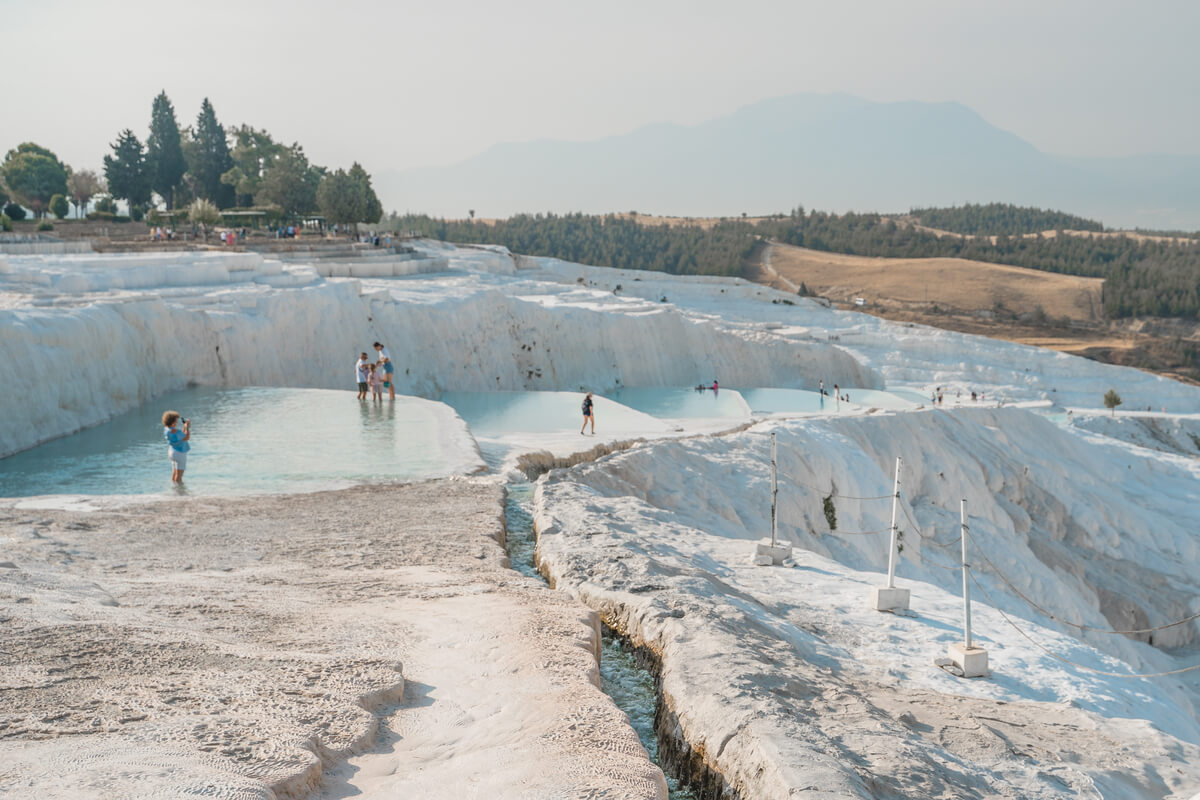
How to Visit Pamukkale for Sunrise
The travertine terraces in Pamukkale are an incredible sight to see, but for the best experience, you should visit them for sunrise. The terraces are shaded from the morning sun which turns them a stunning pale blue color. And best of all, there are barely any visitors. It’s a great way to start your day.
To visit the terraces for sunrise, you’ll need to get up early. There is only one gate open at 6.30am, and that’s the South Gate (sometimes referred to as the hidden gate). You’ll also need to buy a ticket, which costs 200 Turkish Lira to enter, and then walk down to the terraces from the top of the hill.
Getting to the South Gate is a bit of a trek. It takes 30 minutes to walk there and it goes up a steep road. It’s best to take a taxi if you can. You will find taxis from the town center, but there may not be many this time of the morning.
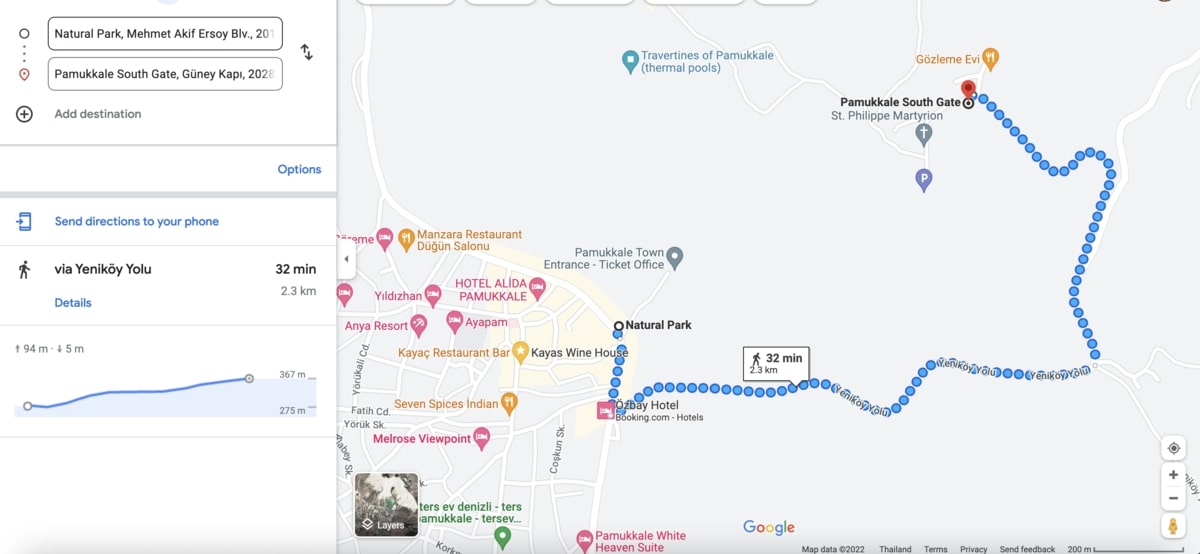
Is visiting Pamukkale for sunrise worth it?
If you’re not sure you want to get up this early and you’re wondering if Pamukkale is worth it for sunrise, the answer is an absolute yes!
The terraces were stunning this time of the morning, and we were also lucky enough to see some sunrise hot air balloons too.
There were pretty much no other visitors when we visited Pamukkale for sunrise. It was just us and maybe four other people. It remained quiet until the main entrance opened at 8.00am, but there still weren’t a huge amount of people.
Here is what the Terraces look like at sunrise…
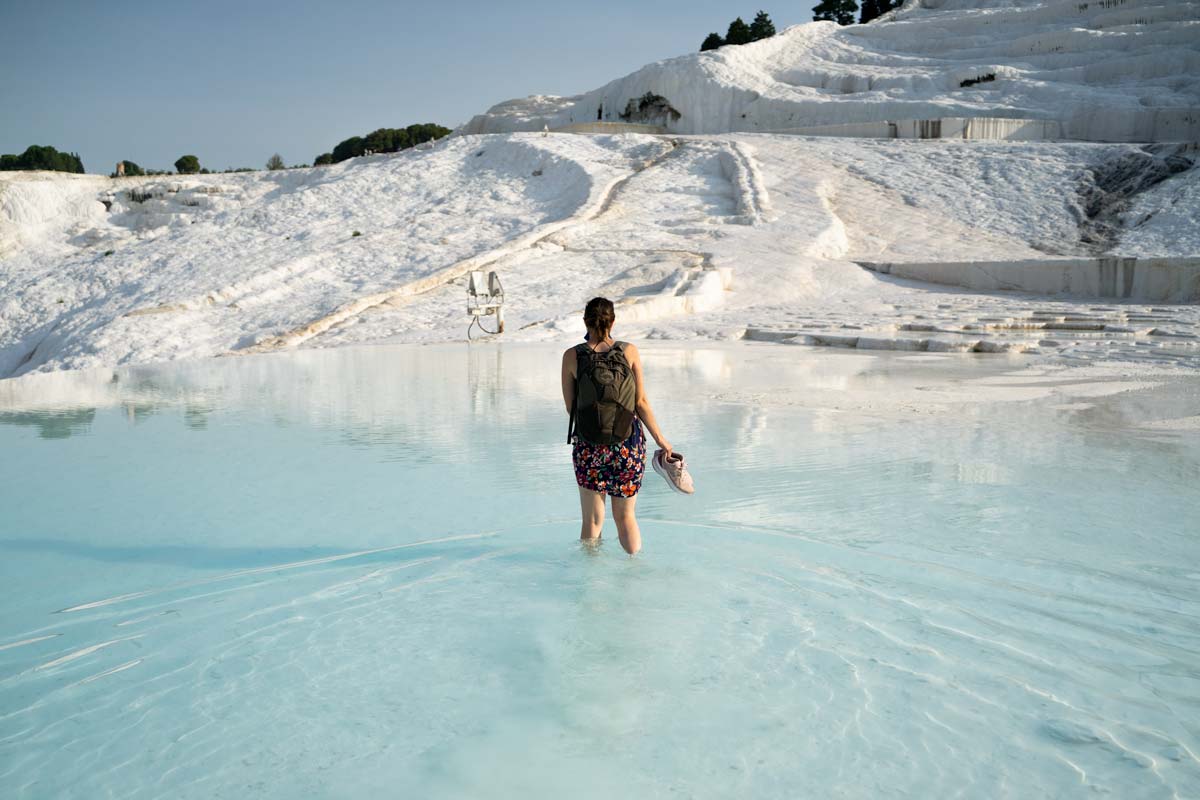
As you can see, it’s really quiet with only a few other people in the distance. We enjoyed walking through the terraces, but decided to swim after exploring Hierapolis so we didn’t walk around with wet clothes.
Big mistake. This is what the terraces look like by 10.00am…
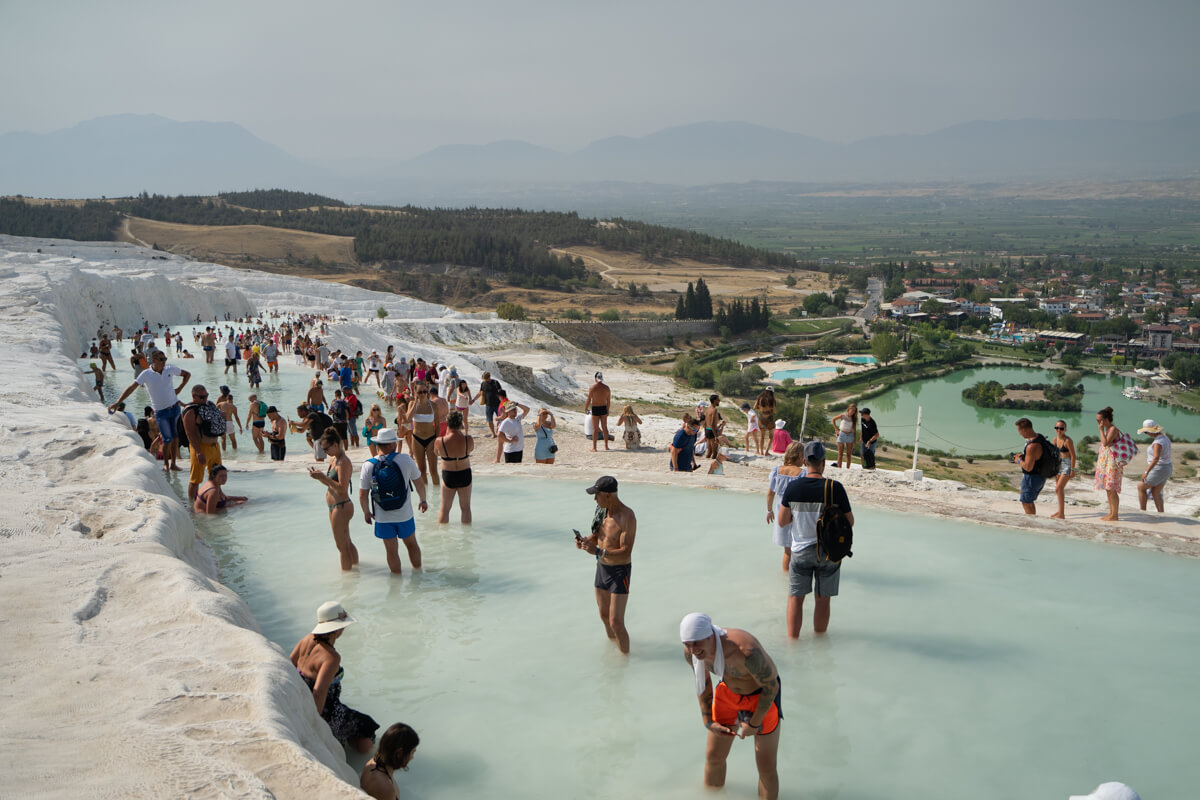
As you can see, it looks much nicer without the throngs of people. You won’t be alone if you visit for sunrise, but you will at least be able to get a nice photo of you in the pools without anyone in the background photobombing you.
What To See and Do At Pamukkale
As we mentioned earlier, Pamukkale is actually a town and has a lot to see and explore. Here are some of the main things to see and do at Pamukkale.
Swimming in the Travertines
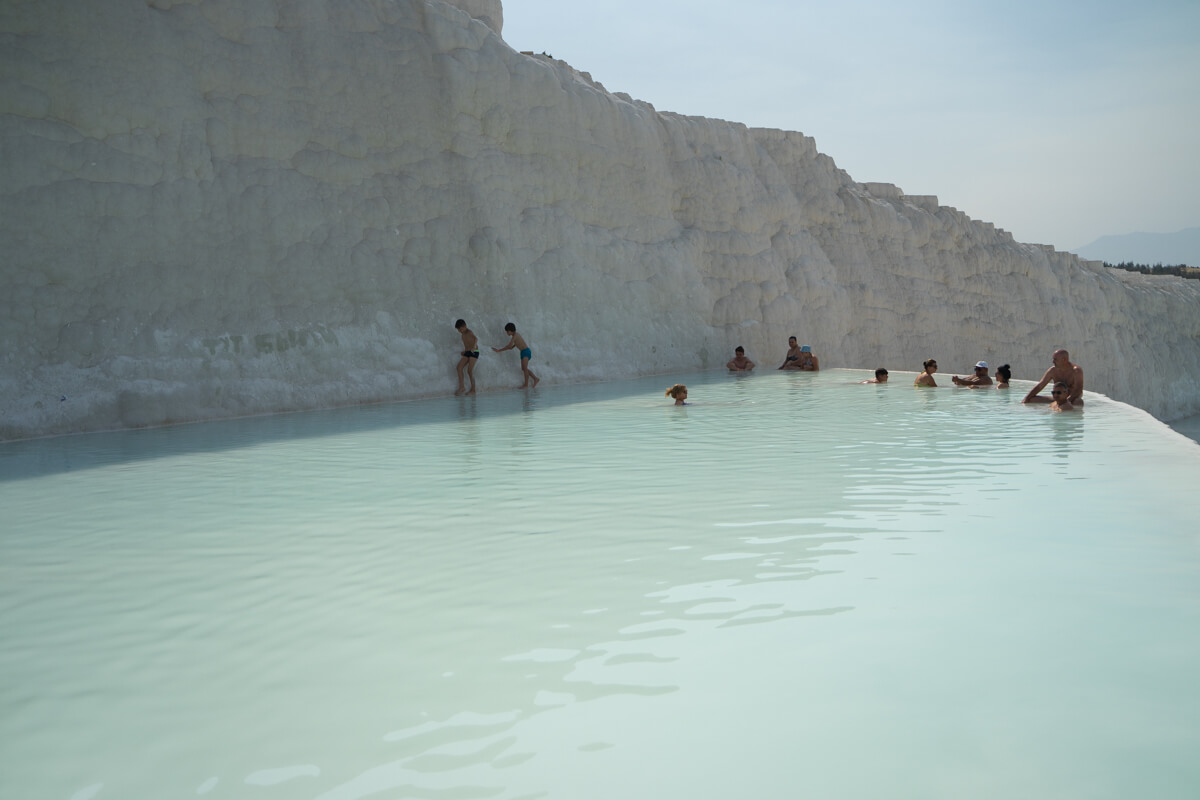
Pamukkale Travertine Terraces are one of the most beautiful places in the world for swimming. The water is a beautiful blue color and is filled with warm mineral water.
The water at Pamukkale is perfectly clear and very refreshing. It’s the perfect place to cool down on a hot day. The white rock is quite hard and a little slippery in places, but it doesn’t hurt your feet.
Some pools are deeper than others, especially the ones nearer to the bottom of the hill. You will find that most pools are waist deep (for an adult) and they slope gradually, so small children and toddlers can paddle near the edge too.
Visitors can enjoy swimming at Pamukkale year-round, but it’s best to go during the spring or summer when the weather is warm. There are several pools located at different points along the terraces, so visitors can choose their favorite spot. There are also several restaurants and cafes nearby, so visitors can enjoy a meal or drink and rehydrate after swimming.
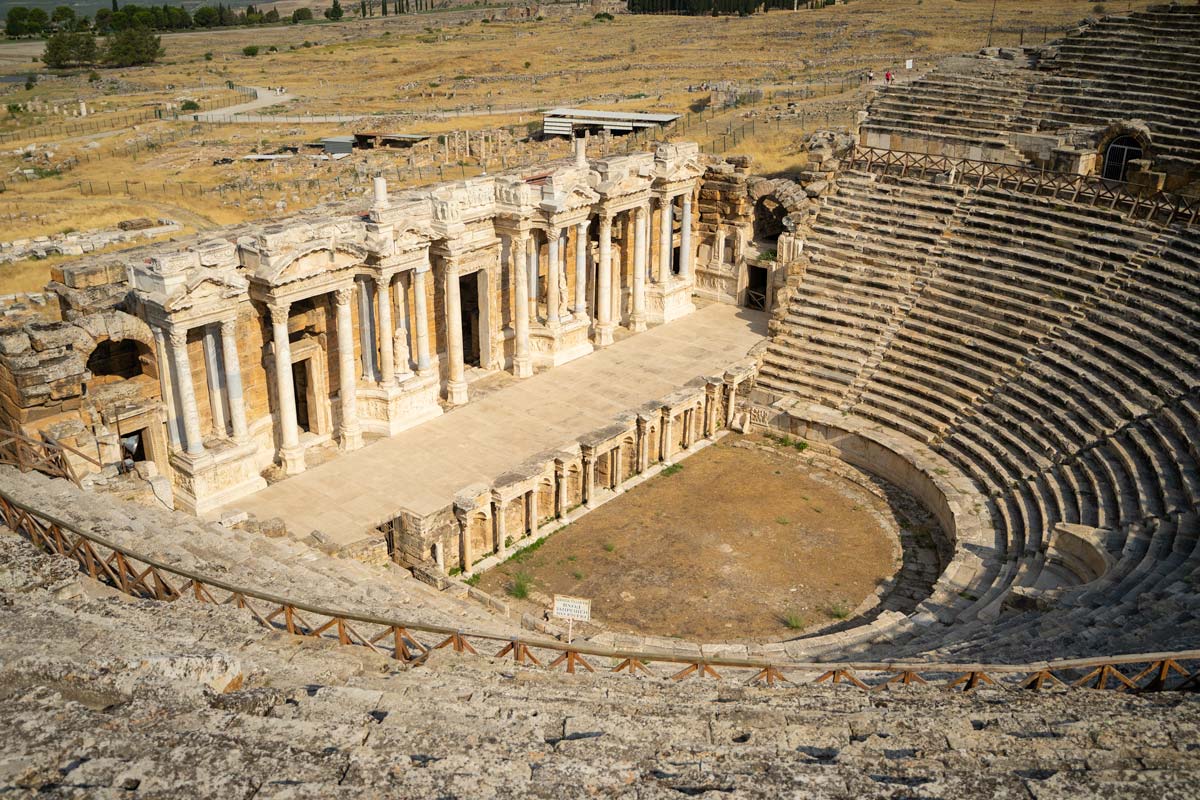
The ancient city of Hierapolis is a fantastic place to visit in Turkey for those interested in history and archaeology. The city is home to several ancient ruins, including the ancient theater, the Ancient Temple of Apollon, the Gate of Domitian, and the tomb of Philip the Apostle.
It is said that Hierapolis was founded in the 2nd century BC by the King of Pergamon. The city flourished as a religious and trade center in Turkey. It was destroyed by an earthquake in the 14th century, and so all that remains of the city now is ruins.
However, it’s still possible to make out what the buildings would have looked like, and the city arches and gates still have many of their reliefs and ornate decoration still in tact.
The theater is the largest and most well-preserved structure in the city and was built in the first century AD. It could seat up to 10,000 spectators in its prime.
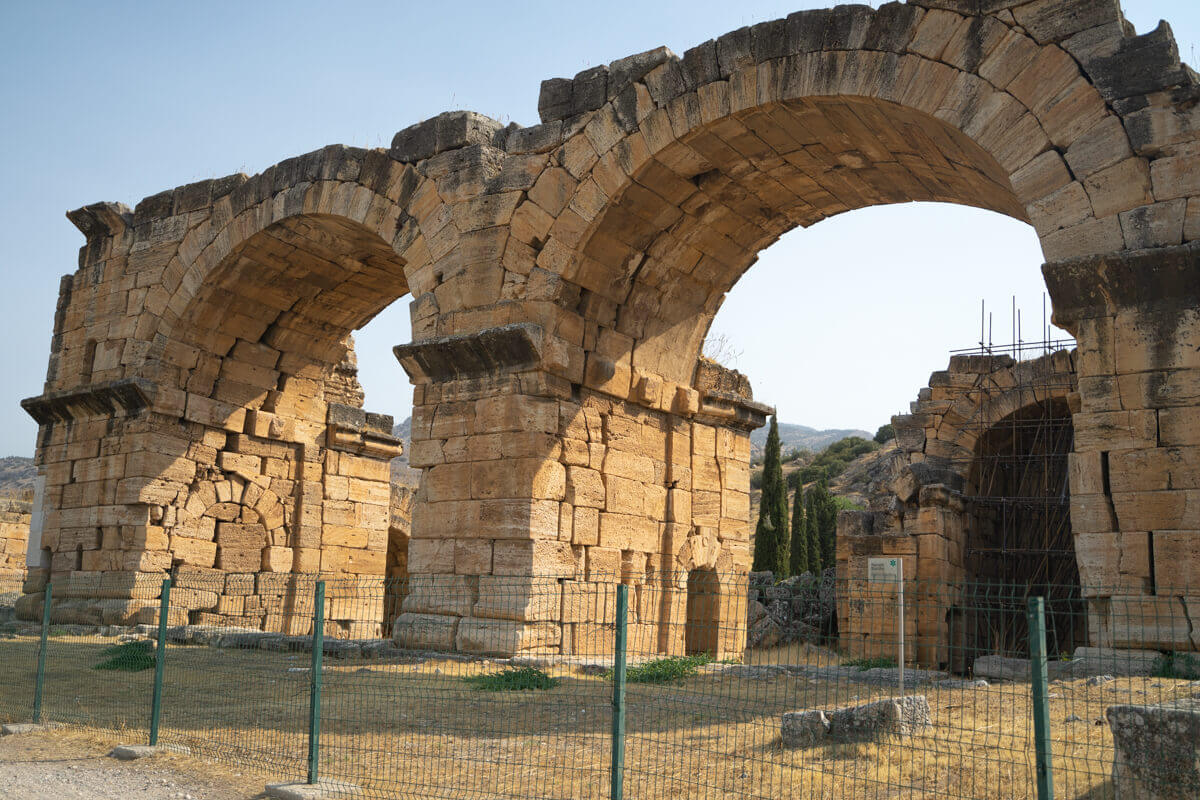
The Ancient Temple of Apollon is a small temple dedicated to the god Apollo, while the Gate of Domitian is a Roman arch that once served as the entrance to the city.
The tomb of the Apostle Paul is a small building located on the “hill of the victims.”
Cleopatra Antique Pool

The ancient city of Hierapolis was a popular destination for tourists since the first century AD. One of the main attractions was the Cleopatra Antique Pool, which was fed by hot springs.
The pool was named after Cleopatra VII of Egypt, who is said to have bathed in its therapeutic waters. And it’s easy to see why she loved it so much – the water is crystal clear and refreshingly cool, perfect for a relaxing swim.
The pool is an additional fee to the terraces and ancient city, but it offers a better place for swimming as it’s much deeper than the terraces. The pool has been restored since it was built in the 1st century, but it retains the authentic Romanesque decor and architecture.
If you’re looking for an unforgettable experience, be sure to add the Cleopatra Antique Pool to your list of places to visit!
The Archeology Museum
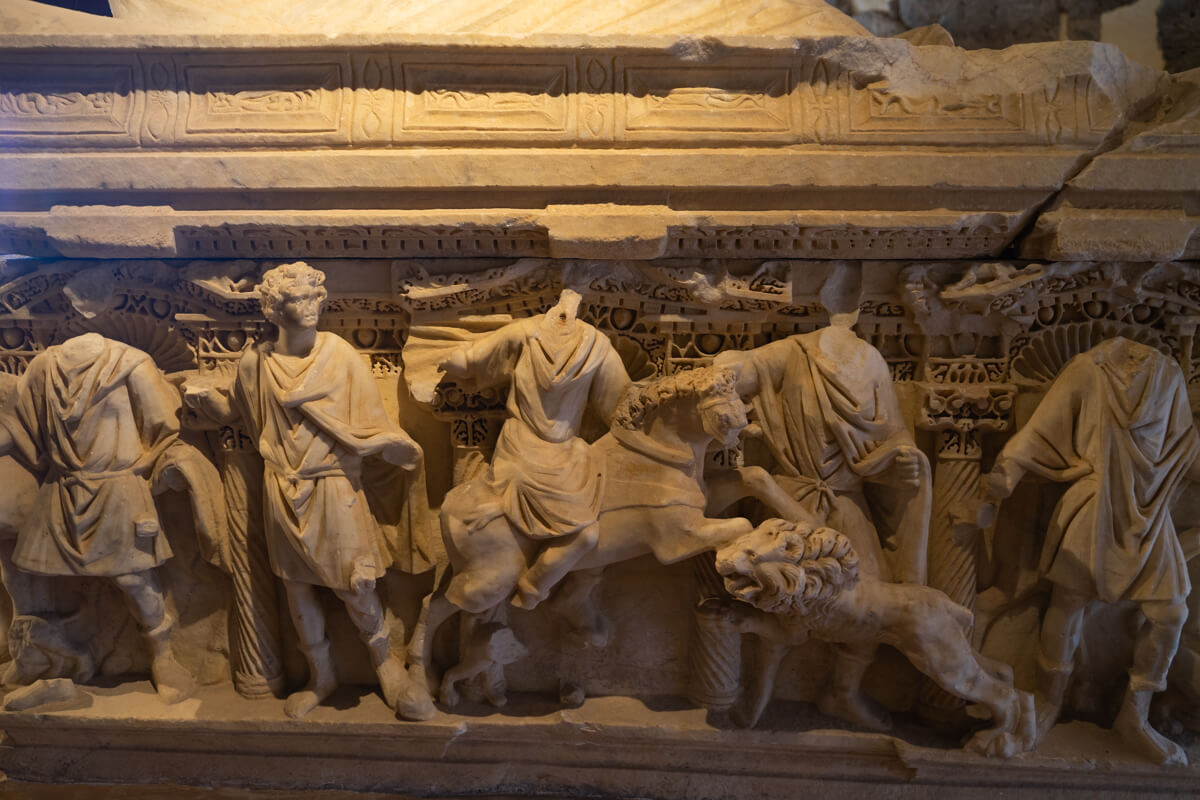
Pamukkale is also home to the Hierapolis Archeology Museum, which is also included in the entrance to the terraces and ancient city. The museum houses artifacts and statues from the city’s ancient past.
The museum includes sculptures, coins, mosaics, and sarcophagi. It is a fascinating glimpse into life in this ancient city. It’s only two rooms and doesn’t take long to wander around, but it is definitely worth checking out…and for the air conditioning.
Opening Hours and Entrance Fees
The Travertines are open from 6.30am until 8.00pm every day, seven days a week. It’s open until 8.30pm in the summer and closes at 6.30pm in the winter.
The Town Entrance and the North Entrance opens at 8.00am, which is why many people think that Pamukkale opens at 8.00 am. The South Entrance opens at 6.30am , which is the only way into the Travertines from 6.30am for sunrise.
As of January 2024, the entrance fee cost 850 Turkish Lira to enter the park. This grants you access to the terraces, the museum and the ruins of Hierapolis. If you want to visit the Cleopatra Ancient Pool, you will have to pay an additional entrance fee.
The Cleopatra Ancient Pool opens from 9.00am – 7.00pm every day and costs 200 Turkish Lira. If you have the Turkey attractions card, the price is reduced to 80 Turkish Lira. If you decide to take a locker, there is a deposit required for your key.
Hierapolis and the Travertine Terraces are included on the Turkey Museum Pass!
Want to save money on Museums? Get the Museum Pass!
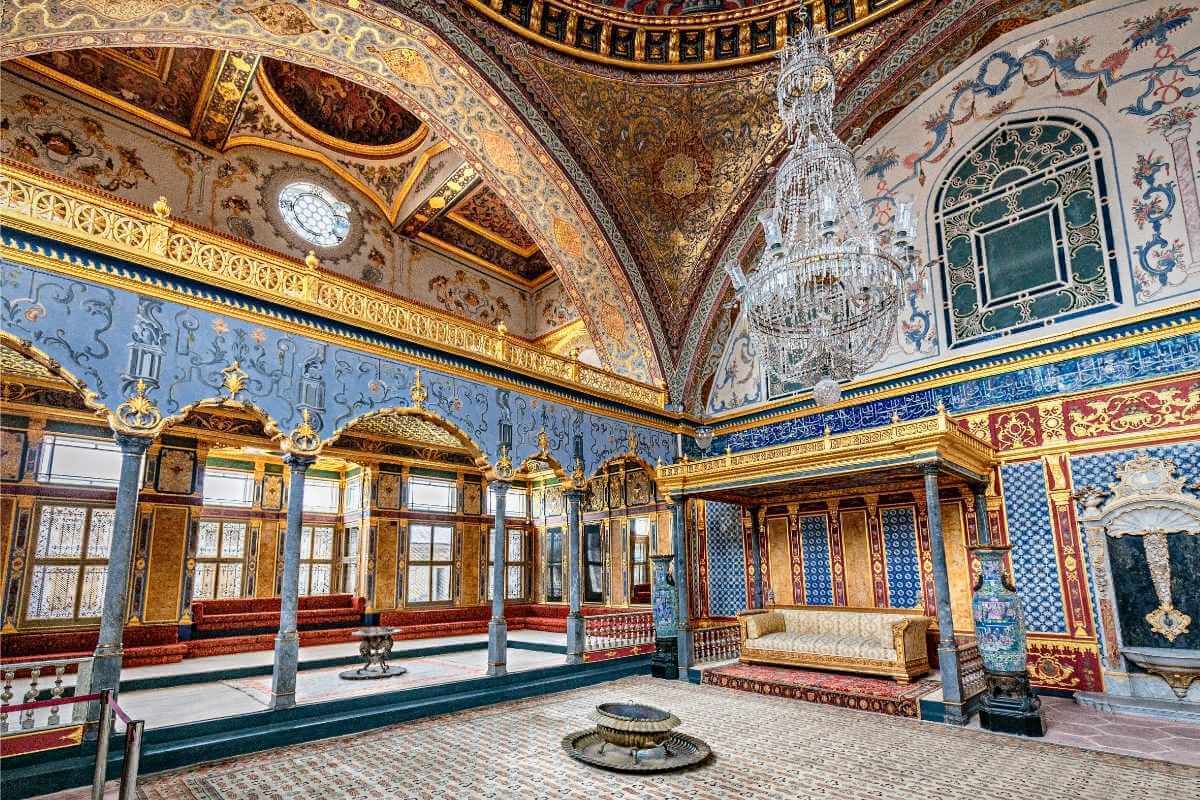
Get FREE access to over 200 museums in Turkey!
Make sure you get a museum pass to avoid standing in queues and save yourself some money on multiple attractions!
Get the pass delivered to your hotel for added convenience. Valid for 15 days!
Other Things to Do in Pamukkale Town
You might only know about the Travertines and Hierapolis and that’s because they are pretty much the only things you can do in Pamukkale. Besides visiting the Travertines, there are only two other attractions you might want to check out:
1. Ride in a Hot Air Balloon
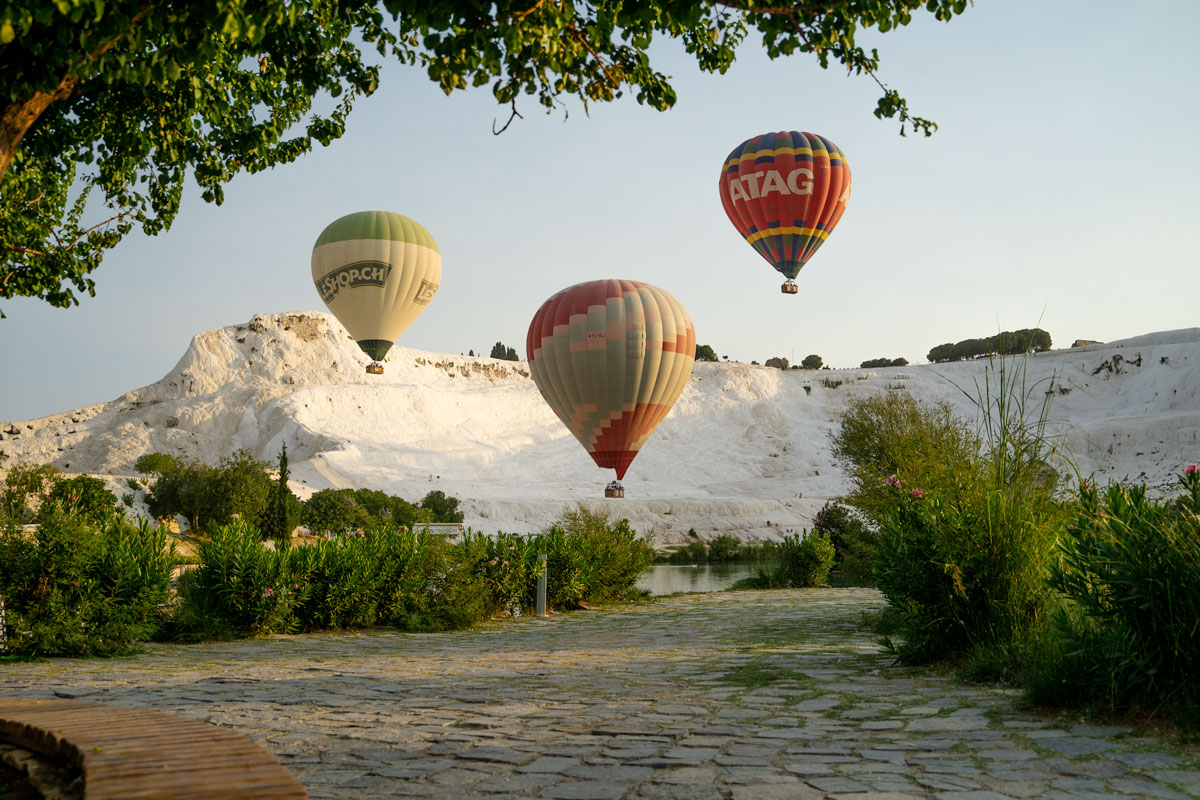
Riding in a hot air balloon is an experience like no other. As the balloon rises higher and higher into the sky, the view of Pamukkale below is breathtaking. It’s hard to believe that such a beautiful place exists on Earth. The sparkling white cliffs and turquoise waters are a sight to behold.
The best way to enjoy Pamukkale is from high in the sky, where you can take in the entire landscape at once. There’s nothing quite like floating above this natural wonder and taking in the peace and tranquility of the area. If you’re lucky, you might even see a few hot air balloons passing by.
Most hot air balloon tours fly early in the morning as the weather conditions are at their most stable. You can also enjoy the views in a comfortable temperature and see the colors transform as the sun comes up.
2. Splash Around in the Cavusoglu Aquapark
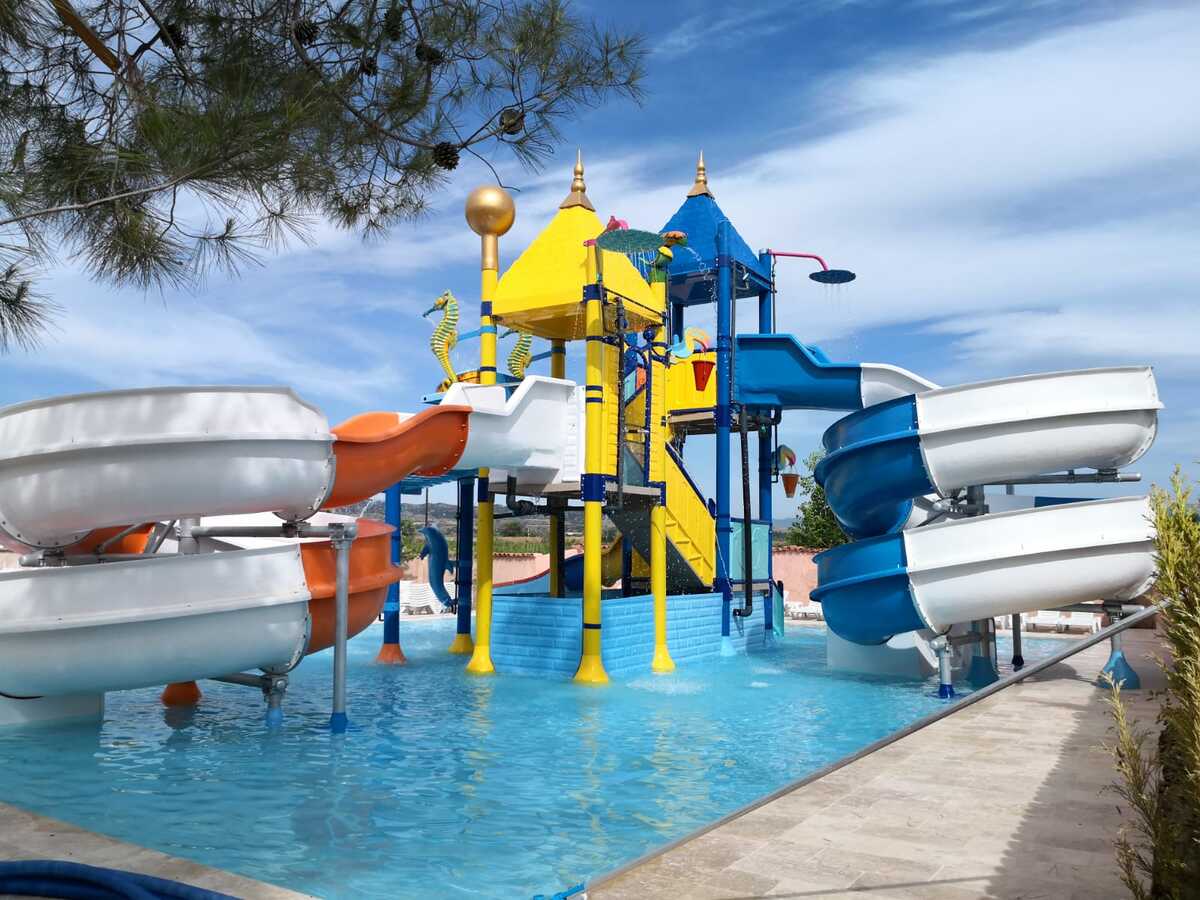
The Cavusoglu Aquapark is great for family fun and is located only a short drive outside of Pamukkale. It has waterslides, pools and fountains, and are a great palce for children to run around in and play. It’s also a refreshing place to cool off when the Pamukkale heat gets a bit too much.
The aquapark features two swimming pools and a further two children’s pools. There’s also a sand pool, jacuzzi and twelve water slides, plus nine slides that are suitable for kids.
The waterpark is seasonal though, and is only open in the summer. If you are visiting outside June to September, then you won’t be able to enjoy this attraction.
Where To Stay in Pamukkale
To make sure you make the most of your visit to Pamukkale, we recommend staying one or two nights so you can spend one full day exploring Pamukkale. Here are some suggestions for hotels:
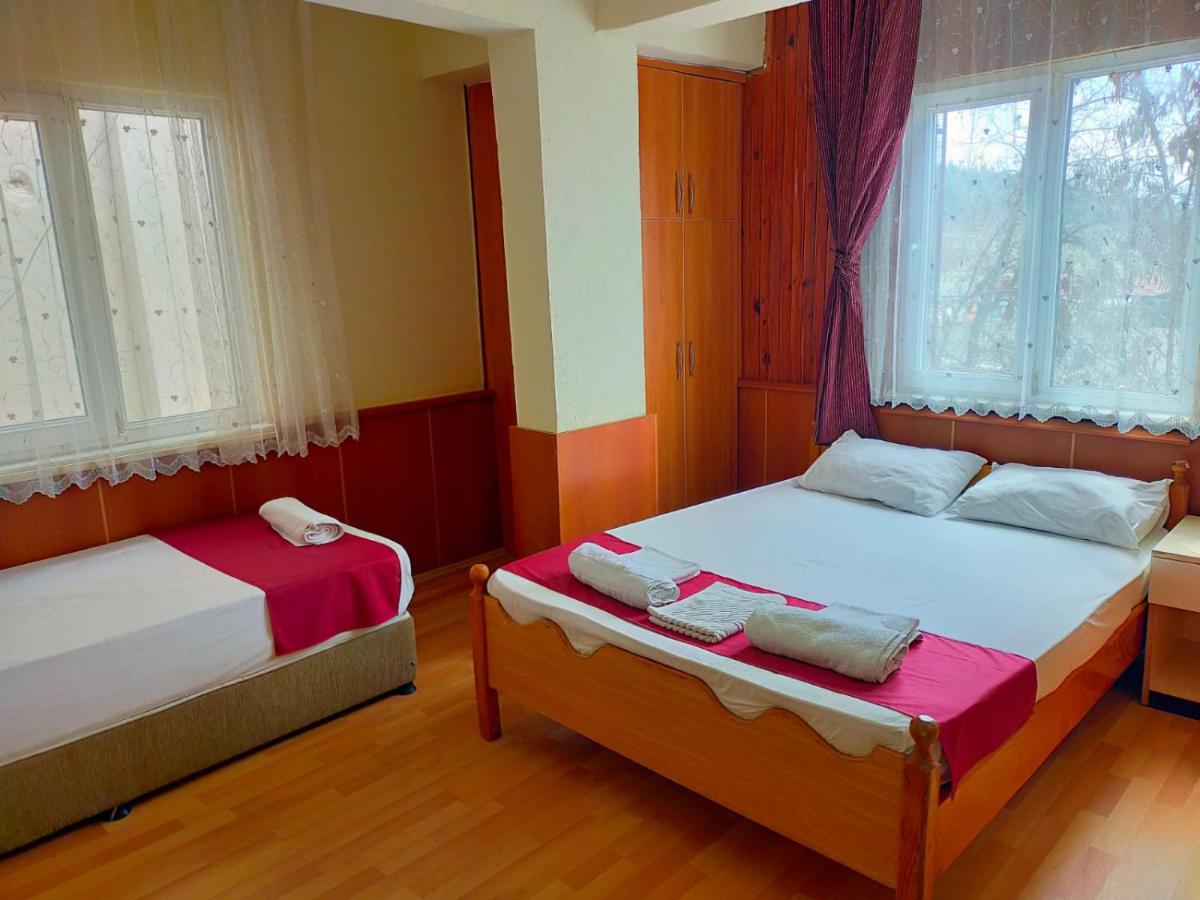
Best Budget Hotel in Pamukkale – Mustafa Hotel
We stayed at Mustafa Hotel when we visited Pamukkale and it was basic but comfortable. The location is great, only a five-minute walk from the Travertines and surrounded by restaurants. Actually, the hotel restaurant was the best food we ate in Pamukkale, so even if you don’t stay here, at least check out the restaurant downstairs. For anyone looking for a budget accommodation, it’s good for a couple of nights, but don’t expect anything fancy.
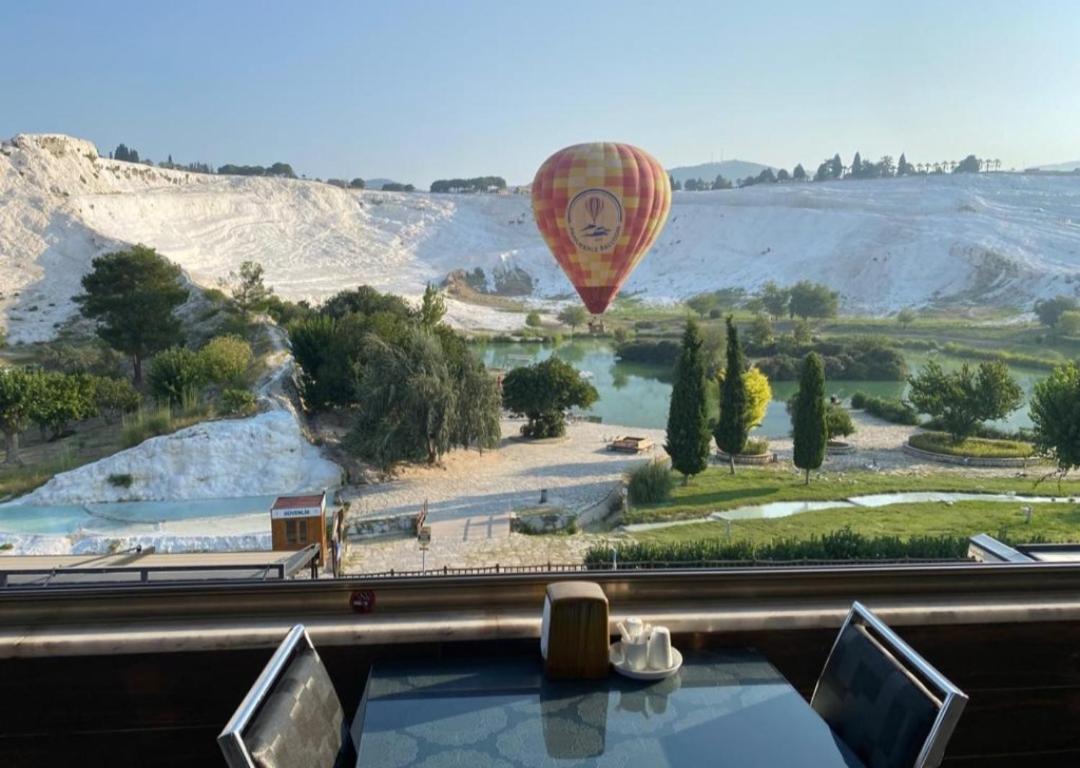
Best Mid-Range Hotel in Pamukkale – Hotel Sahin
If you’re looking for a mid-range hotel in Pamukkale then the Hotel Sahin is one of the best rated hotels in the town. It’s located directly across from the Travertines and you can even view them from the onsite restaurant. It has a refreshing outdoor pool, which you’ll definitely use as Pamukkale is HOT. Rooms come with air conditioning (phew) and some rooms even have a balcony looking at the Travertines.
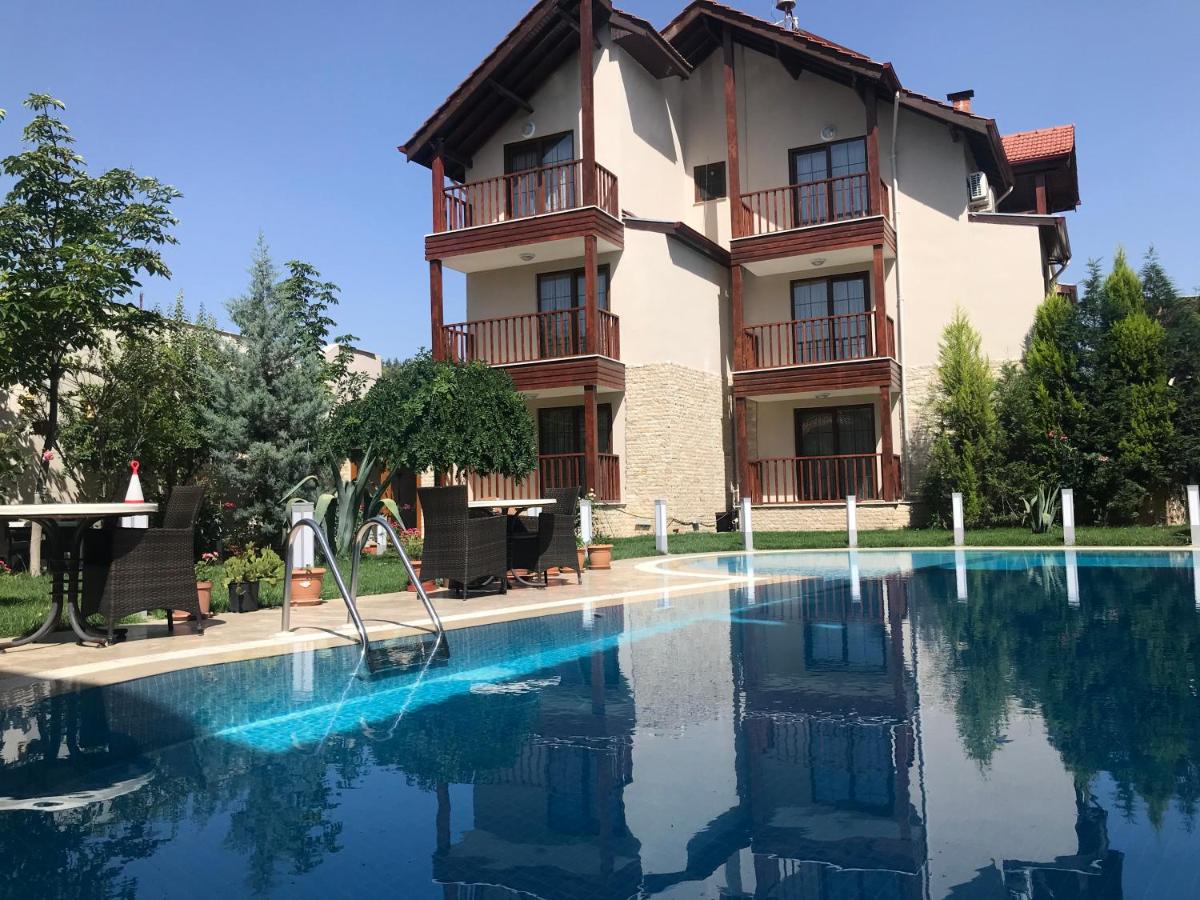
Best Luxury Hotel in Pamukkale – Venus Hotel
Located in a quiet area in Pamukkale is this luxurious hotel. Venus Hotel is a family-run four-star hotel with an outdoor swimming pool, open-air restaurant, and terrace. Rooms are spacious and decorated with modern furnishings. The best part about this hotel is that all meals are home-cooked and made in traditional style, so you get a really authentic experience when you stay here. It’s a five-minute walk to the Travertines.
FAQs about Visiting Pamukkale
Here’s what people usually ask us about visiting Pamukkale…
How much time do you need in Pamukkale?
Pamukkale isn’t just about the travertine terraces, there is also an entire ancient city to explore. Well, its ruins anyway. There’s also a Roman bath and you’ll want time to swim in the mineral pools. Plan for at least half a day to see all of the Travertines and Hierapolis . Stay in Pamukkale for two full days.
Is Pamukkale worth the trip?
The travertine terraces and Hierapolis are definitely worth visiting. Aside from being a natural wonder and an area of historical importance, it’s also beautiful. Aside from the Travertines and Hierapolis, the rest of Pamukkale is a bit boring , so we would say stay for a couple of days but no more.
Is there a train from Istanbul to Pamukkale?
There is a train to Denizli, the closest city to Pamukkale. From there, you would need to get a bus. There are shuttle buses that leave from Denizli Bus Station every 30 minutes.
Is 1 day enough for Pamukkale?
Yes, definitely. You will need half a day at the least to see the Travertine Terraces and Hierapolis, but if you have a full day to spend there do use all that time, there’s so much to see.
Tips for Visiting Pamukkale and the Travertines
Before you visit Pamukkale, we have just a few words of advice for you. These are things we wish we knew before we visited!
- Get there before 10.00 am , even if you don’t make it for sunrise. This was the time we saw the biggest crowds when we visited.
- Swim before you visit the Hierapolis. We decided to swim after because we didn’t want to walk around all wet. How wrong we were. By the time we got back, the pools were packed with people and there was no space to swim.
- Bring a change of clothes. Assuming you followed the advice above, change into some dry clothes before exploring Hierapolis.
- Enter from the South Entrance. You do need to get a taxi here as it’s a way out of the town, but it opens earlier and has fewer tourists using it.
- If you want to swim in Cleopatra’s pool, then get a ticket before you go because the queues are long.
- Wear sunglasses. The terraces are startling white, which means they reflect the sun and can hurt your eyes. Don’t forget your shades!
- Put on sun block. No matter what time of year you visit, Pamukkale is HOT.
- Bring flip flops. You are not allowed to wear shoes on the terraces, but for some reason flip flops are fine.
- Leave the drones at home. You’re not allowed to fly them here and there are people there telling you off for doing so (that was us, sorry).
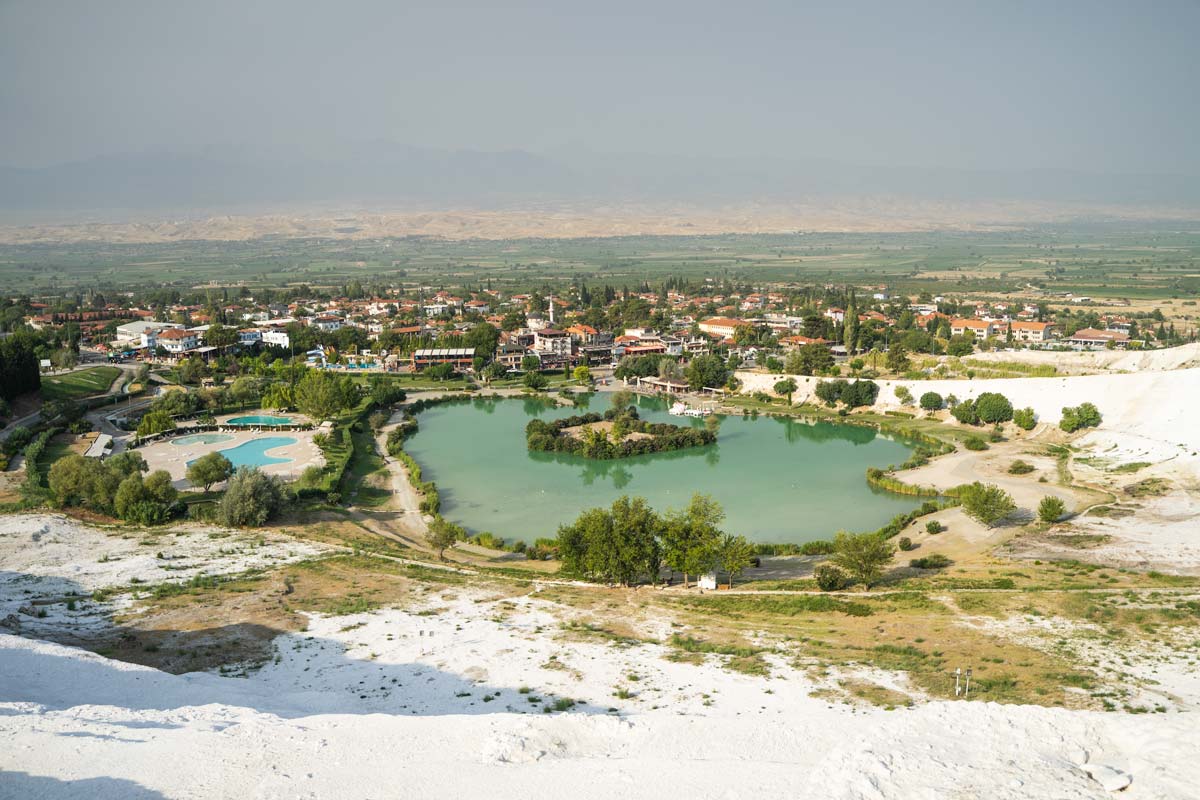
Before You Go
So there you have it, this is everything you need to know about visiting Pamukkale. As you can see, there’s a lot to explore here and it’s definitely worth spending a day here.
Before you go, remember to get yourself the museum pass . This pass allows you entrance to Pamukkale and Hierapolis as well as 200 other museums in Turkey.
While Turkey isn’t expensive to travel to, if you’re planning an entire Turkey itinerary , this will definitely save you some money on attractions.
Co-Founder of The Turkey Traveler
Louisa Smith
Louisa is a professional travel blogger with an insatiable wanderlust for exploring the captivating country of Turkey. With a deep appreciation for the country’s diverse history and natural beauty, Louisa has made it her mission to share the wonders of Turkey with the world. Born in the UK and raised by two Travel Agent parents, she was born with a perpetual case of the travel bug and now travels full time as a travel writer. Louisa has embarked on numerous adventures across Turkey, and shares her first-hand expertise and experience about her favorite destinations in Turkey, such as Antalya, Alanya, Fethiye and Bodrum.
18 thoughts on “How to Visit Pamukkale: Travertine Terraces + Hierapolis [Guide for 2024]”
Hi I have a question 1) which should I go first from capadoccia to pamukalle or capadoccia to Ephesus then after that going back to Istanbul 2) where can I leave my luggage or trolley in capadoccia?
I would go to Pamukkale first since it’s closer to Cappadocia, then to Ephesus, and then fly out of Izmir. There are hotels in Cappadocia where you can ask them to store your bags for a fee. I would recommend staying a few days in Cappadocia so you can see its attractions and have a place to leave your things.
Hi. I’m planning to be in Turkey for the first time between 19 and 26 July. After reading your information and doing my own research, I’m thinking Istanbul 3 days, Cappadocia 2 days and Ephesus/Izmir 1.5 days would give me a taste of a lot. A tour operator I contacted has also included Pamukkale and while it looks interesting and beautiful, I’m concerned that it may be too much, especially in the heat of late July. Would you recommend going with a tour operator for the whole trip, or is it relatively easy to book my accommodation, flights and transfers myself? I’m quite an experienced traveller and I want to make the most of that week in Turkey. Thanks so much for your wonderful site and advice!
Hi Tim, it’s possible to do it all yourself but you may need to book buses/internal flights and accommodation beforehand because July is a popular month to visit Turkey. I recommend you get direct flights between Istanbul and Cappadocia, and Cappadocia and Denizli (nearest one to Pamukkale) because they are long distances from each other and take a long time on a bus. Alternatively, you can take a night bus from Istanbul to Cappadocia, and Cappadocia to Denizli, if you’re someone who is able to sleep on buses. If you want to go with a tour company, it’s more expensive than doing it yourself but you do have all the travel planning hassle taken care of for you. You also get a guide to attractions, which is useful for places like Cappadocia and Pamukkale which don’t have a lot of signage telling you what you’re looking at. Either way, you’re going to have a great time in Turkey! You may find some more useful information in our 7 day Turkey itinerary .
Hi, Thanks for the information here. How easy was it to find tacinin the morning? We will be staying nearby venus hotel and wanted to go to the travertine at 6am
It’s quite easy to find since the travertines are right in the town. If you want to go for sunrise, you will need to go to the south gate as the others don’t open until later. You can get a taxi to the entrance because it’s a bit of a walk. Here is the Google Maps address for the entrance: https://goo.gl/maps/kPDkDmaUrvh8A7n26
Thanks heaps! Your post has been super informative to our upcoming trip in early Nov.
Hi Sean & Louise, Thank you for your informative page. May I please ask if you know where and the earliest time n frequency of the dolmus from pamukkale back to Denizli? Thanks in advance.
Hi Den, I remember the bus back to Denizli being a bit of a pain, as there is only one bus stop but three listed on Google maps. We missed the first bus because we went to the wrong stop. We had to ask for directions from a shop owner, and he pointed us to the right one. The one you want to go to is linked here . I believe the buses are meant to run every 30 minutes, but they don’t always run on time (this is normal in Turkey), so you may have to wait a while. You can book a private transfer by popping into one of the tour offices in Pamukkale or talk to your accommodation. If you’re on a budget, you can wait for the bus as it is cheaper, but if you’re short on time then I recommend getting a private transfer. It’s also pretty hot in Pamukkale so not fun sitting around waiting in the heat. I hope this helps!
Thanks Sean & Louise. Appreciate your prompt response.
Hi Sean & Louisa, I am planning to visit Turkey in the month of March. Will that be a good time to visit? The itinerary you shared is quite helpful, and I am thinking of doing a 7 day trip from Istanbul to Cappadocia to Pammukale. Do you think that can be covered in 7 days? Also, please help me understand would it be recommended to come back to Istanbul from Pammukale for my return journey, or is there a better route (international airport nearby)?
Hey Adi, 7 days should just be enough time for the three destinations. We don’t recommend you to go back to Istanbul to fly out. Pammukale, you can fly from Denizli Çardak Airport. That’s the closest airport to Pamukkale.
Thanks, that’s helpful! Can you also please confirm if March is a good time to visit, and would you recommend visiting Pammukale or Antalya?
March would be a great time to visit either Antalya or Pamukkale since it won’t be too hot but not freezing cold either, so you can get out and explore. There’s also not much rain this time of year. You can visit Pamukkale as a day trip from Antalya, though it will be a long and full day and note there is a lot of time spent on the bus. However, this is the best way to see Pamukkale as aside from the terraces, there really is nothing else to do there. Antalya has lots to see and do, as well as many day trips you can take, so I would recommend basing yourself in Antalya and taking day trips.
Hello Sean and Louise,
Thank you for your web, great help for people like me. I am planning to visit Pamukkale in May. However I am traveling on my own, Im 60 and never have traveled alone before. Do you think there might be a problem with this ? Thank you in advance for your kind help. Yours, Mercedes
Hi Mercedes, you shouldn’t have any trouble traveling alone. I (Louisa) traveled alone to Turkey this past March and had no issues. I suggest you get a local sim card or access to data and have your itinerary mapped out before you go, and you should be fine. You can learn about local sim cards via our guide here: https://theturkeytraveler.com/turkey-sim-card-for-tourists/
Is it safe for a month pregnant women to travel to traventines. can we go to cleapatra pools with out crossing traventines by foot?
Hi Sanj, I wouldn’t know if it’s safe to go swimming in the pools, you’d need to ask your doctor about this as there are minerals etc in the water. You can reach Cleopatra Pool without crossing the Travertines. If you visit via the North Entrance, then you can walk through the ruins to Cleopatra Pools. The terrain here is a mixture of dusty, natural surface and old, cobbled road, but not slippery or dangerous. You can find the entrance from this location.
Leave a Comment Cancel reply
Save my name, email, and website in this browser for the next time I comment.
AFFILIATE DISCLOSURE
This website uses affiliate links, meaning I may earn a commission if you make a purchase through a link at no extra cost to you. TheTurkeyTraveler is a participant in the Amazon Services LLC Associates Program. As an Amazon Associate, I earn from qualifying purchases. For more information, see our full affiliate disclosure .
© 2024 The Turkey Traveler

No products in the cart.
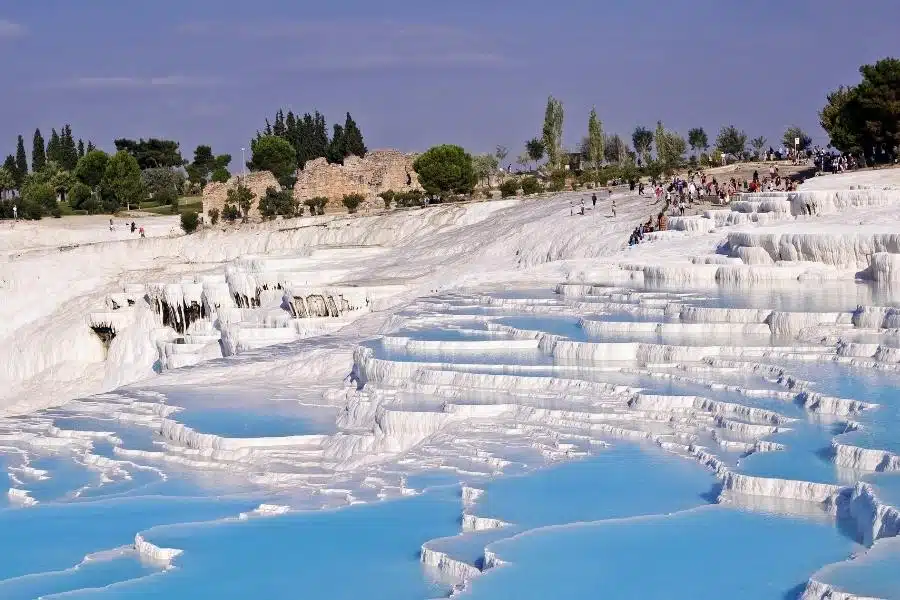
Pamukkale Travel Guide – Planning Your Visit to Pamukkale, Turkey
Discover the cotton castle: your ultimate guide to pamukkale.
Nestled in the picturesque landscape of southwestern Turkey lies Pamukkale, a natural wonder that captivates visitors with its snow-white terraces and thermal waters. Known as the “Cotton Castle” in Turkish, Pamukkale is a unique blend of natural beauty and historical significance, making it a must-visit destination for any traveler. This Pamukkale Travel Guide is your comprehensive companion, ensuring you experience the best of this enchanting location.
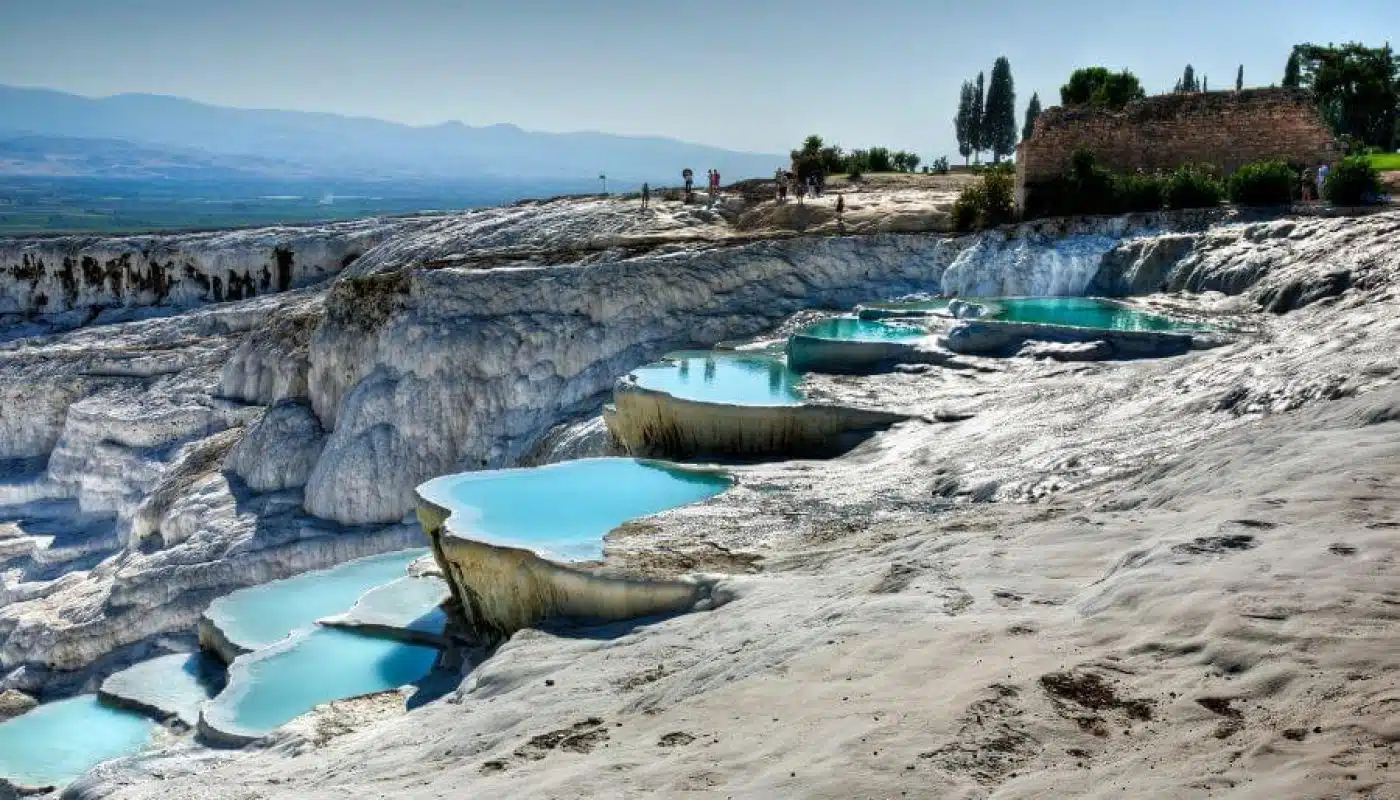
When to Visit Pamukkale
Timing is everything when planning a trip to Pamukkale. The best times to visit are during the spring (April to June) and fall (September to November). These seasons offer pleasant weather, fewer crowds, and the perfect conditions to explore the terraces and nearby ancient ruins.
Reaching Pamukkale
Pamukkale is accessible by various means:
- By Air : The nearest airport is Denizli Çardak Airport, about an hour’s drive from Pamukkale. Regular shuttles and taxis are available.
- By Road : Buses connect major Turkish cities to Denizli, from where you can take a local minibus to Pamukkale.
- By Train : Trains from Izmir and other cities arrive at Denizli, where you can continue your journey by bus or taxi.
Exploring the White Terraces
The travertine terraces are Pamukkale’s crowning glory. Formed by mineral-rich thermal waters, these terraces look like snowfields amidst the green landscape. Walking barefoot on these terraces is a surreal experience. Remember to protect these natural wonders by following the designated paths.
Historical Landmarks of Turkey: Hierapolis
Adjacent to the terraces is the ancient city of Hierapolis, a UNESCO World Heritage Site. Explore the well-preserved theater, necropolis, and the Temple of Apollo. Don’t miss the Hierapolis Archaeology Museum for a deeper understanding of the area’s rich history.
Pampering in Thermal Waters
The thermal waters of Pamukkale have been used for their therapeutic properties since Roman times. The Antique Pool, also known as Cleopatra’s Pool, is a must-visit for a relaxing swim among ancient ruins.
Turkish Cuisine Guide: Local Delights
No visit to Pamukkale is complete without indulging in the local cuisine. Try traditional dishes like gözleme (Turkish pancakes) and testi kebab (meat cooked in a clay pot). For a unique dining experience, visit the vineyards in the nearby town of Sarayköy for a taste of local wines.
Accommodations: Unique Stays in Pamukkale
Pamukkale offers a range of accommodations, from luxurious resorts to charming guesthouses. Many hotels offer their own thermal pools, giving you the chance to enjoy Pamukkale’s thermal waters in a more private setting.
Most Popular Recommended Tours in Turkey
4 Days Cappadocia, Pamukkale, and Antalya Tour from Istanbul : Embark on a captivating journey through Cappadocia’s fairy chimneys , the thermal pools of Pamukkale, and the stunning beaches of Antalya. Experience the rich culture and breathtaking landscapes in just four days. Discover More & Plan Your Trip
5-Day Pamukkale, Ephesus, and Cappadocia Tour from Istanbul : Discover the ancient wonders of Ephesus , the natural beauty of Pamukkale, and the unique landscapes of Cappadocia in this immersive five-day tour from Istanbul. Explore the Full Itinerary
5 Days Konya, Cappadocia , Ephesus, and Pamukkale Tour from Istanbul : Explore the spiritual heart of Konya, the breathtaking valleys of Cappadocia, the historical sites of Ephesus, and the thermal terraces of Pamukkale on this enriching five-day tour. View Details & Book Now
6-Day Istanbul, Pamukkale, Ephesus, and Cappadocia Tour : Experience the best of Turkey with a comprehensive six-day tour covering Istanbul’s iconic landmarks, the ancient ruins of Ephesus, Pamukkale’s natural beauty, and the mesmerizing landscapes of Cappadocia. Get the Full Itinerary
7 Days Istanbul , Cappadocia, Pamukkale, and Ephesus Tour : Delve into Turkey’s rich history and natural beauty with a seven-day adventure that takes you from the vibrant streets of Istanbul to the stunning sites of Cappadocia, Pamukkale, and Ephesus. See the Complete Tour Plan
8-Day Istanbul, Pamukkale, Ephesus, and Cappadocia : Explore the highlights of Turkey over eight days, including Istanbul’s bustling bazaars, the ancient city of Ephesus, Pamukkale’s thermal springs, and the surreal landscapes of Cappadocia. Check Itinerary & Book
9-Day Istanbul, Cappadocia, Antalya , Pamukkale, and Ephesus Tour : Experience a nine-day tour that captures Turkey’s diverse beauty, from Istanbul’s historic sites to Cappadocia’s unique rock formations, Antalya’s pristine beaches, Pamukkale’s thermal waters, and Ephesus’s ancient ruins. Plan Your Journey
10 Days Istanbul, Ephesus, Pamukkale, Antalya, and Cappadocia Tour : Immerse yourself in a ten-day journey through Turkey’s most iconic destinations, including Istanbul, Ephesus, Pamukkale, Antalya, and Cappadocia, each offering its own unique cultural and natural wonders. Explore This Tour
11-Day Istanbul, Cappadocia, Antalya, Pamukkale, Ephesus, Troy , and Gallipoli Tour : Discover the full spectrum of Turkey’s history and natural beauty with this eleven-day tour, featuring Istanbul, Cappadocia, Antalya, Pamukkale, Ephesus, Troy, and the historic battlefields of Gallipoli. See the Full Itinerary
12-Day Istanbul, Konya , Cappadocia, Antalya, Pamukkale & Ephesus Tour : This twelve-day tour takes you through Istanbul, the spiritual city of Konya, the rock formations of Cappadocia, Antalya’s Mediterranean charm, the thermal pools of Pamukkale, and the ancient city of Ephesus. Get More Information
13 Days Istanbul, Gallipoli , Troy, Pergamon, Ephesus, Pamukkale, Antalya & Cappadocia Tour : Over thirteen days, explore the historical and cultural treasures of Turkey, including Istanbul, Gallipoli, Troy, Pergamon, Ephesus, Pamukkale, Antalya, and Cappadocia, each offering a glimpse into the country’s rich past. View the Itinerary & Book
Adventurer’s FAQ: Your Pamukkale Queries Answered
Q: How much time should I allocate to explore Pamukkale? A: To fully enjoy Pamukkale and Hierapolis, plan to spend at least one full day. This will give you enough time to explore the terraces, the ancient ruins, and enjoy a dip in Cleopatra’s Pool without feeling rushed.
Q: Is it safe to walk on the terraces? A: Yes, it is safe to walk on the terraces, but you must remove your shoes to protect the delicate calcium deposits. The paths can be slippery, so walk carefully and stay on the designated routes.
Q: What should I wear when visiting Pamukkale? A: Wear comfortable, non-slip footwear for walking around the ruins, but be prepared to go barefoot on the terraces. A swimsuit is essential if you plan to swim in Cleopatra’s Pool. Also, bring sunscreen and a hat, as there is limited shade.
Q: Can I visit Pamukkale year-round? A: Yes, Pamukkale is open year-round. The thermal waters are warm even in winter, making it a great destination regardless of the season. However, spring and autumn offer the most pleasant weather for exploring.
Embrace the Magic of Pamukkale
Pamukkale is more than just a place to visit—it’s a journey into a world where nature’s beauty and ancient history come together in harmony. Whether you’re soaking in the thermal waters, exploring the ruins of Hierapolis, or simply gazing at the stunning terraces, Pamukkale offers a unique experience that will leave a lasting impression on your soul.
Top 3 Suggested Tours of Ephesus and Pamukkale

Similar Posts
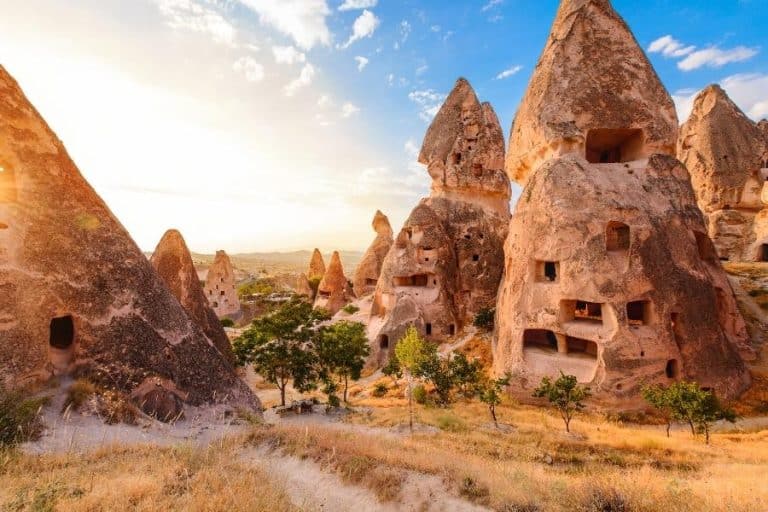
How to Do a Day Trip to Cappadocia from Istanbul: A Magical Journey
Embark on a day trip from Istanbul to Cappadocia, exploring must-visit sites like Devrent Valley, Avanos, Zelve Open Air Museum, Uchisar, and Kaymakli. Discover the ancient wonders of Cappadocia in this comprehensive guide.

Embark on an Adventure of a Lifetime in Turkey
Discover the Rich History, Culture, and Beauty of Turkey: An Unforgettable Journey Awaits Are you ready for an adventure of a lifetime? Turkey offers a unique blend of ancient history, modern culture, delicious food, and outdoor activities that you won’t find anywhere else in the world. From exploring historical sites to savoring traditional food and…

Do I Need a Visa to Visit Turkey? A Comprehensive Guide
Turkey visa guidelines by nationality, grasp visa-free access details, understand e-Visa system, application procedures, and advice for seamless, stress-free journeys.
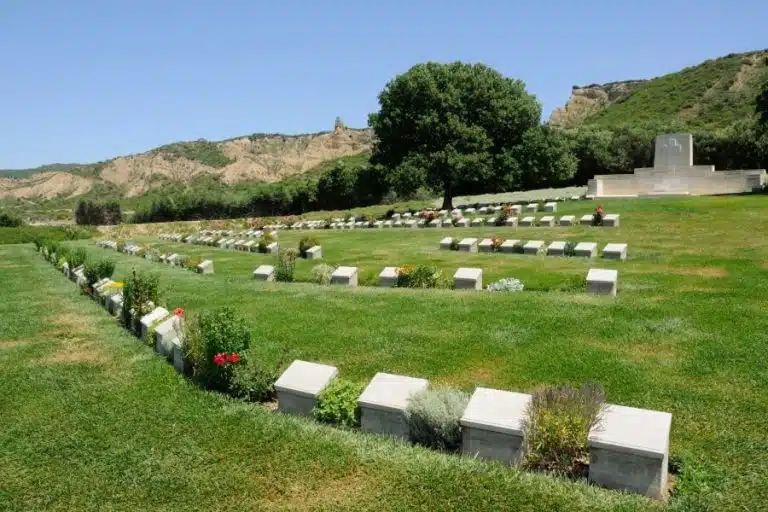
Experience The Battlefields Of Gallipoli
Gallipoli Day Trip From Istanbul A Gallipoli Day Trip from Istanbul is a great way to explore a historically significant yet relatively unknown site. From the sweeping views of the Dardanelles to the many monuments that commemorate the brave men and women who fought in one of the worst battles in modern history, a day…

What is the currency in Turkey?
Uncover the history of Turkey’s official currency, the Turkish Lira, and learn valuable tips for currency exchange as you delve into the nation’s rich culture.

What is the history of Ephesus: Ancient Greek Origins to Roman Prosperity
Discover the fascinating history of Ephesus, an ancient city that flourished from Greek origins to Roman prosperity. Learn about its significance as a religious, commercial, and cultural hub, featuring the Temple of Artemis and the Library of Celsus.

The Perfect One Day in Pamukkale Itinerary
Published on November 7, 2023
by Audrey Webster
Disclaimer: This article contains affiliate links. That means if you click a link and make a purchase, we may make a small commission. As an Amazon Associate we earn from qualifying purchases. For more information, see our privacy policy.

Pamukkale, Turkey is a small city in south-west Turkey known for its pristine white limestone hills where hot spring water has pooled to create a stunning, steamy landscape. In 1988, Pammukale and the ancient city of Hierapolis tucked behind the springs were added as a UNESCO World Heritage Site—both will be the main destinations in your Pamukkale itinerary. One day in Pamukkale is just enough to admire the highlights and wander off the beaten path.
Keep reading for everything you should know for your visit to this historic place.
Table of Contents
How Many Days in Pamukkale?
On average, one day is plenty to spend in Pamukkale. You’ll have plenty of time to visit the travertine terrace pools, Hierapolis, and Cleopatra’s Pool with some time left over to explore the town of Pamukkale. To maximize your time spent here, plan to spend a night on either end of your one day in Pamukkale.
If you stay more than one day, you can revisit the travertine pools. It’s worth it to arrive just as they open to admire the sunrise over the clear blue spring water. Alternatively, you could head out of town to explore the surrounding countryside.

Getting To & Around Pamukkale
If you’re planning to spend a night or two in Pamukkale, you can fly from your current destination to Denizli Cardak Airport. It’s the nearest airport to Pamukkale, but it’s still about an hour’s drive away.
You can take a taxi or reserve a spot on a bus to take you into Pamukkale. The latter option allows you to reserve a ticket in advance and hop on the bus right outside the airport. It’s also the most cost-efficient mode of transportation.
Pamukkale is also located about equidistant between Antalya and Izmir , making it a good destination to stop at if traveling between these two cities.
You can take a bus from either of these cities to Denizli and connect to Pamukkale – a taxi ride will take about 20 minutes from the bus station to the town. Expect the total journey to take about 3-4 hours depending on the route. You can view schedules here.
You also have the option of taking a day trip to Pamukkale by booking a day trip from Izmir or Antalya that includes a visit to both Pamukkale and Hierapolis. You can also organise a 2-day trip from Istanbul .
Once you arrive in Pamukkale, getting around by foot is easy. The town is small and the bright white travertines backdrop the town—you can easily walk to and around them as well. You’ll only need to reserve a day trip or car if you plan to venture beyond the city.

One Day in Pamukkale Itinerary
If you have a day to spend in Pamukkale, it’s plenty of time to check out the city’s highlights. Here’s everything you should plan to see during your visit.
Take a hot air balloon ride
If you spend the night in this lovely town, you’re certain to see hot air balloons soaring above the travertines early in the morning. It’s one of the most recommended things to do in Pamukkale.
The most comfortable time for a ride is as the sun is rising. You’ll get an incredible view over the pristine white travertines before the crowds of the day arrive.
One basket can hold between 12 and 20 people. Most ticket fees include hotel transfer, a 1-hour aerial tour, and the pilot fee. You’ll rise about 1,000 metres to unbeatable panoramic views of the travertines, Hierapolis, and town below. You can book a ride here.
If you opt out of taking a hot air balloon ride, you should still consider rising early one morning to head to the travertines. From the main path along the travertines, you can see hoards of balloons in the sky. It’s a postcard-perfect image of the sunrise, balloons, and pristine white travertines.
If you’re working a hot air balloon ride into your itinerary for Pamukkale, opt to start your day with it. Get a bird’s-eye view of the landscape before heading out to spend the rest of the day exploring on foot.
Stroll through the travertines
The travertines of Pamukkale are the highlight of visiting this town. They were formed when spring water containing large amounts of calcium bicarbonate moved over the hillside. The calcium hardened and left these large deposits that, over time, developed into pools full of warm and bright blue spring water.
They were almost lost to intense tourism in the 1960s. A road was built along the limestone, turning the white stone a dirty grey. Nearby hotels drained the pools to fill theirs.
The Pamukkale thermal pools were declared a UNESCO World Heritage Site in 1988 and restored to their original natural beauty. You might notice a few perfectly square pools while walking up the travertines. These are artificial pools that were built to cover the damage caused by the road.
Your visit begins at the entrance gate where you’ll pay a small fee. Visitors are required to walk barefoot along the stone to prevent further damage, but the stone is smooth and the water is warm—it’s a comfortable walk. Plan to pack minimally and wear a swimsuit under your clothes if you want to swim. There are no lockers or changing rooms.
Swimming in the travertines is allowed year-round, but it’s more comfortable during the warmer months. The spring water feeding into the travertines is also warm. The pools are fairly shallow, so you can sit or lay on your back in the water, but you’ll always be touching the bottom.
Make sure you pack sunglasses. The white stone reflects the light to make it a blinding walk. Plan to also wear sunscreen and comfortable clothes.
Once you walk up the main section of the travertines, you’ll notice they spread out to the side and toward the back of the hillside. You can walk along a boardwalk to enjoy the view over the town of Pamukkale or relax in the warm spring water.

Explore Hierapolis
Hierapolis encompasses a broad swath of area behind the travertines. Once you walk to the top of the travertines, you’ll instantly begin seeing the ruins. You could easily spend a couple of hours wandering through the standing stone structures.
Most of the standing architecture is from the Greco-Roman period. Established as a spa town in the 2nd Century BCE, it endured several earthquakes throughout its heyday before finally being abandoned by residents after one particularly devastating one.
During your walk through the site, keep an eye out for the Temple of Apollo, Nymphaeum of the Tritons, Necropole of Hierapolis, Tumulus, the Bazilika, Frontinus Gate, and a number of expertly-preserved tombs.
Perhaps the greatest attraction is the Hierapolis amphitheater. It’s carved into the hillside and stands prominently when you first enter the site. Construction on the theater began in the 1st Century BCE. Over the next two centuries, the stage and seating sections were slowly added.
In the 4th Century CE, it was renovated to be able to hold water for performative games. At its peak, the theatre could hold over 10,000 people. Much of it has been destroyed because of several earthquakes, so what stands today is a glimpse at what the theatre used to look like.
Between 2009 and 2013, the site had extensive restoration to create a well-preserved snapshot of history that welcomes visitors to walk through its aisles.
Entrance to Hierapolis is included in the ticket you purchase when first entering the site at the start of the travertines. All the main highlights are spread out across the preserved area.
To reach the amphitheatre, walk straight back from the top of the travertines. You can’t miss it. Make sure you pack plenty of water and snacks. It tends to get warm and there’s only a restaurant in Cleopatra’s Pool.

Visit Hierapolis Archeology Museum
Tucked within the Hierapolis archeological site is a small museum full of local artefacts. It’s home to items from the ancient cities of Laodicea, Colossae, Tripolis, and Arruda.
The museum is divided into three sections, each featuring a unique exhibit. You’ll find statues, idols, cups, gravestones, and all kinds of other artefacts recovered from the ancient site.
The museum is located in the Roman baths on site, which is also one of the biggest and most popular buildings in Hierapolis.
The entrance fee to the museum is included in your main ticket that you purchased at the gate at the base of the travertines. It’s recommended that you avoid visiting in the middle of the day as this is when the crowds are at their biggest.
Swim in Cleopatra’s Pool
For thousands of years before Pamukkale was named by UNESCO, people visited the thermal pools here to bathe. One of the most famous antique pools is Cleopatra’s Pool. It’s not a travertine, rather a sculpted pool that was gifted from Marc Anthony to Cleopatra, according to legend.
A giant Roman Temple dedicated to Apollo once towered over the pool, and you can find remnants of the temple’s columns there today. An earthquake in the 7th Century crumbled it.
Cleopatra’s Pool is commonly referred to as “champagne water”. This is due to the little air bubbles from the water’s minerals that you’ll see throughout the water. When you arrive, you’re given two hours to enjoy the pool.
We recommend you arrive early in the morning or wait to visit until late in the evening. The largest crowds at the pool are from mid-morning to late afternoon when day trip tours are in and out of the area.
If you generally aim to avoid crowds during your travels, it might be wise to skip Cleopatra’s Pool. You are charged an additional entrance fee and pay to rent a locker for your visit.
Many people tend to visit the pool, so it quickly gets crowded. If you can squeeze in a visit during the shoulder time periods, it’s a relaxing way to spend a couple hours.

Have 2 Days in Pamukkale?
With 2 days in Pamukkale, you can either spend more time exploring the travertines or venture beyond Pamukkale.
If the second option, head to Lake Salda. This sprawling crystal blue lake surrounded by clean white sand is known as Turkey’s Maldives. It’s the deepest lake in the country at 184 meters and the cleanest.
The lake is renowned for its hydromagnesite mineral mud, which is thought to nourish your skin. It’s an old volcano crater that is filled with water. A huge concentration of magnesium gives it the bright blue hues. It sits just over an hour’s drive from Pamukkale.
If you’re looking for a relaxing day in the sun where you can swim and enjoy crystal blue waters, Lake Salda is a great way to spend a second day in Pamukkale.
If you’re looking for a little more adventure to add to your Pamukkale itinerary, head for Kaklik Cave. It was formed at the beginning of the 21st century when the ceiling of an underground cavern collapsed. Today, visitors are invited to trek down the narrow and slippery staircase to enter the cave.
The first thing you might notice is the travertines similar to those in Pamukkale. This gave the cave its nickname “Little Pamukkale of the Underground”.
During your visit, you’ll walk down an initial set of stairs and follow a wooden path in a loop around the cave. It’s fairly short and you’ll exit the cave in a similar place to where you entered it. There’s no need to worry about bringing your own light as powerful LED lights have been set up along the path to give you a clear view of the cave’s interior.
There are sections of the path where water sometimes collects, so plan ahead by packing an extra pair of shoes or wearing waterproof shoes while exploring Kaklik.

Where to Stay in Pamukkale
Aspawa Hotel – This rustic hotel is great for mid-range visitors to Pamukkale. They have several comfortable rooms, a great location, free parking, an on-site swimming pool and a fantastic breakfast.
Venus Suite Hotel – This 4-star hotel is ideal for an upmarket stay in Pamukkale. They have a number of great rooms to choose from, a gorgeous outdoor swimming pool and a great buffet breakfast served daily.
Ozbay Hotel – A great budget option, this property is a stone’s throw from the Travertines the ruins of Hierapolis. They have a number of room types – all with A/C – and a traditional Turkish restaurant on site.
Not quite what you’re looking for? Click here to browse more Pamukkale hotels!
Pamukkale is one of the most unique places to visit in Turkey. The travertines and ancient city of Hierapolis are impressive sites. Use this itinerary to guide your travels and you’re certain to have an unforgettable trip.
Are you planning to visit Pamukkale? Have any questions about this route? Let us know in the comments!

Related Posts:

Izmir or Bodrum: Which Turkish City to Visit?

The Ultimate 2 to 3 Days in Cappadocia Itinerary

The Ultimate 2 to 3 Days in Bodrum Itinerary

About Audrey Webster
Audrey Webster is a writer for The World Was Here First. She is an Oregon native who has visited countries across the globe and currently spends her weekends exploring the Pacific Northwest and surrounding states. Her approach to traveling combines exploring famous tourist sites and wandering off the beaten path to discover new destinations.
Leave a Comment Cancel reply

Why you should visit Pamukkale in Turkey (and what to know)
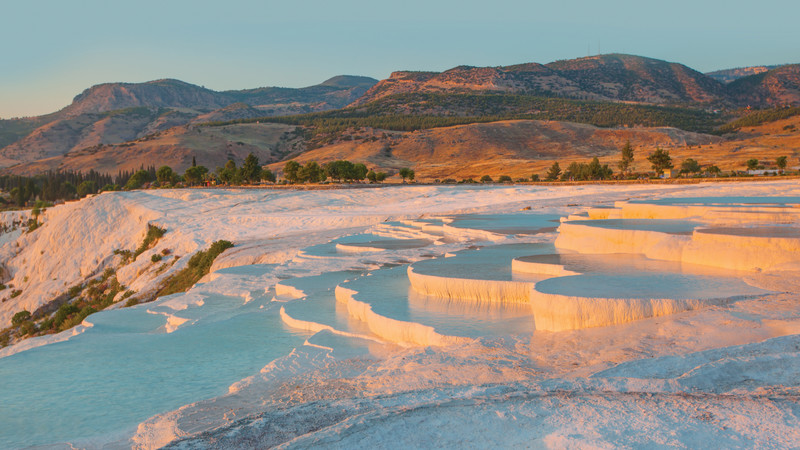
I still remember the first time I saw a photo of Pamukkale, Turkey’s famous white “cotton castle.”
It was late 2014 and a friend of mine suggested we meet in Turkey . I’m based in the US and she lived in China at the time, so it was the perfect halfway point. I was already familiar with both Cappadocia and Istanbul, but what really caught my eye while researching Turkey was a photo of Pamukkale: a collection of bright blue pools of water amongst a pristine, all-white landscape.
Much to my dismay, I wasn’t able to visit Pamukkale on that trip. Little did I know, I’d be back in Turkey again a few years later, this time on the Turkey Encompassed tour with Intrepid Travel. It was on this trip that I realized my wish of visiting the spectacular cotton castle.
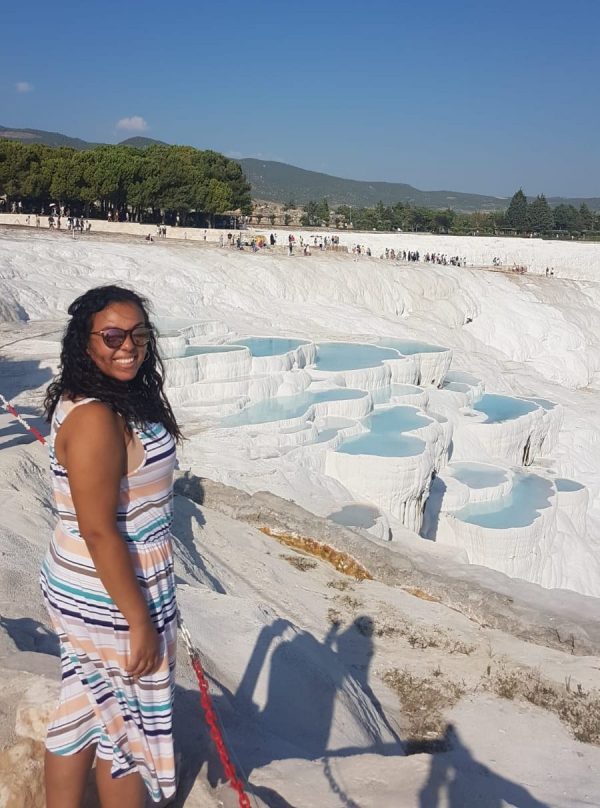
I admit I’ve occasionally visited world famous sites that were a tad… underwhelming. It’s not necessarily due to the site so much as to how I’ve built the experience up in my head. Sometimes after seeing hundreds of photos and videos of a destination, I unintentionally create these unrealistic expectations of what it will look like. Of course, I’m inevitably disappointed.
I was worried that Pamukkale would be a victim of the images online. Thankfully, that wasn’t the case. Pamukkale in real life was everything I imagined and more. I completely understand why it’s Turkey’s most popular attraction.
READ MORE: 6 AMAZING DESTINATIONS IN TURKEY (THAT AREN’T ISTANBUL OR CAPPADOCIA!)
What is Pamukkale exactly?
Over thousands of years, calcite-filled waters have created the UNESCO World Heritage Site Pamukkale, part of the larger ancient city of Hierapolis. Pamukkale, which translates to “cotton castle,” comprises of natural mineral basins formed amongst bright calcium bicarbonate deposits, resulting in an unreal landscape. The petrified white deposits stand out in contrast to the natural bright blue pools formed in layers, almost as if on purpose. It will truly take your breath away.
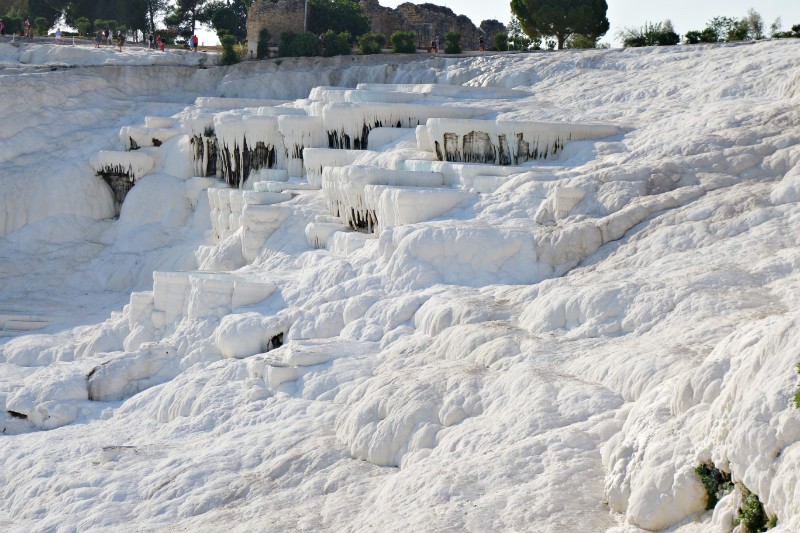
It will be crowded
Before visiting, I had no idea that Pamukkale is Turkey’s most popular attraction. I did the Turkey Encompassed tour in the middle of July, so I half expected Pamukkale to be empty, especially considering we went in the middle of the day. I was astonished to encounter hundreds of people in the pool area. July is definitely a popular month to visit, despite the summer heat.
That being said, the crowds are all inside the pools themselves. If you’re looking for a good photo op, walk around the side, where you’ll find plenty of empty spots to enjoy the views of the pools as well as the surrounding landscape.
READ MORE: WHAT IT’S REALLY LIKE VISITING TURKEY SOLO ON A GROUP TOUR
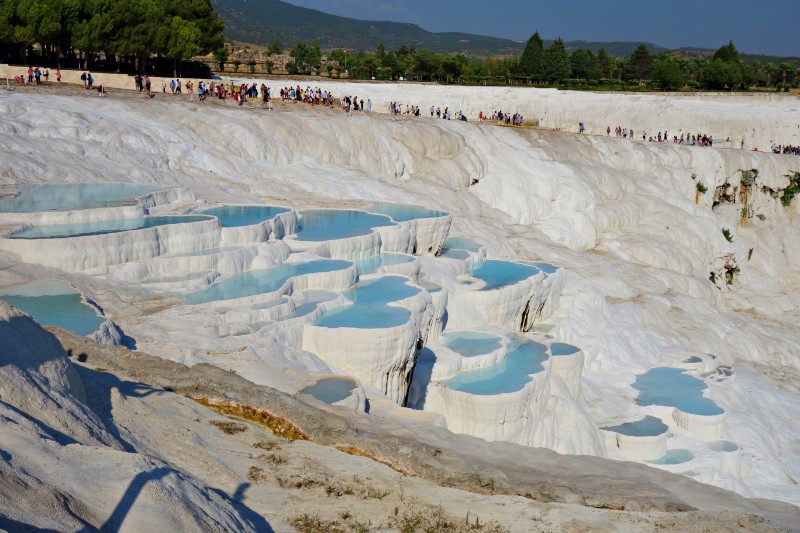
Busy but beautiful
To avoid the crowds almost entirely, plan to arrive to Pamukkale as soon the site opens. Better yet, visit during the winter. You may encounter a snow-dusted version of the pools instead.
You should pack lightly (and bring your bathing suit)
There’s no place to store your belongings at the pools, so you’ll have to carry whatever you bring with you. Leave the fancy camera at the hotel and bring just the essentials in a waterproof day bag. Sunglasses, sunscreen, water and flip-flops are a must! If you’re interested in taking a dip in one of the pools, you’ll want to bring your swimsuit and a change of clothes along as well.
VISIT BEAUTIFUL PAMUKKALE ON A SMALL GROUP ADVENTURE WITH INTREPID TRAVEL
You can’t wear shoes at the pools
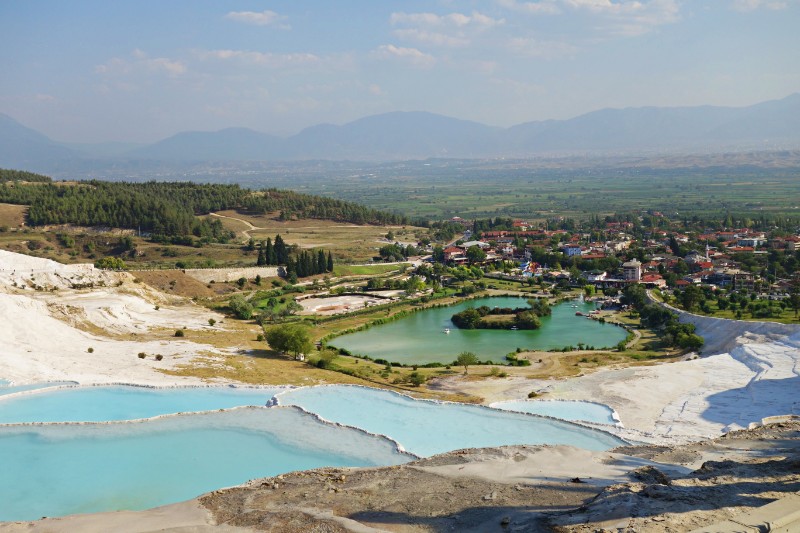
Plus, I had my camera and phone with me, since I really wanted to get good photos. Word to the wise: take your time walking up the cliffside and tread carefully. Thankfully, I managed to make it in and out without falling.
SUBSCRIBE TO INTREPID’S NEWSLETTER FOR DEALS, GIVEAWAYS, TRAVEL TIPS AND STORIES
The water has healing powers…
…at least, that’s what the locals say. The minerals in the pools, formed by underground hot water sources, are said to help with all sorts of ailments, especially digestive and circulation problems. Be sure to don your swimsuit and dip your entire body in to take full advantage of this! At the very least, your skin will feel like you just came back from a luxury spa.
The surrounding ruins aren’t to be missed
Did you know that Pamukkale is adjacent to the ancient city of Hierapolis? I didn’t either, but thankfully our Intrepid guide, Fatih , gave us the inside scoop on Hierapolis and the must-visit areas.
READ MORE: 4 MUST-VISIT DESTINATIONS IN TURKEY, ACCORDING TO LOCAL LEADER FATIH
Hierapolis was once a large city, but now boasts plenty of well-preserved ruins, many of which are virtually empty. I wasn’t kidding when I said all the crowds are at the pools.
The recently restored amphitheater is easily one of the most impressive I’ve seen – ever. It stands alongside an extensive necropolis. Nearby, there’s also an archaeological museum for those that are particularly interested in the history of the area.
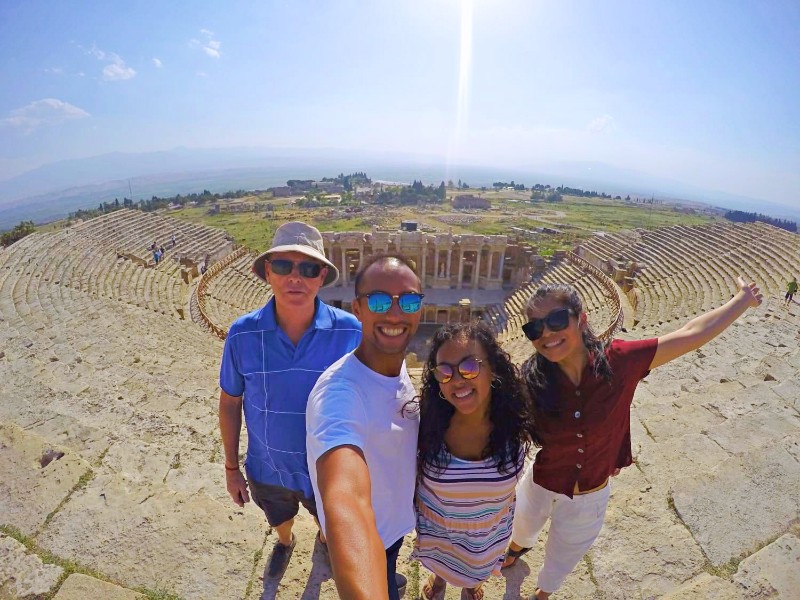
Hierapolis, with some of my Intrepid group!
Don’t spend all your time in the pools. The ruins of Hierapolis are included in the entry fee and are truly not to be missed!
I’m so thankful that despite the numerous photos I’ve seen online, Pamukkale turned out to be even more spectacular than I expected.
It was precisely my visit to Pamukkale this past summer that reminded me that there are plenty of unmissable and magical places out there in the world. I’m fortunate to be able to continue exploring them.
Ready to explore this stunning site? Check out Intrepid’s range of small group adventures in Turkey.
(All images courtesy of Sally or Intrepid Travel and taken on Intrepid’s Turkey Encompassed trip.)
Feeling inspired?

Sally Elbassir
Born in Ireland, but raised in Los Angeles to Arab parents, Sally from Passport & Plates has been a traveler from the start. In 2015, she left her advertising job to chase her dream of eating the best street food, learning about different cultures and challenging misconceptions about Islamophobia. She's a firm believer that local food and travel experiences are the best form of education and shares her adventures and tips on passportandplates.com.
You might also like
Top us national parks, 7 incredible hikes in denali national park, unique getaways for your next girls’ trip, how to visit europe in the off-season, best places to travel in march, best places to travel in may, best places to travel in february, best places to travel in april, best places to travel in june, inca trail trek permits: how to secure the..., best places to travel in july.

The Complete Pamukkale Guide: What It’s Really Like
Pamukkale, literally meaning cotton castle in Turkish, is UNESCO World Heritage listed and one of Turkey’s most visited tourist attractions. The area is famous for its calcium carbonate rich waters from its thermal springs and the ruins of the ancient city of Hierapolis.
These waters have created an otherworldly landscape of travertine pools down a hillside that look velvety in texture. Grab yourself a tea, paddle your feet in the warm water and admire the phenomenal views. Find everything you might need to know to prepare for your trip in this complete Pamukkale guide.

Pamukkale has been made eternally famous by the gleaming white calcite travertines (terraces) overrunning with warm, mineral-rich waters on the mountain above the village – the so-called ‘Cotton Castle' (pamuk means 'cotton' in Turkish). Just above the travertines lies Hierapolis, once a Roman and Byzantine spa city, which has considerable ruins and a museum.
Attractions
Must-see attractions.

This ancient spa city's location atop Pamukkale's tourist-magnet travertines is quite spectacular. Founded as a curative centre around 190 BC by Eumenes…

Travertines
The World Heritage–listed saucer-shaped travertines (or terraces) of Pamukkale wind sideways down the powder-white mountain above the village, providing a…

Roman Theatre
The Roman theatre is the highlight of Hierapolis, dramatically sitting uphill from the site and overlooking the ruins and mountains beyond. The stage area…

Martyrium of St Philip the Apostle
The extraordinary octagonal Martyrium of St Philip the Apostle at Hierapolis is built on the site where it's believed that St Philip was martyred. The…

Hierapolis Archaeology Museum
Housed in former Roman baths, this excellent museum exhibits spectacular sarcophagi from nearby archaeological site Laodicea and elsewhere; small finds…

Temple of Apollo
The foundations of the Temple of Apollo at Hierapolis remain today. Once the heart of the city, this was where people came to consult the temple's oracle…

The necropolis (cemetery) at Hierapolis rambles across the hills and is one of the most fascinating parts of the ancient city ruins. The path through the…

Hellenistic Theatre
Hack across the Hierapolis hillside, in a westerly direction from the Martyrium of St Philip the Apostle, and eventually you'll come to a completely…
Plan with a local
Experience the real Turkey
Let a local expert craft your dream trip.
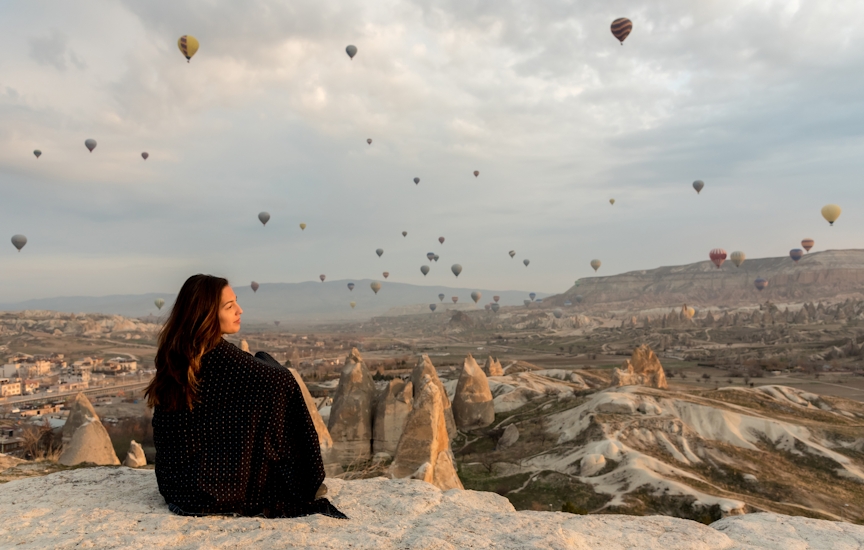
in partnership with getyourguide
Book popular activities in Pamukkale

Pamukkale Travel Guide – Planning Your Visit to Pamukkale, Turkey
Visiting Pamukkale was one of the places I was most exciting about going to when planning my trip to Turkey. If you’re looking for a spectacular natural wonder and something a bit unusual to see whilst on your trip to Turkey, then this Pamukkale Travel Guide is for you.
Did you know that despite not being that well known outside of Turkey, Pamukkale receives more than 2 million visitors a year? That’s more than any other tourist site in the country.
It had been high on my bucket list, so having recently spent two weeks travelling through Turkey, I made sure to spend 2 days at Pamukkale.
In this Pamukkale Travel Guide, I cover how to get there, where to stay and getting around. I also listall of my top tips for visiting Pamukkale without the crowds. So read on and starting planning your trip to Pamukkale.
Pamukkale Travel Guide – Essential things to know

What is Pamukkale?
Pamukkale, meaning “cotton castle” in Turkish, literally looks like.. well, a cotton castle. Formed by a carbonate mineral left by the flowing water, Pamukkale is a series of white travertine terraced pools nestled into the hillside. People don’t seem to be completely certain as to how Pamukkale was actually created however.
At the top of Pamukkale is the incredible ancient Greco-Roman city of Hierapolis, chosen to sit atop the “cotton castle” with an abundance of hot springs.
Today, Pamukkale is an UNESCO World Heritage site and you can visit both here and Hierapolis for one ticket price.
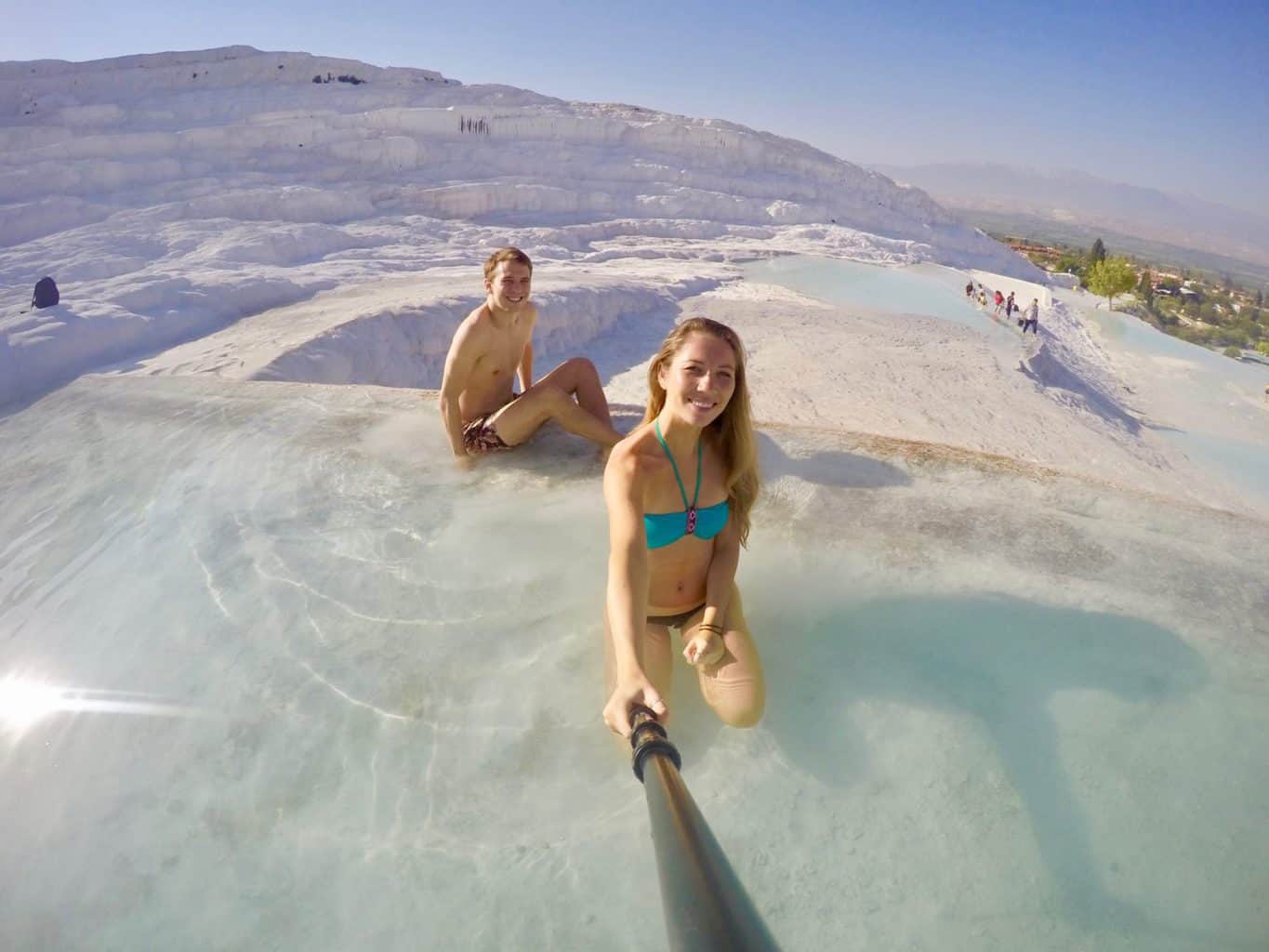
Where is Pamukkale?
Pamukkale is located in South West Turkey, approximately 20km from the major town of Denizli.
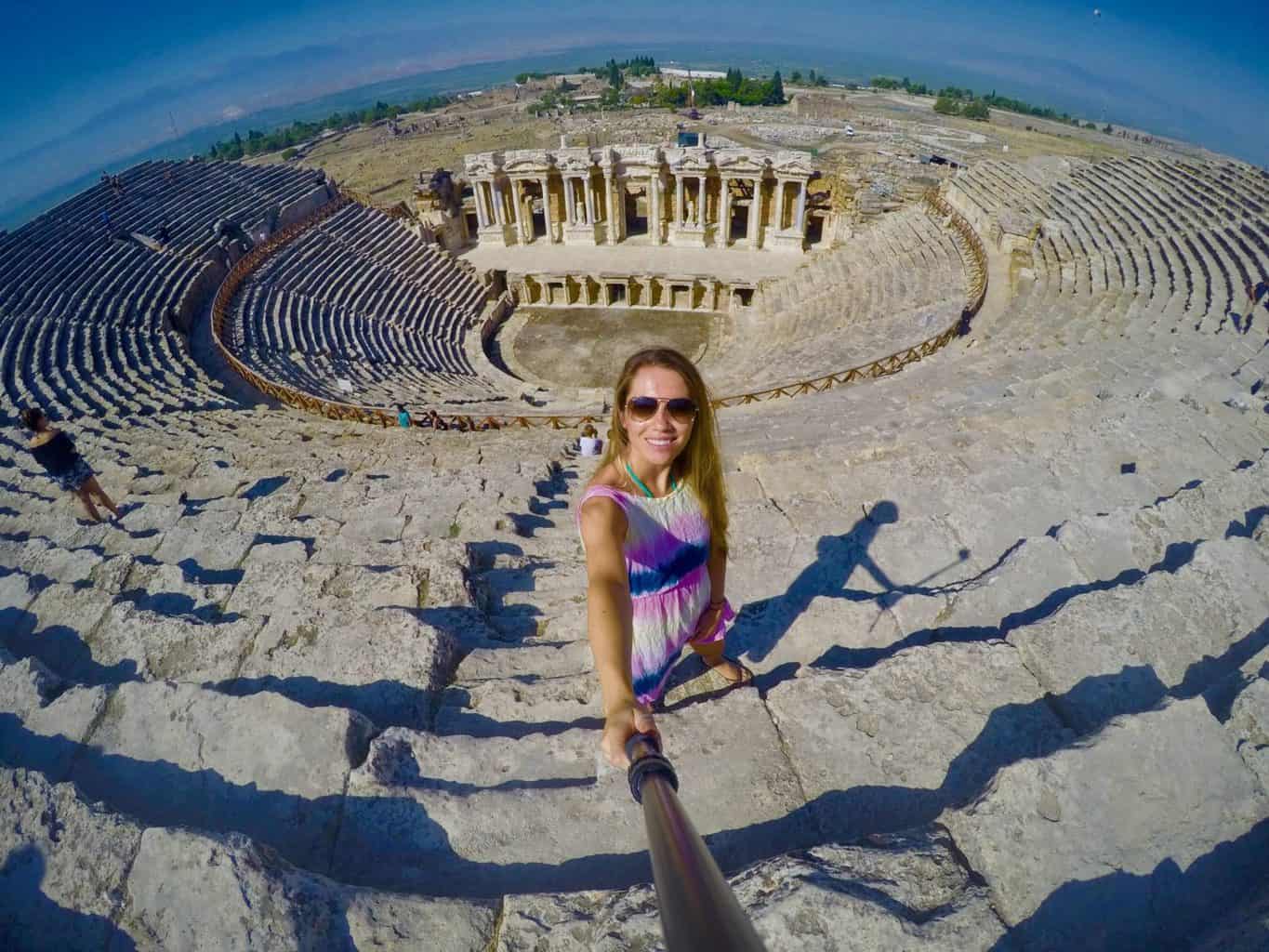
How to get to Pamukkale?
The main point of arrival is Denizli, which has connections from across Turkey via bus, train and plane. If you arrive by bus or train, you will need to head to the lower level of the Denizli bus station (the two are across the road from each other), and look for the dolmuş shuttle at peron (gate) 76. It’s only about another 30 minute drive to Pamukkale from Denizli and costs 3.50 TL. You must tell the driver and he will stop near your hotel in town as there is no bus stop in the town of Pamukkale.
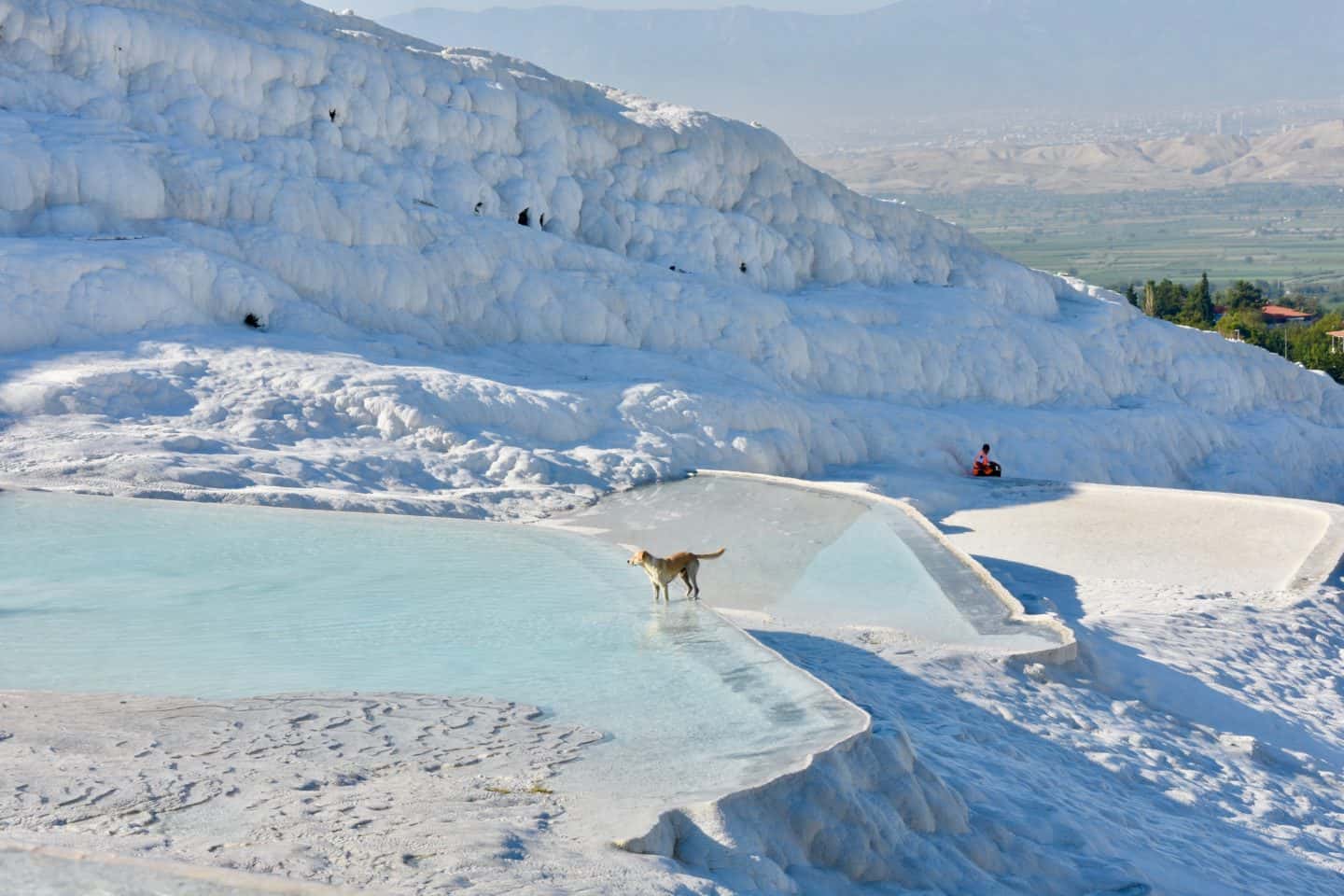
How to get around Pamukkale
Luckily, Pamukkale is a really small town and you can easily get around on foot.
Entrance fee to Pamukkale
A ticket costs 25TL which gives you entry to both Hierapolis and Pamukkale. These tickets permit you to stay all day. It’s important to know that to swim in the Cleopatra Pools at Hierapolis, it costs an extra 32TL.
If you have a monthly Turkish Museum Pass, then Pamukkale is included and you can even skip the queue!
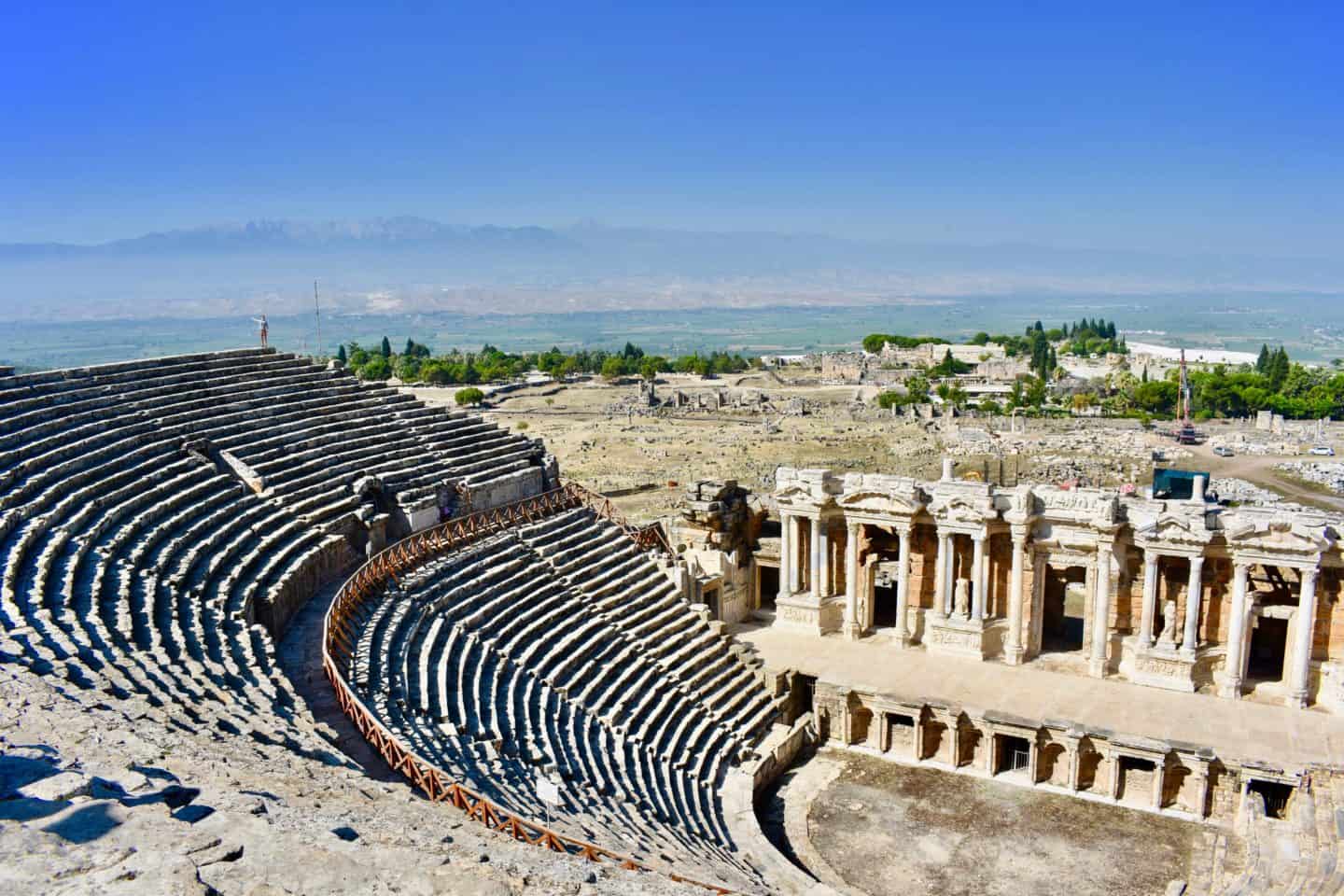
Pamukkale opening times
In the summer season (April to October), Pamukkale opens at 6am and closes at midnight. In the winter season, it opens at 6am and closes at 6.30pm.
When is the best time of year to visit Pamukkale?
Generally, the better time to visit would be the summer months so you can immerse yourself in the pools and explore in your swimwear. The best time to visit in the summer would be April to June when the heat is less intense, and the crowds are calmer.
Visiting Pamukkale on a day trip
How long does it take to visit pamukkale.
You can easily spend a full day at Pamukkale and Hierapolis. You’ll probably find that you won’t spend more than an hour exploring the terraces at Pamukkale, just because there’s only a certain number and as it gets busier, it does get more unbearable. You can easily spend a fair few hours walking around Hierapolis and, if you pay the extra cost, enjoying the hot springs (Cleopatra pools) at the top.
As mentioned, it is very common to visit as a day trip. I’ve popped loads of great suggestions below:
- Pamukkale Small Group Tour from Kusadasi & Selcuk
- Antalya: Full-Day Pamukkale and Hierapolis Tour & Lunch
- Pamukkale and Hierapolis Full-Day Guided Tour
- Private Pamukkale (Hierapolis) Tour: Full-Day from Izmir
- Pamukkale & Hierapolis Tour from Marmaris
- Ephesus and Pamukkale: Day Trip by Plane from Istanbul
Staying overnight in Pamukkale
Where are the best places to stay in pamukkale.
There are many hotels in Pamukkale, none of which are super exciting or fantastic really. The town seems to exist purely because of tourism and this means there’s little character to the streets. It’s a bit of a quiet and slightly run-down town.
I chose to stay at the Melrose House Hotel which was a perfect base with plenty of kittens and a lovely swimming pool. You can check rates for this great hotel here . I would say this was a great mid-range option.
There aren’t too many luxury hotel options in Pamukkale, but the best hotels are these two:
- Doğa Thermal Health & Spa
- Richmond Pamukkale Thermal
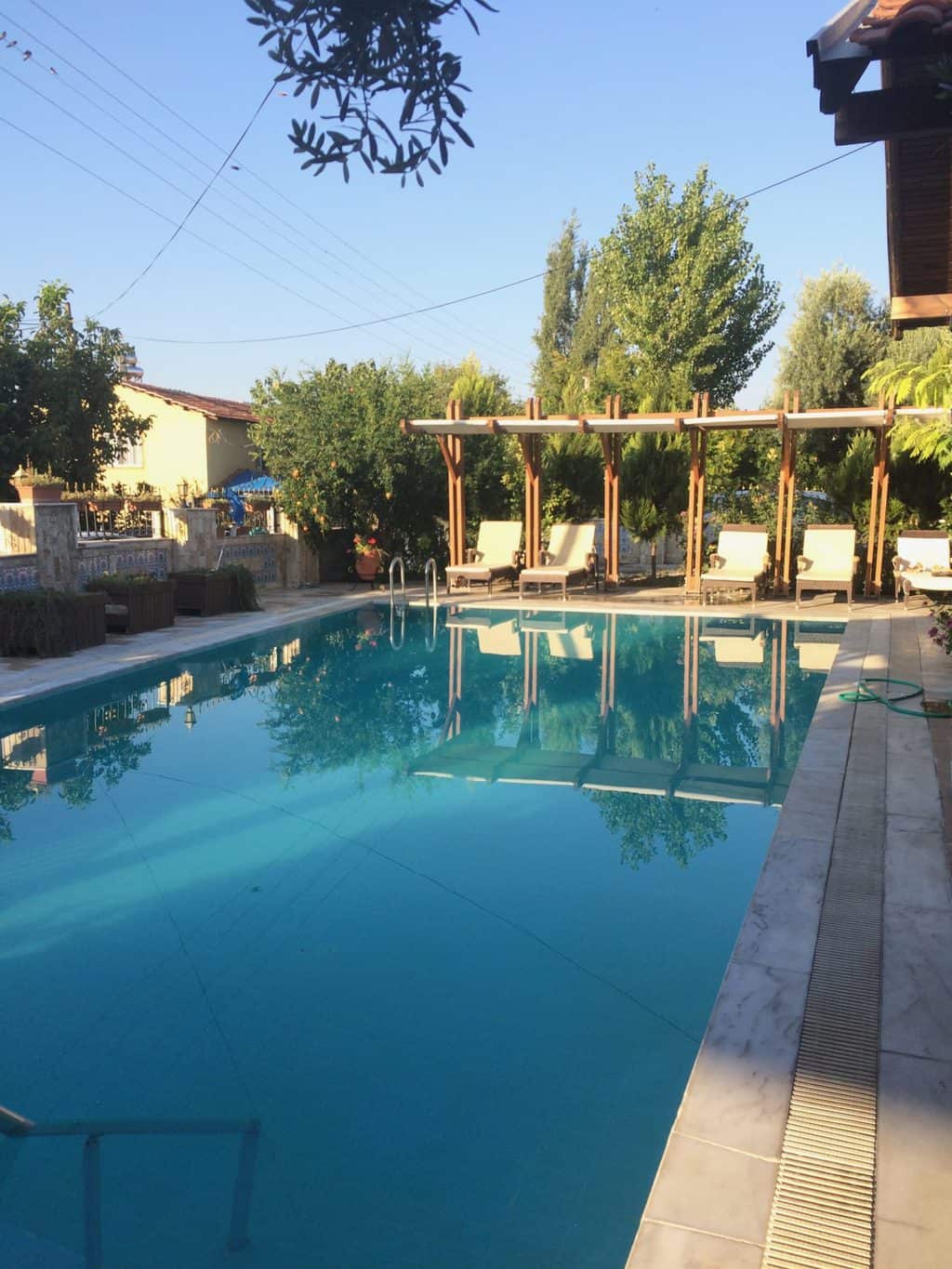
Top tips for a day or overnight visit to Pamukkale
Arrive early.
It’s fairly useful advice for any tourist attraction but it is vital to arrive early when visiting Pamukkale. If you’re staying overnight in the town, obviously this will be easier but you could also take the first dolmuş of the day from Denizli.
Mass tour groups from the seaside resorts start descending in the pools by about 9.30/10am. They arrive in their masses and I found it to completely change the experience.
Although the doors opened earlier, I arrived at about 8.30am. I had no queue at the gate and was one of the first people there. I enjoyed about 40 mins having the pools to myself and a handful of others.
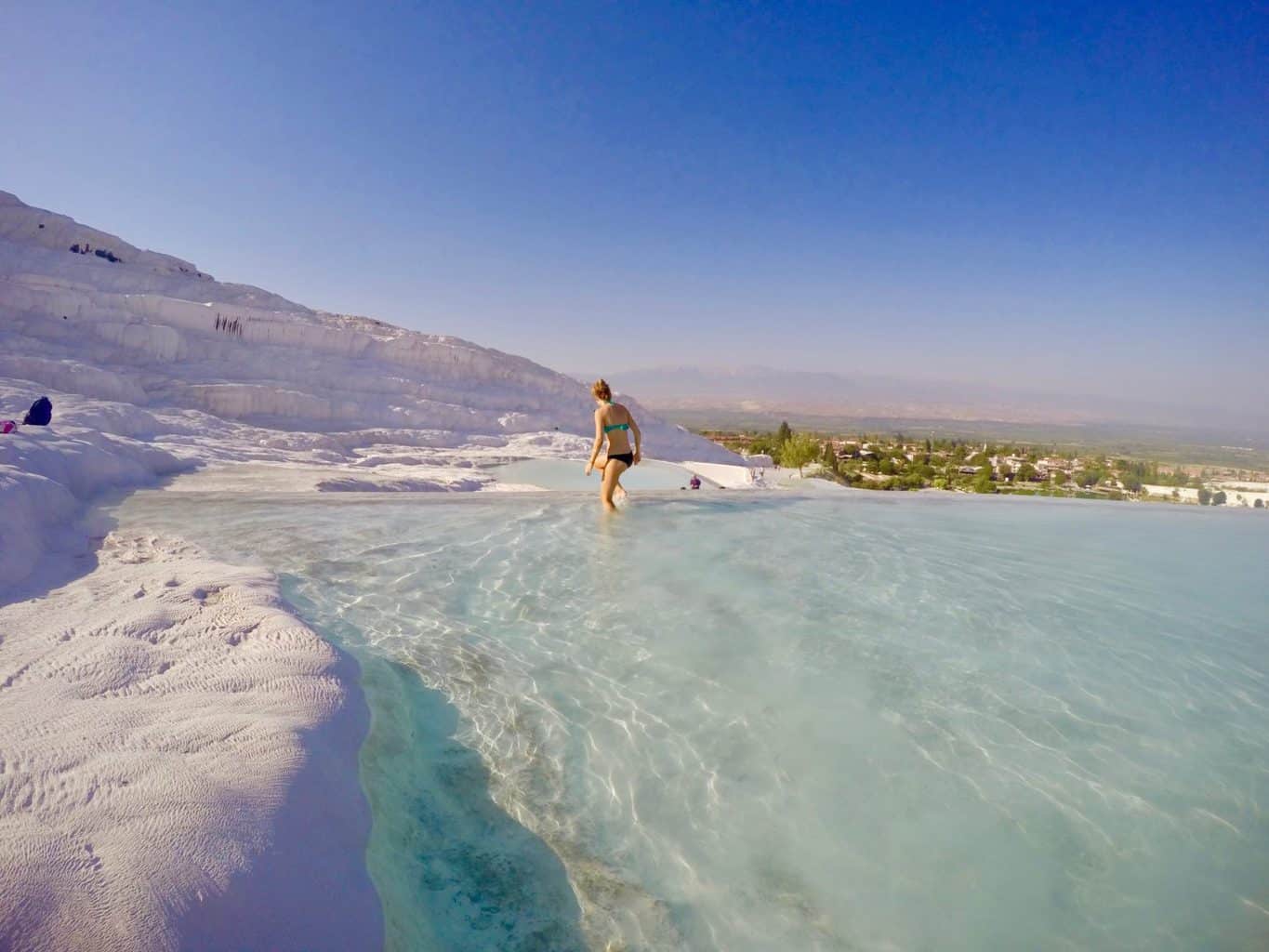
Enter through the lower gate
Try to arrive at the ticket gate nearest to the town and the Gendarma (police station).
It’s pedestrian only and means you come in right by the pools at Pamukkale. It extends your time without crowds significantly as the tour buses arrive at the top by the upper gate. They slowly come down the path by the pools from the top but stop to take so many photos on the way down that it bides you some time at the lower pools for sure.
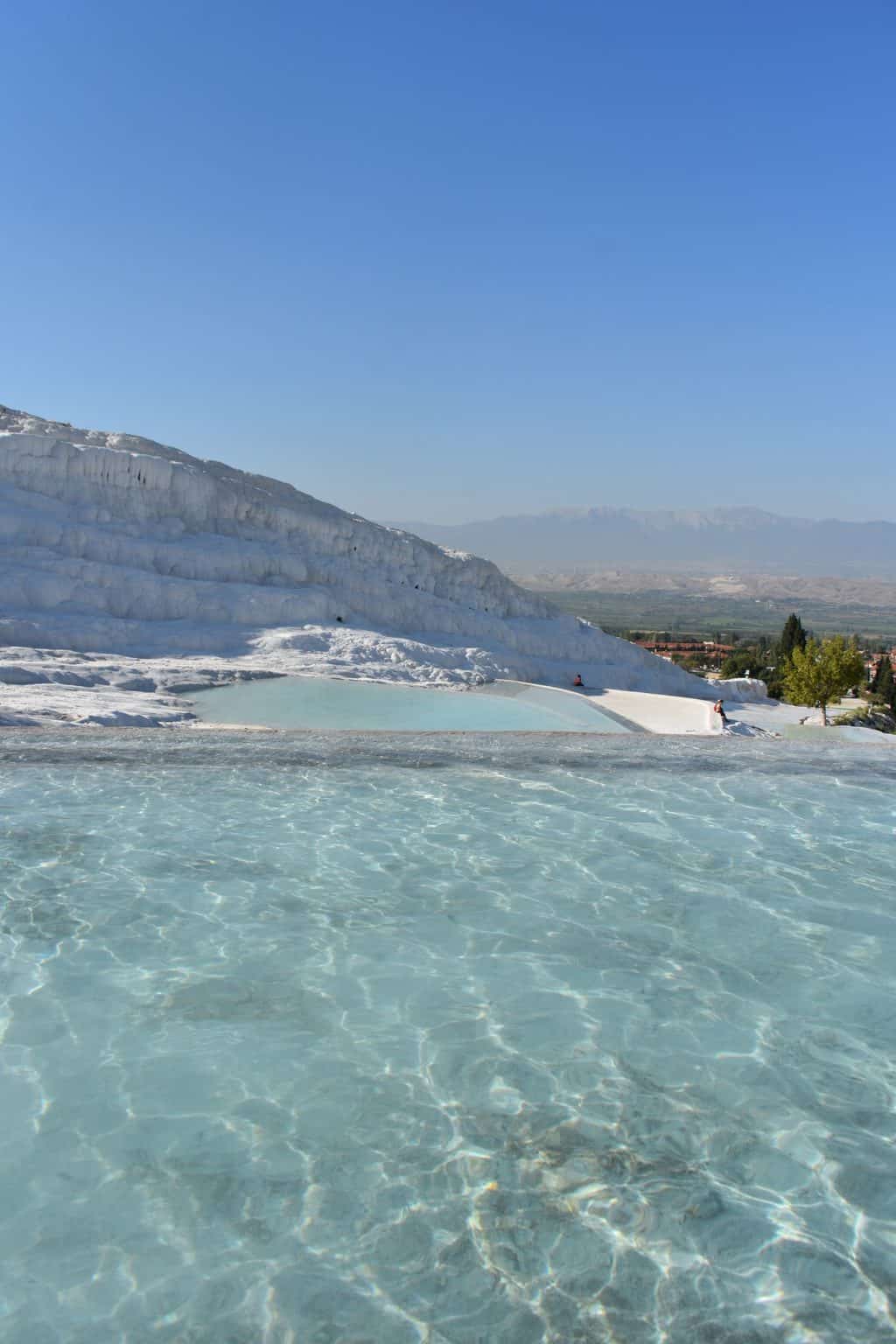
Bring a waterproof bag and wear swimwear
I was surprised to find that much of the white chalky surface was wet. There are few places to put bags and belongings down where they will stay dry.
You will also definitely find yourself in your swimwear all day long. We noticed that many people even seemed to stay in their swimwear whilst walking round the Hierapolis ruins which really seems quite odd.
You will definitely be barefoot inside, so make sure you have a bag to put your shoes in so you hands can be free.
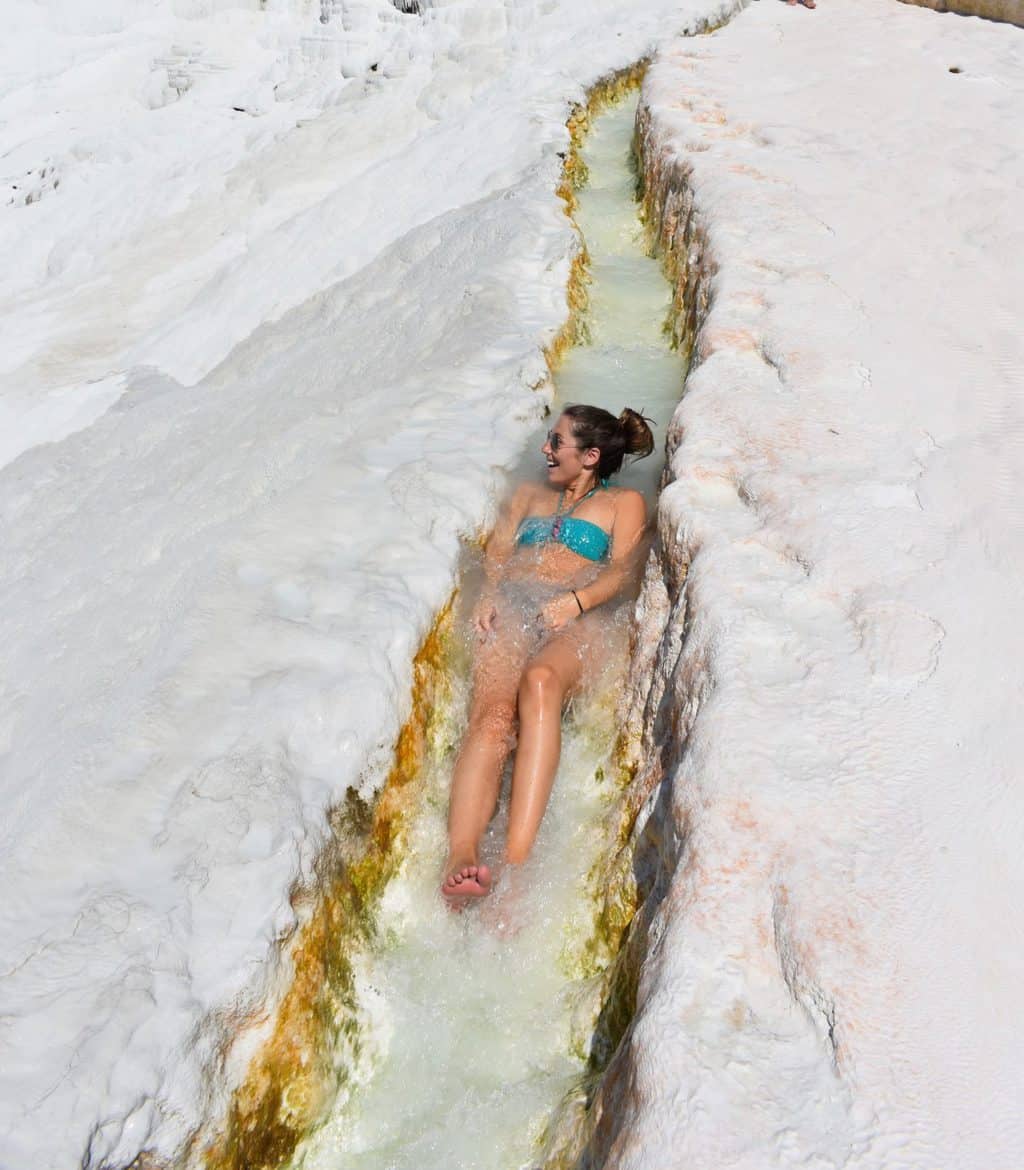
Don’t skip Hierapolis
Some people come purely for the pools and don’t even visit the ruins at the top. I thought they were absolutely incredible. As you can see too, the views with the mountains behind are amazing!
Just by the ruins complex of Hierapolis, you can enjoy a lazy swim in the hot springs (the Cleopatra Pools). Here there are sun loungers and a cafe, so as I said before, you can easily spend the full day here.
The Romans once bathed in these pools, and it is quite the surreal experience to swim amongst submerged columns.
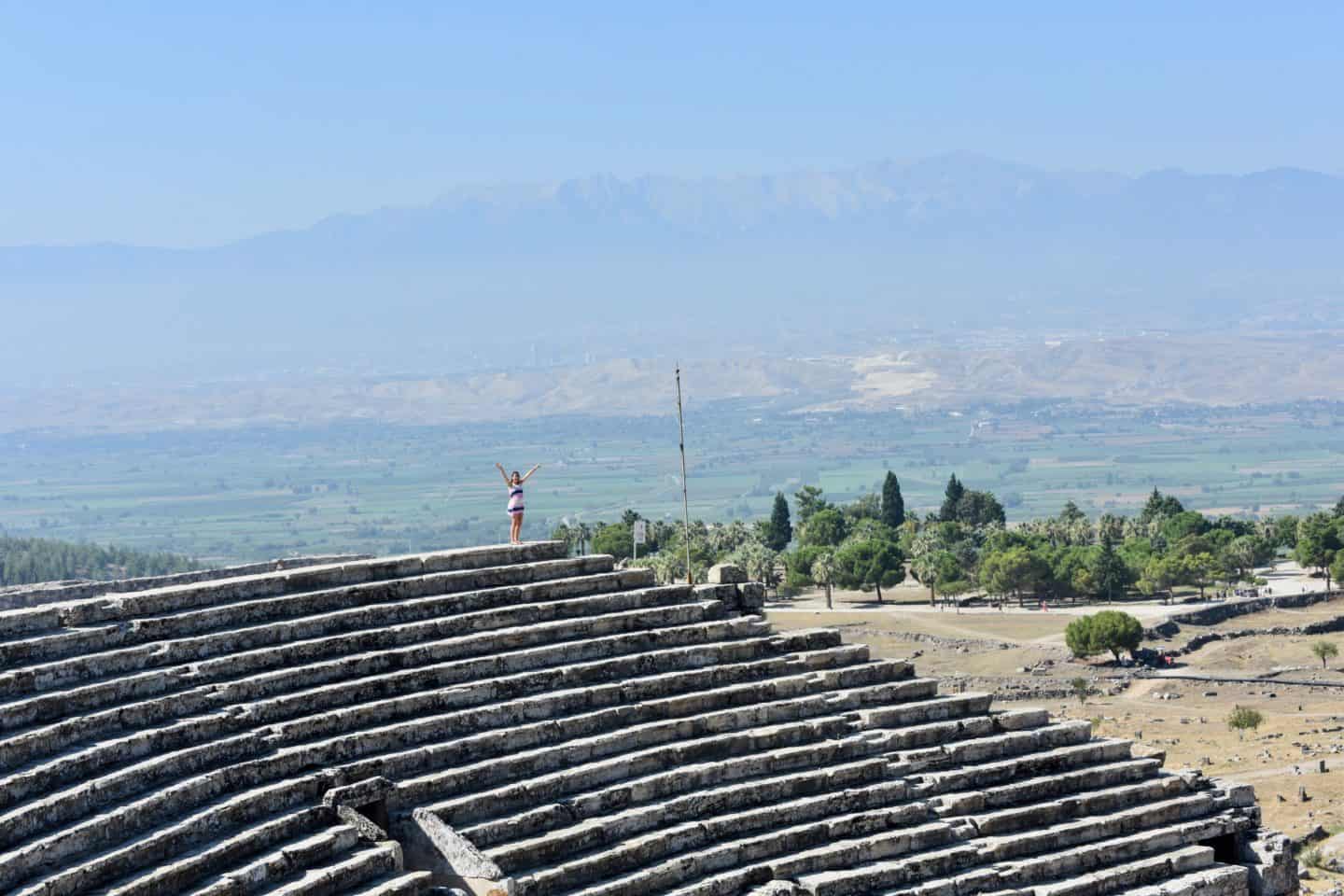
Take a picnic
Assuming you do choose to spend the day at Pamukkale and Hierapolis, it would be a good idea to bring a picnic.
The only food options are the poor quality cafes by the Cleopatra pools. Interestingly though, there are ATMs up by the cafe.
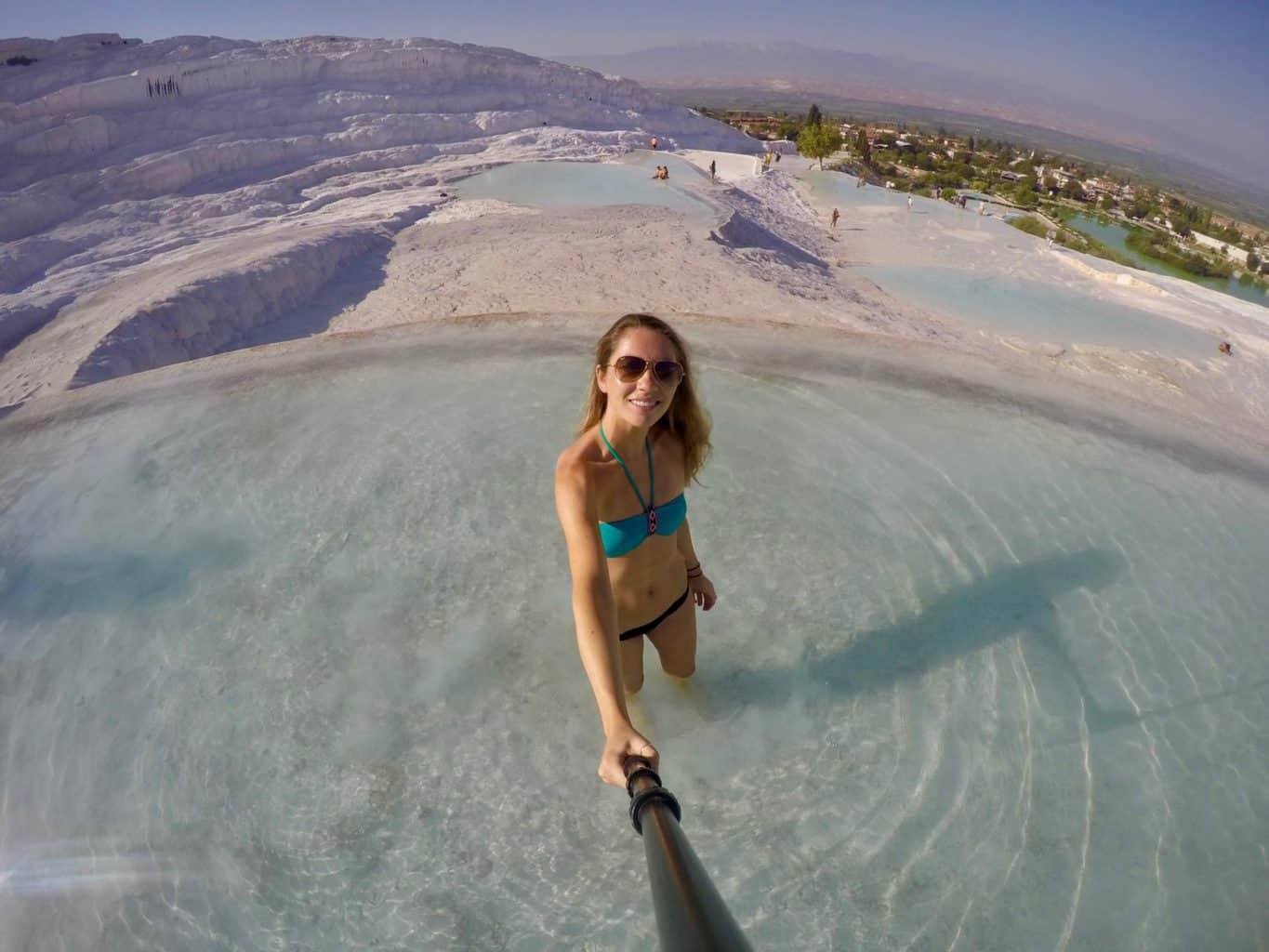
Pamukkale Travel Guide
So here is my guide and top tips for visiting Pamukkale and Hierapolis.
Have you been to Pamukkale and Hierapolis? Do you have any other tips for visitors to this amazing place? I’d love to hear if so – drop a comment below!
As you can see, whether you visit as a day tripper or stay overnight in the town of Pamukkale, arriving earlier to the lower gate will offer you a much more successful and enjoyable visit. The two sites are absolutely worth a visit on any trip to Turkey and I would highly recommend including them.
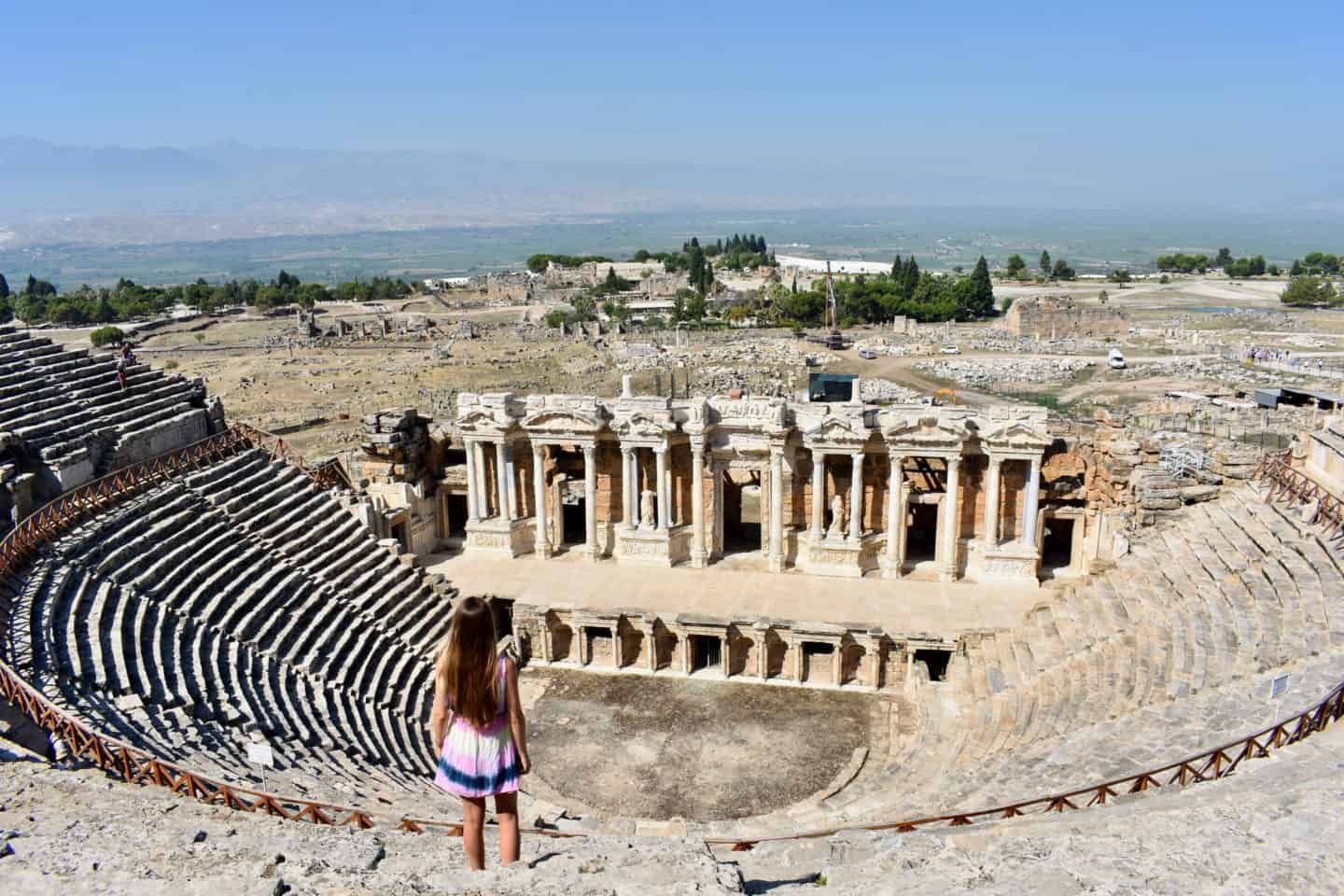
If you’re considering a longer trip, you might find my two-week Turkey itinerary here useful, as well as my guides to Bodrum , Pamukkale , Ephesus , sailing the famous Turquoise Coast , Istanbul and Cappadocia here.
If you’ve enjoyed this post, feel free to share using the below links!
Wanna see more? Check my Instagram here , my Facebook here or my Twitter here !
Disclaimer: This visit to Pamukkale, Turkey was entirely paid for by myself and there was no involvement from the tourism board or any local companies. This is an independent guide.
Enjoyed my Pamukkale Travel Guide? Pin it!
You may also enjoy:
The ultimate guide to benicassim festival 2024 …, best places to visit in andalusia, …, greek island hopping ten day itinerary: …, iceland car rental tips, 24 comments.
Wow! This is so cool. I hope to be able to visit one day.
Also loved reading this post on Turkey and I have to admit, its going on my list of things to do there. It looks so beautiful and I am now curious about the place. Fantastic write up and again, loving the photos 🙂
Pamukkale is definitely a great place to visit. The cotton castle looks unique and beautiful. Will definitely visit this place next time in Turkey. The pictures are amazing. Thanks for sharing.
Cotton castle is just THE dreamiest name ever. The place doesn’t even look real! Definitely some great tips you’ve provided and I’m for sure adding this to my bucket list. Thank you for introducing me to this beautiful place!
Wow! I’ve never heard of this destination before. It looks like such an amazing place to visit ❤
The place is indeed dreamy. I has stolen my heart away several years back when I visited it. Thanks for reminder, it brought my memories back!
I would love to visit PAMUKKALE. I have never heard of it before but all your pictures look amazing. This is definitely on my list.
Hi Sue, it’s a little under the radar and a very special spot!
It seems that really had a fun and great time there. That place is a must visit. Such a beautiful place and scenery. Your photos make me wanted to visit that.
Definitely visit when you can! 🙂 X
I can’t believe there’s a place like this, I’ve never seen something so fictional and real at the same time. Thank you for sharing this place, you have beautiful pictures and I hope I can visit Pamukkale soon!
I hope you can too, it was amazing! 🙂
Pamukkale looks like something you see in a movie. I can’t believe it’s real. What an absolutely stunning place with amazing views!
I know, and it was so surreal to explore too! 🙂
OMG!! This place is dreamy. How did you find that beautiful place? It seems that you really enjoy every minute of your time there. I am so jealous.
I think I found it on Google but I also had never heard of it before! So glad I did though 🙂
Seriously, some of your photos looked like you were literally in heaven! That ampitheater was equally amazing! Needless to say, I’m sure you had an amazing time with these breathtaking views!Happy International Women’s Day!
I know, such a heavenly destination! I had no idea what to expect really but it blew me away!
I’m always up for an adventure and that place looks so great. Wish my family and I could go there soon!
This is an amazing place for an adventure! 🙂
I love how you have that selfie-stick taking those gorgeous shots! The constant photos make me look forward to more photos! It definitely makes me want to visit that place~
Haha, thanks Tiffany 🙂
Isn’t it insane that I’ve never heard of either of these places??? There’s so much out there!
Ich liebe es, wie du diesen Selfie-Stick hast, der diese wunderschönen Aufnahmen macht! Die ständigen Fotos lassen mich auf weitere Fotos gespannt sein! Es bringt mich definitiv dazu, diesen Ort zu besuchen ~
Leave a Reply Cancel reply
Your email address will not be published. Required fields are marked *
Let’s connect
Best Travel Agencies
Search turkeytravelplanner.com, what cities.
- Aegean Coastal Cities
- Mediterranean Coastal Cities
Pamukkale, Turkey – Ultimate Travel Guide
Last Updated on February 4, 2024
Pamukkale Overview & Guide
Pamukkale, directly translated as “cotton castle,” alongside Hierapolis , its ancient city, was rightfully christened together as a UNESCO World Heritage Site in 1988. From the captivating natural phenomena to the ancient cities surrounding this district, you will surely find yourself mesmerized during your stay in the Pamukkale region. Whether you imagine life as a 2nd-century citizen in Laodicea , floating above white thermal pools illuminated pink by the sunrise with hot air balloon rides, visiting the ancient Greek city Hierapolis, or enjoying a swim in Cleopatra's mineral-filled hot springs and thermal pool, exploring the ancient ruins of Pamukkale is sure to lure you in with its many attractions.
Pamukkale's cascading calcium-laden waters and travertine pools rightfully draw many to visit this city. However, there is much to explore in this city, in addition to its famous Pamukkale thermal pools and hot springs.
Pamukkale's Entrances
Three of Pamukkale's most famous attractions are actually connected to one another, making them accessible with a single entrance fee. These sites include the ancient city of Hierapolis , the famous white travertines or thermal pools, and Cleopatra's Pool, also known as the Antique Pool . There are three separate entrances to access these sites. The entrances open at 6:30 a.m. and come to a soft close at 8:00 p.m.
The most convenient of the three entrances is “ güney kapısı ” or south gate . Located just up the road from Pamukkale's town, tour buses and public transport from Denizli enter from the south gate. This gate is also accessible by car or taxi. It is the most heavily trafficked of the entrances and is closest to all of the major attractions. There is also a gift shop and cafe at this entrance, which you can access without paying the entrance fee. Taxiing to this entrance from the town of Pamukkale is affordable and easy.
Alternatively, the Pamukkale town entrance is accessible by foot and easily within walking distance from any hotel in the town of Pamukkale. This entrance is a bit of a walk from the main attractions, but the walk is scenic and well worth it.
If you are staying in Karahayıt , the nearest entrance is the north entrance . It is accessible by car or taxi. From this entrance, you will have to walk about 1 km through the ancient city of Hierapolis in order to reach the most popular attractions, including Cleopatra's pools and the travertines.
There are many amazing sites to visit and enjoy in Pamukkale. For instance, Pamukkale provides a stunning backdrop to the ancient Greco-Roman city of Hierapolis. You can explore thermal springs, go on hot-air balloon rides, take a dip in Cleopatra's Pool, and marvel at the white travertine terraces brimming with thermal waters rich in carbonate minerals. When visiting Pamukkale, remember to pack your bathing suit and water shoes (although you can walk barefoot in the pools as well.)
Thermal Pools (Travertines)
One of the most famous attractions in Pamukkale is the travertines or thermal pools. These famous cascading mineral-filled pools are truly a sight to see. Some of the pools are under restoration, so they are roped off. However, the biggest pools are open for visitors to wade through and explore. These pools are an excellent place to take photos or to simply look at the vast landscape surrounding the area.
Cleopatra's Antique Pool
The natural site of Cleopatra's Pool , also known as the Antique Pool, is a unique and alluring experience. Located just beside Pamukkale's thermal pools, it is here that tourists swim through the remains of an ancient temple to Apollo. The mineral waters are constantly refreshed by an inflow of hot calcium-laden mineral water. There is an additional entrance fee to swim in this pool, but it is well worth it.
Hot Air Balloon Rides
If you are looking to take an excursion during your time in Pamukkale, look no further than a hot air balloon ride . Floating in a balloon over Pamukkale's white mineral waters feels like a fairytale. Balloons embark on their journey each morning during the sunrise, which allows for a bird's-eye view of the white cliffs and ancient city, illuminated with a blush color by the sunrise. Excursion Mania is an excellent company to book your tour with. Having been in the business for 10+ years, safety is second nature to Excursion Mania's staff. You will be welcomed with incredible hospitality and will celebrate with champagne after the unforgettable experience!
Karahayıt Village
Located about 8 kilometers up the road from Pamukkale village, Karahayıt is a hidden gem worth exploring for those who want to know more about Turkish life and culture. Those who are interested in a break from highly trafficked sites or are budget-conscious will not regret finding their way to the inviting and winding streets of Karahayıt. Upon entering the town, you may be tempted to stay on the outskirts. Be sure to continue walking inland. You will discover many shops with local products and local businesses. Şahin Izgara Çorba ve Sulu Yemek is an excellent restaurant nestled in these streets. Their most famous dish, Saç Kavurma , is delicious and affordable. If you are looking for a more economical stay, there are many small hotels nestled in this town as well. The outskirts of Karahayıt hold many highly-ranked thermal hotels.
Hierapolis Ancient City
The main tourist park of Pamukkale is set within the larger ancient city of Hierapolis . The extensive ruins can be quite an adventure to explore, and they feature a unique Gate to the Underworld Temple (Plutonium)! The old city was likely founded in the 3rd century BC by the Seleucid Empire but also features prominent Roman and Byzantine-era structures as well. It is also known as the site where the Apostle Philip was supposedly martyred and buried. Notable archaeological structures include one of the largest surviving necropoles in Turkey, two Roman baths, colonnaded streets, Byzantine gatehouses, a massive theater , the Martyrium of Philip, as well as an archeological museum . Hierapolis is also a UNESCO World Heritage Site ! I would recommend exploring the ruins and then changing into your swimsuit for a dip in the Antique Pool to cool off! You may also want to buy a book and explore the ancient city of Laodicea as well.
Laodicea (Laodikeia) Ancient City
Only a fifteen-minute drive away from Pamukkale is the stunning ruins of the ancient city of Laodicea . Excavated by an amazing team of Turkish archaeologists, the massive site includes the largest stadium in Anatolia , two theaters, four baths, five agoras, five fountains (nymphaeums), impressive temples, and a myriad of churches and basilicas. This is barely scratching the surface of the incredible amount of features visible at this site. You can walk along beautifully paved Roman colonnaded streets, explore beautifully restored architecture, and get a feel for what it would have been like to live hundreds of years ago. The site also holds Biblical significance as one of the Seven Churches of Revelation and features a stunning basilica with mosaics.
Colossae Biblical Site
In addition to the two major ancient cities near the Denizli region, the site of Colossae is also rich in historical and biblical history. As it stands today, the site is only an unexcavated mound . You can hike around the area, which would have served as the acropolis, and you can also distinguish the remains of the cavea of a small theater . There is also a necropolis scattered to the north of the town. Colossae is particularly known for being addressed in two of the Apostle Paul 's epistles. Overall, while there is not much to observe at the site, it still marks an important place for the early church and holds mysteries that are just waiting to be uncovered.
Transportation
In order to visit Pamukkale, you must first go through Denizli . Denizli is a large city located only 18 km south of Pamukkale. Fortunately, there are various transportation options available to reach Denizli. You can choose from buses , trains , planes , and rental cars at your convenience. It's accessible as a day trip from Izmir, but you may consider staying longer to explore the area.
After getting to Denizli, there are minibusses to each of Pamukkale's attractions every half hour.
Transport for Denizli & Pamukkale
There are a variety of stays to choose from during your time in Pamukkale.
If you are interested in a high-class experience, the region is full of many thermal hotels , each equipped with its own natural hot spring pools. Most of these are located in Karahayıt, which is about a 10-minute drive from the most famous attractions in Pamukkale. Halici Hotel offers its own private thermal pools, Turkish baths, a massage salon, an all-you-can-eat breakfast buffet, and excellent hospitality.
Wanting a more economical stay? There are also many boutique hotels in both Pamukkale town and Karahayıt . Pamukkale's town is closer to the famous attractions, so if you want to be situated within walking distance from the thermal pools and Hierapolis, be sure to get a hotel in Pamukkale proper. If you don't mind driving or taking a taxi, Karahayıt offers equally satisfying, slightly cheaper stays. The city of Denizli also has a variety of hotels but is around 20 minutes away by car.
Another option during your time in Pamukkale is to camp. Baydil Camping is a plot of land on which you can pitch your tent or park your camper. Nestled in the town of Pamukkale, this is an affordable and fun option during your stay. There are showers and bathrooms included in the camping fee.
Best Hotels in Karahayıt, Turkey
In Pamukkale, you can enjoy delicious Turkish cuisine , including kebabs , doner kebabs , iskender , and more. Additionally, the Denizli and Pamukkale regions are well-known for producing wine , so you can sample the local flavors.
Turkish Cuisine & Wine Tours
Tours & Excursions
Pamukkale is a fantastic destination where you can experience both ancient structures and the natural wonders of the world. Day trips and tours to nearby cities such as Marmaris , Antalya , and Izmir are easily accessible from here. Hot air balloon excursions are among the most popular choices for tourists to fully explore Pamukkale from above and take in the breathtaking views. Taking a hot air balloon ride in the early morning is a great way to get a panoramic aerial view of the unique landscape.
--By Abigail Goosen , contributions from Caleb Bowman
Related Articles
Best 7- to 10-day turkey tours, what to see & do, pamukkale hotels, pamukkale transport, pamukkale to cappadocia, aphrodisias, aegean turkey, visit our facebook group:.
- Maps of Turkey
- Best Guided Tours
- Travel Agents
- Private Tour Guides
- Turkish Money
- What it Costs
- Photo Gallery
- Special Interests
- Trip Consulations
- Travel Details FAQs
Travel Guide to Pamukkale, Turkey [with Sample Itinerary]
Read our Pamukkale travel guide to help you have an idea with your next journey to this paradise-like city in western Turkey.
![pamukkale travel guide Travel Guide to Pamukkale, Turkey [with Sample Itinerary]](https://twomonkeystravelgroup.com/wp-content/uploads/2020/07/Travel-Guide-to-Pamukkale-Turkey-with-Sample-Itinerary17.jpg)
- Our 3- Day Travel Itinerary to Istanbul, Turkey – Tips & Guide
- DIY Travel Guide Exploring the Historical Turkey
- My Food Trip Itinerary in the UNESCO Creative City of Gaziantep, Turkey
- List of The Best Hostels in Turkey
- List of the Best Luxury Hotels in Turkey
Pamukkale Travel Guide: Places to Visit in Pamukkale, Turkey
1. pamukkale thermal pools.
![pamukkale travel guide Travel Guide to Pamukkale, Turkey [with Sample Itinerary]](https://twomonkeystravelgroup.com/wp-content/uploads/2020/06/Travel-Guide-to-Pamukkale-Turkey-with-Sample-Itinerary.jpg)
Suggested Tour: From Antalya: Private Day Tour to Pamukkale and Hierapolis
2. Hierapolis & Pamukkale
![pamukkale travel guide Travel Guide to Pamukkale, Turkey [with Sample Itinerary]](https://twomonkeystravelgroup.com/wp-content/uploads/2020/06/Travel-Guide-to-Pamukkale-Turkey-with-Sample-Itinerary1.jpg)
Suggested Tour: Pamukkale Small-Group Tour from Kusadasi & Selcuk
3. Amphitheater
![pamukkale travel guide Travel Guide to Pamukkale, Turkey [with Sample Itinerary]](https://twomonkeystravelgroup.com/wp-content/uploads/2020/06/Travel-Guide-to-Pamukkale-Turkey-with-Sample-Itinerary2.jpg)
Suggested Tour: From Istanbul: Pamukkale Day Trip, Including Flights
4. Pamukkale Natural Park
Another fantastic place to visit in Pamukkale. Just roaming around the Pamukkale Natural Park and seeing the ruins would make you wonder about the wonderful sights that would have been before they became ruins. You can have a lovely walk around the lake. The whole park is clean and it blends in perfectly with the nice backdrop. Well-worth a visit.
5. Cleopatra Pools
The water in the pools is crystal clear and has a pleasant temperature. And what makes swimming here extra special? It’s rare to find a place where you can swim in a hot spring with ancient ruins. This Antique Pool is popular for its submerged Roman columns, which is the result of an earthquake. Yes, the temple of Apollo fell into Cleopatra’s natural hot springs in 2,000 B.C. after an earthquake. This is truly a highlight in Turkey!
Suggested Tour: Antalya: Full-Day Pamukkale and Hierapolis Tour & Lunch
6. Kaklik Cave
![pamukkale travel guide Travel Guide to Pamukkale, Turkey [with Sample Itinerary]](https://twomonkeystravelgroup.com/wp-content/uploads/2020/06/Travel-Guide-to-Pamukkale-Turkey-with-Sample-Itinerary3.jpg)
7. Road to Pamukkale
![pamukkale travel guide Travel Guide to Pamukkale, Turkey [with Sample Itinerary]](https://twomonkeystravelgroup.com/wp-content/uploads/2020/06/Travel-Guide-to-Pamukkale-Turkey-with-Sample-Itinerary4.jpg)
Suggested Tour: From Kusadasi: Pamukkale and Hierapolis Sightseeing Tour
8. Anatolia Cemetery
If you’re in Pamukkale, why not go to Anatolia Cemetery? The tombs here are well-preserved although some are upside down because of the massive earthquake that destroyed the city. A walk around the graveyard would give you a unique feeling.
9. Byzantine Church
Splendid is the most appropriate word to define the conjuncture of what this place represented in the past and which left its historical legacy through the ruins. This church, like many others all over Turkey, reveals hundreds of years of culture, religion, and art. Among hundreds of mosques, there are some churches since the Byzantine time, which are also worth visiting.
10. Ahmet Urkay Archeology and Ethnology Museum
It is a very comprehensive museum where rich examples of traditional Turkish arts can be seen. It has a great portfolio of rug/carpet samples and woodwork. A place that reflects Turkish culture in detail with every element. A must see!
Pamukkale Travel Guide: Sample Weekend Itinerary to Pamukkale, Turkey
Day 1 – weekend guide to pamukkale, turkey.
Cleopatra Pools – On your first day, immerse yourself in the Cleopatra pools. The natural healing water of the hot spring gives a great feeling of sensation. Plus, the experience of swimming in a pool with ancient ruins is once in a lifetime.
Anatolia Cemetery – After a dip in the Cleopatra pools, visit the Anatolia Cemetery. It offers a lot of unique views like well-preserved tombs.
Day 2 – Weekend Guide to Pamukkale, Turkey
Pamukkale Thermal Pools, Hierapolis, Amphitheater – You can totally spend one day in these places. Exploring the ancient ruins, relaxing at the thermal pools, and getting carried away by the beauty of the sceneries are just enough reason to get hyped up.
Day 3 – Weekend Guide to Pamukkale, Turkey
Byzantine Church – Discover the stunning beauty of the Byzantine Church in Pamukkale, Turkey. Holding years of history, religion, and culture, going here is always a good idea.
Ahmet Urkay Archeology and Ethnology Museum – If you’re interested to know more about the Turkish culture, then this is the place to be. This museum is a great destination to end your trip. It will give you insights about Turkey’s rich history and tradition.
Pamukkale Travel Guide: Where to Stay in Pamukkale, Turkey
*All prices are subject to change.
Where to Stay in Pamukkale, Turkey if you’re a Backpacker
Hotel Dort Mevsim
![pamukkale travel guide Travel Guide to Pamukkale, Turkey [with Sample Itinerary]](https://twomonkeystravelgroup.com/wp-content/uploads/2020/07/Travel-Guide-to-Pamukkale-Turkey-with-Sample-Itinerary5.jpg)
The outdoor pool of this hotel is surrounded by green vegetation. The rooms are decorated with Ottoman-style bed covers and carpets. They feature a private balcony and free Wi-Fi. Dort Mevsim’s restaurant is open for breakfast, lunch, and dinner. It serves traditional homemade meals, including several vegetarian options.
Price: Starts at $26 per night for Standard Double Room, includes taxes and charges, free breakfast , and free cancellation.
Çavdar Thermal Hotel
![pamukkale travel guide Travel Guide to Pamukkale, Turkey [with Sample Itinerary]](https://twomonkeystravelgroup.com/wp-content/uploads/2020/07/Travel-Guide-to-Pamukkale-Turkey-with-Sample-Itinerary6.jpg)
Çavdar Thermal Hotel features free WiFi, a hot spring bath, and a barbecue. The rooms have a TV. Some rooms include a seating area to relax in after a busy day. Certain rooms feature views of the mountain or garden. But every room is equipped with a private bathroom. Extras include bathrobes and slippers. Breakfast is a set menu and served in the rooms.
Price: Starts at $16 per night for Double Room with Mountain View, includes taxes and charges, add $4 for breakfast , and it’s non-refundable.
OzenTurku Hotel
![pamukkale travel guide Travel Guide to Pamukkale, Turkey [with Sample Itinerary]](https://twomonkeystravelgroup.com/wp-content/uploads/2020/07/Travel-Guide-to-Pamukkale-Turkey-with-Sample-Itinerary7.jpg)
Located just a 2-minute walk from Pamukkale travertines, Ozen Turku Hotel provides a 24-hour front desk service. The hotel has a terrace and air-conditioned rooms with free Wi-Fi. Each room at the hotel has a private bathroom with a shower and a toilet. The hotel offers a breakfast service each morning. For lunch and dinner, the restaurant serves an à la carte menu.
Price: Starts at $30 per night for Deluxe Double Room, includes taxes and charges, free breakfast , and free cancellation.
Where to Stay in Pamukkale, Turkey if you’re on a Budget
The Cotton House
![pamukkale travel guide Travel Guide to Pamukkale, Turkey [with Sample Itinerary]](https://twomonkeystravelgroup.com/wp-content/uploads/2020/07/Travel-Guide-to-Pamukkale-Turkey-with-Sample-Itinerary8.jpg)
The Cotton House has a garden, a terrace, and air-conditioned accommodation with a balcony and free WiFi. The bed and breakfast provides guests with a patio, garden views, a seating area, satellite flat-screen TV, a fully equipped kitchen with a microwave and a fridge, and a private bathroom with shower and a hairdryer.
Price: Starts at $47 per night for King Room with Balcony, includes taxes and charges, free breakfast , and free cancellation.
Venus Suite Hotel
![pamukkale travel guide Travel Guide to Pamukkale, Turkey [with Sample Itinerary]](https://twomonkeystravelgroup.com/wp-content/uploads/2020/07/Travel-Guide-to-Pamukkale-Turkey-with-Sample-Itinerary9.jpg)
Venus Suite Hotel offers a garden, terrace, and an outdoor pool. Each room at the hotel provides air conditioning, an electric kettle, a balcony, and a minibar. Featuring a shower , private bathroom also comes with a hairdryer and bathrobes. The hotel also has a 24-hour front desk. Guests can enjoy a buffet-style breakfast every morning.
Price: Starts at $51 per night for a Double Room, includes taxes and charges, free breakfast , and free cancellation.
Melrose House Hotel
![pamukkale travel guide Travel Guide to Pamukkale, Turkey [with Sample Itinerary]](https://twomonkeystravelgroup.com/wp-content/uploads/2020/07/Travel-Guide-to-Pamukkale-Turkey-with-Sample-Itinerary10.jpg)
Melrose House Hotel offers comfortable rooms with air conditioning and free WiFi. Facilities include an outdoor swimming pool . All rooms here are equipped with a private bathroom. Some rooms have a private balcony with views of the garden or mountains. Traditional Turkish home-cooked meals and kebabs are cooked in the wood-fired oven and served by the pool . A wide range of vegetarian dishes is also available.
Price: Starts at $73 per night for a Double or Twin Room, includes taxes and charges, free breakfast , and free cancellation.
Where to Stay in Pamukkale, Turkey if you want Luxury
Lycus River Thermal Hotel
![pamukkale travel guide Travel Guide to Pamukkale, Turkey [with Sample Itinerary]](https://twomonkeystravelgroup.com/wp-content/uploads/2020/07/Travel-Guide-to-Pamukkale-Turkey-with-Sample-Itinerary11.jpg)
The Lycus Hotel features an extensive wellness center featuring a hot tub, indoor and outdoor pools, and massage facilities. The modern rooms of the Lycus River Thermal Hotel have a satellite TV. They all include a bath, private balconies and are fully air-conditioned. Each also has tea/coffee making facilities as well as WiFi access. The hotel also provides a gym equipped with cardio-fitness activities, a traditional hammam, a sauna, and a tennis court.
Price: Starts at $101 per night for a Double Room, includes taxes and charges, free breakfast and dinner , and free cancellation .
Pam Thermal Hotel Clinic & Spa
![pamukkale travel guide Travel Guide to Pamukkale, Turkey [with Sample Itinerary]](https://twomonkeystravelgroup.com/wp-content/uploads/2020/07/Travel-Guide-to-Pamukkale-Turkey-with-Sample-Itinerary12.jpg)
The hotel features a spa center, an outdoor pool, which is heated in winter, and thermal spring travertines with healing red water. The air-conditioned rooms of Pam Thermal Hotel are decorated in style with modern furniture. They all feature a balcony with forest, garden, or pool views. Spa baths with thermal water are also offered in each room. Turkish cuisine can be enjoyed at the spacious restaurant. Guests can also choose to have their meals outside, by the pool area.
Price: Starts at $124 per night for a Standard Double Room, includes taxes and charges, free breakfast and dinner, and free cancellation.
Hierapolisthermalotel
![pamukkale travel guide Travel Guide to Pamukkale, Turkey [with Sample Itinerary]](https://twomonkeystravelgroup.com/wp-content/uploads/2020/07/Travel-Guide-to-Pamukkale-Turkey-with-Sample-Itinerary13.jpg)
Hierapolisthermalotel has a restaurant, bar, a shared lounge, and a garden in Karahayit. With free WiFi, this 4-star hotel offers room service and valet parking. It also features an outdoor swimming pool, indoor pool, karaoke, and a 24-hour front desk. A buffet breakfast is available each morning. Guests can enjoy the hotel’s spa and wellness facilities including a hot spring bath, a hammam, and a sauna.
Price: Starts at $146 per night for a Large Double Room, includes taxes and charges, free breakfast, but it’s non-refundable.
Pamukkale Travel Guide: List of restaurants that you can try while in Pamukkale, Turkey
White House Restaurant & Cafe
![pamukkale travel guide Travel Guide to Pamukkale, Turkey [with Sample Itinerary]](https://twomonkeystravelgroup.com/wp-content/uploads/2020/07/Travel-Guide-to-Pamukkale-Turkey-with-Sample-Itinerary14.jpg)
Serves the Mediterranean and Turkish cuisine. Tourists can also enjoy vegetarian options like their vegetarian pasta. Come and dine in here if you’re in Pamukkale.
Operating hours: 10 :00 AM – 10:00 PM (Sun-Sat) Address: Pamukkale Mahallesi, Ataturk Caddesi No: 7, Pamukkale 20280 Turkey
Asian Kitchen & Coffee
![pamukkale travel guide Travel Guide to Pamukkale, Turkey [with Sample Itinerary]](https://twomonkeystravelgroup.com/wp-content/uploads/2020/07/Travel-Guide-to-Pamukkale-Turkey-with-Sample-Itinerary15.jpg)
From the name itself, this restaurant serves Asian cuisine specifically Korean, Chinese, and Taiwanese. If you want to have the nicest Asian food, you know where to go.
Operating hours: 11 :30 AM – 9:30 PM (Sun-Sat) Address: Maresal Fevzi Cakmak Mah. Denizli Cd., Pamukkale 20280 Turkey
Fenomen Burger House Cafe Pub
![pamukkale travel guide Travel Guide to Pamukkale, Turkey [with Sample Itinerary]](https://twomonkeystravelgroup.com/wp-content/uploads/2020/07/Travel-Guide-to-Pamukkale-Turkey-with-Sample-Itinerary16.jpg)
If you’re the type who loves burgers, this is the place to be! Fenomen Burger House is highly recommended by most travelers for having a cheap, great quality, real meat burgers.
Operating hours: 10:00 AM – 9:00 PM (Sun-Sat) Address: D:no:17-B kale mahallesi no:17/B, Pamukkale 20260 Turkey
Lamuko’s Lokanta
Craving for some Japanese cuisine? Then head your way to Lamuko’s Lokanta. They serve both Japanese and Korean dishes. Visit this place to have a warm home cook Asian food.
Operating hours: 11:00 AM – 5:30 PM (Mon-Sat) Address: Kale Mah. Ataturk Cad. No. 8, Pamukkale 20280, Turkey, Pamukkale 20280 Turkey
Cadde Grill House
Cadde Grill House is a place where you can have almost everything you crave for. European, Turkish, Steakhouse, Bar, Pizza, Seafood, Fast Food, Barbecue, Asian, even Soups, you can have them here. This is a restaurant where you can have the best tasting foods with excellent service.
Operating hours: 8:00 AM – 11:59 PM (Sun-Sat) Address: Mehmet Akif Ersoy Bulvari, No:65A Pamukkale Mah, Pamukkale 20280 Turkey
And that’s our Pamukkale travel guide for you! We hope we’re able to give you enough insights about this city. Have you been here? Or are you planning to go here? Share with us your experience!

Are you on Pinterest? Pin these!
![pamukkale travel guide Travel Guide to Pamukkale, Turkey [with Sample Itinerary]](https://twomonkeystravelgroup.com/wp-content/uploads/2021/09/Travel-Guide-to-Pamukkale-Turkey-with-Sample-Itinerary1.png)
About the Writer

Leave a Reply Cancel reply
Your email address will not be published. Required fields are marked *
This site uses Akismet to reduce spam. Learn how your comment data is processed .
COPYRIGHT DISCLAIMER: Many of the articles on Two Monkeys Travel Group are guest posts by a number of Approved Contributors and are hosted by Two Monkeys Travel Group. Approved Contributors control their own work and post freely to our site. This includes all text and images that they use within their own work. All contributors are instructed to follow internationally recognised copyright and intellectual property guidelines. Two Monkeys Travel Group takes its own responsibilities very seriously, so if you feel that any part of this work is abusive in any way, please send us an email so that we can investigate - [email protected]
DISCLOSURE: Please note that some of the links above are affiliate links. So when you make a purchase we sometimes make a small commission, at no extra cost to you. The cost to you remains the same, sometimes even cheaper if we have negotiated a special deal for our readers.We use all of the companies we have listed here and that’s why they are in this list, but of course we need to keep Two Monkeys Travel Group running as well as it can, which is exactly what you’re helping with if you do decide to buy or book something through an affiliate link! If you have any more questions about the companies we use or any other companies you’re looking at, just email us and we’ll be happy to help. Please see our full disclaimer page for more information.
Written by Two Monkeys Travel - Contributor
Two Monkeys Travel Group – Community Travel Blog is a travel blog and website. We quickly grew into a valuable source of inspiring travel stories, advice, itineraries and travel guides, with the aim of demonstrating how to live a sustainable life of travel, whilst living your own definition of success. If you'd like to contribute and write a guest post, contact us at [email protected]
11 Best Hiking Treks To Experience in Nepal
Getting the most out of your holiday in bali, 5 best things to do in canggu, bali, indonesia [diy travel guide to canggu], 10 awesome things to do in florence, italy, africa unveiled: discovering the continent’s hidden gems and iconic landmarks, related posts, why you should explore a new travel destination via bike: my cycling tour of taiwan’s formosa 900, best local food in laos – 10 best traditional dishes in laos you should try, 5 best things to do in kuta, bali, indonesia [diy travel guide to kuta], 100 awesome beaches in the philippines [luzon, visayas and mindanao], previous post, 10 best things to do in sintra, portugal [with suggested tours], things to do in eden nature park and resort, davao city, philippines, subscribe to our newsletter.
Receive tips on how you can live a sustainable long-term travel lifestyle!
- First Name *
- Name This field is for validation purposes and should be left unchanged.

CHARLIES WANDERINGS
THE TRAVEL BLOG FOR HIKING LOVERS AND EFFICIENT TRAVEL ITINERARIES

Europe · February 10, 2021
How To Visit The Travertine Terraces At Pamukkale in Turkey
Do you want to visit the travertine terraces at Pamukkale? No need to look any further cause I am here to help you!
Pamukkale’s Thermal Baths, also known as the “ cotton castle “, is a magical site located near Denizli in the Aegean region in the South West of Turkey.
It is recognised as a UNESCO World Heritage Site together with the Hierapolis, the ancient spa city that the Romans built and that can be found behind the travertines pools.
It’s one of the most special places in Turkey and one that you should definitely pay a visit to if you have the chance!
I am not sure if any of you ever watched the movie FernGully? But I watched it over and over again when I was little. And there is this one scene in the caves and they are running and jumping through travertines filled with water. Well this place looks exactly like that, but better!

The Complete Guide to Visiting Pamukkale’s Thermal Pools
Pamukkale is a small town in the South West of Turkey, approximately 20km from the major town of Denizli.
And besides it not being one of the most known places in Turkey it still receives over 2 million visitors every single year!
These travertines terraces were formed by underground volcanic activity and the presence of hot springs. This hot water is transferred 300 meters upwards by underground pressure. From there the water cascades down, all the while depositing calcium and minerals. And that’s how these white terraces came to exist.
How to reach Pamukkale?
There are several options to reach Pamukkale. Which one is best for you will depend on your budget, the amount of time you have or if you want to have flexibility.
BY PLANE – If you’re traveling from Istanbul or Cappadocia the fastest way to travel to Pamukkale is by plane.
Direct flights leave pretty much every day from Istanbul’s main airport. The flight takes about 1 hour and will land in Denizli which is a 20km ride away from the travertines.
The airport in Denizli is super tiny and pretty straight forward. After picking up your luggage simply head outside and look for a shuttle bus (50TL) that will transfer you directly to Pamukkale in less than 40 minutes.
You can also opt for a private transfer but that costs 450TL.
BY CAR – From Cappadocia it’s a 7,5 hour drive to Pamukkale along the D300.
From Istanbul it’s a 6 hour drive if you take the O5.
The upside to traveling by car is that you have all the freedom in the world and you can plan as you go. If you have the time make sure to also pay a visit to Fethiye and Ephesus , two other beautiful destinations in the Aegean region in Turkey.
BY BUS – Both in Istanbul and Cappadocia you’ll find plenty of busses that will do an overnight trip to Pammukale and vice versa. It’s one of the cheapest ways to travel around the country.
It’s also possible to book an excursion or tour from Istanbul and Cappadocia to Pammukale. These tours usually include meals and accommodation as well!
Where to stay in Pamukkale
I stayed at the Özbay Hotel in the city center. Don’t expect anything too fancy but the rooms are clean and spacious. Ours even came with a little terrace and the best part is that it was located right at the entrance of the site!
A lot of the more luxury hotels in the area also come with their own thermal pools and spa’s. So why not enjoy these during the day to avoid the crowds at the travertines pools?
When to plan your visit
Try to avoid the months of July and August! Not only will you encounter hundreds of foreign tourists but this is also the time when the locals have their school holiday! It’s pretty much the worst time to visit!
Instead opt for planning your trip to Turkey in Spring or Autumn ! Not only will the temperatures be way nicer during the day but it will also be a lot calmer to visit.
If you’re visiting as a photographer make sure to be inside the travertines complex during sunrise and sunset to capture the most magical photos!
How much time do you need to visit Pamukkale
Seeing the travertine terraces only takes a couple of hours and you don’t need more than one day to explore the entire town. But if you want the option to take photos during both sunrise and sunset you might have to stay 2 nights , depending on what time your flights arrives :).
Things to do in Pamukkale
Visit the travertine terraces.
The white terraces are at its most beautiful during sunrise and sunset and are the main reason for most people’s visit. And once you see it for yourself you understand why it’s one of Turkey’s most beautiful and most visited natural wonders.

The entrance fee for the hot springs is 50TL .
Once you enter inside the area you are obligated to take off your shoes . Please respect this cause the ground you are walking on is actually pretty fragile. And honestly, walking on that hill barefoot was such an awesome feeling !
Parts of it feel a little cold to your feet but once you reach the parts where water is streaming down you’ll notice how warm this water actually is. Oh and it’s nothing like walking barefoot near the Dead Sea. I had a pretty painful experience there but going barefoot here is totally fine!

Once you’re inside you’ll notice that part of the travertine terraces are actually closed off . This is to preserve them and actually give them the chance to restore again.
Tons and tons of people frequently visit this place on a daily basis so you can imagine the damage this does to the area. And people aren’t always as mindful as they should be.
For instance I saw many people walking around the travertines with their shoes on, THIS IS NOT ALLOWED! Please be a nice human and walk barefoot :).
Also I saw a lot of people going over the ropes that separate the travertines from the part where you can’t go in. All for the sake of Instagram…
It’s perfectly possible to take beautiful photos in the pools where you’re allowed in.
So again, please be a respectful human being and don’t do this.

Visit Hierapolis Archeological Site
Visiting the ancient city of Hierapolis Pamukkale is included in your ticket for the thermal pools. Hierapolis was founded in 190BC and its ruins are embraced by the unique natural site of Pamukkale.
The most prominent and popular spot has to be the amphitheater. When you’re standing at the top of the travertines you can actually already see it on the other side of the hill.
At the end of the archeological site you’ll find the Hierapolis Archeological Museum . Entrance is 5TL .
We chose to only admire the archeological site from a distance. I have visited so many amazing ones in the past (Ephesus, Pompei, etc.) that I didn’t find this one as interesting.
But if you have the time and you love archeology then you should definitely pay a visit to this site.

Go for a Hot Air Balloon Ride over the travertine terraces
If you thought these only happened in Cappadocia you are wrong! Although they don’t fly as frequently as they do in Cappadocia !
For €150 you’ll be on one of the standard and shared balloon flights which will fly over the site of Pamukkale and lasts for 1 hour.
If you really want to go a little crazy you can also book a private balloon flight. Do know that you’ll have to cough up €3000.

Bathe in the Antique Pool
The Antique Pool, also known as Cleopatra’s Swimming Pool, is close to the Archeological Museum at the top of the hill but is not included in the standard ticket price.
To enter the pool you’ll have to pay 32TL extra and make sure to bring your own towels . There are changing rooms and toilets present if you wish to use these
Inside the pool are marble columns, that fell in from the Temple of Apollo during an earthquake. It is therefore believed that the Antique Pool is a sacred pool.
How to plan your visit to the travertines pools
Which entrance is the best one.
There are several entrances from where you can enter the travertines. The North entrance, the South entrance and the Town entrance. All of these entrances will grant you access to both the thermal pools and to the Hierapolis.
The admission fee for all entrances is the exact same – 50TL
If you wish to also bathe in the Antique Pool you will have to pay an extra fee of 32TL .
North and South entrance
If you’re staying in Pamukkale itself you can reach these by car/taxi . Simply drive for 2 km in the direction of Karahayıt to reach the car park.
These entrances are ideal if you wish to visit the entire complex . Plus they open up earlier than the Pamukkale city entrance so you’ll have to use these ones if you want to take photos during sunrise.
With these entrances you’ll start on top of the hill at the Hierapolis. Make your way down to be one of the first ones at the travertines pools and experience this place all for yourself.
Opening hours – 6.30am to 9pm
If you come here by car you will have to pay a parking fee of 5TL .
Town Entrance
This entrance is located right outside of the city center and is the easiest to use if you don’t have a car and you’re staying inside the city itself.
However opening times are a little different from the other entrances.
During my visit I wasn’t aware of the other entrances so I patiently waited for the guard to open the gates. In the mean time I could see a lot of people entering the thermal baths from the top of the hill which was frustrating to say the least.
Opening hours – 8am to 9pm

What to bring with you
- Sunglasses – Make sure to bring a pair of polarised sunglasses with you! Especially if you’re visiting during the day! The white terraces combined with the hars sunlight can quickly cause snow blindness and damage your eyes!
- A waterproof bag – Make sure to keep your valuables safe in a waterproof bag .
- A pic nic – There aren’t many food options in Pamukkale or Hierapolis. And the ones that are there are way overpriced. Bring a pic nic and some mineral water with you to enjoy on top of the hill underneath the trees.
- A towel – Chances are pretty high you’ll end up swimming or bathing in one of the thermal baths. Bring a towel with you if you wish to dry off before putting your regular clothes over your swimsuit. There are no changing facilities for the travertines pools.
Instagram vs. Reality
To be fair the white terraces are pretty amazing and it’s a beautiful and unique piece of nature. But the crowds… the crowds…. the crowds are INSANE. Okay, maybe it didn’t help that we went there in August but I still feel that it’s my responsibility to tell you the truth!
If you want to take photos with no one else in them. Make sure to be at the North or South entrance at 6.30am and be prepared to make a run for it!
Tour busses start to arrive as soon as 7am so you don’t have that much alone time.
Also a lot of Instagrammers apparently take photos in the travertines that are clearly closed off to the public. I will repeat myself again: please don’t do that!

PIN IT FOR LATER

Charlotte Lint is the founder, main photographer and writer of Charlies Wanderings . She has traveled all over the world and is based in Belgium where she also owns her very own dental practice. She is an expert on writing insightful hiking guides and creating unique and efficient travel itineraries . Every month she helps over 134.000 people discover the most beautiful places in the world through her detailed travel guides.
You’ll Also Love

Hailey says
April 30, 2020 at 8:05 pm
This looks amazing! This has been on my bucket list for so long. I will definitely be using this guide when I finally make it there!
April 30, 2020 at 8:36 pm
Beautiful post, Charlie! I feel so naive about Turkey. This place looks so beautiful- I need to discover more and will be reading your other blogs. Gorgeous photos!!
Charlotte says
Thank you so much Hailey!!! I am so happy to hear that! <3
April 30, 2020 at 8:46 pm
Oooh thank you so much Sara!! Really means a lot to me <3! Just hang on with the one from Istanbul hahaha, it's currently a work in progress :p
Zi @craving.adventure says
May 2, 2020 at 5:57 pm
Oh I love Pamukale, such a magical place! I’ve been there as a kid and would love to go back, saving this guide for when we go
May 2, 2020 at 6:01 pm
Oh it must have been so cool as a kid!! I would honestly love to see it again! I didn’t know about the other entrances and we only got in at 8am
Jiayi Wang says
May 3, 2020 at 3:15 am
Can’t believe I missed this spot when I was in Turkey! This is so helpful and the photos are stunning! :) Will keep this handy! x
May 3, 2020 at 7:21 am
Thx babe! :)
Farrah says
May 3, 2020 at 8:39 am
It’d be so awesome to get to go here someday! Thank you for the tips on how to avoid being around all the crowds too!
May 3, 2020 at 8:46 am
My absolute pleasure! :) Hope you get to go soon!
Cecilie says
May 3, 2020 at 12:36 pm
Pamukkale looks unreal. Your pictures really spark my wanderlust! I hope to go to Turkey some day. I’ve put Pamukkale on my list. Thanks :)
roshni says
May 3, 2020 at 2:19 pm
it looks like such a beautiful place to go, I was thinking about visiting after cappadocia
May 3, 2020 at 2:32 pm
Thank you so much Cecilie! :)
Yeees that’s perfect! You can either go by plane or by car, I think it’s around 6 hours driving :)
Becky Quesada says
May 3, 2020 at 11:44 pm
What a gorgeous place! We love your photos- really great work. Thanks for the inspiration!
Catherine @ To & Fro Fam says
May 4, 2020 at 12:00 am
Oh my goodness, I’d love to visit these thermal pools in Turkey! The nearby archaeological site looks incredible, too. Thanks for all these tips!
May 4, 2020 at 8:48 am
My absolute pleasure! Happy you like it :)
Thank you so much Becky! That’s so sweet of you! :)
Maggie says
May 4, 2020 at 2:10 pm
I’ve never heard of this place!! But your pictures are STUNNING. I can see why so many crowds visit – yikes. The archaeological site nearby sounds super interesting too!
May 4, 2020 at 3:18 pm
Thank you so much Maggie! Yeah, the crowds were pretty insane :D
Mehreen says
November 10, 2022 at 8:42 pm
Should we buy the ticket online before going to the thermal pool at 6 am or there is a counter there?
Leave a Reply
You must be logged in to post a comment.
DESTINATIONS
TRAVEL ITINERARIES
TRAVEL WITH KIDS
Charlies Wanderings is a travel blog for unique travel itineraries and hiking guides with colorful photos and insightful travel info.
COPYRIGHT ©2024 CHARLIES WANDERINGS
Copyright © 2024 CHARLIES WANDERINGS Theme by 17th Avenue
Copyright © 2024 · Charlotte on Genesis Framework · WordPress · Log in

19 Best Things To Do In Pamukkale Turkey: Ultimate Guide [2024]
- Post author: Nicoletta
- Reading time: 53 mins read
- Post last modified: February 3, 2024
- Post comments: 0 Comments

Pamukkale is one of the most beautiful places you can visit in Turkey. Its stunning travertine terraces and views from the top of Hierapolis are an unforgettable experience. I visited Pamukkale for 2 days when I was traveling through Turkey on my 15-day itinerary, explored all its highlights , and fell in love with the place.
Yet, the place is becoming very touristy and often full of people, which can worsen the visit. But don’t worry.
In this article, I’ll give you ideas for the best things to do in Pamukkale, and you’ll also get tips on how to make the most out of your visit and avoid crowds, based on my experience .
✈ Travel Resources For Your Trip ✈
Here are some of my favorite travel resources I use for my travel adventures.
List Of The 19 Best Things To Do In Pamukkale Turkey
There are several great attractions in Pamukkale for every type of traveler. I’ve made a list of the best activities out of my experience visiting this beautiful place in Turkey. So check them out to get the most out of your stay.
Here is a quick list of the top activities in Pamukkale:
- Visit Travertines Of Pamukkale
- Enjoy Cleopatra Hot Springs
- Walk Around Hierapolis
- Explore Pamukkale Theatre – Hierapolis
- See Ancient Temple Of Apollon
- Visit Archaeological Museum
- Go Inside Pamukkale’s Mosque
- Watch A Beautiful Sunset
- Go Paragliding
- Enjoy Hot Air Balloon Ride
- Fly Over Pamukkale In A Gyrocopter
- Experience Turkish Sema Ceremony
- Have Fun In Aquapark
- Have A Picnic In A Natural Park
- Immerse Yourself In Turkish Tea/Coffee Culture
- Try Traditional Bread In Local Bakery
- Eat Delicious Turkish Food
- Explore Kaklik Cave
- Go On A Day Trip To Lake Salda
Map Of The Places To Visit In Pamukkale
Here is a map of all the best things to do and places to visit in Pamukkale. Save the map for your visit; it’ll help you with directions .
1. Visit Travertines Of Pamukkale
Travertines of Pamukkale are the main reason people visit this place. These beautiful white terraces in the middle of the land are something super unique.
You’ll pay an entrance fee when you enter from the town (no prior reservation is needed). Then you can walk through these terraces barefoot until you reach the top (Hierapolis and hot springs).
You can also bathe in the travertine pools. There is no time limit , and you can spend as much time as you want inside the travertines of Pamukkale.
PRO TIP: Enter the travertine pools early in the morning , right after opening. You’ll have them to yourself and avoid tourist crowds .

Practical Tips For Visiting Travertine Pools
💡 Entrance Fee: 110 Turkish Lira ($7.5), pay directly on the spot (cash or by card).
💡 Travertine Pools Temperature: ranges between 30°C/86°F to 100°C/212°F, but the area where visitors can walk has a temperature of about 30°C. I entered in the morning right after opening, and the water was freezing (approx. 10°C/50°CF), so it got warmer during the day thanks to the direct sunshine.
💡 Estimated Visit Time: 1.5 hours (1 hour walking to the Hot Springs and 30 minutes walking back to Pamukkale town, including photo stops). You have to walk through the travertine pools barefoot.
💡 Don’t bring too much stuff ; there are no boxes to deposit anything, so you’ll have to carry it around.
💡 After walking through the travertine pools , you’ll reach the Cleopatra Hot Springs and Hierapolis , for which you can count an additional 2 hours to explore .
2. Enjoy Cleopatra Hot Springs
Once you pass through the terraces, you’ll reach the top of the cliff . There is a spa facility with hot springs. You can bathe in the Cleopatra hot springs , another popular thing to do in Pamukkale.
There is an extra fee to enter these hot springs (you can pay on the spot ). I think it’s not worth it as it’s usually very crowded. I didn’t bathe in the hot springs. I only saw them from outside and walked around a bit. Due to so many crowds, it wouldn’t be an enjoyable experience. But you can definitely try.

3. Walk Around Hierapolis
If you keep walking further up, you’ll enter an area of Hierapolis with many ruins, a theatre, and other temples.
Hierapolis is an ancient city that lies above the travertines of Pamukkale . It was an essential cultural and religious center for ancient civilizations living in southwestern Turkey. All the settlements and ruins you’ll find there date back to the Iron Age .
It contains many ruins , a stunning theatre , and a well-preserved Temple of Apollon . I highly recommend walking around and exploring its ruins. You can learn about the history of this place and admire breathtaking views of the nearby Camlaralti mountains .

👉 READ ALSO: 9 Best Cappadocia Tours From Istanbul
4. Explore Pamukkale Theatre – Hierapolis
One of the most impressive constructions I have seen in Pamukkale and the entire world is the Pamukkale Hierapolis Theatre.
It was built in the 2nd century AD under the Roman Emperor Hadrian . And today, it’s one of the best-preserved theatres in the world .
You can walk around without paying extra. I recommend sitting inside and reflecting on the place, as it’s amazing.

5. See Ancient Temple Of Apollon
If you keep walking further up, you can see many other ruins from the ancient city of Hierapolis. One of the well-preserved structures is the Temple of Apollon.
This temple was built for the god Apollo , as he was one of the most important gods serving local people . So to honor him , they made a temple in this ancient city above Pamukkale.

6. Visit Archaeological Museum
Pamukkale’s archaeological museum is another place you can’t miss during your visit. You’ll see many artifacts that have been preserved from Hierapolis , its temples, and the theatre.
You’ll learn even more about the history of the place, culture, and rituals the ancient civilizations used to perform here.
The archaeological museum, including the entire Hierapolis, is included in the entrance fee you pay when you enter the travertine terraces.
7. Go Inside Pamukkale’s Mosque
Pamukkale has 2 mosques , one in the city center and the other just outside the Hierapolis. If that interests you, you’ve never visited a mosque or experienced the prayers , check it out.
FUN FACT: Mosque in the Turkish language translates to ‘ Cami .’ So if you ever see the word ‘Cami,’ you’ll know what it means.

8. Watch A Beautiful Sunset
While I’m a huge believer that Pamukkale’s travertine terraces are best enjoyed early in the morning, before the crowds come, watching the sunset from these pools is also amazing.
So if you don’t mind too many people and prefer enjoying the sunset over Pamukkale, enter the travertine pools in the evening .
The best spot to watch the sunset is from the top right side, where the gardens are. Sitting in the park above the travertine pools and watching a sunset is a beautiful experience.
PRO TIP: Type into Google ‘ Pamukkale Sunset Spot, ’ which will direct you there.
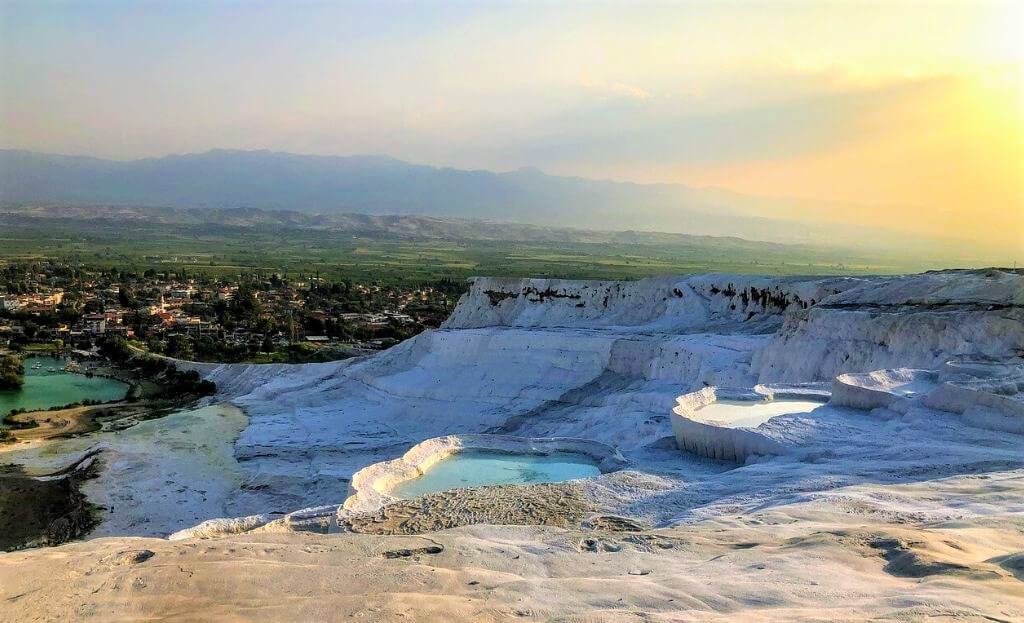
👉 READ ALSO: What Is Istanbul Known For? 21 Great Reasons To Visit
9. Go Paragliding
What can be a better experience than seeing the cotton castle from above in the air? Go paragliding here to get the best views and photos of these travertine pools. To have even nicer views, watch the sunset and the pools from above later in the evening.
➡ Book this paragliding experience in Pamukkale. Click this link to secure your spot and get the best views of the travertine pools.
10. Enjoy Hot Air Balloon Ride
If you’re scared of paragliding , another great alternative is to enjoy a ride on this hot air balloon . It’s a more calming experience than paragliding and will give you more time to enjoy the views as the ride is much more slowly.
➡ Book this sunset hot air balloon experience to get the most beautiful views of travertine terraces and the sunset setting behind the mountains.
11. Fly Over Pamukkale In A Gyrocopter
For extra adrenaline , you can also ride this gyrocopter above Pamukkale . While you might not enjoy the thrill of being outside (as with paragliding), you’ll get to see more of the entire area . So it just depends on your preferences and what you choose to do.
Whether it’s paragliding, a gyrocopter, or a hot air balloon, these three experiences certainly offer the best views of Pamukkale .
➡ Book this gyrocopter experience and get the best views of Pamukkale and its surroundings.
12. Experience Turkish Sema Ceremony
Visit the home of the dervishes in Pamukkale, learn about their spiritual beliefs , and life. Dervishes are religious mendicants who choose to live in material poverty and live a highly spiritual life. They’re mainly part of Persian and Turkish culture .
Watch their traditional whirling ceremony and experience the Sema ceremony . It’s the best cultural experience you can get in Pamukkale. I highly recommend seeing it.
➡ Book this Sema ceremony and watch the traditional whirling dance in Pamukkale.

13. Have Fun In Aquapark
Pamukkale has its own Aquapark, the best attraction for families with kids . It has many waterslides , fun areas, small pools for kids , and whirlpools. So if you visit Pamukkale with children , this Aquapark will surely be the best thing you can do.
You can get tickets to the Aquapark on the spot .
14. Have A Picnic In A Natural Park
Another amazing thing is to enjoy views of the travertine terraces from the Natural Park nearby. I recommend buying some Turkish bread , cheese , salami , and local sweets such as Baklava and having a picnic with views Pamukkale’s cotton castle .

15. Immerse Yourself In Turkish Tea/Coffee Culture
Turkish hospitality is something you have to experience everywhere you go in Turkey. So after you visit the travertine pools, I highly recommend visiting a local café for an unforgettable Turkish tea or coffee experience.
Sit on a traditional Turkish sofa with carpets , and chat with Turkish people while sipping delicious tea and coffee. Try it with the colorful chocolate they serve alongside these drinks.
PRO TIP: I recommend having Turkish tea/coffee with colorful chocolate in Osmanli Cafe & Restaurant .

16. Try Traditional Bread In Local Bakery
One thing I love to do when I come to a new place is to try something in a local bakery . I don’t know how about you, but it always connects me to the place and the country I’m currently visiting. Bakeries are very traditional, and trying local bread and its variations is a unique cultural experience .
I loved the bakery in Pamukkale and highly recommend you visit it. It’s close to the main bus stop. Buy some local Turkish bread for your picnic later.

17. Eat Delicious Turkish Food
Of course, you must eat some delicious food while in Pamukkale. Since it’s a very touristy place, I wanted to include this section as I want you to have a great experience everywhere you go. Many of the local restaurants were touristy with less touch of local culture.
So if you want to eat good food in Pamukkale , these are the restaurants you should go to:
- Hiera Coffee & Tea House
- Seven Spices Indian
- GÜLSÜM BACININ YERİ – for traditional Turkish Gozleme
PRO TIP: If you don’t know what to eat in Turkey, check this article for some food ideas.
18. Explore Kaklik Cave
Kaklik Cave is located 44 km away from Pamukkale , about a 40-minute drive. It’s a beautiful place to visit as a half-day trip from Pamukkale .
It’s also called the Pamukkale Cave , as you’ll also see beautiful travertine pools inside a cave, which is a unique experience. You can walk around and through the cave on a wooden walkway .
Outside the cave is a hot spring with mineral water , so try it out. You can also swim in a pool – its mineral water has many healing benefits for your body.
➡ Rent a car here to drive from Pamukkale and visit Kaklik Cave .
19. Go On A Day Trip To Lake Salda
Salda Lake is the 5th cleanest lake worldwide , full of minerals. Its turquoise waters and white sand will make you feel like you’re in Indonesia. Indeed, people often refer to this lake as the Turkish Maldives .
Lake Salda is a breathtaking place because of its colors and the surrounding scenery with mountains. So take some time to drive here from Pamukkale and swim in one of the cleanest lakes in the world .
➡ Rent a car here to drive from Pamukkale and visit Lake Salda .

👉 READ ALSO: Is Turkey Worth Visiting? 12 Best Things To Do
Best Things To Do At Night In Pamukkale
Out of my list above, things that you can do at night in Pamukkale are:
✅ Experience Sema ceremony ✅ Go clubbing (Marina Club or Hades Club) ✅ Eat delicious Turkish food ✅ Experience Turkish tea culture
If you’re looking for things to do at night, I recommend first enjoying Turkish dinner in a local restaurant (I suggest Hiera Coffee & Tea house ). You can also experience Turkish tea culture in my favorite cafe and restaurant ” Osmanli ”.
After, book this unforgettable Sema ceremony and learn about Dervishes. Eventually, you can go clubbing in Pamukkale at night. I recommend Marina Club or Hades Club .
Best Things To Do In Winter In Pamukkale
You can do all the activities I suggested above in winter , too. Pamukkale is open in winter , and you can visit it. Prepare for lower temperatures as they drop to 5°C. So the weather is a bit cold and rainy . It can also snow in Pamukkale in winter.
The travertine pools are open from 6:30 am until 6:00 pm during the wintertime. The water will be freezing , so prepare for it by bringing extra shoes to walk through the travertine pools.
Winter is a nice time in Pamukkale as you can enjoy the unique scenery, and there are fewer people than during the summertime.
Best Things To Do In Summer In Pamukkale
You can do everything I suggested in my list above in Pamukkale in the summer. So choose what you like the most and enjoy it to the fullest. Don’t miss out on visiting Salda Lake , as it’s one of the most unique places you can visit in the summertime.
Free Things To Do In Pamukkale
There are also a couple of free things you can experience in Pamukkale. These include:
✅ Have a picnic in a natural park ✅ Walk around Pamukkale’s town ✅ Visit local bakery ✅ Go inside a mosque ✅ Watch sunset
👉 READ ALSO: Best Of Istanbul Itinerary: 3 Days With Tips
What Is Pamukkale Known For?
Pamukkale (in the Turkish language) means ‘’ cotton castle ’’. It’s an area of beautiful travertine terraces close to Denizli city in Turkey. It’s one of the top Turkish landmarks everyone should visit.
These terraces were formed by the water from hot springs falling over the edge of cliffs. This water contains dissolved calcium bicarbonate that deposited on these cliffs and formed the white terraces you can see today.
These white travertine pools made Pamukkale a famous traveler’s destination in Turkey. Today, you can walk through the travertines , visit its town, and enjoy the hot springs with breathtaking mountain views.
Practical Tips For Visiting Pamukkale
Now that you know what to do in Pamukkale, I’d like to give you some practical tips for your visit. These include the best time to come to Pamukkale, the best hotels to book, how long you should stay , and my suggested itinerary for your visit to Pamukkale. So check these out below.
Where Is Pamukkale Located?
Pamukkale is located in western Turkey , close to the city called Denizli . It’s 575 km from Istanbul , 243 km from Izmir , 242 km from Antalya , and 482 km from the capital Ankara .
So as you can see, for instance, if you’re enjoying a beach vacation in southern Turkey, Antalya , you could make a day trip to Pamukkale . But if you’re in Istanbul , you might need 2 to 3 days to visit this place.
➡ A typical thing to do is to visit Pamukkale on a day trip from Antalya . I recommend this guided tour to Pamukkale from Antalya.


How To Get To Pamukkale Turkey
You can get to Pamukkale either by bus or car .
If you take a bus to Pamukkale from any other major Turkish city, you must change buses in Denizli . Denizli is a big city close to Pamukkale, and buses run regularly throughout the day to its beautiful travertine terraces.
You can also rent a car by clicking this link and get to Pamukkale by car. It’ll be a quicker and more convenient option.
PRO TIP: Rent a car here for 3 days and pick it up in Denizli . Then drive to Pamukkale and also visit Salda Lake & Kaklik Cave.
How To Get Around Pamukkale
The best way to get around Pamukkale is on foot . The town, travertine pools, and Hierapolis ancient city are walkable ; you can allocate one day to see all the sights.
If you want to visit sights around Pamukkale , like Kaklik Cave and Salda Lake, the best way to get around is by car .
RENT A CAR FOR YOUR ITINERARY

Rent A Car Via Discover Cars – best prices and big selection of car rentals. PRO TIP: Check ratings of the company you choose before booking ( ratings can be off ). Go on Google, see ratings of the car rental company, then book on Discover Cars.
Where To Stay In Pamukkale: My Top Hotel Picks
Pamukkale is a tiny town in the southwestern part of Turkey. Yet, there are many accommodation options. I spent 2 nights in Pamukkale and researched some of the best hotels. Check out my top 4 below :
🔅 Bellamaritimo Hotel – best budget-friendly hotel – book here 🔅 Venus Hotel – best mid-range hotel – book here 🔅 Hotel Sahin – hotel with best views of travertine pools – book here 🔅 Spa Hotel Colossae Thermal – best luxury hotel – book here
How Long Should You Spend In Pamukkale?
I recommend spending 2 full days in Pamukkale and arriving a day before your itinerary. This way, you’ll have time to enjoy all the activities and attractions the place offers. And on the second day, you’ll enjoy stunning sights in its surroundings, such as Kaklik Cave and Salda Lake.
Best Time To Visit Pamukkale
The best time to visit Pamukkale is in April, May, September, and October . These months are much less crowded than the summertime. So you’ll enjoy the travertine pools more, especially if you go early in the morning .
The weather is mild , so you don’t have to suffer walking around in the heat.
What To Pack For Pamukkale
I suggest bringing casual clothes to Pamukkale . When you enter the travertine pools, you’ll have to get your shoes off and carry them while walking barefoot. So it’s best to wear sandals .
The pools reflect the sunshine , so I highly recommend bringing sunscreen and a hat .
Here is a quick list of the things I recommend bringing for your visit:
✔ Sandals ✔ Comfortable shoes to walk ✔ Hat ✔ Sunscreen ✔ T-Shirts ✔ Shorts/Skirt ✔ Dresses ✔ Waterproof & light jacket ✔ Sweater ✔ Small backpack for a day
Suggested Itinerary For Pamukkale
Here is a suggested 2-day itinerary for your visit to Pamukkale from my experience.
↪ 0. DAY – Rent a car in Denizli and drive to Pamukkale. Check in to your hotel , walk around the town, and have a nice dinner.
1. DAY: Pamukalle Itinerary
↪ 1. DAY – Visit Pamukkale’s travertine pools in the morning right after its opening. Walk around the pools until you reach Hierapolis . Then spend some time exploring the ancient city with its theatre, temples, and the archaeological museum.
After, walk back to the town , where you can have late lunch . In the afternoon, spend some time in the city and walk around. I highly recommend this paragliding experience or riding a hot air balloon to watch the sunset and the cotton castle from above. It’s one of the best experiences you can have in Pamukkale.
2. DAY: Pamukkale Itinerary
↪ 2. DAY – Use the second day to explore the beautiful surroundings of Pamukkale .
In the morning, drive to Salda Lake . Enjoy its incredible color and white sand beaches. Swim and relax.
After, check out the Kaklika Cave with its stunning travertine pools. Then swim in a nearby mineral pool, too. In the evening, drive back to Pamukkale (or directly to Denizli to return the car).

Top Guided Tours To Pamukkale
Check out the best guided tours below if you want to visit Pamukkale from other Turkish places such as Istanbul, Izmir, or Antalya . You can skip planning and book one of these guided tours, depending on your vacation place.
These are the top guided tours I recommend for Pamukkale:
🔅 Tour From Antalya : Book this guided tour to Pamukkale if you stay in Antalya . 🔅 Tour From Izmir : Book this guided tour of Pamukkale if you stay in Izmir . 🔅 Tour From Istanbul : Book this guided tour of Pamukkale if you stay in Istanbul .
BONUS: 10-Day Turkey Itinerary
I traveled extensively through Turkey and visited many highlights. Based on my experience, I’ve created this 10-day Turkish itinerary so you can also see the best places and have fun. The trip also includes Pamukkale.
Click on the image below, follow my 10-day Turkish itinerary , and skip the planning process:

I’ve also answered some of the frequently asked questions to help you get the most out of your visit to Pamukkale. So check them out below.
Is Pamukkale Turkey Worth Visiting?
Yes , Pamukkale in Turkey is well worth visiting . Its travertine pools are something unique that you barely find anywhere else (only a few places such as Italy or Slovakia ).
For the best time , I recommend visiting Pamukkale early in the morning , right after its opening. You’ll avoid crowds of people and will have the place pretty much for yourself. It makes a lot of difference.
How Can I Spend A Day In Pamukkale?
Start your day in the morning, walk through its stunning travertine terraces , then see the hot springs and explore Hierapolis . Educate yourself in the archaeological museum before you come back to the town. Have a great Turkish lunch at Hiera Coffee & Tea House .
In the afternoon, I highly recommend going paragliding or riding a hot air balloon as it’ll give you another perspective of the pools, and you’ll honestly get the best views of the area .
Spend the evening in a local park having a picnic with the views of the travertine pools.
Is 1 Day Enough In Pamukkale?
Yes , one full day is enough for Pamukkale. You’ll see and do almost everything the place offers within a day.
The main attractions are its travertine pools and Hierapolis ancient city, which you can explore within half a day . Spend the other half of the day in the town and do adventure activities such as paragliding. Or go to the Aquapark if you are in Pamukkale with the kids.
Can You Swim In Pamukkale?
Yes , you can swim in Pamukkale. But I’d instead use the word ‘ bathe .’ Most of Pamukkale’s travertine pools are shallow . They don’t have enough water to be able to swim. But you can bathe inside .
You can visit Pamukkale’s Aquapark if you want to swim.
WRAP-UP: Visiting Pamukkale
These are the best activities you can experience in Pamukkale. Even though it’s a very touristy destination, it’s still worth visiting. My biggest tip is to enter the travertine pools in the morning right before opening. This way, you’ll have a much better experience as you’ll avoid the crowds.
If you have any questions, contact me at info(at)voicesoftravel.com . I’ll gladly help you or design a customized travel itinerary for you.
Happy Travels!
More Tips For Turkey Travel
Looking to visit more places in Turkey? Check out my related articles:
Best Of Turkey Itinerary 10 Days
Istanbul Itinerary For 3 Days
Is Turkey Worth Visiting? 12 Best Things To Do
27 Best Things To Do In Cappadocia: Ultimate Guide
9 Best Cappadocia Tours From Istanbul
33 Famous Turkey Landmarks To Visit
Is Istanbul Safe For Americans? Safety Tips For Travel
Is Cappadocia Safe For Travel? My Top Safety Tips

About the author: Nicoletta is a travel enthusiast and passionate language learner. While traveling, she loves to connect with locals using her language skills to learn about new cultures. Look for her skiing, hiking in the mountains, or exploring new destinations as she designs travel itineraries for her clients.
TURKEY : Interested in more articles for Turkey? Check out my Turkey Travel Page :

You Might Also Like
![pamukkale travel guide Read more about the article 17 Best Things To Do In Lake Bled Slovenia: Ultimate Guide [2024]](https://voicesoftravel.com/wp-content/uploads/2023/10/best-things-to-do-in-Lake-Bled-1-300x213.jpg)
17 Best Things To Do In Lake Bled Slovenia: Ultimate Guide [2024]

Is Florence Worth Visiting In 2024? 19 Reasons To Visit & Best Things To Do
![pamukkale travel guide Read more about the article Christmas In Spain: Full Guide With Traditions & Best Places [2024]](https://voicesoftravel.com/wp-content/uploads/2023/11/christmas-in-spain-traditions-and-places-to-visit-2-300x213.jpg)
Christmas In Spain: Full Guide With Traditions & Best Places [2024]
Leave a reply cancel reply.
You must be logged in to post a comment.

Stories by Soumya
The Travel Blog of a Culture Addict
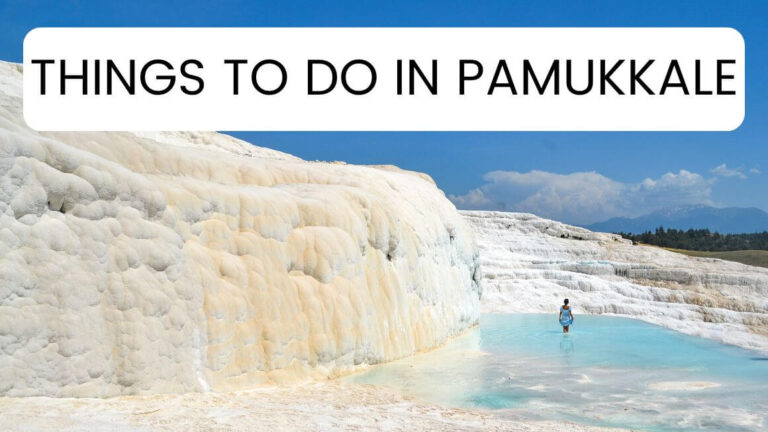
13 Best Things To Do In Pamukkale Turkey: A Complete Travel Guide
Last Updated on September 22, 2022 by Soumya
Looking for the best things to do in Pamukkale, Turkey ? Wondering what are the best Pamukkale attractions that you need to add to your bucket list? How many days in Pamukkale is really enough?
In this complete travel guide for Pamukkale, we will answer all your questions and some more.
Honestly, Pamukkale is magical. It is one of the most beautiful places to visit in Turkey and has tons of amazing things to do. Pamukkale’s sparkling white travertines, shallow milky-blue pools, and petrified waterfalls make this place a unique natural wonder. The ruins of an ancient Greco-Roman spa town and a colossal Roman amphitheater adorn the Pamukkale plateau top. Laodicea, a Biblical town, and Lake Salda are not very far away.
In this comprehensive Pamukkale travel guide, you’ll find everything you need to plan your visit to Pamukkale including the best places to visit, best hotels, how to get to Pamukkale, how many days to spend, as well as a sample one day in Pamukkale itinerary .
Quick links to visit pamukkale
To help you quickly plan your Pammukale trip, here’s a list of the best things to do, highly-recommended tours, and great places to stay. Do have a look at our interactive map to access directions to all Pamukkale attractions.
Top things to do
- Enjoy the beauty of Pamukkale’s travertines
- Visit the ruins of Hierapolis including the massive Roman theater
Explore the ancient city of Laodicea
- Full-day guided tour of Pamukkale and Hierapolis
- Pamukkale hot air balloon tour
- Tandem paragliding experience in Pamukkale
Best hotels
- Luxury: Pamukkale Whiteheaven Suite Hotel
- Midrange : Venus Hotel
- Budget : Hotel Pamukkale
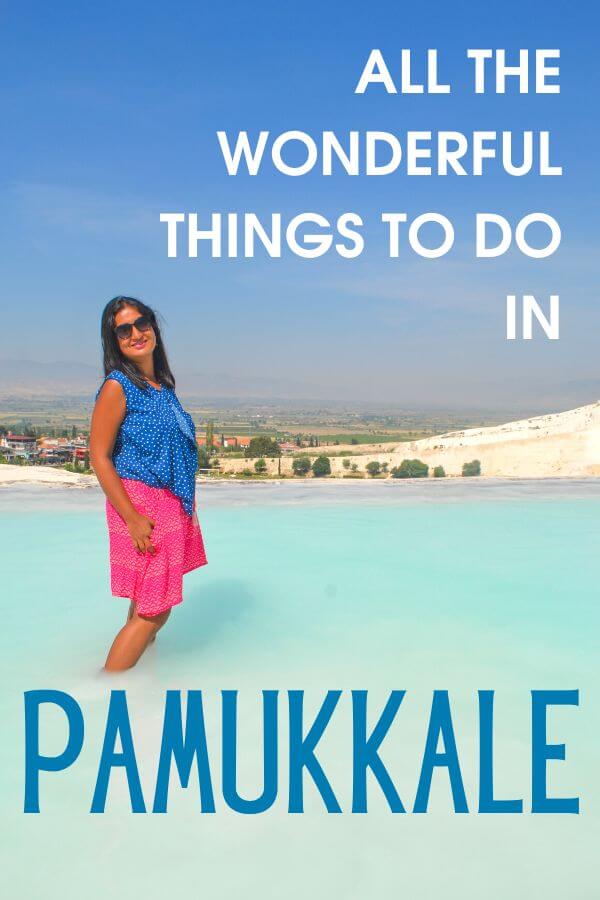
Please note: This post may contain affiliate links which means I may earn a commission if you make a purchase by clicking a link on this post. This will be at no additional cost to you. Affiliate links help me keep this website up and running. Thanks for your support!
Table of Contents
Where and what is Pamukkale?
The word Pamukkale literally translates to “cotton castle” in Turkish. Pamukkale is a unique natural site in southwestern Turkey that actually looks like a giant cotton ball left to dry in the sun . Only this cotton ball is hard and tessellated into small travertine pools filled with turquoise blue water. The result is an absolutely stunning landscape that is not to be found anywhere else in the world.
Pamukkale’s unique landscape is attributed to ongoing geological processes under the earth surface. This area is earthquake prone and has a vast reserve of hot volcanic lava deep inside. The lava heats water which then dissolves with calcium and spurts outside through several fault lines on the Pamukkale plateau. The calcium-rich water then flows down the hill and eventually cools down to form beautiful travertine terraces and calcium cascades.
When the Greeks, and then the Romans, spotted the thermal pools of Pamukkale, they had their moment of epiphany. They decided to build a sprawling spa town here so that people could come and soak in the medicinal waters of Pamukkale. The town was called Hierapolis.
Hierapolis and Pamukkale became a famous attraction in the ancient times. They drew traders, travelers, pilgrims, and the diseased. More recently, in 1988, they were both inscribed on the UNESCO world heritage list. Today, the Hierapolis-Pamukkale duo is one of the most popular places to visit in Turkey.
Pamukkale has had its ups and downs. It has flourished as a healing center, seen many earthquakes in antiquity, and has been damaged by over-tourism. But now, there are a few checks and balances in place and the rest is up to us to give Pamukkale the respect it deserves. Have a look at our travel tips section to know how to visit Pamukkale sustainably.
Best things to do in Pamukkale Turkey
Soak in pamukkale’s travertine pools.
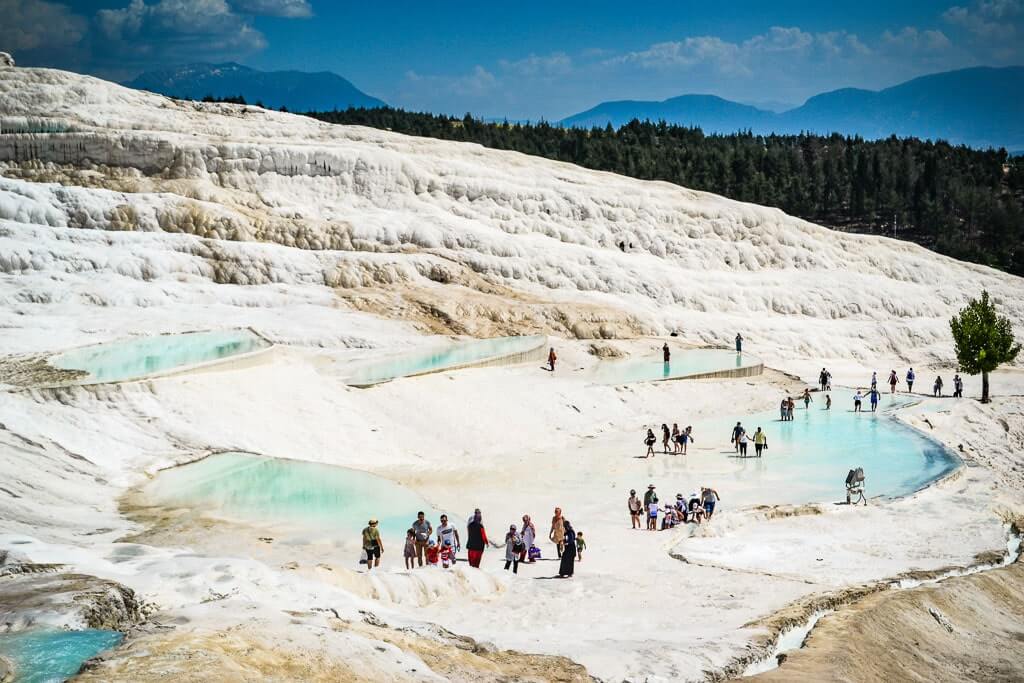
One of the best things to do in Pamukkale is soak in the milky white pools of Pamukkale. The huge limestone hill has hundreds of pools filled with sparkling turquoise water. The water is luke warm and perfect to soak in and relax. Apparently, it has got healing properties too.
These pools dot the travertine cliffs of Pamukkale. Usually the ones at the top are the most crowded. As you go down the cliff, you will find emptier pools and more space to relax and click your own pictures.
Many of the pools have now been cordoned off in order to preserve them. Only one section of the cliff is open to visitors. You can climb this section from Pamukkale’s town entrance. If you are coming in from the North or South Gates, you will need to climb down from the top. It takes about 20-30 minutes to finish the climbing up/down.
Remember to take your shoes off before you start walking on the travertine. Some places can be slippery. So, be careful while walking because there is nothing to hold on to.
Visit the archaeological site of Hierapolis
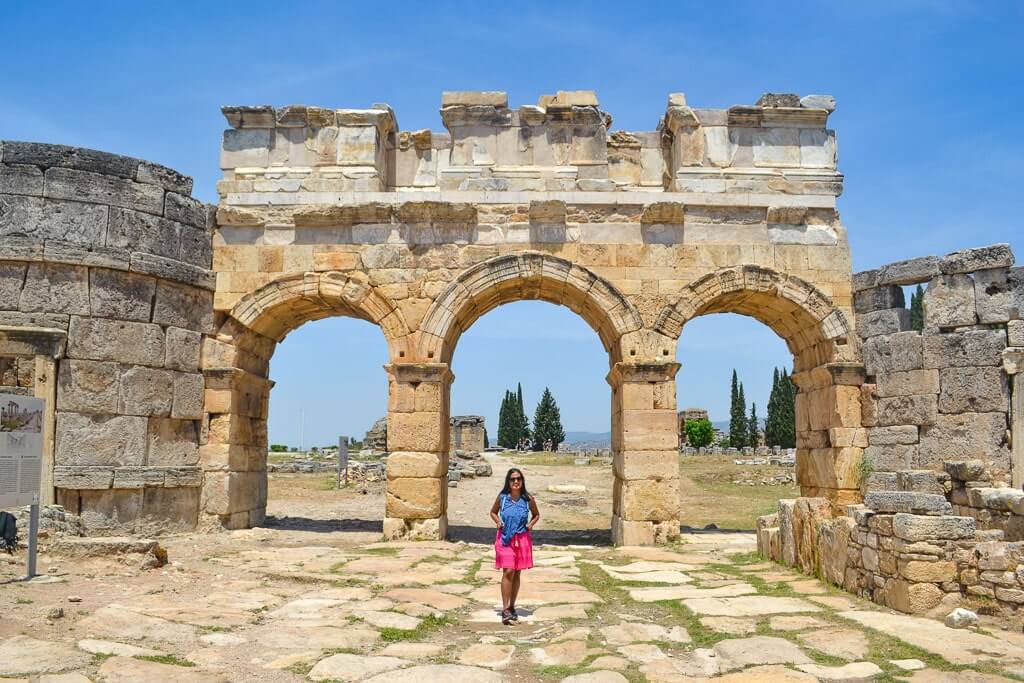
At the end of 2nd century BC, the Attalid kings of Pergamon built a spa town in ancient Pamukkale. The town revolved around the ancient cult of Goddess Leto and was called Hierapolis. It was home to Roman public baths, a gym, an agora, a sprawling necropolis, and an ancient theater – the ruins of which we can see today.
Later, Hierapolis became an important center for Christianity during the Byzantine Empire. That’s why, you will see the Martyrium of St. Phillippus commemorating St. Philip’s martyrdom here.
The Greco-Roman city of Hierapolis and the unusual landscape of Pamukkale are one of Turkey’s most visited world heritage sites.
It is interesting to walk through the ruins of Hierapolis and understand how this ancient City of Water and Faith functioned. Two main gates controlled the inflow and outflow or people. At the gate, visitors had to wash up and use the loo (you can still see the latrines today). Outside the gate, you’ll find a sprawling necropolis with some amazingly-preserved sarcophagi. If you are a history buff, then Hierapolis will enthral you.
Check out the massive Hierapolis theater
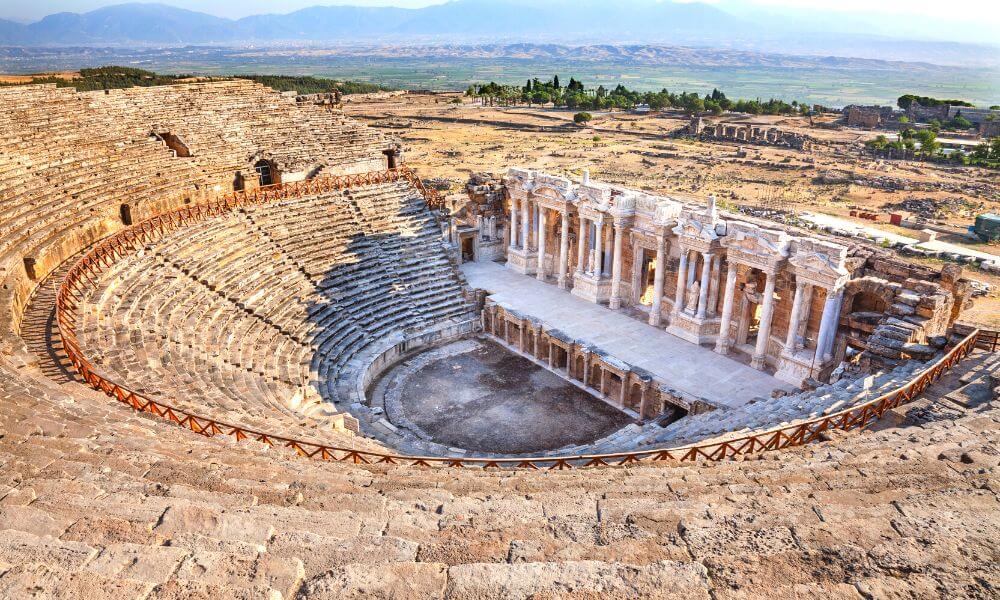
One of the most iconic Pamukkale attractions is the Hierapolis Ancient Theater that could once seat more than 10,000 people. The theater is more than 1800 years old and is built on the site of an old, Greek theater than was destroyed during the earthquake of 60 CE.
The most fascinating thing about the Hierapolis Ancient Theater is that it is the only one that is preserved with all original architectural materials.
The entire theater is an architectural masterpiece. I especially loved the stage with its restored columns that featured the most marvelous stone friezes.
Visit the ancient Gate of Hell at the Ploutonium
The ancient city of Hierapolis has an interesting legend associated with it. It was once the location of a rather infamous gateway to the underworld – a deadly “Gate to Hell”.
Hierapolis had a cave that was always shrouded with haze. Animals would mysteriously drop to death here. This Gateway to Hell gained popularity throughout the Roman Empire. People from far and near came here to sacrifice their animals in order to please God Pluto, who they believed was behind the deaths.
Guess what? Hierapolis’ “Gate to Hell” still exists. And the reason behind all those animal deaths has now been discovered. A recent report by BBC tells us that a supremely high concentration of noxious carbon dioxide (and not the breath of some displeased God) was the reason behind these deaths.
Today, you can still view this legendary area, albeit from a safe distance.
Swim in Cleopatra’s antique pool
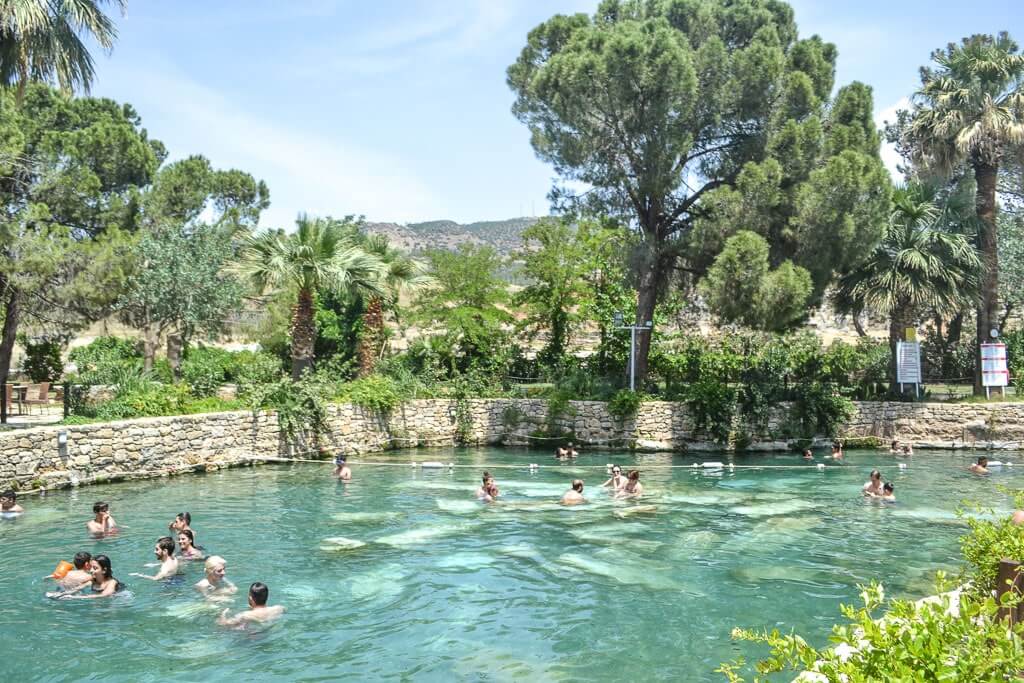
Within the heritage site, there is an enclosed section that has warm pools where you can go for a swim. Unlike the bluish-white waters of the travertine, these pools are crystal clear and said to possess medicinal properties. It is believed the Cleopatra once swam in these pools, hence the name.
There is a separate entrance fee for the pools that is not included in your Pamukkale-Hierapolis ticket. The ticket costs around 100 TL and includes the use of changing rooms. If you need towels or a locker, you’ll need to pay separately. Another 10 TL, I believe. Get your own towel if you are planning to take a dip. Find the opening hours of the antique pools here .
There are small gardens and walkways around Cleopatra’s pool that you can access for free. A small hand-pump at the far end gives out medicinal water apparently, though I did not like the taste of it at all. The water was too sour and salty for me – probably filled with minerals!
But I loved the food at the cafe right by the pool. It is more like a food court where there are separate counters for burges, pizza, corn, and ice cream. In case you are hungry with all the walking around, you can stop for a quick meal here. There are washrooms here too.
Step into the Archaeology Museum
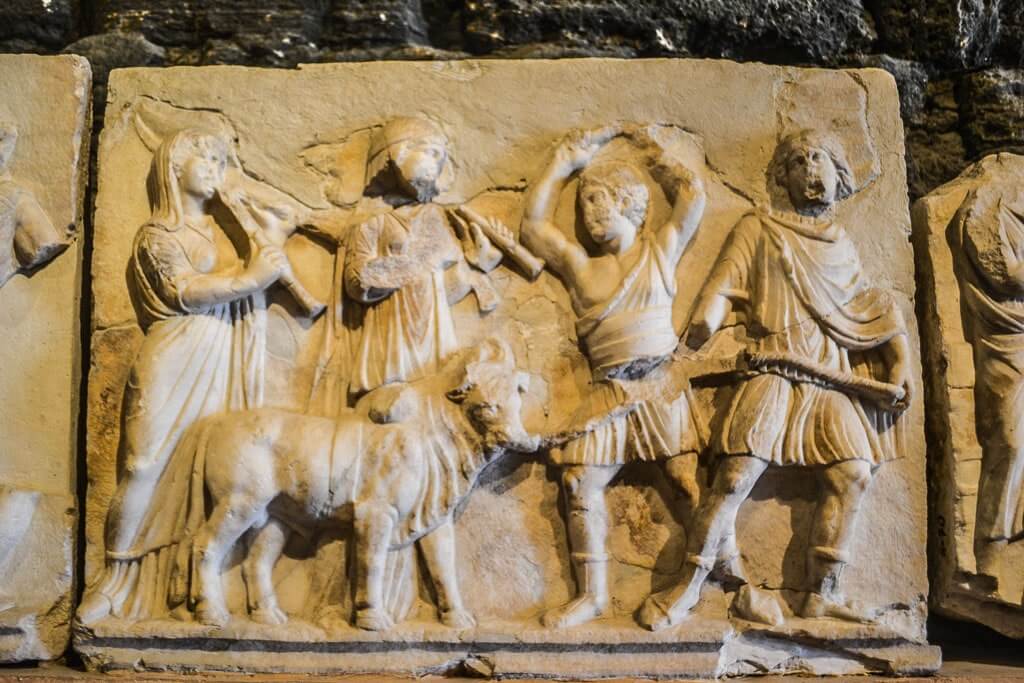
Located near the antique pools in Pamukkale, the Archaeology Museum is a good place to learn about the ancient Roman ruins of Hierapolis.
Denizli Hierapolis Archaeology Museum is housed in the vaulted rooms of the ancient Roman baths and has several interesting galleries including an open-air one lined with sarcophagi.
3 different galleries exhibit artifacts that have been unearthed in Hierapolis, Laodicea, and Tripolis. Do not miss the Hierapolis theater ruins gallery that has several amazing reliefs from the Hierapolis theater. Coronation of Septimius Severus, delights of Dionysus, and the birth of Apollo and Artemis are a few notable ones.
The museum is open from 8:00am – 7:00pm every day and is included in the site ticket.
Paraglide over Pamukkale travertines
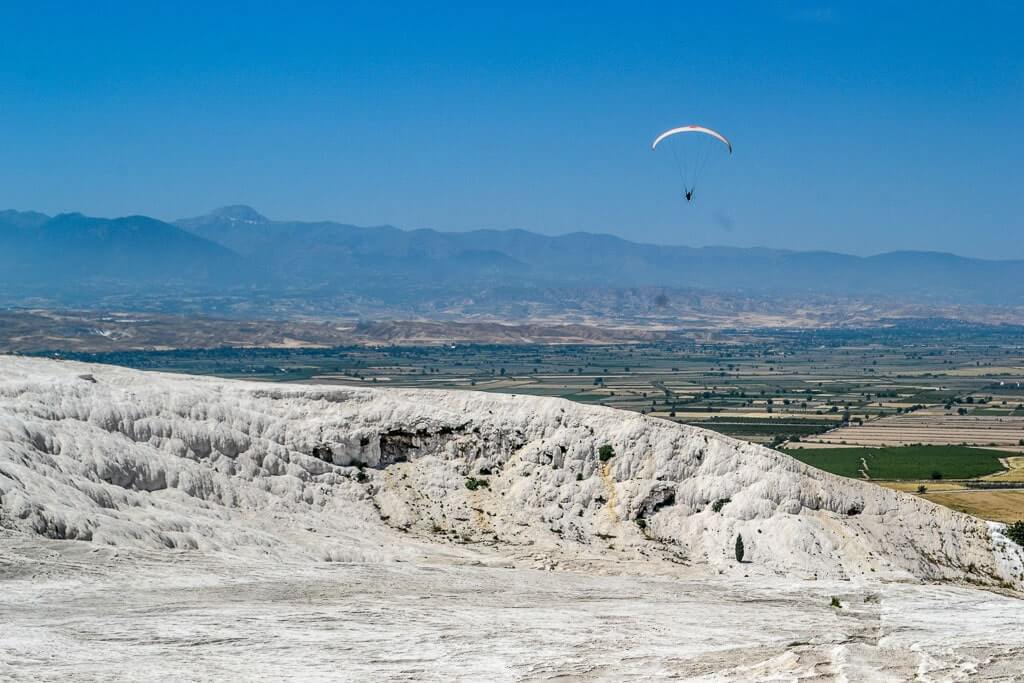
If you are looking for something adventurous when visiting Pamukkale Turkey , try tandem paragliding.
On this paragliding tour in Pamukkale , you’ll soar high above Turkey’s cotton castle and see the stunning blue and white landscape from above. It is, indeed, a wonderful experience to get a bird’s eye view of Pamukkale’s travertines and the ruins of Hierapolis.
The flight time is about 30 minutes and you’ll be riding with an experienced pilot so that you can relax and take all the pictures you want to.
Ride a hot air balloon
If paragliding is not your thing but you are still keen to see Pamukkale’s dreamy landscape from above, then try this highly-rated Pamukkale hot air balloon tour .
The balloon ride lasts about 30-45 minutes and shows you the best of Pamukkale from the air. You’ll glide over the beautiful travertines, Hierapolis ruins, and the massive Roman theater at Pamukkale. Seeing this unique landscape from above especially by the orange hues of sunrise is a magical experience.
Balloon tours in Pamukkale are not as touristy as the ones in Cappadocia . However, balloon cancellations in Cappadocia are higher than in Pamukkale. So, it is actually easier to find a spot in Pamukkale.
Watch the beauty of Pamukkale at sunset
As much as you’ll love flying over the travertines at sunrise, seeing Pamukkale at sunset is a divine experience too. The white and blue travertines turn different shades of yellow and orange as a setting sun casts an ethereal glow over the entire mountain. It is truly a sight to behold.
The archaeological site and the travertines are open from 6:30am – 9:00pm, so you should be able to catch the sunset if you plan to stick around till the closing time.
Visit Pamukkale Natural Park
At the bottom of the travertines, there is a pretty natural park with lakes and greenery all around. You can swim in the pools (there are 3) here or ride a boat in the lake. Apparently, this is a popular venue for weddings in summer evenings, so evenings may not be the best time to visit.
When we visited in May, the swimming pools were not that clean. I think the whole park was closed because it was right after the pandemic. So, you may want to check on the pools before entering.
The park needs a separate entrance fee and the pools are open from 10:00am to 7:00pm. The entrance to the Pamukkale Natural Park is located at the bottom of the plateau i.e. at the Town Entrance.
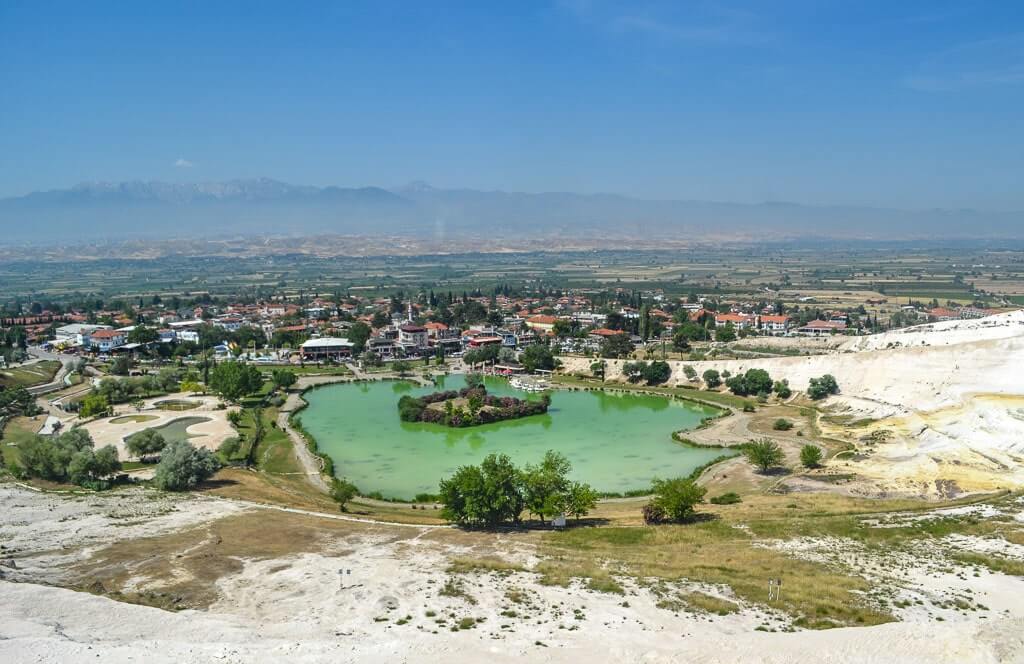
Pamukkale Turkey is home to not just the ancient city of Hierapolis but also to the ruins of Laodicea on the Lycus, a prosperous Greek town dating back 2500 years. Laodicea was once a famous trading center and home to bankers and doctors.
There was a large Jewish community in Laodicea. Then, it quickly became an important seat of Christianity. The Church of Laodicea was named by St. John as one the Seven Churches of Asia in his Book of Revelation. No doubt, this ancient city has deep Biblical connects making it an interesting travel destination for Christians and history buffs. Ephesus is another place where Christian pilgrims flock to because it is home to the House of Virgin Mary and St. John’s Basilica.
Highlights of Laodicea include the colonnaded street, the basilica church, the north theater, an agora, and remains of a public bath. Chances are that when you visit Laodicea, it will be pretty empty except for a few history buffs roaming around.
However, the thing is Laodicea isn’t a great fit in a one day itinerary of Pamukkale because there is a lot to do around the Pamukkale-Hierapolis area itself. Laodicea is great stop if you are planning to spend more than a day in Pamukkale.
Head to the beautiful Salda Lake
From Pamukkale, you can do a day trip to the world famous Salda Lake, located in Burdur province in southwestern Turkey.
With its white sand coast and turqoise blue waters, Lake Salda looks more like a beach in Cancun or the Maldives. Actually, this lake is often referred to as Turkish Maldives even though it is nowhere near the coast but right in the middle of a valley.
In fact, the Salda Lake has some interesting geological phenomena going on. According to a report by Nasa Earth Observatory , the similarities between Salda and a crater on Mars are uncannily similar. Needless to say, Lake Salda is one of the most unusual but beautiful places to visit in Turkey.
Try some Denizli kebab
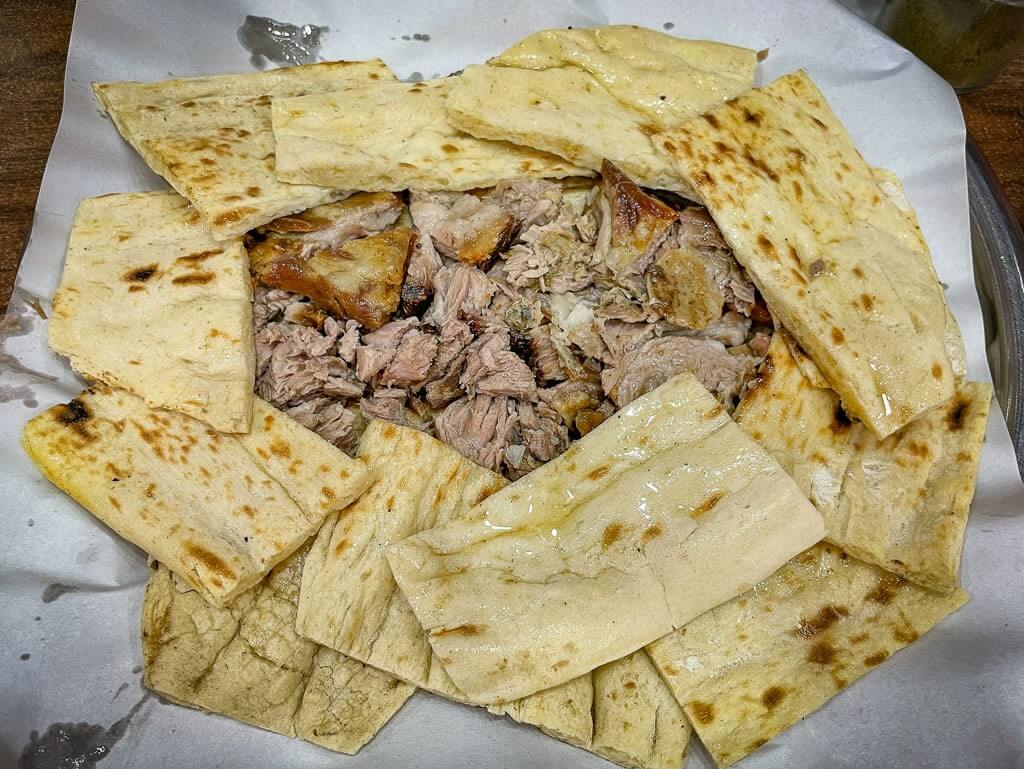
If you are going to stay in Denizli like we did, then you have to try some authentic Denizli kebab . Turkish cuisine is famous for different kinds of kebabs that hail from different cities. Denizli has its own version made of lamb.
Denizli kebab is a succulent meat dish that is made by putting lamb meat in skewers and cooking it in the oven for 3 long hours. It is served with traditional lavash bread and a side of onions and tomatoes. I paired it up with ayran , the local Turkish drink, and absolutely loved it.
Locals eat the dish with their hands instead of spoon and fork. So, get ready to dig in (literally with your fingers) into some yummy kebabs in Denizli. A great place to try it out is Meshur Denizli Kebapcisi .
Interactive map of Pamukkale attractions
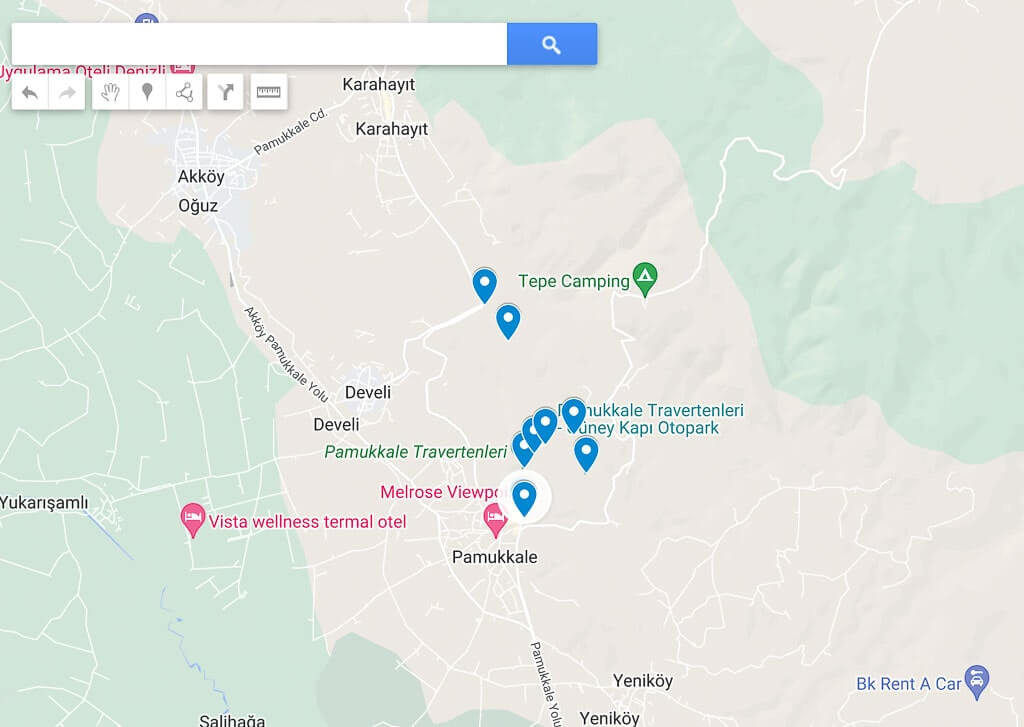
Where to stay in Pamukkale Turkey?
There are many wonderful places to stay in Pamukkale Turkey . Here are a few that are located in and around the Pamukkale City Center and are within walking distance from the travertines.
- Venus Hotel is a good, midrange hotel with nice and clean rooms, an outdoor swimming pool, and some great breakfast. Guests love the relaxed and friendly atmosphere at this family-run hotel.
- Hotel Pamukkale is a more budget-friendly place with some great amenities and extraordinary hosts. Rooms are big and clean and the location is perfect. According to guest reviews, Hotel Pamukkale is excellent value for money.
- If you are in a mood to splurge during your Pamukkale visit, stay at Pamukkale Whiteheaven Suite Hotel . Excellent location, an outdoor pool with a sun terrace, a peaceful garden, and guest rooms with balconies make this place an absolutely beautiful place to stay.
- If you would like to stay in a bigger city and have no problems using the public transport, stay in Denizli, the town closest to Pamukkale-Hierapolis heritage site. Denizli is also easier to get to from the Denizli Airport and bus stop. Laodikya Hotel is a great choice with clean rooms, friendly staff, and a central location that is super convenient for people using public transport.
Best time to visit Pamukkale
The best time to visit Pamukkale is undoubtedly in spring (mid-Mar – May) and fall (mid-Aug – October). Temperatures are milder and the heat is not as scorching as in summer. It is warm enough to take a dip in the pools which you would not want to do in the winters, of course, when temperatures can dip below 32°F (0°C).
Summers (Jun – mid-Aug) are the busiest times in Pamukkale. Temperatures can go up 105°F (40-42°C). Even though this is a great time to swim and soak in the Pamukkale pools, it may not be the greatest time to explore the ruins. The heat can be gruelling, trust me. We were here towards the end of May and it was already getting pretty hot. Be sure to carry your hat, sunglasses, sunscreen, and lots of water.
How many days should you spend in Pamukkale?
One full day is enough for Pamukkale Turkey. In one day, you can see the ruins of the ancient city of Hierapolis, climb up to the Roman theater, swim in Cleopatra’s antique pools, visit the Archaeological Museum, walk down the stunning blue and white travertines of Pamukkale, and catch a mindblowing sunset just before you leave.
If you wish to see the Biblical City of Laodicea, visit Salda Lake, or explore Denizli, then you’ll need one more day.
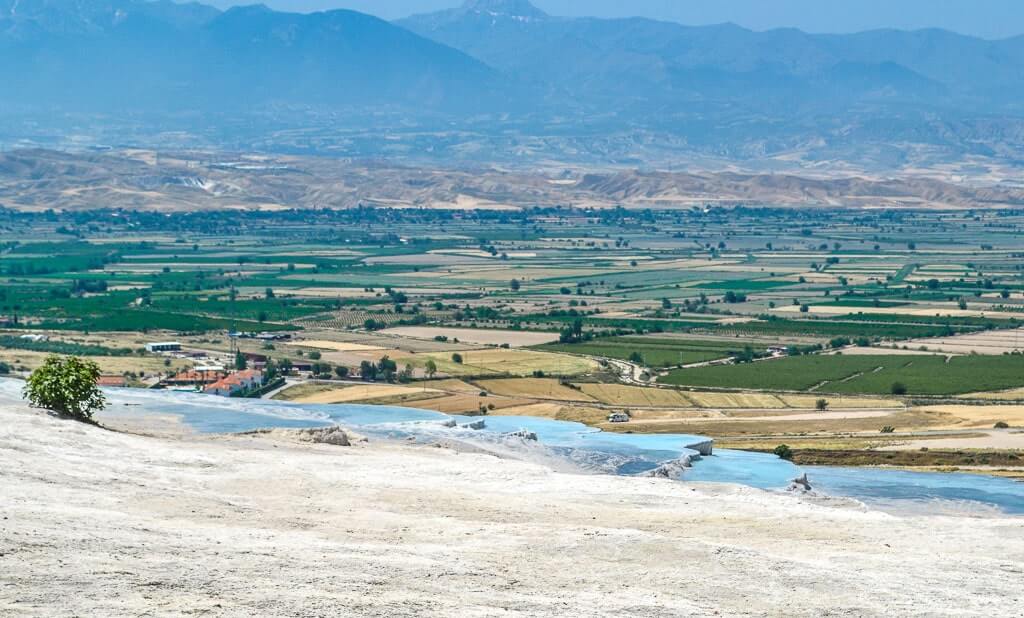
Sample one-day itinerary for Pamukkale
- Begin your day early and start by visiting the ruins of Hierapolis. The South Gate opens at 6:30am. If you can get here by then, you’ll have the entire place to yourself. You’ll need a good 2-3 hours to see the ancient city, the theater, and the necropolis.
- Next, head to Cleopatra’s antique bath and have a good swim in the mineral waters. The bath is open from 8:00am – 8:00pm in summer and 8:00am – 6:00pm in winter. If you are hungry after the swim, have an early lunch at the cafeteria by the pool.
- After that, visit the Hierapolis Archaeological Museum and spend 30mins – 1 hour here.
- Next, head to the Pamukkale Cotton Castle. There is a small cafe in this area if you wish to have a quick bite. Their ice creams and gozlemes are wonderful. At midday, the pools are filled with people because most tour groups have arrived by then. The pools down the hill are usually a little emptier than the ones on the top. Soak in the pools and wait as the day starts to wear off and the crowd starts to wean. Late afternoons are quieter in Pamukkale and if you stick around long enough, you’ll be able to catch a stunning sunset.
- I would not recommend visiting the travertines first thing in the morning because the pools do not have enough water in them in the morning. They start filling up only after the water source is opened around 8:00am in the day. It is best to reserve your travertine visit to the second half of the day both for the water and the sunset.
Practical information for visiting Pamukkale
Pammukale entrance fee.
The entrance fee to Pamukkale is 200 TL (approximately 11 USD/EUR). This ticket includes the Pamukkale travertines, the ruins of Hierapolis, and the Archaeology Museum. For Cleopatra’s bath, you’ll need to purchase another ticket worth 100 TL.
Entrance (not including Cleopatra’s pool) is complimentary if you have an Aegean or Turkey Museum Pass.
One quick thing to note is that prices for entrances and museum passes are going up pretty fast in Turkey. You may want to check the latest price on the official website here before traveling.
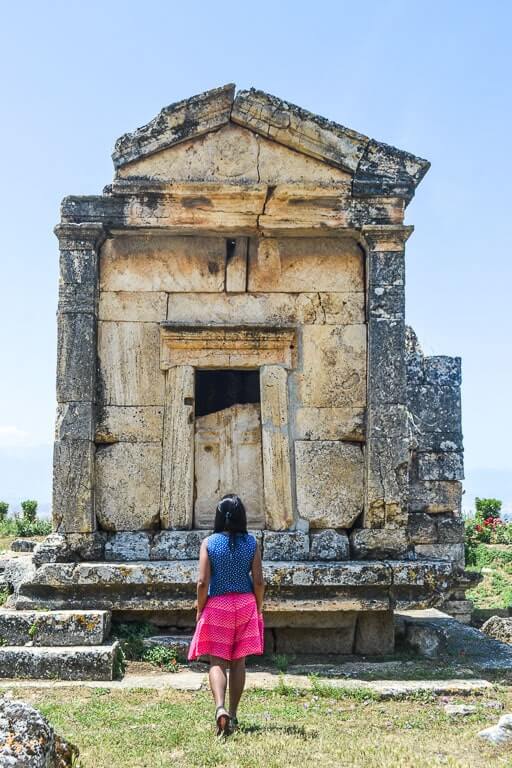
Entrance gates to Pamukkale
There are 3 different entrances to Pamukkale – the Town Entrance also called the Walkway, the South Entrance, and the North Entrance. Have a look at the interactive map for directions to each of these entrances.
From the Town Entrance (this is where our minivan from Denizli dropped us), you can climb up the hill (filled with pools and calcite walls) to get to the top of the plateau. The climb takes between 20-30 minutes. You’ll have to remove your shoes before beginning your climb. So, be sure to carry a plastic bag or something to store your shoes. There is no dedicated parking lot at this entrance but you can park in the town. Pamukkale Town Entrance opens at 8:00am .
The South Entrance is the most popular entrance for visitors. It is closer to both the ruins and the travertine pools. There is a parking lot here. Parking charge per car is 20 TL. The biggest plus of the Pamukkale South Entrance is that it opens at 6:30am .
The North Entrance is closer to the Hierapolis Necropolis which means you’ll have to walk a long way to get to the thermal pools. There is a parking lot here and charges are 20 TL per car. The North Entrance opens at 8:00am and sometimes at 8:20am! Check out Pamukkale opening hours for details.
Pamukkale opening hours
When I was researching for my visit to Pamukkale, I realized that there was a lot of confusion regarding opening hours of the Pamukkale – Hierapolis heritage site. The confusion is legit because every gate has a different opening time and every season has different hours!
So, instead of writing it all down here, I decided to put this image from the Pamukkale brochure that does a good job of explaining all the different opening and closing times at Pamukkale.
Opening hours of Pamukkale – Hierapolis Heritage Site
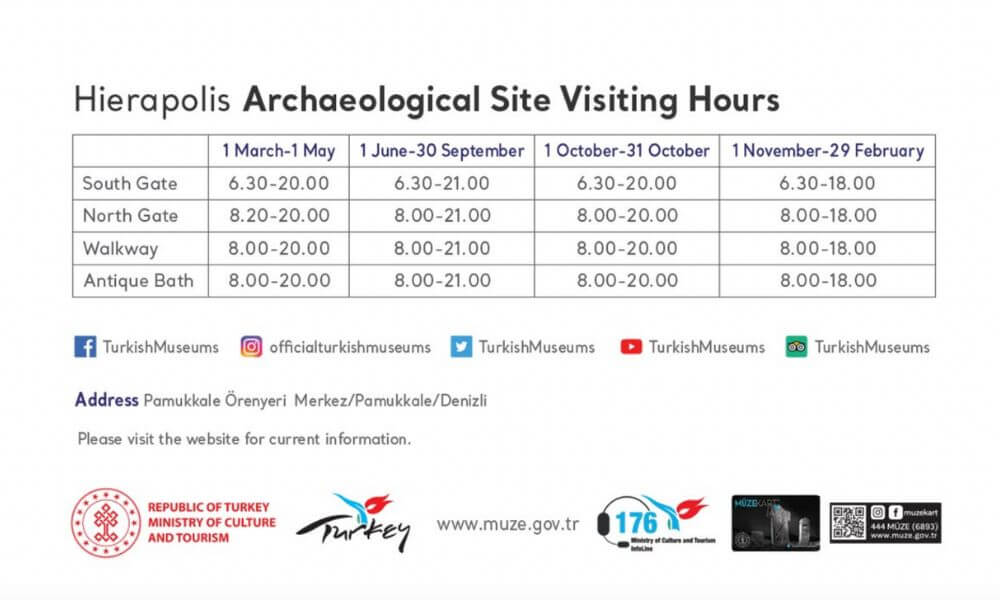
Getting to Pamukkale Turkey
The nearest airport to Pamukkale is the Denizli Cardak Airport (DNZ). If you are coming in from Istanbul, the flight to DNZ Airport is just an hour long. From the airport, you can take a taxi to your Pamukkale hotel or book an airport transfer .
You can also arrive in Denizli by bus from Izmir, Kusadasi, Antalya, or Istanbul. Buses are a cheaper option to get anywhere around Turkey. Bus rides to Denizli from Izmir, Antalya, and Kusadasi can take around 3-4 hours. From Istanbul, the ride is around 10-12 hours.
Kamil Koc is one of our favorite bus companies in Turkey and we rode them a lot during our Turkey vacation. You can book your Kamil Koc tickets here .
Getting from Denizli to Pamukkale
If you are staying in Denizli and wish to use public transport, take a minivan from the lower level (Peron 76 or Gate 76) of Denizli bus stop and ask the driver to drop you at Pamukkale. The Denizli – Pamukkale bus ride takes around 20 minutes and costs 9 TL per person . The driver will drop you at Turgut Ozal Cd which is just 10 minutes away from the Town Entrance of Pamukkale. Once you get down at Turgut Ozal Cd, take a right and keep walking on Ataturk Cd. until you see the white travertines. Have a look at the picture below to see where the minivan is going to drop you.
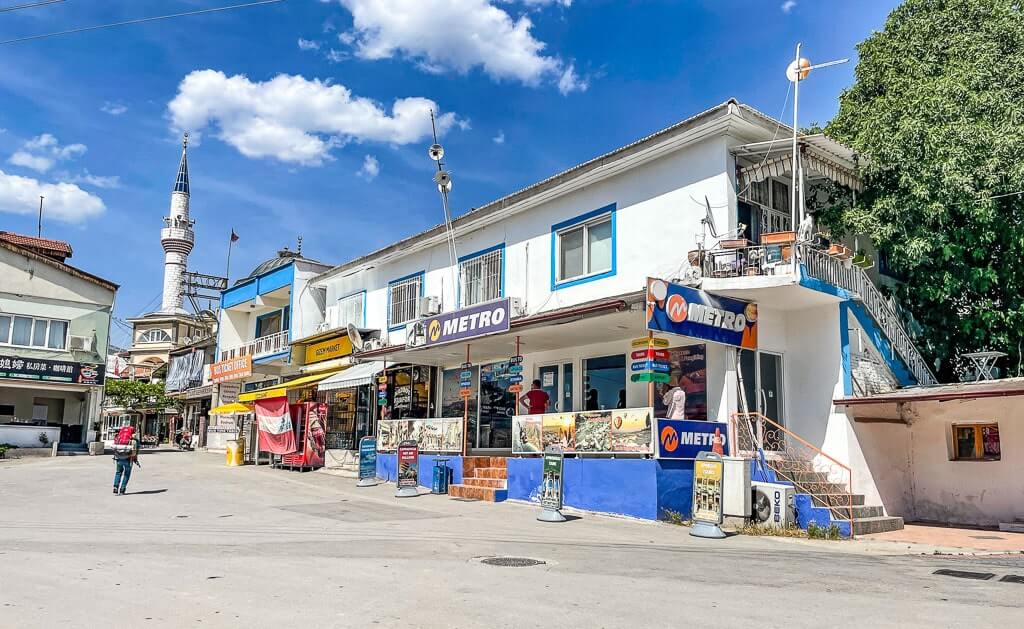
You can also rent a car and drive to Pamukkale from Denizli or Izmir. The drive from Denizli takes about 15 minutes. If you are coming from Izmir, Kusadasi, or Antalya, be sure to leave early in the morning so that you can reach by 9:00am and can spend a nice long day at Pamukkale. On an average, car journeys from these places can take a good 3-4 hours.
If you are not comfortable about driving in Turkey, then it is a good idea to join a full day tour to Pamukkale from any of these cities. Here are a few good choices.
Best tours of Pamukkale Turkey
- From Antalya : Full-day Pamukkale and Hierapolis tour with lunch . With 250+ great reviews, this is one of the most popular Pamukkale day tours in the market.
- From Izmir/Selcuk/Kusadasi: Pamukkale & Hierapolis full-day tour .
- From Istanbul: Pamukkale day tour with flights and transfers. This tour makes it possible to see Pamukkale on a day trip from Istanbul.
Getting around Pamukkale Turkey
The best way to get around Pamukkale is by foot. On the travertines, you’ll have to walk barefooted (shoes not allowed) – be careful sometimes the calcite floor can be slippery.
The ruins of Hierapolis are quite spread out. Walking is a great way to explore them because you’ll be able to go closer to each and every monument and check it out in detail. However, it is true that the sun can be harsh here during the day. It literally sucks the life out of you.
If you are feeling tired, you can make use of the mini buses that run between the North Gate and the museum (not so frequently though) or hire an electric bike (one of you will have to ride it and two people can sit behind). There’s a bike rental kiosk right in front of Cleopatra’s pool and you’ll need to bring the bike back and return it at the same point. However, the cost for the bike was preposterous. I think they asked us for something around 300 TL for an hour. We chose to walk!
There are two places where you’ll need to walk uphill – the walkway through the travertines and the road to the amphitheater. Rest is all level ground.
Travel tips for visiting Pamukkale Turkey
- You are not allowed to walk on the travertine terraces with your shoes/slippers on. You have to walk barefoot. So, carry a plastic bag to store your shoes when you are at the terraces. We made a mistake of not carrying any bag and had to hold our shoes all the time. It, surely, reduces your mobility.
- Please do not eat or drink when walking on the travertines and please make sure that you leave no trash behind.
- The best time to be on the white cliff is later in the afternoon when the crowd starts thinning and the pools are filled with water. If you stay long enough, you’ll be able to catch a mesmerizing sunset too.
- Early morning is not a great time to photograph Pamukkale’s travertine pools. That is because the sun rises behind the cliff and the pools are mostly in shadow. Because the pools face west, sunset is always a better time for photography here.
- Tour groups start coming in around 9:00am and leave at 3ish in the afternoon. They usually start exploring from the top of the plateau which means you’ll always find the lower pools relatively emptier.
- If you want to come in at the earliest possible hour, enter through the South Gate which opens at 6:30am. The other two open after 8.
- Toilets are available at several spots in the Hierapolis archaeological area. There is one in the Antique Pool compound too.
Pamukkale Turkey travel FAQ
Is pamukkale worth visiting.
Yes, Pamukkale in Turkey is totally worth visiting. One of the most beautiful places in Turkey, Pamukkale is home to a unique landscape of travertine terraces and petrified waterfalls, the ancient Greco-Roman spa town of Hierapolis, a majestic Roman amphitheater, and antique healing pools from the times of Cleopatra.
Can you swim in Pamukkale?
You can swim at three different places in Pamukkale . First, the clear antique pools of Cleopatra which are said to possess medicinal properties. Second, the white, calcium-rich waters of the travertine where you can soak in – the pools are shallow, so not much swimming to be done. Third, the swimming pools at Pamukkale Natural Park which are at the bottom of the hill and artificially made.
Is Pamukkale expensive?
No, Pamukkale is not expensive. Except for the entrance fees which is 200 TL (11 USD/EUR) at the moment and goes up every month, everything else including food, accommodation, and commuting is pretty much affordable.
What is Pamukkale known for?
Pamukkale is known for its unusual landscape of white limestone terraces filled with mineral-rich waters. Thousands of years of volcanic activity below the earth surface and a special mixing of water with calcium has given rise to Pamukkale’s remarkable scenery.
Is Pamukkale a day trip?
Yes, Pamukkale can be done as a day trip from several destinations such as Izmir , Antalya , and Istanbul .
How should I dress for Pamukkale?
You can dress in shorts, dresses, or light pants for Pamukkale. Anything that is made of cotton or breathable material works because it is going to be super hot during the day in Pamukkale (not in winters, though). Be sure to carry your swimsuit if you plan to get into the travertine pools or Cleopatra’s antique pool.
Is Pamukkale the same as Hierapolis?
No, Pamukkale is not the same as Hierapolis. Pamukkale is a white calcite hill in southwestern Turkey that is filled with thermal springs, travertine pools, and petrified cascades. Hierapolis, on the other hand, is the name of an ancient Greco-Roman city that was built as a spa town on top of the Pamukkale hill.
Loved our Pamukkale Turkey bucket list? Pin it for later!
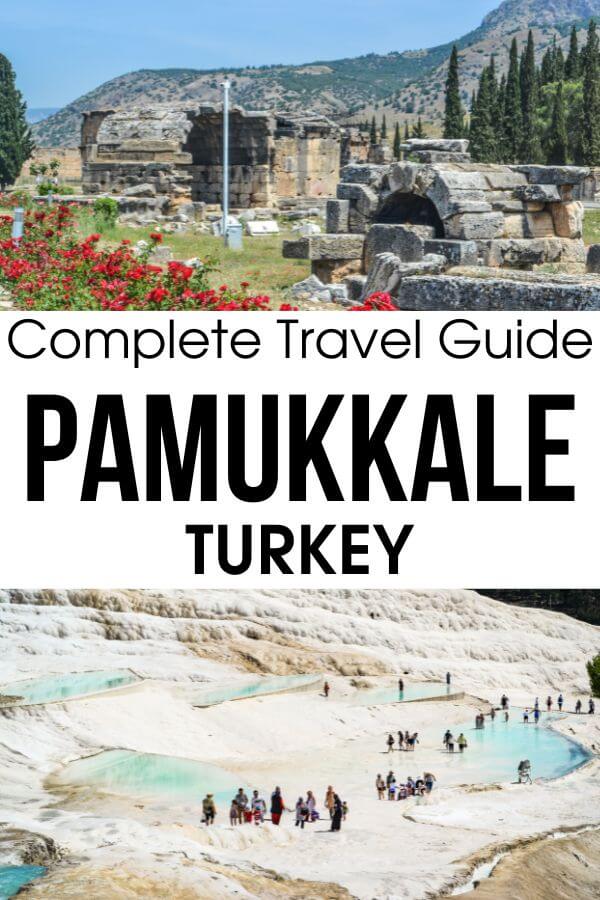
You may also like:
- 18 Best Things To Do In Selcuk Turkey - The Ultimate…
- Visiting The Ruins Of Ephesus Ancient City: A…
- 15 Best Things To Do In Alacati Turkey In 2024
7 thoughts on “ 13 Best Things To Do In Pamukkale Turkey: A Complete Travel Guide ”
Dear Soumya,
Thanks a lot for sharing such a detailed article, including prices, timings, transport services, small tips like “west facing pools, less water in morning so plan in 2nd half”, etc. which actually make a huge difference ! I am sure this would be really helpful to plan my trip. Will explore your other blogs too 🙂
Best wishes, Shilpa
Glad you found this Pamukkale blog helpful, Shilpa. Hope you have an amazing trip to Turkey.
Leave a Reply Cancel reply
Your email address will not be published. Required fields are marked *
Post Comment
This site uses Akismet to reduce spam. Learn how your comment data is processed .
Begin typing your search term above and press enter to search. Press ESC to cancel.
- Search Search Search …
- Search Search …

Visit Pamukkale Guide
Turkey’s most well-known tourist attraction has been enticing travelers to visit for centuries, despite the fact that it is little known outside the country. Pamukkale’s sparkling white travertine terraces are stunning and empty at the right time of day. Right now, while you can’t visit Pamukkale in person, we’ve pulled together an awesome collection of drone coverage and books so you can explore Pamukkale virtually and plan for your future trip!
THIS POST MAY CONTAIN COMPENSATED AND AFFILIATE LINKS MORE INFORMATION IN OUR DISCLAIMER
Read about the history of Pamukkale, understand what has made these travertine terraces then use the rest of this article to plan your trip to Pamukkale!
#1 DAY tRIP

Take this Fabulous Pamukkale Trip
With full transport and an English-speaking guide, this is a super way to visit and explore Pamukkale. Head out for a fabulous time – but book early.
Pamukkale Turkey & History
The 17 thermal springs here have been bringing Spa visitors to the area for centuries. The limestone terraces are created by water flowing from calcium-rich springs down the hillside, forming into pools.

Pamukkale translates literally to “Cotton Castle” in Turkish, homage to a local legend. This myth details that the terraces are actually a waterfall made from cotton (which is the principal crop of the local area), which was left out to dry by giants in years gone by.
Over the years roads and hotels were built in and on the ruins to “maximize” the tourist experience in Pamukkale. At one point you could even ride a motorbike over the terraces! Water was diverted to the hotels for their pools. This has since stopped. Hotels have been demolished and water supply is strictly regulated.
Our Pamukkale Travel Guide books while we’re visiting the Pamukkale terraces, Turkey.
The site of Hierapolis-Pamukkale was recognized as a UNESCO World Heritage site in 1988. Read about our visit to the Hierapolis Greco-Roman Ruins at the top of the travertines of Pamukkale.
Pamukkale Fact: Pamukkale is twinned with Las Vegas, USA!

How Big is Pamukkale?
The terraces stretch over an area that is 2.7 kilometers long by 0.6km wide and 160 meters high. It can be seen from 20 kilometers away in the area’s major city, Denizli. Many of the terraces are now no longer accessible, having been damaged by millennia of tourist tramping across them.
How were the Pamukkale Terraces Formed?
Hot water springs in the area emerge at the top of the terraces and leave calcium carbonate deposits as the water makes it’s way down to the bottom of the hill. As the water reaches the air, the calcium carbonate is deposited. At this point, the calcium carbonate is soft, it solidifies into travertine. The water is between 35 degrees centigrade and 100 degrees centigrade when it starts its journey.

It is underground volcanic activity that creates the hot springs. This activity is also responsible for the appearance of carbon dioxide in the cave in the ruins of Hierapolis called the Plutonium. The cave was used by priests who discovered ways of avoiding the deathly gas and used it for religious purposes.
If you like hot springs, then you’ll love our guide to the best hot springs in Korea.
Does Pamukkale really look like the guidebook and Instagram photos?
In a word. No. Certainly not when we were there. How the pools look depends on the time of year that you visit and the weather conditions. Plus, of course, there are the crowds. Is Pamukkale worth the trip? Yes, but you should plan your visit to the Pamukkale hot springs carefully to ensure you make the most of your time here.

How to Visit Pamukkale In Person
Take a day trip to pamukkale.
Most visitors come on a day trip from the coast. We strongly recommend that you don’t do this. 2 million visitors a year means on average 5,500 a day. Most of them visit on a day trip like this. It means that you’ll all arrive at the same time and leave at the same time. Pick a Turkish company like One Nation Travel and you’ll benefit from local knowledge and expertise too.
If nothing else the queue to get in through the ticket gate will drive you insane. If, however, you have no other choice, then consider the time that you will spend getting here and perhaps add in a visit to surrounding locations too. That’s why organizing a tour to Pamukkale might save you a whole heap of time.

Make a Day Trip to Pamukkale from Denizli
Stay overnight in the biggest local town of Denizli and take a 40-minute minibus to Pamukkale first thing in the morning. The minibus will drop you at the lower gate entrance to the terraces (which is the best way to enter). You’ll still get here before the majority of the visitors. Head for a late lunch as the hordes arrive and then take a leisurely minibus back to Denizli.
The Best Way to Visit Pamukkale
You must remove your footwear when visiting the Pamukkale travertine terraces. There are no lockers, so you’ll need to carry shoes with you. If you’re planning on visiting the ruins of Hierapolis, then you’ll need to bring footwear. Bring additional clothing other than your swimwear if you’re planning a dip in the Pamukkale pools might be useful to cover up for exploring the ruins, although there are no rules in place in Pamukkale. What to wear in Pamukkale is more about what you feel comfortable in and sun protection.
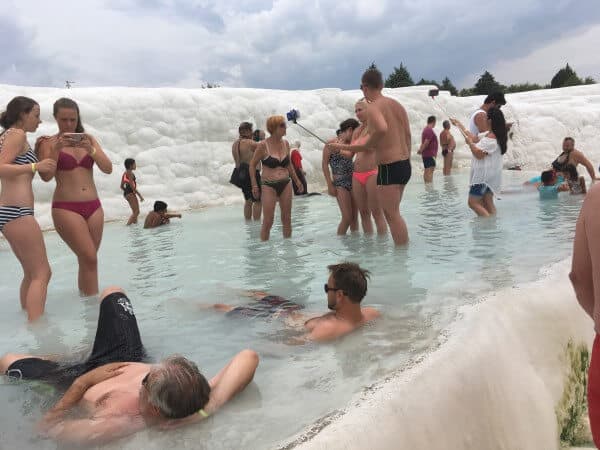
You’re not allowed to wear even sandals or flip-flops. Bare feet only to prevent the erosion and staining of the terraces.
Start at the bottom of the terraces – we recommend the Pamukkale south gate in the town. Walk up through the terraces, and explore Hierapolis. Eat a picnic lunch, or get refreshments at the café at the top, and make your way back down into the town. Tour buses drop groups off at the TOP gate of the site.

Pamukkale Opening Times
The Pamukkale opening hours of the terraces are from 0800 – 1700 from October to March. Pamukkale timings from April to October are from 0800 – 1900
10 Tips for Visiting Pamukkale
Check out our top 10 Pamukkale tips to answer the question is Pamukkale worth visiting.
- All visitors must be barefoot. This means no flip-flops or sandals.
- Take water with you. You can buy drinking water at the café and stands at the top, but it’s more expensive.
- Carry your footwear with you, if you plan to visit the ruins at the top. It’s rough underfoot, you may manage with flip-flops, but it can be a long hike to the far end of the ruins.
- There are no lockers at the lower gate, so everything you bring with you for the day you’ll have to carry for the day.
- Take a picnic if you plan to stay in the Pamukkale limestone terraces and their pools all day.
- If you want to take a dip – the waters aren’t deep, but you can certainly sit in them comfortably, then wear your swimwear under your clothes. While there are bathrooms at the café at the top of the terraces you’ll have to walk up there, then walk back down to get into the pools. We wore shorts and just paddled through the pools.
- If you struggle with the heat, take an umbrella, the sun reflects off the white terraces something rotten and your sunscreen will melt quickly! (be sure to wear some though!)
- You will need sunglasses – even on a dull day it is VERY BRIGHT
- Wear sunscreen.
- It is ok to wear bikinis and swimwear. You’ll spot many speedo-wearing torsos, which may cause you to avert your eyes.

How long does it take to visit Pamukkale?
How long to spend in Pamukkale depends on what you want to see and how you want to see it.
If you just want to see the travertine pools of Pamukkale, then walking to the top and returning will take about around 45-60 minutes. Longer if you want photos or a dip. You should definitely include a visit to Hierapolis, which is included in the Pamukkale price. We spent several hours at Pamukkale, most of that time exploring Hierapolis, which for us was one of the best things to do in Pamukkale.
Pamukkale Admission Fees
Tickets to get into Pamukkale last for the entire day and include your entrance to Hierapolis. The Pamukkale entrance fee is 60 TL. If you have an All Turkish Museum Pass (cost 375 TL) then your entrance is covered to this site as well. The Turkish Museum Pass also means that you can bypass the Pamukkale entrance line, simply walk to the front, scan your pass, and walk through. Buy a Turkish Museum pass and bypass the lines now – they can be painfully slow!

The Pamukkale thermal pool entrance fees do NOT include the entrance to the antique pool at the top of the terraces, which is 32 TL and its open from 0800 until 1730 (November through March) or 1930 (April through October).
Best Time of Day to Visit Pamukkale
The best time of day to plan your Pamukkale visit is either early in the morning or in the late, late afternoon. This isn’t just to avoid the heat of the day and the crowds, but also for better light for your photographs. The white calcite of the terraces drains all color. Most people (us included) arrive at Pamukkale in the afternoon. The second best time to go to Pamukkale is the late afternoon, which will be busier than the early morning visit. If you can stay overnight in Pamukkale then you’ll likely have the place to yourself in the early morning.

Best Time of Year to Visit Pamukkale
If you have a choice, when you come to Pamukkale the best time to visit Pamukkale is between April and June. In summer the whole area gets very, very hot and much busier. You may see snow if you visit in winter. Autumn is also more pleasant. If you’re visiting in the months of November through March then there are also fewer visitors. Avoid weekends if possible.
How to get to Pamukkale
We visited Pamukkale and Hierapolis en route from Ephesus to Ihlara and then Cappadocia. It was a small part of our overland trip from Istanbul to Kathmandu. Most people will visit Pamukkale as a day trip from beach resorts on the Med or Aegean seas.
CAR RENTAL IN TURKEY
Best Turkey Car Rental
If you need to rent a car in Turkey we recommend Discover Cars for car hire. You can search, compare and save up to 70%, with no hidden fees and free cancellation, it’s the perfect option! Get a price for a rental car in Turkey here.
Book a day trip to Pamukkale here! . It will take you 2 hours to drive from Antalya or Marmaris, or 5 hours from Bodrum. You can always rent a car and drive to Pamukkale yourself!

Pamukkale Maps
Take a look at our Pamukkale Turkey maps to see first of all to find out where is Pamukkale Turkey.

The map above shows where in Turkey Pamukkale is located. The map below shows where the historic sites of Pamukkale and Hierapolis are located with regard to the town of Pamukkale.
Pamukkale is a very small town, with the historic site of Pamukkale located at the edge of it. It’s impossible to get lost in Pamukkale. There are no Pamukkale tourist maps as you see the Pamukkale travertine terraces as soon as you arrive.

How to Go from Denizli to Pamukkale
There are several options for how to get to Pamukkale from Denizli. You can take a coach from Denizli, which is the closest city to Pamukkale. Denizli is 19 kilomtres from Pamukkale. Local buses from Denizli to Pamukkale take 20-30 minutes and cost 5 TL per person. Catch the minibus (Dolmus) from Denizli Otogar Bus Station at platform 76 on the lower level, below the intercity bus area. Minibusses seat about 20 people. Pick up the return bus from where you get dropped off. Check the return times with the driver as you get off.
A taxi from Denizli to Pamukkale will cost around 50 TL per person and will take around 20 minutes to complete the journey.
If you’re considering whether to stay in Denizli or Pamukkale – then accommodation is cheaper in Denizli than in Pamukkale. Check accommodation in Denizli here .
How to go from Istanbul to Pamukkale
To get to Pamukkale from Istanbul, unless you are driving, you will need to first get to Denizli. Driving time is about 8 hours, it is 620 kilometers. A bus journey time is about 12 hours and bus fares are about 80 TL. Buses go from Istanbul to Denizli, (and some go directly to Pamukkale) and then you will need to take the minibus from Denizli to Pamukkale. You can book your bus from Istanbul to Pamukkale here.
You can fly from Istanbul to Denizli in an hour. Check out 10 great reasons to visit Istanbul here.
How to get From Ephesus to Pamukkale
It is 190 kilometers from Ephesus to Pamukkale. This will take about 3 hours to drive. Again, if you wish to travel from Ephesus to Pamukkale by bus you will need to go via Denizli. Buses go from Ephesus – the town of Selcuk – to Denizli every day. The bus journey between Selcuk and Denizli takes about 4 hours and costs 30 TL. You can also take a taxi and book one here.
How to go from Cappadocia to Pamukkale
The distance from Cappadocia to Pamukkale is 530 kilometers. The drive to Pamukkale from Cappadocia takes 7-8 hours, or around 10 hours on an overnight bus. You will likely find a bus that goes directly, or via Denizli from MetroTurizm. Check buses and ticket prices to go from Cappadocia to Pamukkale here.
We visited Pamukkale on our Silk Road adventure, which began in Istanbul and headed toward Kathmandu. So far on the trip we’ve explored Gallipoli, Troy , and Ephesus. We’re heading to Cappadocia next!
Where to Stay in Pamukkale
There are some great places to stay in Pamukkale– here’s our pick of the luxury places to stay in Pamukkale, mid-range places to stay in Pamukkale, and budget accommodation in Pamukkale.
Pamukkale Whiteheaven Suite Hotel, Pamukkale: The Pamukkale Whiteheaven Suite Hotel is conveniently located centrally in Pamukkale. This top Pamukkale hotel’s rooms feature air-conditioning, a balcony, a flat-screen TV, a private bathroom with a shower and hairdryer, a coffee/tea maker, a seating area, and a complimentary WiFi connection. There are billiards, a game room, and an outdoor pool with a view here. This top Pamukkale hotel also has an in-house restaurant that serves local cuisine. The Pamukkale Whiteheaven Suite Hotel is a great luxury place to stay in Pamukkale . See rates and availability here.
Venus Suite Hotel, Pamukkale: The Venus Suite Hotel is located centrally in Pamukkale. This comfortable mid-range Pamukkale hotel has rooms with air-conditioning, a flat-screen TV, a balcony with a view of the outdoor pool, a private bathroom with shower and hairdryer, soundproofing, an electric kettle, and a mini-bar. An a-la-carte on-site restaurant is available and a daily buffet breakfast is also available. This excellent hotel in Pamukkale also has an outdoor pool, table tennis facilities, massage services, and a garden. The Venus Suite Hotel is perfect for a relaxing and luxurious stay. Check room rates and availability here.
Bellamaritimo Hotel, Pamukkale: The Bellamaritimo Hotel is situated centrally in Pamukkale. Rooms at the excellent value hotel in Pamukkale are equipped with a flat-screen TV, air-conditioning, a desk, a private bathroom with shower, hairdryer, and other toiletries, soundproofing, and iron and ironing board; selected rooms have views of either the pool or the mountains. This budget Pamukkale hotel also has a restaurant and bar, as well as an outdoor pool a garden, and an exercise area. The Bellamaritimo Hotel is a fantastic place to relax after a day exploring Pamukkale. You can look at dates and rates here.
Travel Tips for Exploring Turkey
- Considering travel insurance for your trip? World Nomads offers coverage for more than 150 adventure activities as well as emergency medical, lost luggage, trip cancellation and more.
- Get online immediately with an eSIM in Turkey
- Download and install a VPN BEFORE you travel to Turkey > discount coupon here
- Book the best tours and attractions in Turkey with GetYourGuide
- Book free Istanbul tours with Civitatis
- Save money in Turkey with a Wise debit card
- Book Buses in Turkey with Bookaway
- Book accommodation in Turkey with Booking.com
Final Words on Visiting Pamukkale
Pamukkale is a stunning site to visit. The pools are spectacular, and the walk up through them is interesting, especially to Hierapolis at the top. It’s best to go earlier or later in the day for the best light.
Stock images in this article are courtesy Deposit Photos.
We receive a fee when you get a quote from World Nomads using our affiliate links. We do not represent World Nomads. This is not a recommendation to buy travel insurance.
ASocialNomad is a participant in the Amazon Services LLC Associates Program, an affiliate advertising program designed to provide a means for sites to earn advertising fees by advertising and linking to amazon.com, amazon.co.uk, and amazon.ca. Amazon and the Amazon logo are trademarks of Amazon.com, Inc. or its affiliates. As an Amazon Associate, I earn from qualifying purchases .
Sarah Carter
Leave a comment cancel reply.
Your email address will not be published. Required fields are marked *
Save my name, email, and website in this browser for the next time I comment.
3 thoughts on “ Visit Pamukkale Guide ”
- 3 comments
Hi Sarah, I enjoyed reading your comprehensive desciption on Parmukkale. Thanks! However I have a few questions regarding the Dolmus bus opearting from the Denizli Otogar Bus Station to Parmukkale that I hope you may be able to shed some light.
1) It is stated the bus stop at the North entrance (from some other site info) and this is start right at the upper level. If I like to start from the bottom nearer to the town entrance, where is the nearest entry point? Does the Dolmus bus stops near this entry point and if yes how should I flag them to stop? Is this a separate Dolmus nus taken from the Denizli Otogar Bus Station or the same bus drops you off in town? 2) Do you know the last Dolmus bus leaving Parmukkale and Denizli respectively in the winter months of December?
Appreciate your sharing. Thanks!
Best Regards Richard
If you take a look at Google Maps then the lower entrance to Pamukkale is opposite the “white Dragon Chinese and Turksih cuisine” – the easiest way to get off is to just ask the driver to stop. Bus stops for Dolmuses are more about the passenger waving to get on, or shouting to get off! I’m afraid I don’t know the last time of the bus back, but the easiest way is just to ask when you get the bus there.
Thank You Sarah!
Privacy Overview
Pamukkale Travel Guide
Book your individual trip , stress-free with local travel experts
Select Month
- roughguides.com
- Travel guide
- Itineraries
- Local Experts
- Travel Advice
- Accommodation
Plan your tailor-made trip with a local expert
Book securely with money-back guarantee
Travel stress-free with local assistance and 24/7 support
As you approach the UNESCO World Heritage Site of PAMUKKALE from Denizli, 20km south, a long white smudge along the hills to the north suggests a landslide or mine. Getting closer, this clarifies into the edge of a plateau, more than 100m above the valley and edged in white travertine terraces . The Turks have dubbed this geological fairyland Pamukkale , or “Cotton Castle”. This incredible natural phenomenon was created by the hot spring waters that gush up at the centre of the ancient city of Hierapolis , whose blissfully located ruins would merit a stop even if they weren’t coupled with the stunning terraces.
Aphrodisias
Bathing in pamukkale’s springs.
Only a fraction of the huge number of daily visitors to Pamukkale stay the night. Most foreign travellers who do so stay in PAMUKKALE KÖYÜ , a sleepy village at the base of the cliff that’s still, by and large, a rural settlement – you’ll see more tractors than cars on its outskirts, and its main “drag” holds only a small concentration of shops, restaurants and travel agencies. Accommodation is cheap, and almost all hotels feature spring-water swimming pools. Despite the incredible draw of Hierapolis and the travertines, it’s one of western Turkey’s best places to chill out for a few days.
Brief history
The therapeutic properties and bizarre appearance of the hot springs were known for thousands of years before an actual town, Hierapolis , was founded here by a Pergamene king during the second century BC. After incorporation into the Roman Empire in 129 BC, Hierapolis enjoyed considerable imperial favour, especially after catastrophic earthquakes in 17 AD and 60 AD – no fewer than three emperors paid personal visits, stimulating local emperor-worship alongside the veneration of Apollo and his mother Leto, who was venerated in the guise of Cybele.
The presence of a flourishing Jewish community aided the rapid and early establishment of Christianity . Hierapolis is mentioned in Paul’s Epistle to the (neighbouring) Colossians, and Philip the Apostle was martyred here, along with his seven sons. However, as at Aphrodisias, paganism lingered well into the sixth century, until a zealous bishop supervised the destruction of the remaining ancient worship sites and the establishment of nearly one hundred churches, several of which are still visible.
Hierapolis slid into obscurity in late Byzantine times, nudged along by Arab and Turcoman raids. After the Selçuks arrived in the twelfth century, the city was abandoned, not to figure much in the Western imagination until Italian excavations began in 1957.
Travel ideas for Turkey, created by local experts

Sensational landscapes of Cappadocia
3 different modes of transportation to explore Cappadocia - by hot air balloon, on the back of a camel as well as on an ATV quad. Why choose if you can have it all? Four days filled with fun and adventure in the volcanic valleys around Cappadocia make an unforgettable trip.

City & culture - Istanbul and Cappadocia
Explore two absolute highlights in Turkey - Istanbul, the former capital of the Ottoman Empire with its many landmarks. After a few days in the city, fly to Cappadocia and explore the surreal surroundings, either on day tours or from above in a hot air balloon.

Magical Turkey
Visit Gobekli Tepe and Mount Nemrut in Southeastern Anatolia before proceeding to Cappadocia with its volcanic scenery. After a few days in the valleys, continue to Pamukkale and the ancient city of Ephesus. Your tour starts and ends in Istanbul.

Delightful Turkey
A fast-paced itinerary for those who want to discover as much as of Turkey as possible in under one week. Highlights include the Old Town of Istanbul, the valleys of Cappadocia, the birth of Sufism and the historical city of Ephesus.

Cultural Turkish Odyssey
Embark on a 22-day journey through Turkey's rich tapestry of culture and history. From Istanbul's enchanting blend of Asia and Europe to ancient wonders, coastal gems, and the captivating landscapes of Cappadocia, this tour immerses you in the treasures of Turkey.

Discovering Turkey
Discover Turkey's treasures in 10 unforgettable days. Explore Istanbul's heritage, walk the ancient streets of Ephesus, and soak in the natural wonders of Pamukkale and Cappadocia. An epic journey through history, culture, and breathtaking landscapes awaits.
Situated on a high plateau over 600m above sea level, ringed by mountains and watered by a tributary of the Büyük Menderes, Aphrodisias is one of Turkey’s most isolated and beautifully set archeological sites. Acres of marble peek out from among the poplars and other vegetation that cloaks the remains of one of imperial Rome’s most cultured Asian cities. Late afternoon visits have the bonus of often dramatic cloud formations, spawned by the elevation, and the attendant dappled lighting.
It’s quite easy to find your way around – most of the site’s main features are accessible on a path that loops around the complex, maps are dotted around, and all signage is in English as well as Turkish. In general, it’s best to follow a clockwise route, which will allow you to finish your visit in the air-conditioned cool of the museum. What’s more, that route means that the short climb to the theatre will come when you’re fresh, at the start, rather than adding to the sweat at the end.
Aphrodisias was one of the earliest occupied sites in Anatolia. Neolithic and Bronze Age mounds have been found here, and there has been some sort of fertility cult here for just as long. The Assyrian goddess of love and war, Nin, became meshed with the Semitic Ishtar, with the Hellenic Aphrodite eventually assuming the goddesses’ combined attributes.
Despite a strategic position near the meeting point of ancient Caria, Lydia and Phrygia, and its proximity to major trade routes, for many centuries Aphrodisias remained only a shrine. However, during the second century BC, its citizens were rewarded for their support of the Romans during the Mithridatic revolt. Imperial favour bestowed, various emperors patronized the burgeoning city. Aphrodisias became particularly renowned for its school of sculpture, sourcing high-grade marble from nearby quarries, and local works soon adorned every corner of the empire, including Rome itself.
Perhaps because of this fixation with graven images, paganism lingered here for almost two centuries after Theodosius banned the old religions. The reputation of its Aphrodite love cult had served to protect Aphrodisias since its inception, but by the fourth century AD, two earthquakes and sundry raids began to take their toll, and decline was the dominant theme of Byzantine times. The town was abandoned completely during the thirteenth century, its former glories recalled only by the Ottoman village of Geyre – a corruption of “Caria” – among the ruins.
Only since 1961 has work by a New York University team permitted a fuller understanding of the site. The intention is to render Aphrodisias on a par with Ephesus and the eventual results will certainly be spectacular, though for now some of the more interesting areas remain off-limits.
Pamukkale’s spring waters have seduced visitors for thousands of years – including certain Roman emperors. You can follow in their imperial footsteps by bathing in the waters today. Three different options are available. For the first, you don’t even have to leave town: just off the main road, the Natural Park (24hr; free) is a new complex set around a lake. Natural attractions here include piped music and swan-shaped pedalos whose LEDs glow at night, as well as a couple of fake travertine terraces – whatever, the water is real enough, and the park is actually a nice place to spend the evening. The second option is also free, once you’ve bought your ticket to Hierapolis – as you head up the travertine paths , you can wade in the pools on the way.
However, if you want to take a proper bath in the springs, visit the Pamukkale Thermal Baths up on the plateau (daily 8am–7.30pm; TL30), which encloses the sacred pool of the ancients, with mineral water bubbling from its bottom at 36°C. Changing rooms are available, as are drinks and snacks – many visitors choose to relax by the pool, coffee in hand, for an hour or more.
The Rough Guides to Turkey and related travel guides
In-depth, easy-to-use travel guides filled with expert advice.

Find even more inspiration for Turkey here

Planning your own trip? Prepare for your trip
Use Rough Guides' trusted partners for great rates
written by Rough Guides Editors
updated 26.04.2021
Ready to travel and discover Turkey?
Get support from our local experts for stress-free planning & worry-free travels.
- Travel advice
- Where to stay
Unveiling Pamukkale: Your Ultimate Travel Guide to Turkey’s Cotton Castle

Steeped in rich history and breathtaking natural beauty, Pamukkale stands as a testament to nature’s artistry. In this comprehensive pamukkale travel guide, you’ll embark on an enlightening journey to Turkey’s “Cotton Castle,” where ethereal white terraces cascade down the mountainside. Whether you’re a history buff, wellness seeker, or simply in awe of natural wonders, Pamukkale promises an unforgettable experience. As we peel back the layers of time and myth, prepare to be captivated by the serenity and charm of this geological marvel, ensuring your visit is as seamless and enriching as possible.
Discovering Pamukkale: A Natural Wonder
Embarking on a journey to Pamukkale, a gem in Turkey’s treasure chest of natural wonders, is like stepping into a dreamscape. In this pamukkale travel guide section, we unveil the ethereal beauty that awaits at this stunning location.
Pamukkale, aptly known as “Cotton Castle” in Turkish, is a unique geological formation famed for its picturesque white terraces. These terraces are not snow, as they may appear from a distance, but are formed from travertine, a type of limestone deposited by mineral-rich thermal waters.
Why Pamukkale is a Must-Visit:
- Thermal Pools : The terraced pools, filled with warm, milky blue waters, offer an otherworldly bathing experience.
- Breathtaking Vistas : With its cascading waterfalls and terraces that look like fluffy clouds, the landscape is truly scenic.
- Photographic Paradise : Photographers find inspiration in its beauty, which shifts with the day’s changing light.
- UNESCO World Heritage Site : It’s not just a natural wonder, but also a place of historical and cultural significance.
As you plan your visit, remember to include this wonder in your itinerary through this essential pamukkale travel guide . Whether you’re a nature enthusiast, history buff, or simply in search of tranquility, Pamukkale promises a sublime encounter with nature’s artistry.
Moreover, it’s important to note the delicate nature of these formations. They require preservation efforts, so visitors are encouraged to explore responsibly, ensuring that Pamukkale continues to mesmerize travelers for generations to come.
In the next sections of our pamukkale travel guide , we’ll explore more about the rich history, travel tips, and the overall experience. Stay tuned, as each portion of this guide is designed to provide you with comprehensive knowledge to make your visit as memorable as possible.
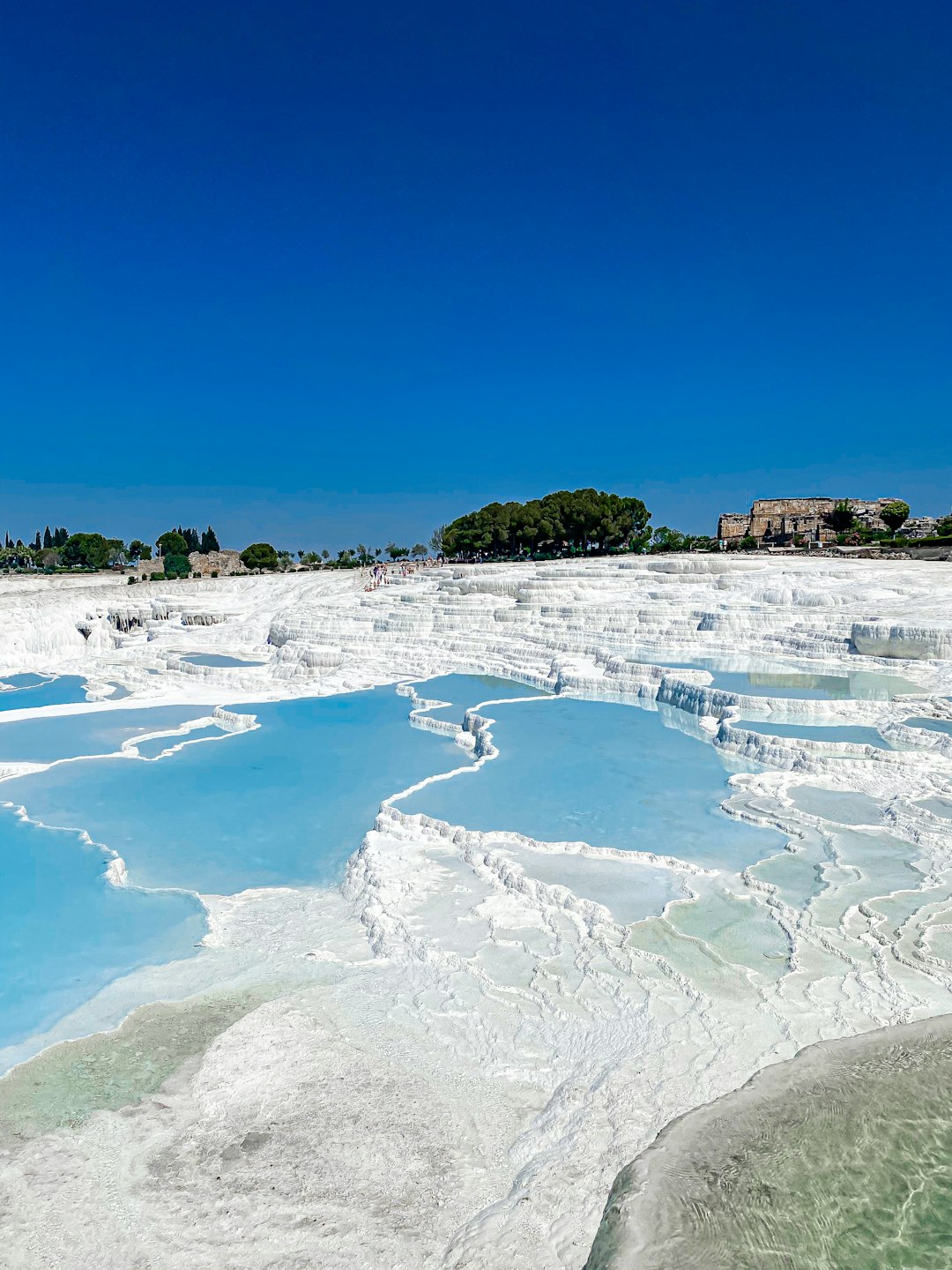
The History and Mythology of Cotton Castle
Delving into history, Pamukkale, which translates to “Cotton Castle” in Turkish, is as rich in storytelling and legends as it is in beauty. This stunning natural wonder of terraced hot springs has been a focal point for civilization and mythical tales for the last two millennia, making it an integral part of any Pamukkale travel guide .
Origin and Historical Significance: The formation of Pamukkale’s white travertine terraces began when warm, calcium-rich mineral water bubbled up from the earth and cascaded down the hillside, cooling and depositing as it flowed, giving rise to the dazzling white terraces that have drawn visitors from around the world. Across the ages, this site has drawn the attention of many, from ancient kings to modern travelers.
Mythological Roots:
- Apollo and the Prophecy : It is believed that the ancient city of Hierapolis, adjacent to Pamukkale, was founded by the god Apollo and named after Hiera, the wife of the founder of Pergamum. The area was known for its temple and oracle, reminiscent of Delphi, hinting at the divine belief that the waters had a connection to prophecy and the gods.
- Thermal Springs and Nymphs : A favorite story woven into the lore of Pamukkale involves the nymphs bathing in the warm, therapeutic pools. These mythical beings were said to restore their vitality in the mineral-rich waters, a tale that underscores the historic belief in the healing properties of the hot springs.
Cultural Heritage: Pamukkale has been a UNESCO World Heritage Site since 1988, not solely due to its unique geological formations, but also its historical significance. The Greco-Roman city of Hierapolis was established here, taking advantage of the hot springs. Remnants of baths, temples, and other structures around the site tell of a rich cultural past that intermingles with the natural beauty of the terraces.
In any thorough Pamukkale travel guide , exploring the history and mythology associated with Cotton Castle are as much a part of the experience as witnessing its physical splendor. Here, travelers find themselves walking through layers of time, where each step along the travertine reflects a piece of the past, draped in legend and captivating human history.
Travel Tips Before You Go: Planning Your Visit
When preparing for a trip to Turkey’s stunning natural attraction, known as Cotton Castle, a comprehensive Pamukkale travel guide can prove indispensable. Here are a few travel tips to consider before you embark on your journey:
- Best Time to Visit : The ideal time to visit Pamukkale is during the shoulder seasons of spring (April to June) and fall (September to November). The weather is mild, and the site is less crowded compared to the high season in summer.
- Entrance Fees : Be prepared for the admission fees. As of my knowledge cutoff in 2023, Pamukkale has an entrance fee that may change, so it’s a good idea to check the latest prices before your visit.
- Dress Appropriately : Comfortable footwear is a must as you’ll be walking on travertine terraces which can be slippery. Also, remember to bring a swimsuit if you intend to take a dip in the thermal pools.
- Staying Hydrated : Carry a reusable water bottle. There are water fountains on site, and staying hydrated is crucial especially during the hotter months.
- Photography : Don’t forget your camera – the travertine pools offer breathtaking photo opportunities, particularly at sunset.
Here’s a comparison table summarizing what to pack:
Lastly, be mindful of your timing. Pamukkale can get particularly busy, so arriving early in the morning or later in the afternoon can help you avoid the largest crowds. This is especially true if you’re looking to capture unobstructed views and have a more peaceful experience exploring the terraces.
By following these tips from your Pamukkale travel guide, you’re set for an enjoyable and hassle-free visit to one of Turkey’s most enchanting destinations.
Exploring the Terraces: What to Expect at Pamukkale
Pamukkale, known colloquially as the “Cotton Castle” of Turkey, is a spectacle of nature’s artistry, attracting visitors worldwide. As you prepare to explore its terraces, this section of our Pamukkale travel guide will highlight what you can anticipate during your visit.
Once you set foot on the site, the stark white travertine terraces unfold before you, layered like a cascading waterfall frozen in time. The terraces are made of carbonate minerals left by flowing thermal spring water, which have created an expanse of billowing patterns.
Here’s what to keep in mind as you traverse this natural wonder:
- Thermal Pools : Be sure to dip your feet into the warm, mineral-rich waters that fill the terraces. These pools vary in depth and offer a surreal experience as you wade in them against the backdrop of the Turkish landscape.
- Footwear Rules : To preserve the delicate travertines, you’ll need to remove your shoes before walking on the terraces. It’s a unique sensation to touch the warm, textured surface with bare feet but remember to tread lightly.
- Photography : The terraces provide a breathtaking setting for photos, especially at sunset. However, be respectful and avoid setting up tripods or staging photoshoots in restricted areas.
Moreover, during your exploration, you may notice the careful balance that’s maintained to preserve this natural site:
By observing these regulations, you play a part in safeguarding Pamukkale’s beauty for the years to come.
Embarking on a journey through the terraces of Pamukkale is an unforgettable experience. Taking in the geological artistry and therapeutic qualities of the springs, your visit will surely be a highlight of your travels in Turkey. Keep this Pamukkale travel guide handy to make the most of your expedition among the clouds of the Cotton Castle.
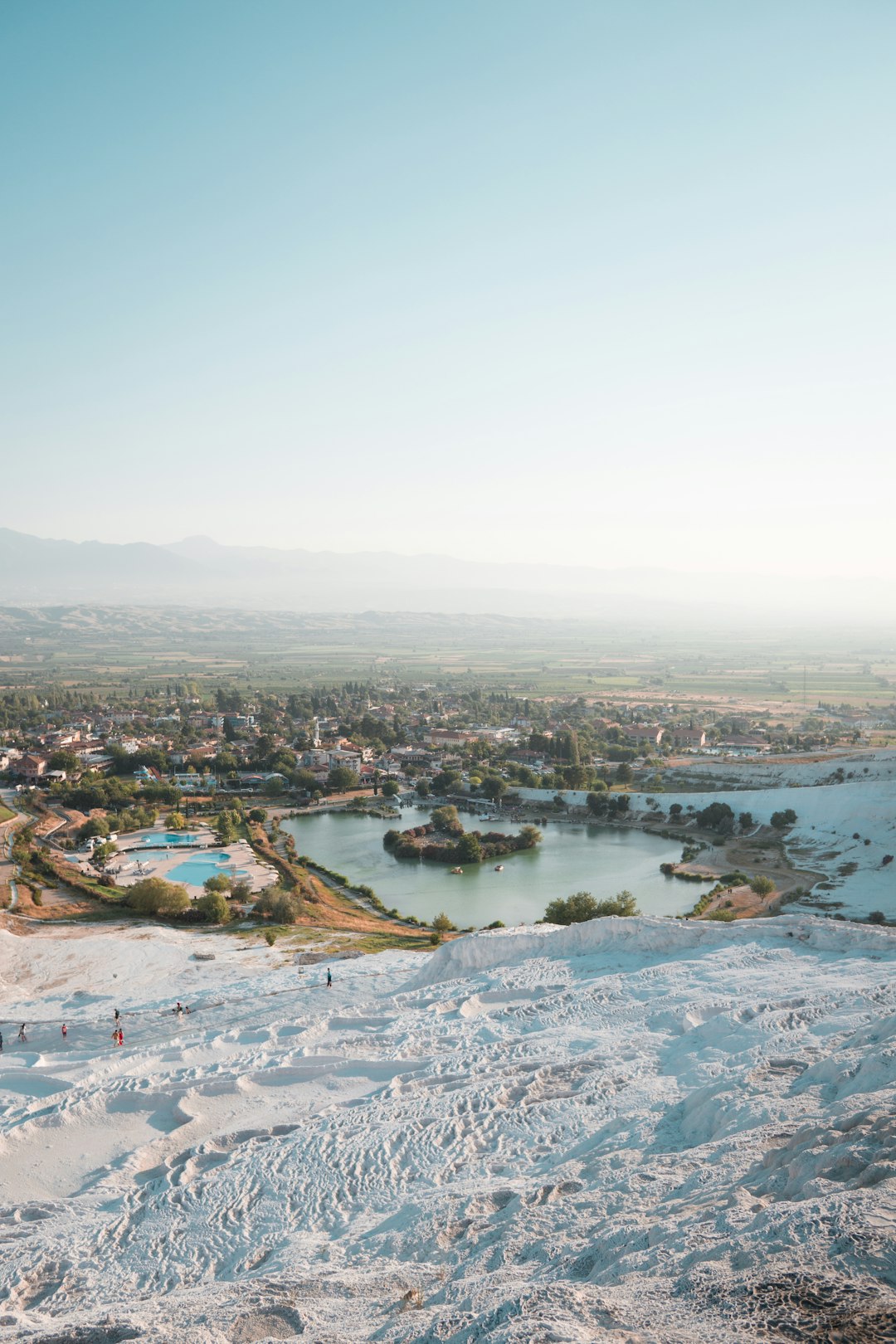
Pamukkale’s Thermal Waters: Health Benefits and Healing Properties
As any seasoned pamukkale travel guide will tell you, the thermal waters of Pamukkale are not just a feast for the eyes; they have been renowned for their healing properties since ancient times. Here’s a glimpse into how these natural hot springs can contribute to your well-being:
- Skin Health : The mineral-rich waters are believed to help improve skin conditions, such as eczema and dermatitis. The waters’ soothing effects may also aid in reducing inflammation and nourishing the skin.
- Circulatory System : Immersing in the warm waters helps to stimulate blood circulation, which can be beneficial for heart health and lowering blood pressure.
- Musculoskeletal Problems : If you suffer from arthritis or rheumatism, the thermal waters could provide relief. The warm temperatures and minerals may help to relax muscles, reduce stiffness, and ease pain.
- Detoxification : Bathing in these famous terraces might assist in the body’s detoxification process by promoting sweating and the release of toxins.
- Stress Reduction : Beyond the physical benefits, there’s a soothing aspect to the geothermal waters of Pamukkale that can help reduce stress. The serene environment and the act of bathing itself can be meditative and calming to the mind.
While these benefits are widely regarded by visitors and local lore, it’s always important to approach natural remedies with a balanced perspective. Consulting with a healthcare provider before seeking thermal treatments for specific health conditions is recommended. Nonetheless, the allure of healing waters is a timeless draw for travelers, adding another layer of enchantment to the Pamukkale experience as detailed in this pamukkale travel guide.
Beyond the Terraces: Hierapolis Ancient City and Its Attractions
At the heart of Pamukkale’s allure lies not only its ethereal white terraces but also the rich historical tapestry of Hierapolis Ancient City. As integral to your journey as the natural wonders themselves, Hierapolis offers a captivating glance into the past, making it a must-see for every traveler. Here’s what your Pamukkale travel guide should not miss when it comes to exploring this ancient treasure:
- The Hierapolis Theatre : This well-preserved theatre boasts a capacity of 15,000 spectators. Its grandeur and intricate details stand as a testament to the artistry and engineering of the past.
- The Necropolis : Amongst the largest ancient cemeteries, the Necropolis is a striking collection of sarcophagi, offering profound insight into the diverse burial customs of different periods.
- Cleopatra’s Pool : Immerse yourself in legend as you swim in the thermal waters over ancient ruins, reputedly a gift from Marc Antony to Cleopatra.
- Hierapolis Archaeology Museum : Housed in the former Roman baths, the museum presents a fascinating array of artifacts and provides context to the city’s sprawling history.
Despite the undeniable ravages of time, Hierapolis—once a storied spa city—continues to capture the imaginations of visitors from across the globe. Its attractions combine seamlessly with the geological marvels of Pamukkale, making the inclusion of Hierapolis in your travel plans not just an option but an indispensable chapter of your journey.
Your pamukkale travel guide ought to stress the importance of setting aside enough time to appreciate both the natural and man-made marvels. With each step on its ancient stones, visitors walk along the very paths where history was once made, ensuring a rich and immersive experience that transcends the mere visual splendor of Pamukkale’s terraces.
Accommodation Options Near Pamukkale: Staying Comfortably
When planning your visit to one of Turkey’s most spectacular natural wonders with the help of this pamukkale travel guide , finding the perfect place to stay is crucial for a comfortable and enjoyable experience. Pamukkale offers a range of accommodation options to suit various budgets and preferences. Here are some suggestions:
- Budget Hotels: For travelers looking to save on lodging, budget hotels provide basic amenities without sacrificing comfort. Most offer easy access to Pamukkale’s main attraction, the travertine terraces.
- Mid-range Inns: Ideal for those seeking a balance between cost and comfort, mid-range inns often feature additional facilities such as swimming pools, onsite restaurants, and more spacious rooms.
- Luxury Resorts: Pamukkale also caters to those desiring a touch of luxury. High-end resorts typically boast thermal pools, spa services, and exquisite rooms, elevating your stay to a memorable holiday.
- Boutique Accommodations: For an authentic and unique experience, consider boutique lodgings that reflect local charm and hospitality.
When selecting your accommodation, keep in mind the following:
- Proximity: Staying close to the Pamukkale Hierapolis Archaeological Park allows for effortless exploration. However, the town of Denizli, located 20 minutes away, is also a viable alternative.
- Amenities: Confirm whether the desired hotel offers amenities like free Wi-Fi, breakfast options, and travel assistance for local excursions.
- Reviews: Look at recent guest reviews to better gauge the quality of your potential stay.
Remember, this pamukkale travel guide isn’t just about the sights; it’s about ensuring a restorative retreat after a day of exploration.Booking in advance, especially during the peak tourist season, is highly recommended to secure your ideal accommodation.
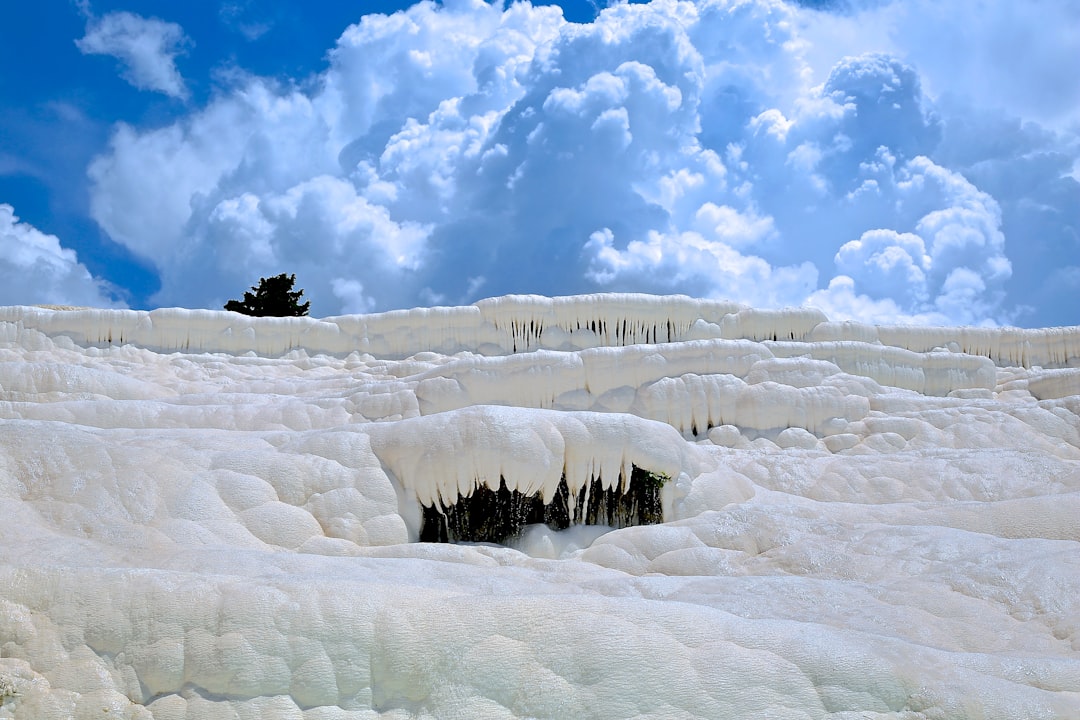
Dining in Pamukkale: Local Delicacies and Where to Find Them
When traveling through Pamukkale, a true taste of local culture is found not only in the stunning vistas but also in the rich flavors of its regional cuisine. To fully immerse yourself in the experience, let this Pamukkale travel guide walk you through the labyrinth of delectable local delicacies and where to partake in these culinary treasures.
Here are some must-try dishes and tips on finding the perfect dining spots:
- Gözleme : This savory traditional Turkish flatbread, filled with ingredients like spinach, cheese, or potatoes, is best enjoyed at small eateries where it’s made fresh in front of you.
Where to find it: Local bazaars and street-side vendors.
- Manti : Often referred to as Turkish ravioli, these tiny dumplings filled with minced meat and topped with yogurt and spices, can be savored at family-owned restaurants.
Where to find it: Traditional Turkish diners.
- Kebabs : A variety of kebabs, including the famous ‘Iskender’ kebab, are staples in Turkish cuisine and are available at most of the restaurants in Pamukkale.
Where to find it: Grill houses (kebapçılar) and diners.
- Baklava and Turkish Delight : For those with a sweet tooth, no Pamukkale travel guide would be complete without mentioning where to find these sugary delights.
Where to find it: Confectioneries and cafes.
- Opt for places that have a lot of local patronage; they’re likely to serve the best and most authentic dishes.
- Don’t hesitate to ask for recommendations from locals or your accommodation hosts—they’re often the best source for uncovering hidden culinary gems.
By integrating these delicacies into your itinerary, your visit to Pamukkale will be as much a feast for your palate as it is for your eyes. Remember, tasting the local cuisine is a gateway to understanding the heart and soul of the region. So delve into Pamukkale’s dining scene and let your taste buds lead the way to a memorable cultural experience.
Responsible Tourism: Preserving Pamukkale for Future Generations
As one of the most breathtaking natural sites in Turkey, Pamukkale has become a popular destination for travelers worldwide. Responsible tourism is key to preserving this unique location for future generations. When creating a pamukkale travel guide, it’s important to emphasize ways tourists can help maintain the beauty and integrity of these natural wonders. Here are a few responsible tourism tips to keep in mind:
- Stick to the Pathways : Pamukkale’s famous terraces are delicate structures. For their preservation, it’s essential that visitors stay on the marked pathways and avoid walking on the travertine pools.
- Respect the Natural Environment : Take nothing but pictures, leave nothing but footprints. Ensure that you dispose of waste properly and refrain from littering to keep the area clean and pristine.
- Support Sustainable Practices : Choose accommodations and tour providers in Pamukkale that are committed to sustainable tourism practices, thereby contributing to the site’s long-term preservation.
- Conserve Water : Even though Pamukkale is renowned for its water, it’s still a precious resource. Use it sparingly whenever you can, particularly in hotels and other facilities in the area.
- Educate Yourself and Others : Learn about the geological and historical significance of Pamukkale and share that knowledge with others to raise awareness about its conservation.
- Engage with Local Businesses : Opt to support local artisans and businesses that contribute to the local economy without exploiting the region’s resources.
By following these suggestions, each visitor can play a part in the conservation efforts of this incredible site. A pamukkale travel guide should not only showcase the splendors of the “Cotton Castle” but also encourage travelers to act as stewards of nature, ensuring that future travelers will have the same opportunity to experience the wonder of Pamukkale.
Ancient Secrets: Ultimate Ephesus Travel Guide for History Buffs
Bodrum travel guide: discover the exquisite charm of turkey's coastal jewel, related articles.

Discover the Enchanting Beauty of Turkey’s Black Sea Coast

Discover the Ultimate Malta Travel Guide for an Unforgettable Experience

Cyprus Travel Guide: Explore, Experience, and Embrace the Mediterranean Gem

Discover the Ultimate Dublin Travel Guide for a Memorable Experience
Leave a reply cancel reply.
Your email address will not be published. Required fields are marked *
Save my name, email, and website in this browser for the next time I comment.
Atlas & Boots
The UK's most popular outdoor travel blog
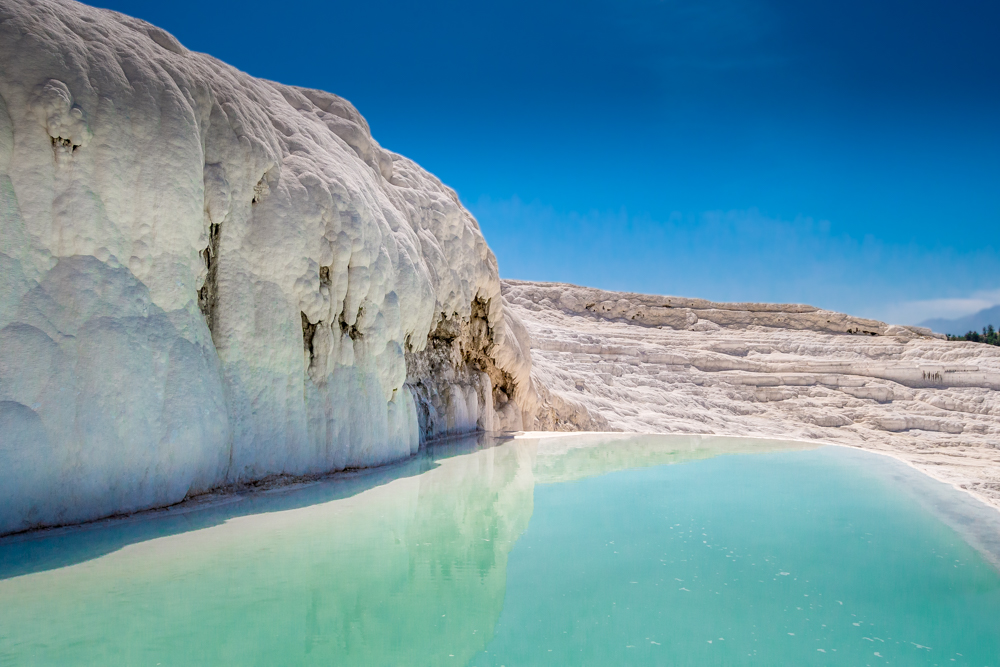
Visiting Pamukkale: tips to know before you go
Read our tips on visiting Pamukkale in Turkey, including what to wear, what to pack and what not to miss
Pamukkale, though Turkey’s most popular attraction by numbers, is barely known outside its country borders. It’s the iconic architecture of Istanbul and the cave dwellings of Cappadocia that steal the spotlight, but Pamukkale with its cascading travertine terraces deserves attention as well.
Sweeping limestone cliffs of a blinding white hue rise above pools of powder blue. Petrified stakes of limestone hang from chalky roots – like in Superman’s fortress of solitude or a Tim Burton nightmare if his nightmares were good.
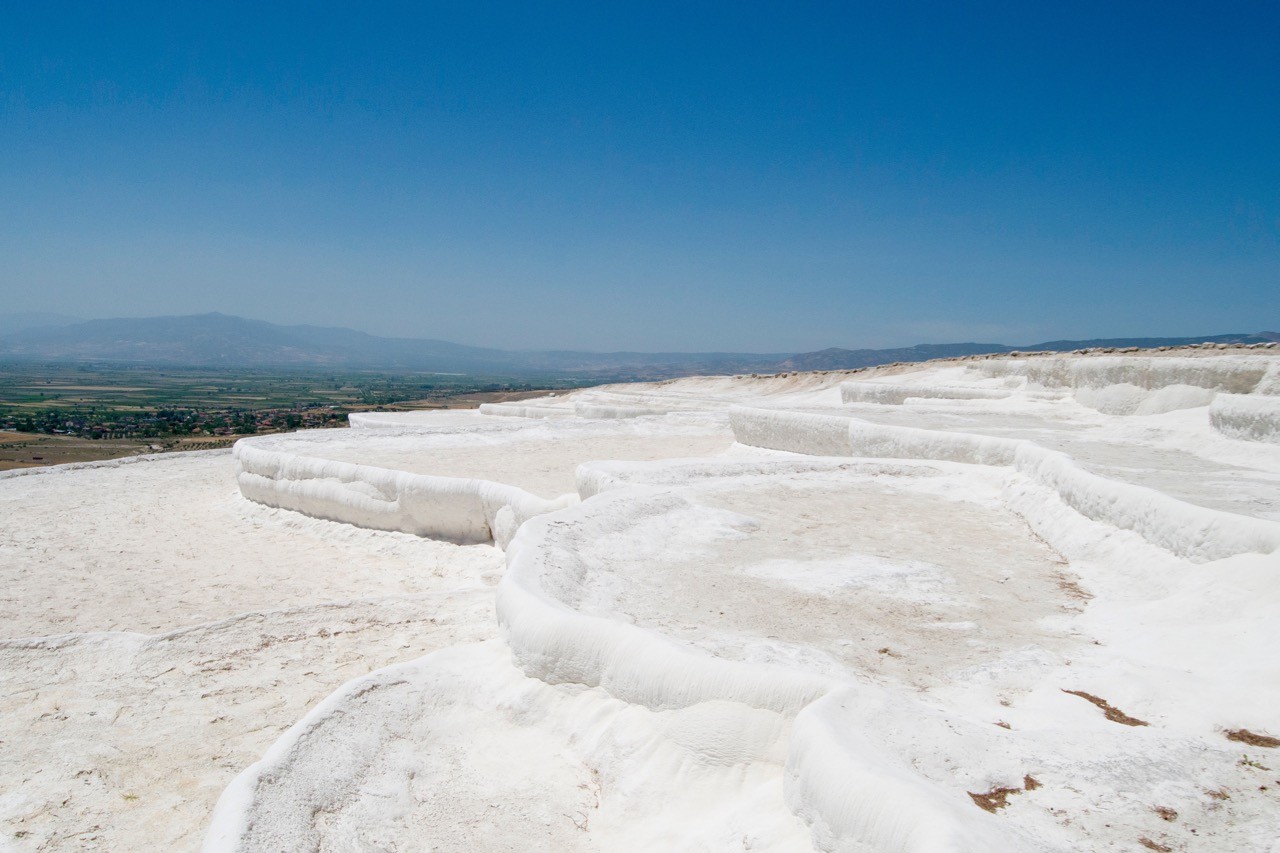
Visiting Pamukkale in Turkey
Pamukkale’s surreal landscape was formed over millennia by limestone deposited by 17 hot springs in the area. Sadly, its natural beauty was almost lost when hotels sprung up around the area in the 1960s and a road was built to allow motorbikes direct access over the slopes. The hotels drained the thermal waters to fill their swimming pools and the terraces turned a greyish brown.
Thankfully, in 1988, UNESCO stepped in and declared Pamukkale a World Heritage Site. The hotels were demolished and a series of artificial pools were built atop the road to hide the damage caused. Today, there are strict controls on development and tourism in the area, allowing you to visit in good conscience. Here’s what to know before you go.
Pamukkale doesn’t look like the pictures (but it’s stunning anyway)
The lustrous terraces as depicted in guidebooks and tourist board posters do not exist – at least not right now.
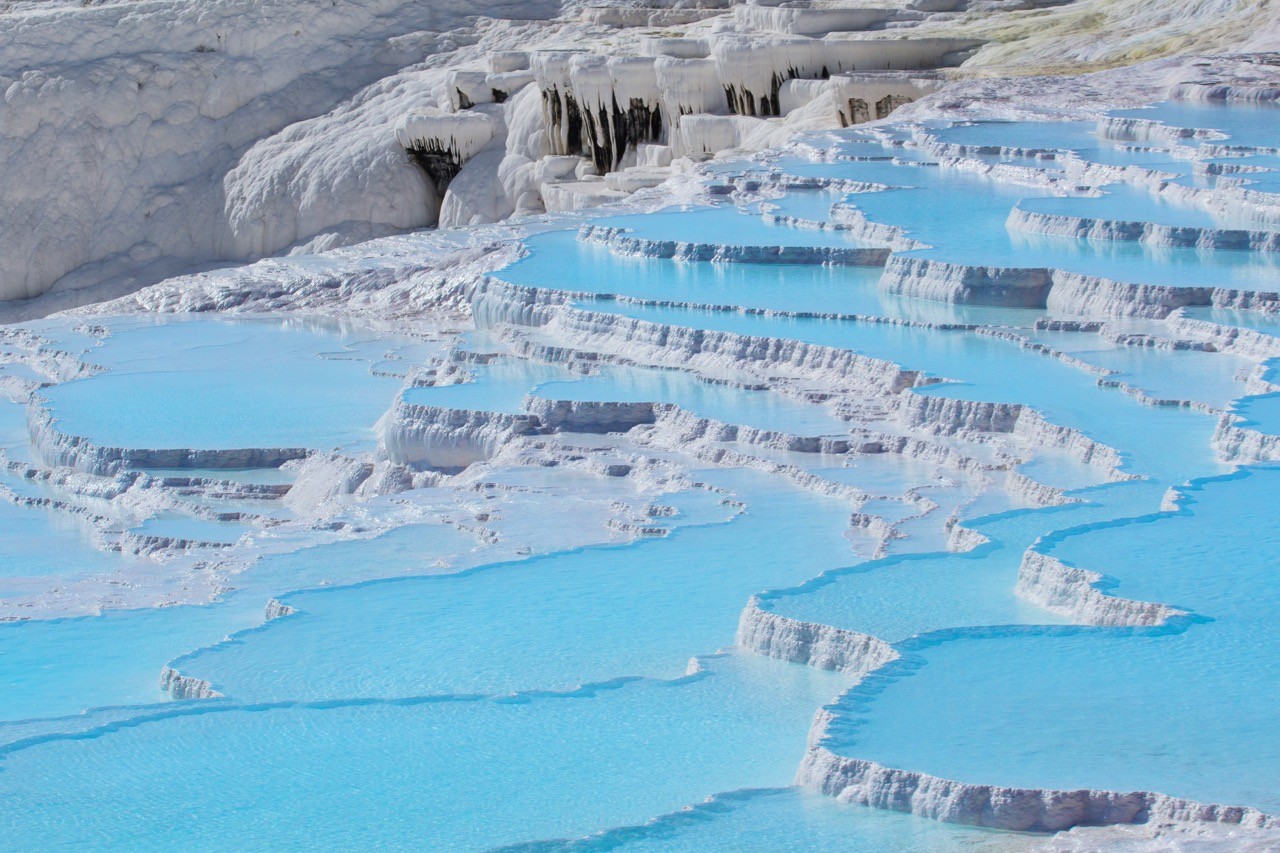
Dreamstime; Atlas & Boots
The water at pamukkale has been diverted.
We’re told that spring water has been diverted to allow the terraces time to recover from past mistreatment. When and how (or if!) the terraces will return to their former glory is currently unconfirmed.
With that said, don’t let the difference put you off from visiting Pamukkale. It is still stunning and most certainly worth the stop.
Expect crowds at Pamukkale
Most foreign tourists visit Pamukkale on a day trip from the coast, which means they arrive late morning or early afternoon. As such, you could opt to stay in Denizli and take a public minibus first thing in the morning for minimal crowding (see ‘How’ below).
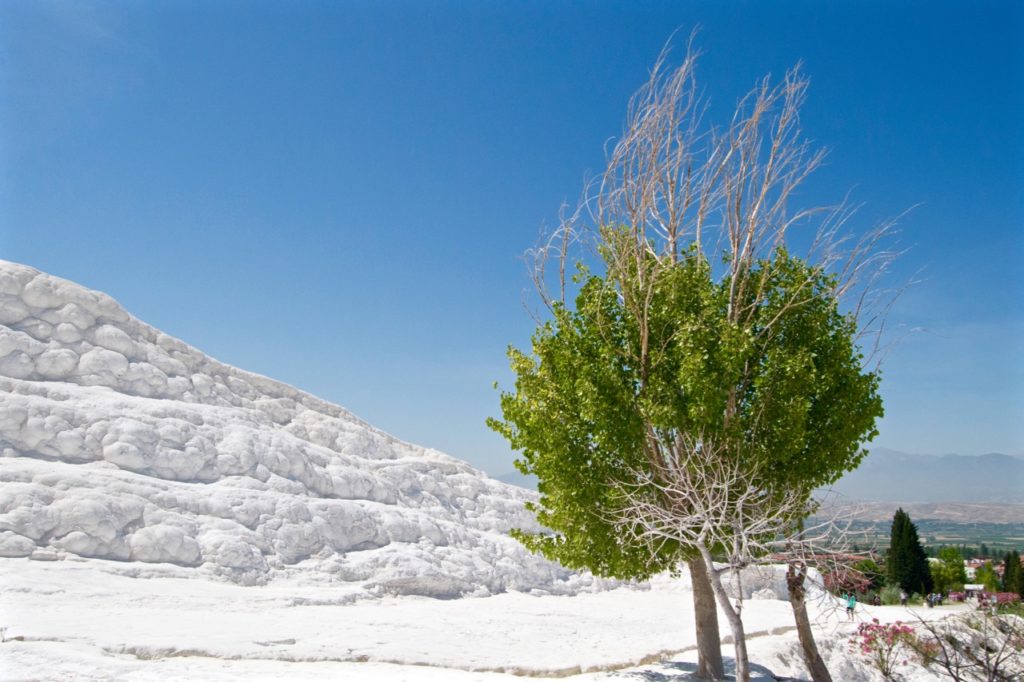
Expect crowds as the day draws on, from Speedo-sporting Europeans to overzealous local children. It’s worth noting that Pamukkale is visited by two million people per year which equates to 5,500 people per day!
Start at the lower gate
The public minibus will drop you at the lower gate by default (ground level with the town) which is the better option for visiting Pamukkale. It is less crowded as tours drop off passengers at the upper gate. It also includes a walk up the cliffside offering stunning views.
We looped back to the lower gate at the end of our visit to catch a bus back to Denizli but also to view the scenery again.
Tread carefully
To prevent damage to the site, visitors must walk barefoot. You will be expected to place your shoes in a plastic bag and carry them (from the lower gate) or leave them on the wooden decking (upper gate). As such, take lightweight shoes that are easy to slip off.
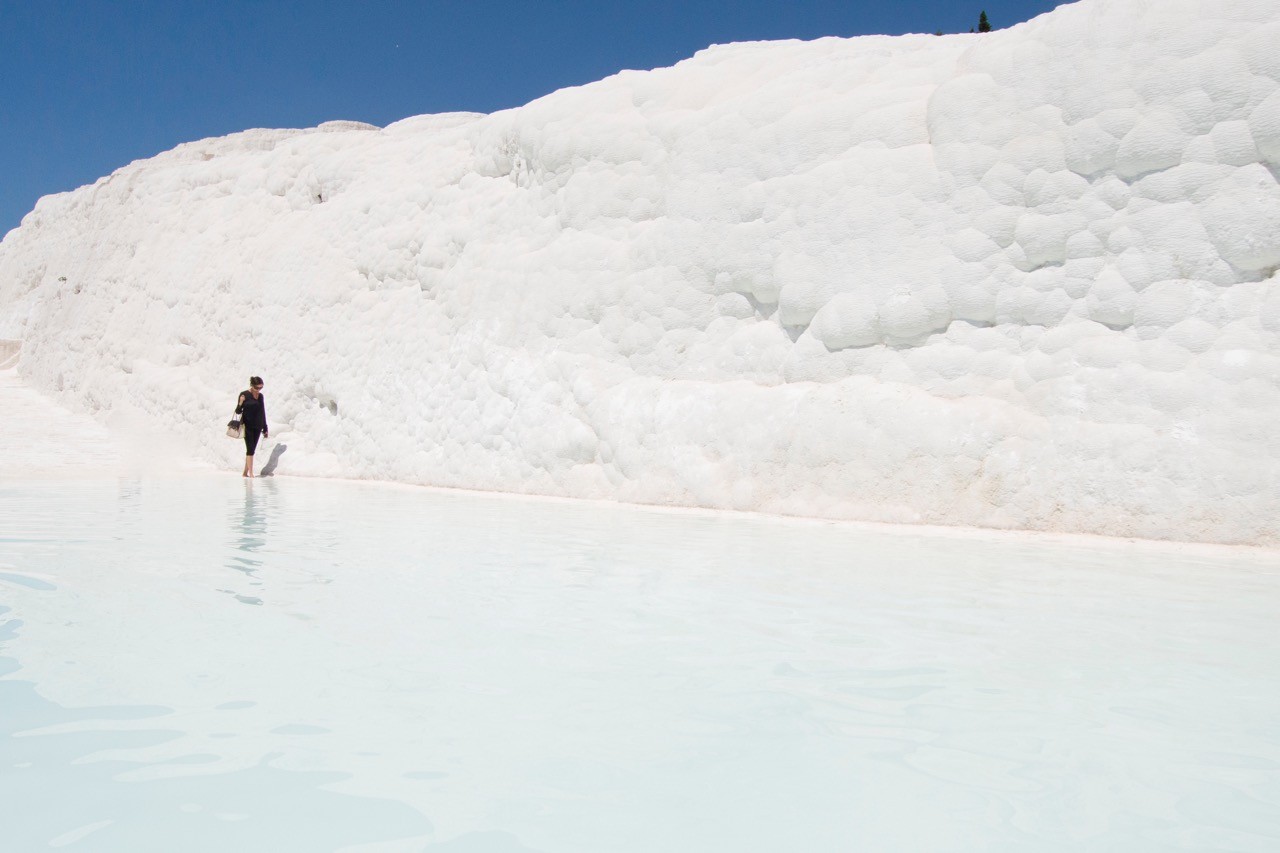
The travertine floor can be slippery in places with running water underfoot as well as sharp-edged pieces of limestone. As such, take your time walking up the cliffside and tread carefully!
There are no lockers at the lower gate so pack light as you will be carrying your bag for the length of your visit.
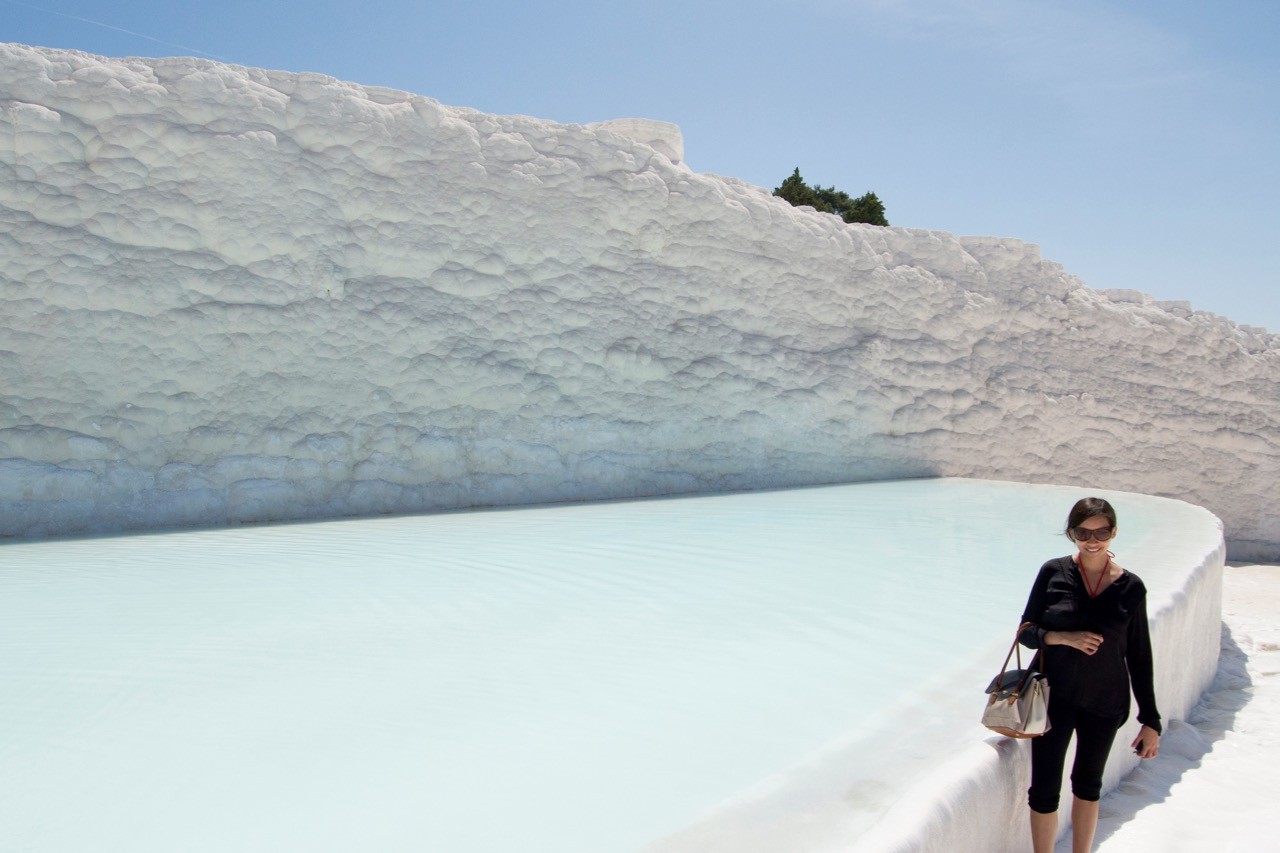
If possible, leave valuables at your hotel. Most visitors leave their bags poolside when taking a dip so there’s a chance that your belongings will go walkabouts. If you must bring valuables, consider storing them in stuff sacs to prevent water damage.
Wear swimwear beneath your clothes
There are bathrooms at the site but it’s easier to wear your swimming costume beneath your clothes so that you can just slip them off and take a dip.
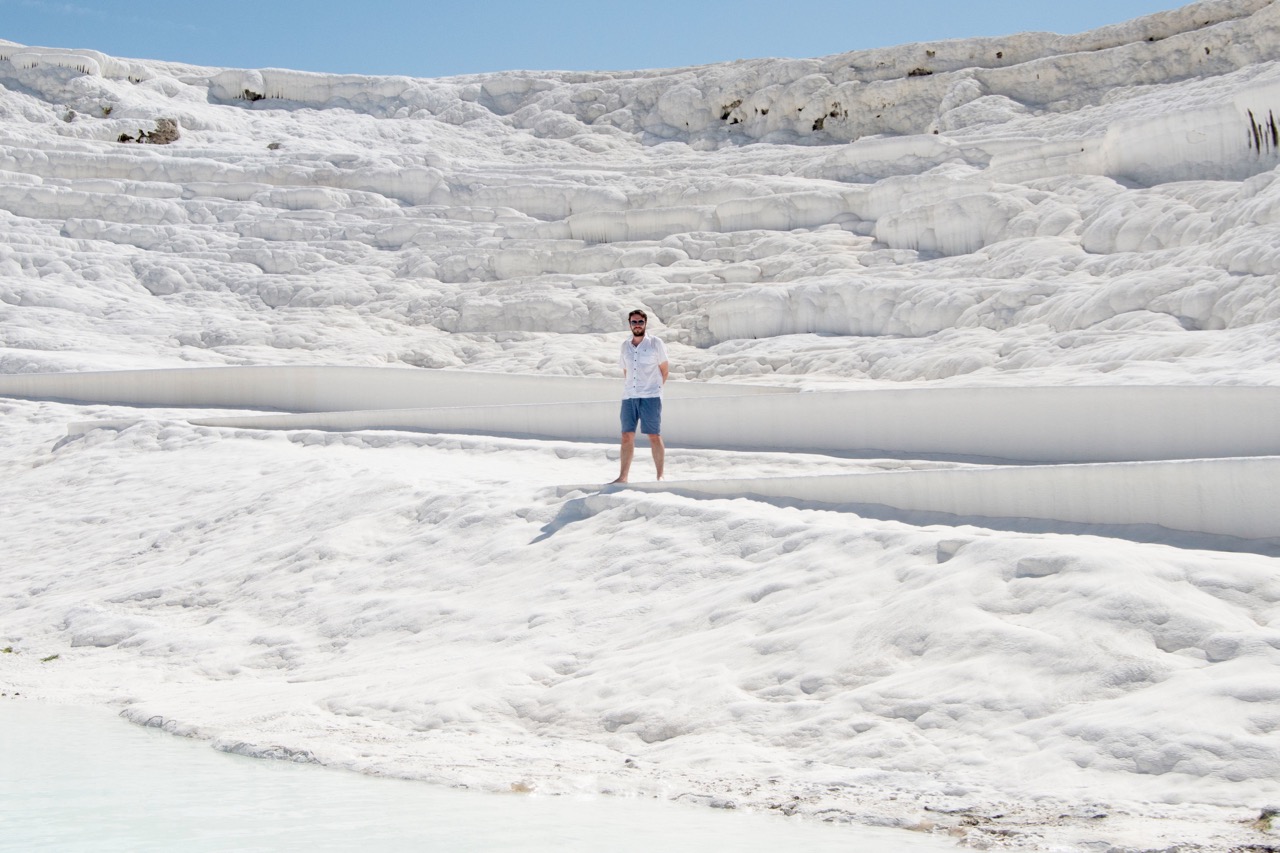
Turkey is liberal compared with other countries in the region so bikinis are okay. You will likely dry off fairly easily in the sun but you may want to take a wrap to pull over your swimwear while it dries.
It’s worth noting that most tourists stick to the pool area. We walked half a kilometre beyond it and found peaceful vistas completely free of visitors. Well worth the extra effort.
Take sunglasses
If you don’t have sunglasses, buy a cheap pair before visiting Pamukkale. The limestone is so bright, so white that it will hurt your eyes if you don’t protect them.
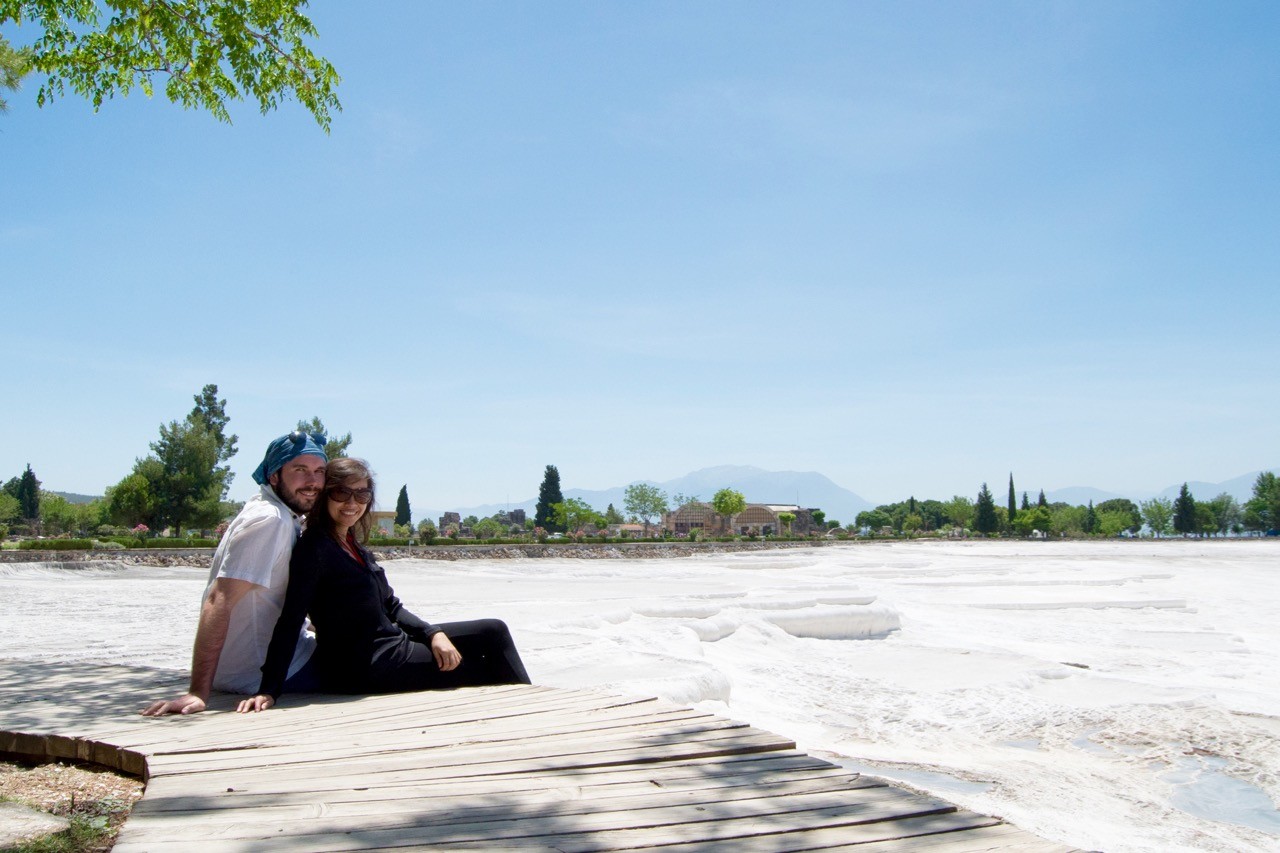
Similarly, wear sunscreen and take plenty of water. Temperatures soar, especially in the summer, and can leave you dehydrated if you’re not careful.
Skip the Antique Pool
Legend has it that the artificially sculpted Antique Pool was a gift from Marc Anthony to Cleopatra. In the 7th century, an earthquake toppled the surrounding building and the massive marble columns tumbled into the pool where they still rest today.
We considered a dip but the atmosphere was akin to that of a British Butlins (hamburger joints, sunburnt tourists, Macarena playing over the loudspeakers). At an extra $10 USD on top of the entrance fee, we decided to forego the pleasure. You may wish to do the same.
Visit Hierapolis
Unlike the Antique Pool, the adjacent site of Hierapolis is worth visiting. Don’t miss the theatre, which is said to have been constructed under the reign of Hadrian after the earthquake of 60 AD.
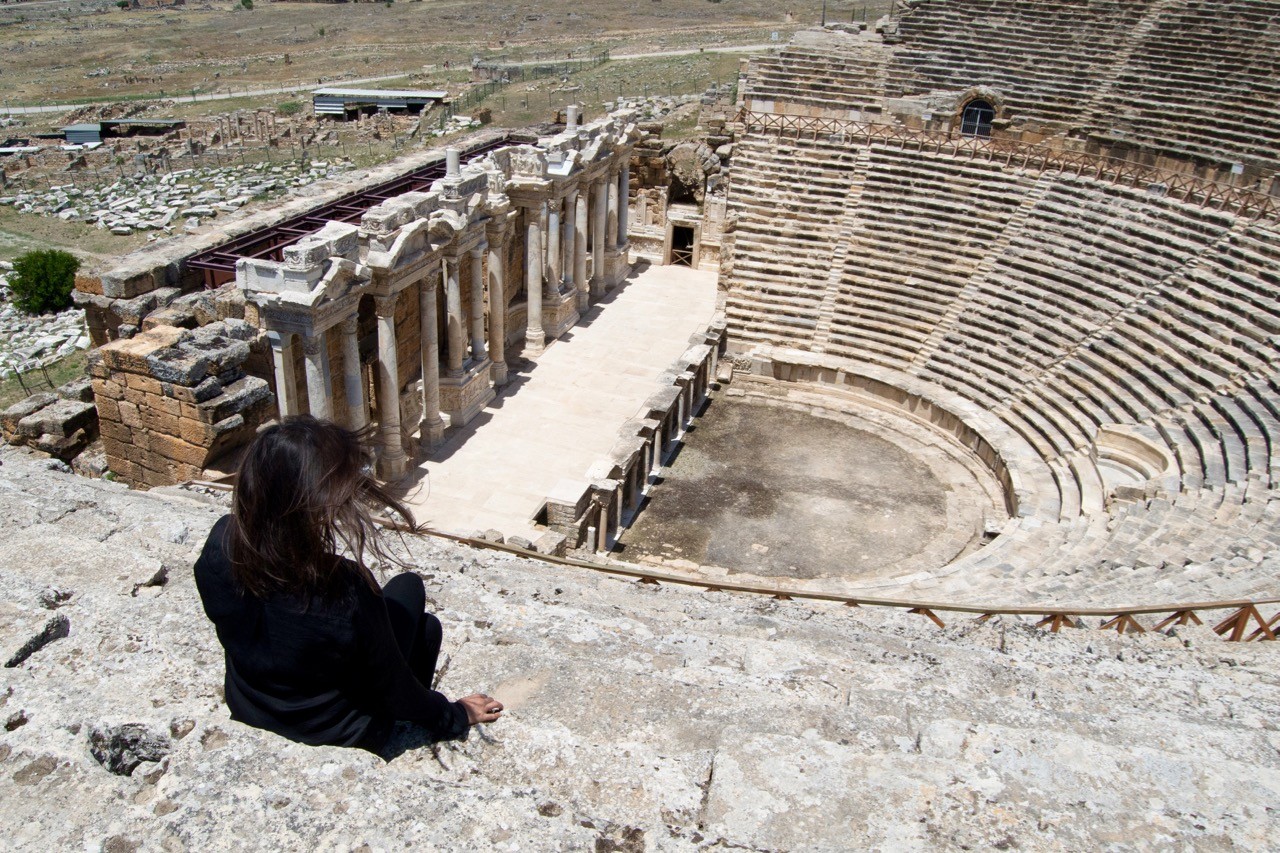
The facade is 300 feet long and there are 50 rows of seats divided into seven parts. We’ve seen our fair share of Roman theatres (in Amman, Jerash, Petra, Ephesus and Rome) and this is as impressive as any with the exception of the Colosseum.
Don’t ignore Denizli
Most visitors use Denizli only as a conduit for visiting Pamukkale. If you have time, spend some time visiting sights within Denizli and the surrounding area including Denizli Old City, Kaklik Cave, Tripolis and Aphrodisias .
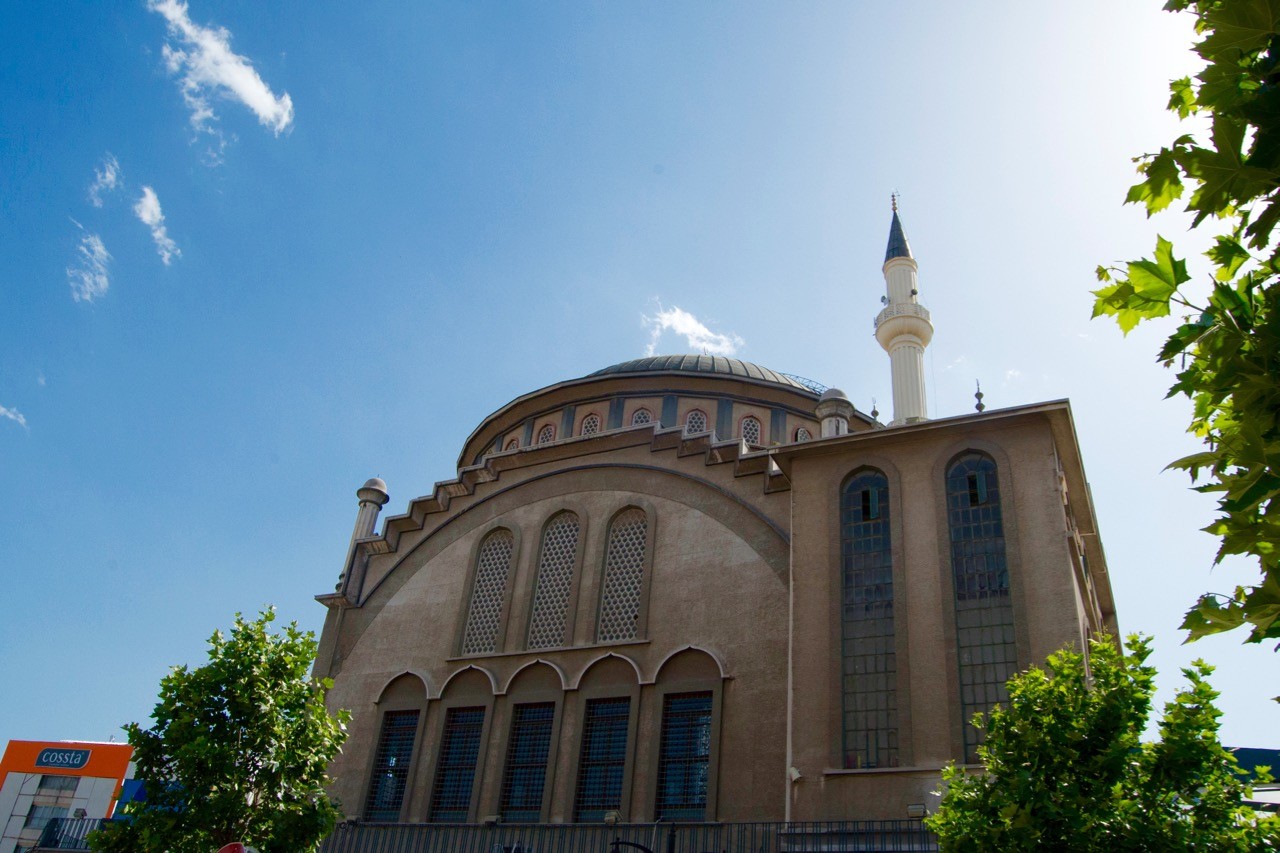
We visited the market in the Old City, which was far less touristy than its Grand Bazaar equivalent in Istanbul, hence offering a more intimate look at local life. We spent some time wandering the lanes before stopping for some Turkish tea in a small courtyard cafe tucked away on the perimeter. Spend some time there and you’ll be sure to find it.
Where to stay in Pamukkale
Some tourists stay in Pamukkale itself but it’s a fairly charmless town and, given the past tourist-related issues, we feel it’s probably better to book accommodation away from the site itself, in either Denizli or Karahayit .
- Anemon Denizli , Denizli
- Doğa Thermal Health & Spa , Karahayit
- Lycus River Thermal Hotel , Karahayit
- Halıcı Hotel Resort & Spa , Karahayit
- Park Dedeman Denizli , Denizli
- Pam Thermal Hotel Clinic & Spa , Karahayit
- Laodikya Hotel , Denizli
- Casa Bianca Hotel , Denizli
- Cimenoglu Hotel , Denizli
Pamukkale opening hours
- Pamukkale and Hierapolis joint site entry: 25TL ($8 USD). Open Nov-March, 6am-6.30pm; April-Oct, 6am-midnight.
- Antique pool entry: 32TL ($10 USD). Open Nov-March, 8am-5.30pm; April-Oct, 8am-7.30pm.
When to go to Pamukkale
The best time for visiting Pamukkale is spring (April to mid-June). Summer can be unbearably hot while winter can see snowfall! Autumn (mid-September to October) is also a good option, but the days are shorter and there’s more chance of rain.
How to get to Pamukkale
In Denizli, you can take a public minibus from bus terminal #76. The ride is approximately 30 minutes and costs 3.50 TL ($1.20 USD) per person. The minibus stops minutes from Pamukkale; ask the bus driver to point you in the right direction. Make a note of the location as you will need to catch the bus back from the spot across the road.
You can catch a train to Denizli from Istanbul, Izmir or Selçuk (check TCDD for the latest timetable). There is no train to or from Cappadocia but there are reliable bus services. We caught a Metro Turizm night bus from Denizli to Cappadocia (9pm – 7am; $17 USD).
We arrived in Turkey at Istanbul’s Ataturk international airport and spent a few days in Istanbul before flying to Izmir (1hr) and catching a train the same day to Selçuk (1hr 20m). After a few days at Selçuk for Ephesus, we took the train to Denizli (3hr).
Ataturk airport is international and has connections to a number of domestic destinations throughout Turkey. Book via Skyscanner for the best prices.
Enjoyed this post? pin it for later…
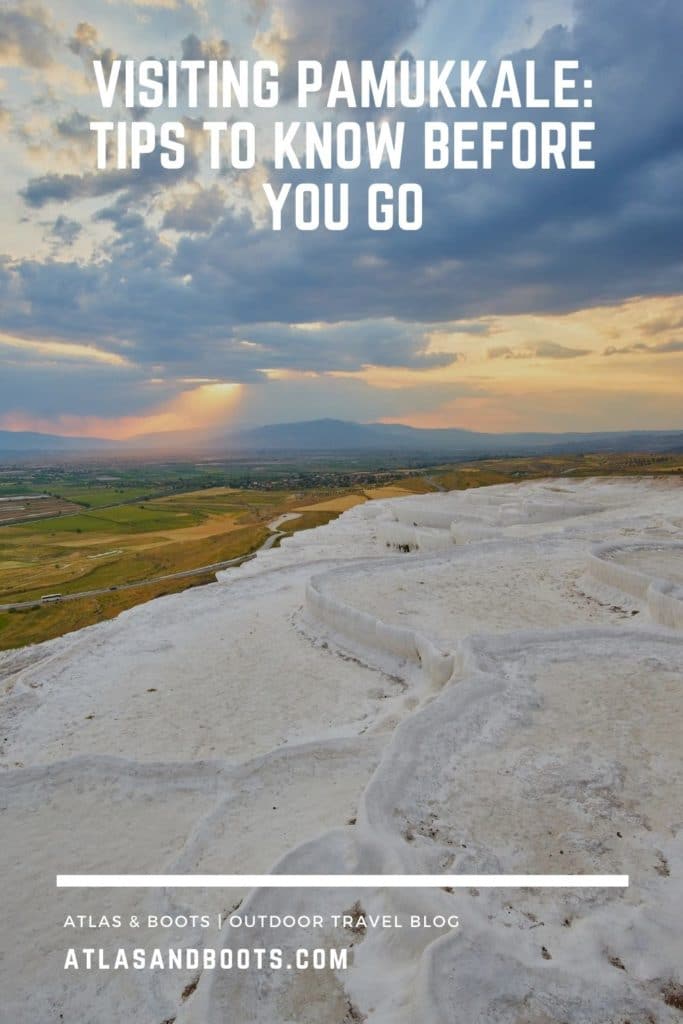
Lonely Planet Turkey is a comprehensive guide to the country, ideal for those who want to both explore the top sights and take the road less travelled.
Lead image: Atlas & Boots
You might also like:.
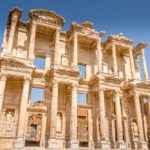
About the author

6 Top Things to do at The thermal Pools of Pamukkale – Complete Travel Guide to visit the Pamukkale Hot Springs
If you want to know how to visit Pamukkale in Turkey, this will be the perfect guide for you. Here I’ll tell you everything you need to know about the water pools of Pamukkale. From Pamukkale’s opening hours to where to stay and eat near Pamukkale. I also explain how to visit Hierapolis and where to stay near Pamukkale and Hierapolis.
Cotton castle. Velvet white rocks. White paradise. Magically healing hot water springs. What a way to advertise Pamukkale! It sounds more like a fairy tale than a real place. Add on top of that a beautifully photo-shopped picture to the brochure and you definitely have a good amount of visitors coming your way!
Pamukkale, which means “cotton castle” in Turkish, is a natural site in Denizli in southwestern Turkey. The area is famous for a carbonate mineral left by the flowing water.
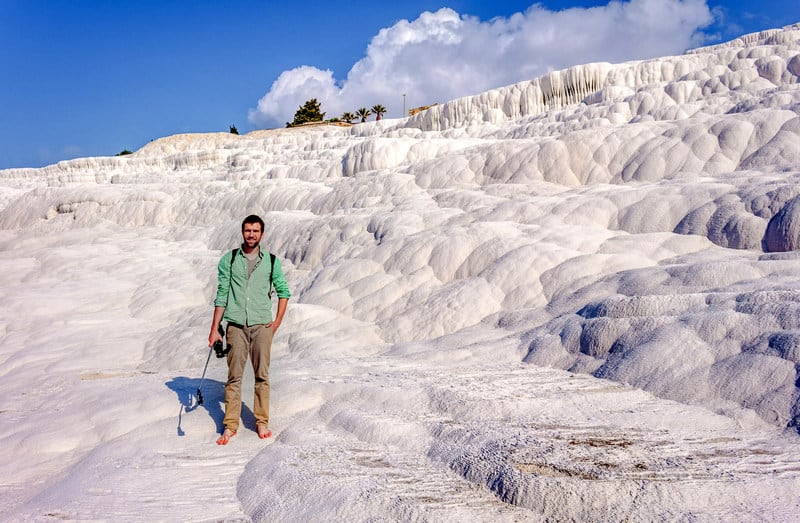
Over the course of thousands of years, this mineral has formed white water pools famous around the whole world for their healing properties. Pamukkale is so much more than hot pools and in this guide, I’ll tell you about all the cool activities you can do there!
Tip: See my Turkey Travel Page for a complete overview of all my travel guides and blog posts about Turkey!

The 13 Best Places to Visit in Turkey
Disclaimer: This posts might contain affiliate links, meaning that if you make a purchase through these links, I may earn an affiliate commission. Thank you for helping to support this website!

Pamukkale Travel Experiences & resources
Top experiences & tours:.
- Pamukkale City Highlights Tour
- Hot Air Balloon Flight over Pamukkale
- Day Tours from Antalya
- Day T our from Izmir
- All Pamukkale Tour Experiences
Top Stays in Pamukkale
- Bellamaritimo Hotel (budget)
- Venus Hotel (mid-range)
- Whiteheaven Suite Hotel (high-end)
Travel Resources
- Turkish Museum Pass
- Car rental Turkey
- Get to Pamukkale by public transport
TABLE OF CONTENTS
Where is Pamukkale?
Pamukkale is tucked away in the hills of the Denizli Province in southwestern Turkey, about 19 km from the city of Denizli. It’s located in Turkey’s Inner Aegean region, in the River Menderes valley and the site has a nice temperature for most of the year.
Turkey is a very big country and most people visiting the country don’t make it to the hot pools of Pamukkale as it’s located quite far from the country’s capital Istanbul .
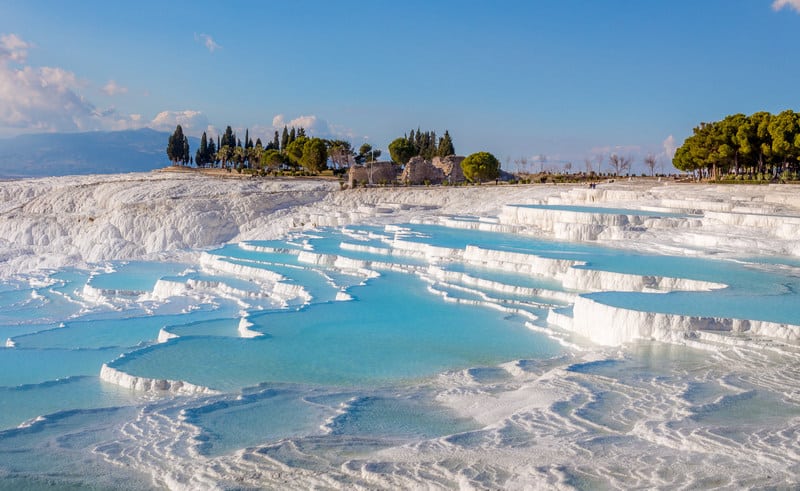
A bit farther in this article, I’ll tell you how to get to Pamukkale from the biggest cities in Turkey.

10 Useful Things to Know Before Visiting Turkey
Why should you visit Pamukkale?
There are so many different reasons why Pamukkale is worth visiting. First of all, there is a lot of ancient history and mystery surrounding Pamukkale.
Throughout the ages, the hot waters of Pamukkale were always said to have some healing properties. There is a legend that tells the story of a young ugly girl who lived in a little village near Pamukkale. She was so ugly that nobody wanted to be with her. She became so desperate and lonely that she wanted to kill herself.
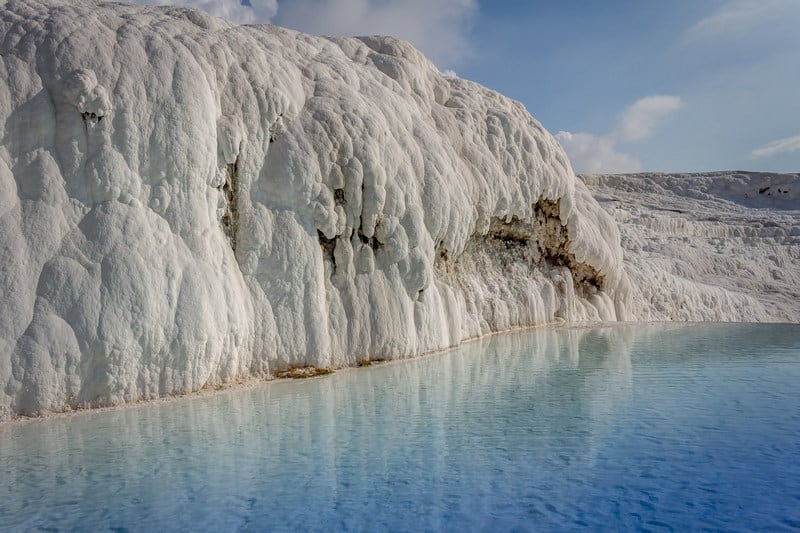
She jumped off the highest cascade but instead of being crushed to death, she fell in one of the water pools. The magical powers of the water washed away her sorrows and she became a very attractive girl.
When she climbed out of the pool, she met the lord of Denizli and he was so mesmerized by her beauty that he fell in love with her and asked her to marry him. They lived happily ever after.

The Turks say that bathing in the pools will cure illnesses such as nutritional and chronic disorders, digestive and circulatory problems, eye and skin diseases, etc. Because of this, Pamukkale has been a flourishing spa resort since ancient times. Even Cleopatra bathed in the healing pools.
Apart from the healing properties of the water, the travertine pools of Pamukkale are surrounded by some gorgeous ruins and historical sites. One of these sites is the ancient Greek city of Hierapolis located above the pools.

Hierapolis was transformed into a spa in the 2nd century BC. It became a healing center where doctors used the thermal springs as a treatment for their patients.
In 17 AD a major earthquake left the city completely in ruins. The Romans rebuilt it and added a big amphitheater. Thousands of people came to benefit from the healing water pools.

The city grew and became very wealthy. But over a period of hundreds of years there were a lot of earthquakes and eventually the city never fully recovered and got completely abandoned around the 14th century.
In the 20th century the ancient city was rediscovered by travelers (I sure hope we’ll do a major discovery like this one day) and the hot springs became famous again.

10 Best Non-Touristy Places to Visit in Turkey
Top things to do in Pamukkale
There are quite a few things to see and do in and around Pamukkale. Here are some of the sites and activities you shouldn’t miss:
1. Bathe in the travertine pools
The one thing you should absolutely do when visiting Pamukkale is bathing in the dazzling white travertine pools. These natural rock pools were created by calcium deposits coming from the area’s hot springs.
These deposits grew on the steep slopes of Pamukkale the same way stalactites form inside caves. They gradually fanned out into pools over the years.

To reach these pools, you’ll have to walk (barefoot to not damage the travertine) all the way from the bottom entrance of the site to the top part where these small natural baths are located. The pools closer to the top are the hottest while those closer to the bottom of the site hold lukewarm water.
2. Visit the ruins of Hierapolis
Hierapolis was originally a fortified Greek colony founded by king King Eumenes II of Pergamon around 190 BC. While the city started off as a military outpost, it was later transformed into a spa center.
The ruins of the city have beautiful long roads surrounded by towering columns. Cynthia and I walked up through the Pamukkale limestone terraces and entered the Hierapolis ruins near the Antique Pool.

We walked there for hours and hours soaking in the beauty of the ruins. There is a Necropolis in the northern part of the ruins and Byzantine church at the southern end.

3. Enjoy the view in the theater of Hierapolis
The theater is the main attraction to see if you visit the ruins of Hierapolis. It stands on top of a hill and overlooks the rest of the ancient Greek colony. It takes about 10 minutes to reach the theater from the entrance of the ruined city.
The theater is incredibly well-kept and retained much of its original detail. If you go sit on one of the top seats, you’ll have a fine view of the perfectly preserved stage.

4. Bathe in Pamukkale’s antique pool near the temple of Apollo
There are a few more pools worth exploring near the temple of Apollo. Unlike the natural travertine pools, these were carved into the rock by the Romans.
It’s quite a unique hot-spring experience, with submerged columns and marble pieces of the temple scattered in the water. I haven’t had any experience like this anywhere else!
You’ll need to pay 50 Lira to swim in these Roman pools in addition to the 50 Lira it costs to enter the site.

Kids under the age of 6 can get in the antique pool for free while kids aged 6 to 12 must pay 13 Lira. The pool is only open from April to October from 8 am to 9 pm every day. There are lockers where you can put your belongings while you bathe in the healing waters but towels are not provided.
5. Visit the museum of Hierapolis
This small museum has an interesting collection of antiquities from Hierapolis and is located in a former Roman bathhouse.
Visiting the museum will help bring the city of Hierapolis to life. It showcases beautiful art, stone reliefs, and ancient sarcophagi for which the region was famous. The whole collection of antiquities also includes sculptures from the nearby site of Aphrodisias.
6. Go for a sunrise hot air balloon ride
Imagine slowly flying in a hot air balloon over the white travertine pools. The views you’ll get will be one of a kind!
Not only will you get a unique aerial view over the pools and the ancient ruined city of Hierapolis, add to this the stunning colors of the sunrise and you have an experience you won’t easily forget!
You can book these hot air balloon rides at one of the travel companies in Pamukkale or you can book them online in advance. The hot air balloon tour includes a champagne breakfast.

Top 17 things to do in Istanbul
Is it safe to visit Pamukkale?
Pamukkale is definitely very safe. I would advise walking cautiously near the travertine pools though as the white stones can be quite slippery.
You’ll have to walk on rocks covered in running water and there are also sharp-edged pieces of limestone in certain areas. The same goes for visiting the ruins of Hierapolis (see above). Some of the rock bricks have loosened up over time so tread carefully!
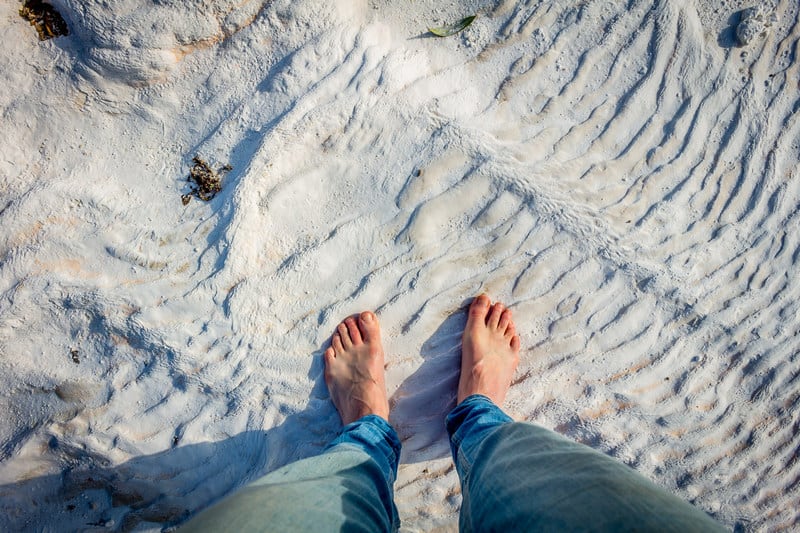
If you’re wondering if it’s safe to wear a swimsuit in Pamukkale, don’t worry. Turkey is still quite liberal when compared with nearby middle-eastern countries. Or at least it is when it comes to the more touristy parts of the country. Bathing in the antique pool with a bikini shouldn’t be a problem.
Another thing I would greatly recommend is to bring a good pair of sunglasses. The white limestone is so bright during the day that the glare could hurt your eyes if you don’t protect them.
Need Travel Insurance? I use and highly recommend HeyMondo Travel Insurance . As a reader of Journal of Nomads, you get a 5% discount off your insurance plan!

Pamukkale opening hours and fees
The entrance ticket for Pamukkale costs 200 Turkish Lira for adults and children and gives access to the thermal pools, the Hierapolis Archaeological Site and Museum. If you want to have an audio-guide, you have to pay an extra 75 Lira. Parking costs 20 Lira if you’re coming by rental car .
You could also buy an Turkey Museum Pass that covers the entrance to Pamukkale as well.
Opening times are from 06:30 am to 09:00 pm in the summer (April 1st – October 1st) and from 08:00 am to 06:00 pm in winter (October 1st – April 1st).

What is the best time to visit Pamukkale?
The best season to visit Pamukkale is spring. The weather there is usually quite comfortable between April and June and a lot of flowers will be blooming around the site.
Fall, from September to October is also a good time to visit Pamukkale but that time of the year can be a bit rainy. Visiting Pamukkale in winter can be very cold.

What should you expect in Pamukkale?
Although Pamukkale looks pristine, deserted, and extremely gorgeous on the Instagram accounts of travel bloggers, it’s not exactly the way it looks in reality.
It won’t look exactly like in the pictures but it will still be stunning if you visit during sunset . You should also expect relatively big crowds in Pamukkale if you visit it during the high season. Most tourists will visit Pamukkale on a day trip from Denizli. They’ll usually arrive by bus in the early afternoon.
What I would suggest is to rent a room in Pamukkale itself so you can visit the site in the early morning before the crowds arrive as I did.

Where to stay near Pamukkale
While most people prefer to stay in Denizli and take a bus to Pamukkale , I think it’s better to stay in a hotel near the hot springs. By staying directly in the town of Pamukkale, you’ll be able to visit the site before it’s filled with tourists.
Here are 3 hotels located in the town of Pamukkale at walking distance from the travertine pools:
- Bellamaritimo Hotel
This is a really nice and budget-friendly hotel in Pamukkale. The hotel rooms are cozy and quiet, all have a private bathroom and there’s even an outdoor pool. The hotel as its own restaurant so you don’t have to go far to enjoy a delicious Turkish meal.
Check out rates and availability for “Bellamaritimo Hotel”
2. Venus Hotel
This family-owned hotel is located at a 5-minute walking distance from the travertine pools of Pamukkale. The rooms are quite luxurious but they still have a very affordable price, ideal for mid-range budget travelers.
Venus Hotel is surrounded by a garden with a large pool where you can relax after spending a day visiting Hierapolis. What I like best about this hotel is the great breakfast they serve every morning on the terrace.
Check out rates and availability for “Venus Hotel”
3. Whiteheaven Suite Hotel
If you want to enjoy some luxury, then Whiteheaven Suite Hotel is the hotel for you! Each room has its own balcony and there’s an outdoor pool, and a big quiet garden to relax.
This establishment is located at 500 meters from Hierapolis and Pamukkale and they offer free transport to the site.
Click to check out rates and availability for “Whiteheaven Suite Hotel”
Where to eat near Pamukkale
Pamukkale has some great restaurants where you’ll be able to sample some of the best Turkish dishes. Here are a few of our favorites:
Kayaç Restaurant & Bar : this exquisite restaurant in Pamukkale has a great selection of beers, wine and fantastic dishes! The eggplant served with meat is incredibly delicious and the fried chicken comes out sizzling with a live fire under it.
Teras restaurant has some great Gozleme and beef Kebabs. The meat served in the dishes is really tender. From Teras restaurant, you’ll get a lovely view of the white hot springs. What I really loved about this restaurant was the friendliness of the staff and the incredible service.
At White House Restaurant & Cafe , you’ll be greeted like family as soon as you walk through the door. The interior of the restaurant is gorgeously decorated with shades of white and blue to imitate the hot springs.
Here you can sample some great Turkish dishes as well as some Mediterranean specialties. The dishes range from delicious Turkish pides, Greek salads, hummus, and bread to vegetarian pasta and spicy chicken curries. Everything is freshly prepared and nicely arranged on white platters.

How to get to Pamukkale
Pamukkale is one of the major touristic sites in Turkey so it’s easily accessed from other cities and towns around the country. Most big cities in Turkey have buses that go to Denizli the closest town to Pamukkale.
Day trips to Pamukkale
The easiest way to get to Pamukkale is by taking a day tour from the city you’re staying. You’ll travel to Pamukkale via private transportation and the tour guide will tell you a lot about its history.
How to get to Pamukkale from Denizli
If you start your journey in Denizli, it will be very easy to get from there to Pamukkale. Denizli is just 16 km away from the hot springs. It’s possible to travel between the two towns by bus or by taxi.
Get to Pamukkale from Denizli by bus
To get a bus from Denizli to Pamukkale, you’ll have to go first to Denizli Otogar Bus Station. The bus to Pamukkale leaves from platform 76. If you’re planning on coming back to Denizli at the end of the day, you should verify the return time of the minibus with the driver and where exactly in Pamukkale you can catch the bus back.
If you want to start your visit by walking around the ruins of Hierapolis before visiting the travertine pools, you can ask your driver to drop you off at the northern entrance near the ancient city. The Northern entrance is called “Örenyeri Kuzey Giriş” in Turkish. Getting a bus from Denizli to Pamukkale will cost around 5 Lira per person.
Get to Pamukkale from Denizli by taxi
A taxi ride from Denizli to Pamukkale should cost around 50 Lira per person and the ride takes about 20 minutes.

How to get to Pamukkale from Istanbul
Istanbul is another very touristy destination in Turkey. Travelers often visit Pamukkale right after spending time in Istanbul.
Flights between Istanbul and Pamukkale
Domestic flights in Turkey are extremely affordable so the fastest way to travel between the two destinations is to take a 1-hour flight from Istanbul to Denizli airport. From Denizli, it’s very easy to hop into a taxi or a bus to reach Pamukkale (see above).
Buses between Istanbul and Pamukkale
If you want to travel from Istanbul to Pamukkale by bus , you’ll first have to go to the main bus station and buy a ticket from Istanbul to Denizli. A bus ticket to travel between the two cities costs around 80 Lira and the ride should take about 7 to 8 hours. Once in Denizli you just have to get a taxi or a bus to Pamukkale.
How to get to Pamukkale from Cappadocia
Cappadocia is quite far from Pamukkale but traveling between the two destinations is not very complicated. From Cappadocia, you’ll first have to reach Goreme.
This city is about 57 km from Cappadocia and from there you’ll be able to take a night bus to Denizli (Pamukkale). The journey takes around 8 hours. If you travel in Turkey during the high season, it’s better to buy your ticket a day ahead to be sure you’ll get a seat on the bus. You can buy your ticket at the Goreme otogar.
We hope this article was helpful and that you enjoyed reading it. Have you ever visited Pamukkale? Do you plan to visit Pamukkale soon? Let us know in the comments below.

Related Posts

The 13 best places to visit in Turkey

10 Useful Things to know to visit Turkey

10 Best Non-Touristy Cities to Visit in Turkey

Top 17 Things to Do in Istanbul

Backpacking in Turkey on a budget – How much does it cost to travel in Turkey?

One year of hitchhiking – the good, the bad and the untold stories. Part 2: Turkey
16 thoughts on “6 top things to do at the thermal pools of pamukkale – complete travel guide to visit the pamukkale hot springs”.
Such an insight into visiting with the myths and I appreciate the hotel tips. Visit may happen in October 2022. Should one wear water shoes or not while walking on the travertine?
Hi Prity, thank you!
I don’t think water shoes are allowed to walk on the travertine, you have to walk barefoot to protect the travertines as much as possible.
Pamukkale looks really spectacular, it’s hard to believe a place like that even exists on earth. Your photos really make me want to bump Turkey higher up on our must-visit list!
Thanks Darlene! 🙂
Nice post i like it very much
Thank you Baris!
Many thanks for sharing this info, it is very interesting and useful. We fly out to Turkey this week for a month and will be staying in Pamukkale for a while.
Hi Michaela and Phil, we’re happy to hear you enjoyed this post! We’re wishing you a fantastic time in Turkey and Pamukkale!
Pamukkale is awesome for sure! It’s true that it’s not quite as sparkling as the classic tourist brochure shots show, but it’s still a natural wonder of the world 🙂 I didn’t know about the fairytale of the girl who became beautiful when she landed in its healing waters either…classic fairytale stuff there!
Pamukkale is definitely a little wonder of nature! I love it when there are myths and stories attached to a place, it makes it even more magical and interesting 🙂
Pamukkale is one of our main reasons for visiting Turkey, your lovely post, edges us to get there faster, nice pictures and lovely video too.
Thank you Vyjay Rao! You definitely won’t regret it! When are you thinking of traveling to Turkey?
Great and very interesting article
Thank you Sevil 🙂
I could spend all night reading your Turkey posts. Beautiful photos of Pamukkale. It’s one place in Turkey that I regret missing. Next time!
Haha,thank you! That’s a really nice compliment 🙂 Pamukkale was definitely a highlight so far! Well, it’s an excuse to return to Turkey 😉
Leave a Comment Cancel Reply
Your email address will not be published. Required fields are marked *
Save my name, email, and website in this browser for the next time I comment.
- 1 Understand
- 3 Get around

Carbon dioxide dissolves in water to make it slightly acidic, so it dissolves limestone - calcium carbonate - when it comes into contact. The limestone is re-deposited if the water evaporates or if the carbon dioxide bubbles out, and in karstic caves this creates stalactites and stalagmites. Travertine is created when hot volcanic springs, heavily charged with carbon dioxide from deep in the earth, flow through limestone then emerge at ground level and blow off their gas. Travertine rocks are found in dozens of places and take their name from the Tivoli district of Rome, where of old they were quarried for building material. At Pamukkale the water cascading down the hillside has deposited travertine in spectacular terraces, glistening white and with each terrace lip retaining a shallow pool.
Early people were drawn by the scenery, the hot mineral waters, and the mysterious vapours from below, with the earliest known settlement from 7th century BC. The town became Hellenised and known as Hierapolis in the 2nd century BC, with a lively trade in therapeutic use of the waters, and ritual observances at the smelly vent of the Ploutonion. Many Jewish and other peoples settled, and the Romans and Byzantines further embellished the place. The waters and smelly rituals had limited success as therapy, but fortunately there was plenty of room in the huge necropolis. The town however suffered repeated severe earthquakes, and after the quake of 1334 was abandoned.
Visitors were few until 1980, so their impact on the place was sustainable, then mass tourism set about wrecking it. Hotels encrusted the plateau above and the valley below, while visitors energetically hacked off bits and crunched the rock terraces beneath their Birkenstocks. Tighter protection came in 1988 when Pamukkale was recognised as a UNESCO World Heritage Site. Most of the terraces were then placed off-limits, and the plateau hotels were removed leaving accommodation in the valley village.
Late spring / early summer is the best time to visit. Pamukkale has a subcontinental Mediterranean climate, so summers can be fiercely hot, there's no shade, and there's a dazzling white light from the terraces. The pools may be dry in late summer, and in winter ascending the cold cascades barefoot is misery.

For intercity public transport, travel via Denizli , which has frequent buses from Istanbul, Ankara, Izmir and elsewhere. Tour buses run from all the coast resorts within a 100 km radius. If you are driving you don’t have to go into Denizli, as Pamukkale is 10 minutes drive from a motorway junction.
Denizli bus station is downtown, and intercity buses arrive and depart on its upper level. Go downstairs for local buses: the service to Pamukkale runs from Platform 76 every 20 min, taking 20 min, and in 2023 costs 24 TL.
37.9179 29.1197 1 Cumhuriyet Meydanı - Republic Square - is where the public bus deposits you. No bus station, it's just a wide section of Turgut Özal Cd, with ticket offices and cafes scattered around.
Walk: the main sights are within 15 minutes. From the bus stop walk east along Atatürk Cd and cross the main road for the path to Town Gate entrance to the travertines.
Dolmuşes ply to Karahayit and run past North Gate. For South Gate take a taxi - tour buses go there direct.
- 37.9194 29.1236 1 Town Gate (aka Lower Gate) is convenient if you're staying in town or dropped off there. It leads into a 15-min ascent through a cascade of dazzling travertine pools, where you have to go barefoot and carry your shoes. At the top is the museum, where you join the trail from South Gate.
- 37.9219 29.1294 2 South Gate is the main entrance for motorists, and anyone with restricted mobility may prefer to enter here. From town follow Yeniköy Yolu and the cavalcade of tour buses. From the gate you walk straight into Hierapolis.
- 37.9414 29.1188 3 North Gate is the other car and bus park - dolmuşes to Karahayit pass this way. It is then a wait for a shuttle (old minibus 40tl per person in 2024), pay for a 5 person electric tour cart and driver, or a 2 km walk on a poor trail, slowly descending through the necropolis past a series of tombs and monuments.
- Gymnasium is the first structure encountered past South Gate. It was built in 60 AD; five columns have been re-erected. These Greek institutions inspired the gymnasium school system of Germany and Denmark.
- 37.9229 29.1251 1 Sunset Spot is a look-out with a grand vista over the travertine terraces, impressive at any time of day if the sun's out. However in winter and in dry spells the pools are dry - there's enough natural piping hot water to keep them flowing, but too many hotel spas have tapped into the source.
- Pools and terraces fill the scarp below the plateau but are mostly off-limits to protect them. The exception is the cascade from the museum to Town Gate, which in effect has been sacrificed to create an access route and let tourists get their feet in the water. The pools are shin deep, wear a swimming costume or shorts. There is no path to / from Town Gate other than through these pools, they're often mobbed, and it feels like walking on an icy ski path with dozens of wobbly skiers coming at you.
- 37.9251 29.1244 2 Archaeology Museum , ☏ +90 258 272 2034 . Daily 08:00-18:30 . This is within the Roman bath house, and displays artifacts found during local excavations, including ornate sarcophagi. One of these (not always on display) is 3rd century and has an intricate depiction of a crank-driven sawmill, the first known example. ( updated Oct 2023 )
- 37.9261 29.1255 3 Cleopatra Pool . This naturally hot swimming pool would feel like Disney if only it was clean - you'll wonder where's the crazy-golf and the popcorn cart? Supposedly founded by Cleopatra, it was part of an ugly rash of hotels built from the 1980s, so being 2000 years old she'd be wizened beyond hope of any spa cure. The hotels were later cleared away leaving only this pool, with fluted column pieces sunk within it for extra authenticity. The shop sells bathing suits and towels, and there are lockers. Adult or child 130 TL . ( updated Oct 2023 )

- Temple to Apollo is just east of the swimming pool. A few broken columns are standing. One wall is the remnant of a Nymphaeum - nymphs were minor deities associated with springs.
- Ploutonion just south of the Temple to Apollo is a shrine to Pluto or Hades, ruler of the underworld. Several such sites existed in the classical world and their common feature was noxious vapours from the realms below. Useful to know: Tehlikeli zehirli gaz means "dangerous poisonous gas". At Hierapolis it's carbon dioxide off-gassing from the spring waters plus a niff of sulphur, so it suffocates rather than poisons. You can thus enter the underworld at such portals for free, but the hell-dog Cerberus ensures that no wealth on earth can ransom you out again.
- 37.9269 29.1292 4 Roman amphitheatre is a highlight, a well-restored 12,000-seat amphitheater. It was built in 129 AD ahead of a visit from the Emperor Hadrian; the whole town needed rebuilding after the earthquake of 60 AD.
- 37.9311 29.1304 5 Martyrium is within the Roman necropolis extending 2 km towards North Gate. It's the church and tomb of St Philip the Apostle, who was described in the Gospel of St John and martyred at this spot in either 54 or 80 AD. Later legend jazzed this up: he converted a talking goat to join his preaching team, turned devil-snakes into black men so they could be ordered (in an inclusive sort of way) to build a church, and preached non-stop even while being crucified upside down - it's not clear whether even beheading shut him up, or if the goat completed his sermon. None of these scenes are nowadays re-enacted.
- Hellenistic amphitheatre hasn't been restored so it's just overgrown rubble north of the Martyrium.
- Agora between that amphitheatre and the cathedral was the central square of town. You'll have to imagine its porticos and embellishments.
- 37.9294 29.1244 6 Cathedral is a large basilica of which only low walls remain.
- Frontinus Street was the main drag of Hierapolis, heading north from the Temple of Apollo and Cathedral. It's uneven going and the access lane parallels it west. Domitian Gate is an impressive triple arch on the street next to the town latrines.
- 37.9335 29.1211 7 Basilica Baths was built as a bath house just outside the city gates in the 3rd century AD and converted into a church in the 5th.
- 37.9675 29.1027 8 Karahayit 4 km north of Pamukkale is a separate geothermal area outside the ticketed zone. A trace of iron in the water has created rusty or russet travertines, not nearly as impressive as the white ones, and smaller. The village has become a spa strip encrusted by hotels - from the bus turnaround head north to the springs.
- Laodikeia: see Denizli for this ruined Roman city 10 km south. Buses to town drop you off 1.5 km east of the site.
- Kaklik Caves: see Denizli for these caves 30 km east with both dripstone and travertine formations.

- Alanı Park is next to Town Gate but is outside the ticketed area. It's a pleasant picnic spot with a view of the travertines and its own pool. There's a cafe terrace, where the geese will bug you for food.
- Pamukkale Flights waft you over the area by hot air balloon, tandem paraglider or gyrocopter. They pick up from local hotels.
- Pamukkale Market at the bus stop is open daily 11:30-22:00.
- Cotton and homewares are local produce.
- 37.913 29.1215 1 Aliş Restaurant , Memet Akif Ersoy Blv 25 , ☏ +90 538 606 7700 . Daily 08:00-22:00 . Excellent open-air restaurant at the foot of town, with trad Turkish fare and views across the valley. ( updated Oct 2023 )
- 37.9136 29.1199 2 Kayaç Wine House , Atatürk Cd 3 , ☏ +90 534 561 1080 . Daily 10:45-00:00 . Very central so it's popular, but the food is only so-so. ( updated Oct 2023 )
- Kale Hotel at Atatürk Cd 16 gets dismal reviews for its restaurant and its rooms.
- Seven Spices , Turgut Özal Cd 24 ( 100 m south of Kayaç Wine House ), ☏ +90 544 204 2048 . Daily 11:30-22:30 . Occasional lapses, and it's not the cheapest, but most customers reckon this is quality authentic Indian food. ( updated Oct 2023 )
- 37.9178 29.1219 3 Mehmet's Heaven , Atatürk Cd , ☏ +90 258 272 2643 . Daily 08:00-00:00 . Friendly restaurant with good Turkish food. ( updated Oct 2023 )
- Gürme Restaurant , Memet Akif Ersoy Blv , ☏ +90 545 769 0020 . Daily 08:30-23:00 . Mostly good reviews for this trad place by the lane up to Town Gate entrance to the travertines. ( updated Oct 2023 )
- No free-standing pubs, the cafes and restaurants serve beer (usually Efes or Tuborg), wine, and rakı the anise-like spirit. Ayran is a salty yogurt drink similar to lassi.
- Pamukkale is a wine-producing region, mostly fruity reds such as Shiraz. Turkey doesn't have geographical denominations as in western countries.

- Artemis Yoruk Hotel , Atatürk Cd 2 , ☏ +90 552 841 8420 , [email protected] . Simple hotel opposite the bus stop with a pool, garden, and rooftop restaurant. Clean rooms with en-suite, TV and air-con. B&B double 800 TL . ( updated Oct 2023 )
- 37.9113 29.1198 1 Melrose House , Vali Vekfi Ertürk Cd 8 , ☏ +90 258 272 2250 . Friendly pansiyon with clean comfy rooms with air-con and pool. B&B double 1500 TL . ( updated Oct 2023 )
- Hotel Dört Mevsim , Hasan Tahsin Cd ( 50 m west of Melrose ), ☏ +90 258 272 2009 . Friendly but basic place; their name means "Four Seasons". B&B double 800 TL . ( updated Oct 2023 )
- 37.9119 29.1188 2 Venus Suite , Hasan Tahsin Cd 19 , ☏ +90 258 272 2270 , [email protected] . Great reviews for this comfy clean place with a thermal swimming pool. B&B double 1000 TL . ( updated Oct 2023 )
- Sinter Terasse Hotel , Hasan Tahsin Cd 22 ( next to Venus ), ☏ +90 531 708 8116 , [email protected] . Simple efficient hotel, rooms are en suite with air-con. B&B double 1000 TL . ( updated Oct 2023 )
- Karaca Termal Pansiyon , Atatürk Cd 76, Karahayit , ☏ +90 535 898 9209 . Simple friendly place with pool. B&B double 800 TL . ( updated Oct 2023 )
- Hierapark Spa Hotel , Kızılseki Sk 15, Karahayit , ☏ +90 258 271 4616 . Comfy mid-price hotel with pool. B&B double 2000 TL . ( updated Oct 2023 )
- Herakles Termal Otel , Kızılhamam Sk 8, Karahayit , ☏ +90 258 271 4425 . Smart hotel with pool, rooms are small but comfy. B&B double 2000 TL . ( updated Oct 2023 )
Pamukkale, Denizli and their approach roads have 4G from all Turkish carriers. As of 2024, 5G has not rolled out to here.
- Denizli the nearby transport hub is modern but has several old mosques.
- Aphrodisias is one of the best preserved Roman sites in this region. It's 30 km west across the mountains, but reckon 50 km winding around by road.
- Kuşadası is a big resort town on the Aegean coast. It's close to the ruins of must-see Ephesus ; also impressive are the ruins of ancient Didyma, Miletus and Priene .
- UNESCO World Heritage Sites
- UNESCO tag to be fixed
- Has custom banner
- Has mapframe
- Maps with non-default size
- Has map markers
- Eat listing with no coordinates
- Sleep listing with no coordinates
- Has Geo parameter
- Usable cities
- Usable articles
- City articles
- Southern Aegean
- All destination articles
- Pages using the Kartographer extension
Navigation menu
Pamukkale Tourism and Travel Guide
Trips and itineraries for pamukkale.
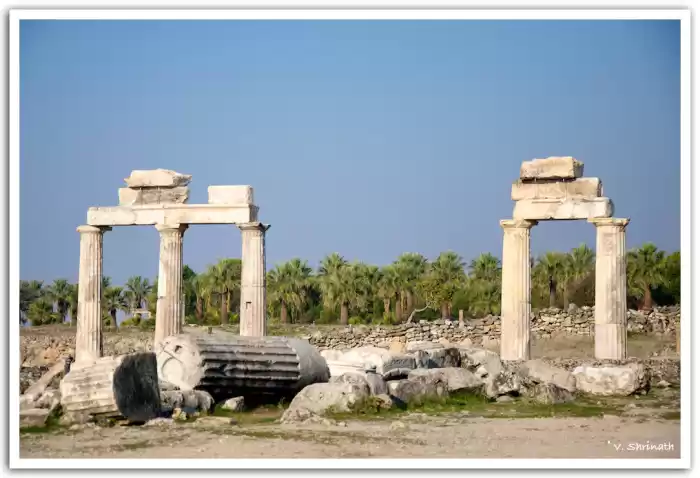
Top Places To Visit in Pamukkale
Weekend getaways from pamukkale.
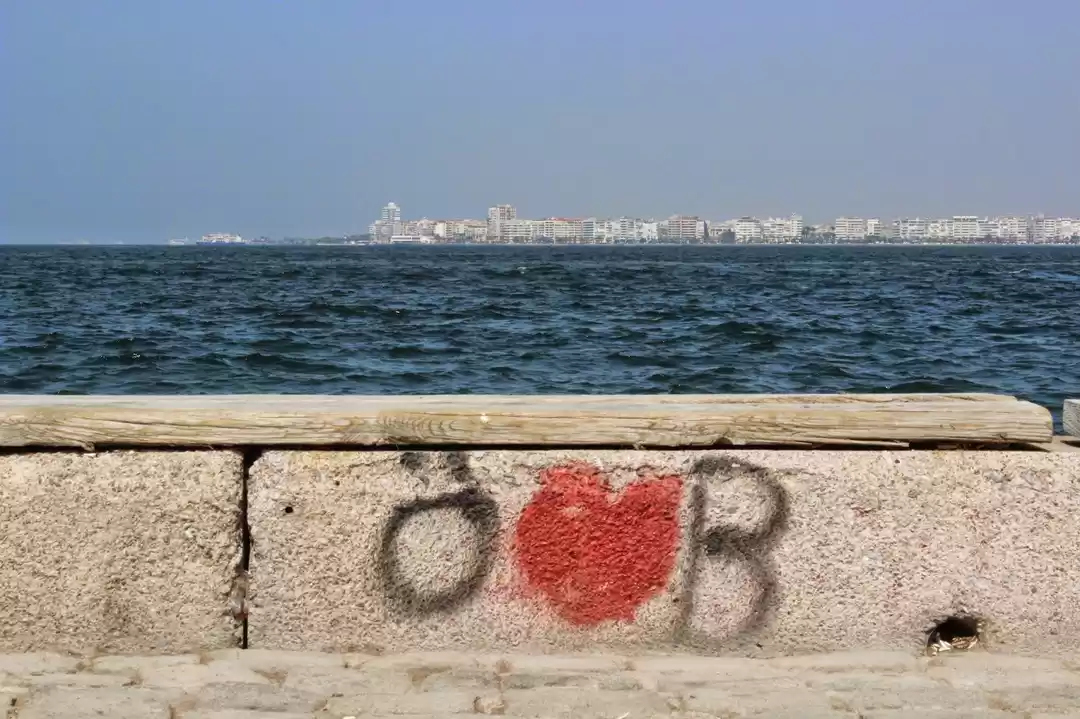

Ciekawostki o Pamukkale, czyli antyczne zabytki Turcji na tle cudu natury
Są na świecie miejsca, które zadziwiają i wprawiają w zachwyt nawet tych, którzy uważają, że widzieli już wszystko. Jednym z nich jest Pamukkale, czyli słynny Bawełniany zamek. Niesamowity cud natury zaczął się formować tysiące lat temu, a proces ten trwa nieprzerwanie. Dziś to jedna z największych atrakcji Turcji i jedno z tych miejsc, które po prostu trzeba zobaczyć na własne oczy. Czym zaskakuje Pamukkale? Ciekawostki o słynnych białych tarasach wymieniamy poniżej.

Artur Białek
- Udostępnij na facebook
- Udostępnij na twitter
- E-mail do przyjaciela
W tym artykule:
Co oznacza pamukkale, gdzie się znajduje pamukkale, ciekawostki o pamukkale, atrakcje pamukkale, zabytki w pamukkale.
Spacerując piękną doliną Cürüksu, można natknąć się na miejsce niezwykłe . Na pierwszy rzut oka można odnieść wrażenie, że pośród bujnej zieleni, w promieniach palącego słońca, wyłaniają się wzgórza pokryte lodem, pośród których rozlewa się błękitna, jakby arktyczna woda . To nie halucynacja, choć to, co widać, w rzeczywistości nie jest lodowcem . To wapienne tarasy , jeden z najniezwyklejszych tworów natury.
Nazwa Pamukkale jest zlepkiem dwóch tureckich słów: „pamuk” i „kale”. Pierwsze oznacza „bawełna”, a drugie – „zamek” lub „twierdza”. Pamukkale to zatem Bawełniany zamek. Dość często można się spotkać z opiniami, według których to piękne miejsce zawdzięcza swoją nazwę wrażeniu, jakie sprawia – skały mają wyglądać, jakby pokrywała je bawełna. Geneza jest jednak nieco inna.
Na południowo-zachodnim wybrzeżu Turcji uprawa bawełny stanowi istotną gałąź gospodarki. Po zebraniu włókna, układa się je na składowiskach. Wielkie stosy włókna przypominają wysokie, białe góry. To nasuwa jednoznaczne skojarzenie z białymi tarasami, które z oddali wyglądają jak wzgórza pokryte śniegiem lub lodem.
Niewielka miejscowość Pamukkale znajduje się w południowo-zachodniej Turcji, w dolinie Cürüksu . W starożytności to miejsce było znane jako dolina Lycos . Miasteczko znajduje się w odległości niecałych 20 kilometrów od Denizli, a od egejskiego wybrzeża Turcji dzieli je dystans około 200 kilometrów.
Surrealistyczne zakątki Ziemi [GALERIA]

Pamukkale często jest nazywane przyrodniczym cudem świata . Nie bez powodu, bo właśnie tam można podziwiać słynne białe tarasy, przez które przelewa się krystaliczna woda.
Wapienne skały tworzą zapierającą dech w piersiach scenerię. Ich naturalna biel kontrastuje z zieloną szatą, porastającą dolinę. Nic dziwnego, że każdego roku tłumnie ściągają tam turyści z całej Europy (i nie tylko).
Popularność tego miejsca sprawiła, że wokół wspaniałych formacji jak grzyby po deszczu zaczęły wyrastać hotele i inne obiekty infrastruktury turystycznej. To przyczyniło się do degradacji środowiska naturalnego. Żeby zapobiec dalszym szkodom, władze Turcji objęły cenny obszar ochroną, tworząc park narodowy.
W 1998 roku Pamukkale zostało wpisane na Listę Światowego Dziedzictwa UNESCO . Część hoteli została zamknięta. Zlikwidowano też trasę turystyczną prowadzącą przez tarasy. Dla zwiedzających dostępna jest tylko południowa część, biegnąca wzdłuż sztucznego kanału zasilającego tamtejsze baseny. Wejście na trawertyn jest możliwe wyłącznie po zdjęciu obuwia.
Jak powstało Pamukkale?
Wspaniały cud natury zaczął formować się wiele tysięcy lat temu, gdy tamtejsze tereny nawiedziło silne trzęsienie ziemi (Pamukkale leży na linii uskoku tektonicznego). Wstrząsy doprowadziły do przesunięcia koryta rzeki Menderes. Na powierzchnię zaczęła wybijać woda termalna. Spływając po zboczach wzgórza, utworzyła fantazyjne kaskady.
Gorąca woda, bogata w dwutlenek węgla i związki wapnia, szybko stygła na powierzchni, w wyniku czego wytrącał się z niej węglan wapnia. Pozostawiała po sobie osad, który z czasem stworzył piękne białe tarasy . Porowate skały, które powstały w wyniku tego procesu, są nazywane trawertynami.
Czasy starożytne
Tamtejsze gorące źródła robiły furorę już w starożytności. Antyczni Grecy wiedzieli, że ciepła źródlana woda ma właściwości lecznicze i pomaga łagodzić liczne dolegliwości, w tym reumatologiczne i skórne.
W 500 roku p.n.e. na obszarze dzisiejszego Pamukkale istniała miejscowość o nazwie Cydera , będąca miejscem kultu bogini uosabiającej Ziemię. W II stuleciu p.n.e. (około 190 roku p.n.e.) Eumenes II, król Pergamonu, założył tam miasto Hierapolis. Nazwa prawdopodobnie była hołdem dla Hiery – żony Telefosa, mitycznego założyciela królestwa, którym władał Eumenes.
Hierapolis w czasach rzymskich
Ostatni król Pergamonu zmarł w 133 roku p.n.e. Wówczas uzdrowiskowe miasto znalazło się pod panowaniem rzymskim . Szybko zyskało sławę w całym antycznym świecie. Chcąc przekonać się o leczniczych właściwościach gorących źródeł, ściągali tam przybysze z Azji Mniejszej i całego basenu Morza Śródziemnego. To znacząco przyczyniło się do rozwoju miasta.

W czasach imperium był to potężny, sprawnie prosperujący ośrodek i to nie zmieniło się także po 395 roku, kiedy nastały czasy bizantyjskie . Prace wykopaliskowe dowiodły, że miasto początkowo zajmowało obszar prostokąta o wymiarach 1000 na 800 metrów. W szczytowym okresie rozrosło się do znacznie większych rozmiarów. Mieszkało tam wtedy kilkadziesiąt tysięcy osób.
Jak wyglądało starożytne miasto?
Przez sam środek Hierapolis przebiegała główny trakt, tzw. ulica Frontinusa , którą po obu stronach wieńczyły bramy (wybudowane w czasach rzymskich). Miała długość ok. jednego kilometra. Wzdłuż drogi mieściły się domy, lokale handlowe i budynki administracyjne. W czasach greckich zdobił ją portyk.
W centrum rozpościerała się okazała agora , wybudowana w II stuleciu. Była otoczona portykami i przylegała do niej bazylika. We wschodniej części rynku mieściła się stoa.
Na górujących nad miastem wzgórzach starożytni wybudowali dwa amfiteatry . Jeden wznieśli Grecy, natomiast drugi – Rzymianie. Ten rzymski oferował miejsca dla dwunastu tysięcy osób. Był używany do 1354 roku. W pobliżu wybudowano świątynię Apolla . Powstała w czasach hellenistycznych, ale uległa zniszczeniu w 60 roku, w wyniku trzęsienia ziemi. do dziś zachowały się ruiny odbudowanej świątyni z III wieku.
Zagłada Hierapolis
Miasto wybudowano na aktywnym sejsmicznie obszarze, co finalnie stało się powodem jego upadku. Na przestrzeni lat wspaniałe Hierapolis kilkukrotnie było nawiedzane przez trzęsienia ziemi . Najsilniejsze rozpętało się w 1354 roku. Większość zabudowań zniknęła z powierzchni ziemi. Po tym wydarzeniu miasta nie odbudowano, a mieszkańcy, którzy przetrwali kataklizm, opuścili je na dobre.
Największą atrakcją Pamukkale są oczywiście białe taras y. W wielu miejscach na Ziemi trawertyn utworzył fantazyjne formacje, ale nigdzie indziej nie przybierają postaci one tak okazałe, jak w Pamukkale. Udostępniona dla odwiedzających to miejsce ścieżka mierzy kilkaset merów długości i prowadzi na samą górę.
Wzdłuż drogi powstały sztuczne baseny (dziś już niemal w całości pokryte białym osadem), w których można zażyć relaksującej i podobno zdrowotnej kąpieli. Jak wspomnieliśmy wcześniej, dostęp do naturalnych tarasów jest ograniczony ze względu na konieczność ochrony cennego obszaru. U szczytu wyznaczono trasę spacerową, z której rozpościera się fantastyczny widok.
Ruiny starożytnego miasta są zlokalizowane w niewielkiej odległości za białymi tarasami. Będąc w Pamukkale, po prostu nie można ominąć tego miejsca. Pozostało tam sporo pamiątek po czasach antycznych i bizantyjskich, a żeby zobaczyć większość z nich, wystarczy przespacerować się główną ulicą.
Brama miejska
Wśród ruin można podziwiać imponujący łuk Domicjana , czyli bramę miejską wybudowaną po stronie północnej, flankowaną dwiema wieżami. Niedaleko łuku znajdują się ruiny budynku, w którym mieściły się miejskie latryny.
Ulica Frontiusa
Wzdłuż głównej drogi uwagę zwracają pozostałości po wspaniałej kolumnadzie głównej ulicy. Zachowały się ruiny zabudowań, a ulicę pokrywa starożytny bruk.
Obiekty sakralne
Do dziś podziwiać można także pozostałości plutonium , czyli najstarszego miejsca kultu w mieście. Wzniesiono je w miejscu nazywanym Jaskinią Demonów . Kapłani składali tam bezkrwawe ofiary ze zwierząt. Bezkrwawe, bo uśmiercały je trujące wyziewy wydobywające się spod ziemi, a dokładnie – dwutlenek węgla w dużym stężeniu.
Śmierć Kleopatry. Czy władczyni Egiptu faktycznie zginęła od ukąszenia kobry?

Poza plutonium zachowały się też ruiny wspaniałej świątyni Apolla. Okazały budynek z trzech stron otaczała perystaza z doryckimi kolumnami.
Basen Kleopatry
Ciekawą atrakcją jest basen Kleopatry (nazywany też świętą sadzawką), który w antyku stanowił centrum uzdrowiska. Na dnie znajdują się zatopione kolumny, doskonale widoczne przez taflę krystalicznie czystej wody. Każdy może zażyć tam kąpieli (podobno odmładzającej), o ile wcześniej uiści opłatę. Nazwa łączy to miejsce z władczynią Egiptu , ale najprawdopodobniej Kleopatra nigdy nie gościła w Hierapolis, a przynajmniej nie ma na to dowodów.
Niemałą atrakcją jest też starożytna nekropolia . To najstarsze miejsce pochówku w Turcji. Można tam podziwiać kilkadziesiąt tysięcy nagrobków, a każdy prezentuje inny styl.
Teatr rzymski
Antyczny teatr jest jednym z najlepiej zachowanych zabytków w mieście. Podzielona na dwie części widownia jest wkomponowana w zbocze góry. U jej stóp rozpościera się scena, którą zdobiły liczne posągi i płaskorzeźby.
Nasz ekspert

- atrakcje turystyczne

IMAGES
VIDEO
COMMENTS
The Town Entrance and the North Entrance opens at 8.00am, which is why many people think that Pamukkale opens at 8.00 am. The South Entrance opens at 6.30am, which is the only way into the Travertines from 6.30am for sunrise. As of January 2024, the entrance fee cost 850 Turkish Lira to enter the park. This grants you access to the terraces ...
Discover the Cotton Castle: Your Ultimate Guide to Pamukkale. Nestled in the picturesque landscape of southwestern Turkey lies Pamukkale, a natural wonder that captivates visitors with its snow-white terraces and thermal waters. Known as the "Cotton Castle" in Turkish, Pamukkale is a unique blend of natural beauty and historical significance, making it a must-visit destination for any ...
Expect the total journey to take about 3-4 hours depending on the route. You can view schedules here. You also have the option of taking a day trip to Pamukkale by booking a day trip from Izmir or Antalya that includes a visit to both Pamukkale and Hierapolis. You can also organise a 2-day trip from Istanbul.
Pamukkale In Turkey: Why To Go And What To Know
Published on 6 September 2023. Pamukkale, literally meaning cotton castle in Turkish, is UNESCO World Heritage listed and one of Turkey's most visited tourist attractions. The area is famous for its calcium carbonate rich waters from its thermal springs and the ruins of the ancient city of Hierapolis. These waters have created an otherworldly ...
Pamukkale travel - Turkey, Europe
Planning your visit to Pamukkale, Turkey
Pamukkale Overview & Guide. Pamukkale, directly translated as "cotton castle," alongside Hierapolis, its ancient city, was rightfully christened together as a UNESCO World Heritage Site in 1988. From the captivating natural phenomena to the ancient cities surrounding this district, you will surely find yourself mesmerized during your stay ...
A Complete Guide to Backpacking Pamukkale, Turkey
Pamukkale Travel Guide: Places to Visit in Pamukkale, Turkey 1. Pamukkale Thermal Pools. Photo by shankar s. CC BY 2.0 If you're in Pamukkale, this is the place you shouldn't miss! Pamukkale Thermal Pools offer not just beautiful sceneries but relaxing feeling as well.
The Complete Guide to Visiting Pamukkale's Thermal Pools. Pamukkale is a small town in the South West of Turkey, approximately 20km from the major town of Denizli. ... BY PLANE - If you're traveling from Istanbul or Cappadocia the fastest way to travel to Pamukkale is by plane.
In this article, I'll give you ideas for the best things to do in Pamukkale, and you'll also get tips on how to make the most out of your visit and avoid crowds, based on my experience. 1. Visit Travertines Of Pamukkale. 2. Enjoy Cleopatra Hot Springs. 3.
In this complete travel guide for Pamukkale, we will answer all your questions and some more. Honestly, Pamukkale is magical. It is one of the most beautiful places to visit in Turkey and has tons of amazing things to do. Pamukkale's sparkling white travertines, shallow milky-blue pools, and petrified waterfalls make this place a unique ...
Our Pamukkale Travel Guide books while we're visiting the Pamukkale terraces, Turkey. The site of Hierapolis-Pamukkale was recognized as a UNESCO World Heritage site in 1988. Read about our visit to the Hierapolis Greco-Roman Ruins at the top of the travertines of Pamukkale. Pamukkale Fact: Pamukkale is twinned with Las Vegas, USA!
As you approach the UNESCO World Heritage Site of PAMUKKALE from Denizli, 20km south, a long white smudge along the hills to the north suggests a landslide or mine. Getting closer, this clarifies into the edge of a plateau, more than 100m above the valley and edged in white travertine terraces. The Turks have dubbed this geological fairyland ...
Pamukkale-Hierapolis is situated on the western rim of the vast Anatolian plateau, around 120 miles east of the popular Aegean resort cum cruise ship port of Kusadasi, near Ephesus. Most visitors ...
In this pamukkale travel guide section, we unveil the ethereal beauty that awaits at this stunning location. Pamukkale, aptly known as "Cotton Castle" in Turkish, is a unique geological formation famed for its picturesque white terraces. These terraces are not snow, as they may appear from a distance, but are formed from travertine, a type ...
Pamukkale and Hierapolis joint site entry: 25TL ($8 USD). Open Nov-March, 6am-6.30pm; April-Oct, 6am-midnight. ... Lonely Planet Turkey is a comprehensive guide to the country, ... Atlas & Boots is an award-winning outdoor travel blog, ...
Visit Pamukkale: Travel Guide to Turkey
16 thoughts on "6 Top Things to do at The thermal Pools of Pamukkale - Complete Travel Guide to visit the Pamukkale Hot Springs" Prity. May 15, 2022 at 1:37 pm. Such an insight into visiting with the myths and I appreciate the hotel tips. Visit may happen in October 2022. Should one wear water shoes or not while walking on the travertine?
Pamukkale - Travel guide at Wikivoyage
Pamukkale Tourism and Travel Guide. Pamukkale, meaning 'cotton castle' in Turkish, is a natural site in Denizli Province in southwestern Turkey. The city contains hot springs and travertines, terraces of carbonate minerals left by the flowing water. It is located in Turkey's Inner Aegean region, in the River Menderes valley, which has a ...
http://bit.ly/subscribeMT & https://www.touristhelpline.com/pamukkale-travel-guide/Pamukkale, 'Cotton castle' in Turkish is a small town in Denizli province ...
Atrakcje Pamukkale. Największą atrakcją Pamukkale są oczywiście białe tarasy. W wielu miejscach na Ziemi trawertyn utworzył fantazyjne formacje, ale nigdzie indziej nie przybierają postaci one tak okazałe, jak w Pamukkale. Udostępniona dla odwiedzających to miejsce ścieżka mierzy kilkaset merów długości i prowadzi na samą górę.